Healthy Gums and Older Adults
May 9th, 2024

One of the most important parts of staying healthy as we grow older is being open to learning new ways of staying healthy! While worrying about braces or wisdom teeth might be a thing of the past, there are new dental concerns that come with mature years. Taking care of our gums is one way to maintain not only our dental health, but to look out for our overall health as well.
- Periodontal disease is preventable for older adults
While gum disease is all-too-common among older adults, it isn’t really a result of the aging process itself. If you have been keeping a regular schedule of brushing and flossing (two minutes twice a day), and have been making routine visits to our office for exams and cleaning, you probably have avoided gum disease. But if you have been neglecting your dental care, gingivitis and periodontitis are conditions that only become more serious over time.
The first symptoms of gingivitis include puffy, swollen gums that may bleed easily. Persistent bad breath and changes in the bite or the fit of dentures are also indications of gum disease. As gum disease progresses it leads to periodontitis. The gum tissue pulls away from the teeth, leaving deep pockets of tissue where plaque can collect and infections can develop. Infection, left untreated, can lead to loose teeth and even bone and tooth loss.
The good news? It is never too late to treat gum disease. Most gingivitis is reversible, and modern periodontal treatment makes use of deep cleaning, antibiotics, and even gum surgery to restore gum health. Don’t let past neglect lead to future tooth loss. We are happy to see you any time to treat your gums and teeth and to let you know ways to protect them for a happy, healthy future.
What new concerns do we face as we age?
- Our gums recede.
This natural recession can lead to the exposure of the root areas of the teeth, which are more vulnerable to cavities. It’s very important to keep up with brushing, flossing, and regular check-ups to catch potential small problems before they become big ones.
- Old fillings and dental work can break down.
Call our Anthem office any time you notice a problem with a filling, and keep up with exams, where we can pinpoint fillings that need replacement and detect cavities that can develop near the edges of old work.
- Medications can cause side effects that affect our gums.
Some medications cause the growth of puffy gum tissue. Some can cause dry mouth, which can lead to gum disease. Always let us know about any health conditions you have or medications you may be taking. We can suggest a number of options to reduce or eliminate effects on your mouth and gums.
- Gum health and our overall health—what’s the connection?
While no one has discovered an absolute relationship between gum disease and other health problems, there is growing evidence that higher rates of diabetes complications, heart disease, and stroke are linked to higher levels of gum disease. Make your medical and dental health a priority.
- Smoking risks increase with age.
Studies have shown smokers have not only a greater risk of gum disease, but more severe gum disease as well. Your risk of developing oral cancer also increases with every year you smoke. It is never too late to quit! Talk to us about suggestions for breaking the habit once and for all, and be sure to keep up with regular checkups for early detection and treatment of any oral diseases caused by smoking.
Please let us know any changes that have taken place in your dental habits, medical condition, or medications. Talk to us about any periodontal concerns you may have, or the latest dental procedures we offer for gum care and treatment. We can let you know about products that can make brushing and flossing easier as you age.
It’s never too late or too early to think about taking care of yourself. We are happy to offer suggestions for maintaining or restoring your dental health that will serve you well in any chapter of your life.
What's the best dental floss?
May 2nd, 2024

Dental floss is similar to a lot of products that depend mainly on the consumer’s preference. Fact is, floss comes in a wide variety of flavors, coatings, and other variations, but all types of floss essentially do the same thing. After all, that is what is most important: that the dental floss you buy is functional—cleaning the areas in between your teeth. If you want to know what the best dental floss is, the answer is the kind that enables you to successfully and regularly clean those areas. So to help you find the right type of floss for you, here are some options.
Flavored Dental Floss
Many people that floss prefer a flavored dental floss because it freshens their breath even more than unscented floss. The latter can also take on the smells associated with bacteria in your mouth. And we all know how bad that can be. So, if flavored dental floss is what you prefer, and it allows you to floss your teeth regularly, then it is automatically best for your mouth.
Flossers
There are also products on the market called flossers, which usually consist of a plastic instrument with strung floss and a pick on the opposite end. This option can be both effective at cleaning the areas in between your teeth and scraping off plaque. These flossers also come flavored in mint and various other varieties.
Gentle Dental Floss
Some people find that typical dental floss is too harsh on their gums. For that reason some companies make floss with soft coatings that are less abrasive on the gums. For the most part these types of floss are just as effective as regular floss, and for those people that require a more sensitive approach to flossing, especially when just starting out, this is the best option.
Of the aforementioned options, it is difficult to name an absolute best type of floss. However, Drs. Peter Vogel, Vijal Vadecha and our team say that the type of floss that works best for you, giving you the greatest chance of succeeding at regular flossing, is the best. For more information on floss, contact our Anthem office.
How Often Should You Have Your Teeth Cleaned?
April 25th, 2024

That’s a good question! But first, we’re going to do that roundabout thing where we consider other questions before circling back to our original topic. Trust us, we’ll get there!
- Why Get Your Teeth Cleaned Professionally?
Before you consider how often to have your teeth cleaned, you might be wondering why you need to have them cleaned professionally at all. After all, you’re doing all the right things. You brush twice a day for two minutes each time. You floss at least once a day. You even use a soft-bristled brush to protect your enamel. Shouldn’t this be good enough?
Conscientious dental hygiene at home is a very good thing, but, when it comes to plaque and tartar, it might not be good enough. Plaque, especially between the teeth and along the gum line, is easy to miss. In a matter of days, that overlooked plaque hardens and becomes tartar. While you can do a lot to remove food particles and plaque at home, once plaque hardens into tartar, a professional cleaning is necessary to remove it safely.
- Why Worry About Plaque and Tartar You May Have Missed?
Because you want to avoid cavities and gum disease. You know that the bacteria in plaque cause tooth decay, but did you know that plaque and tartar can be a real problem for your gum health as well? Plaque and tartar irritate delicate gum tissue, causing inflammation and gingivitis (mild gum disease). If you have chronic bad breath, if your gums are swollen, red, or painful, if your gums bleed easily when you’re brushing and flossing, you might have gingivitis.
Left untreated, mild gum disease can become periodontitis, a more serious condition. Irritation and inflammation cause gum tissue to pull away from the teeth, forming deep periodontal pockets where bacteria and infection spread. Infection and inflammation response damage the bone and tissue supporting the teeth, and teeth become loose or lost altogether. In fact, periodontal disease is the leading cause of tooth loss in adults.
A professional cleaning at our Anthem is one of the preventive steps you can take to reduce your risk of gum disease.
- What Happens During a Cleaning?
First, your teeth and gums will be checked carefully to see if there are any problems that we need to address before the procedure begins.
The first step in cleaning usually involves removing plaque and tartar. This may be done with an ultrasonic scaler, a hand scaler, or a combination of both. Plaque and tartar need to be scraped from tooth enamel above and below the gum line to prevent cavities and gum disease, so this is definitely a job for a dental professional. Gum attachment around the teeth will be checked, and shallow pockets will be cleaned. Your dentist will have suggestions if you have deeper periodontal pockets caused by gum disease.
After all the plaque and tartar have been removed, your teeth will be polished with a gentle abrasive to remove surface stains. There are two common methods of polishing: applying a special gritty toothpaste with a small rotating cup, or air polishing, which uses a stream of fine abrasive powder, water, and pressurized air. (If you have your teeth cleaned more than twice a year, your dentist will let you know if polishing is advisable during every visit.)
Next, flossing. A professional flossing will remove any remaining plaque from between the teeth. This is a good time to double check your own flossing technique and ask for any tips which will make your personal flossing more effective.
Finally, after rinsing, a fluoride treatment might be applied to strengthen your enamel, and you’re good to go. The entire process usually takes between 30-60 minutes.
- So, How Often Should You Have Your Teeth Cleaned?
That is a good question, and we did get there! But we don’t have just one answer for you. As with every aspect of your dental care, Drs. Peter Vogel, Vijal Vadecha will recommend cleaning treatments and procedures with your specific dental needs in mind.
- If your teeth and gums are healthy, and you don’t have periodontal disease or risk factors for periodontal disease (such as smoking, a family history of gum disease, or medical conditions such as diabetes), you might be able to get by with two cleanings each year.
- If you have a history of periodontal disease, or are at higher risk for periodontal disease because of one or more risk factors, Drs. Peter Vogel, Vijal Vadecha might recommend more than two cleanings each year.
Professional cleanings play an important role in your preventive dental care. Whether it’s done once a year, twice annually, or more often as needed, a cleaning performed by a dental professional takes only a short amount of your time and provides you with long-term benefits—not only a brighter smile, but healthier teeth and gums!
Seven Ways to Repurpose Old Toothbrushes
April 18th, 2024
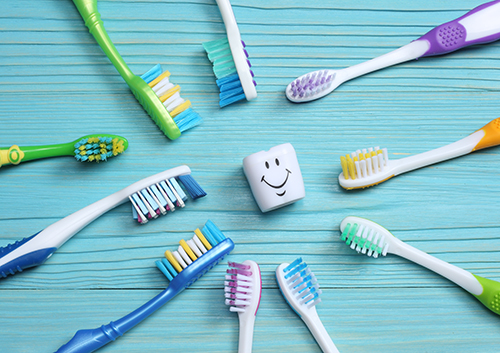
It’s done a wonderful job for you, but after three or four months, the time has come to retire your toothbrush. Bristles that once easily removed food particles and plaque have become frayed and just aren’t as effective. But now that you’re regularly changing out your toothbrush, what to do with those retired brushes besides add to the local landfill? Check out some recommendations from Drs. Peter Vogel, Vijal Vadecha for some second career options for that old toothbrush.
Make Your Jewelry Shine
A gentle brush with your favorite jewelry cleaner and your old brush will remove dirt from small spaces and filigree that a cloth just can’t reach. Do check that brushing is safe for your jewelry—pearls, for example, are not a good candidate.
Keep Your Woodwork Dust-free
Keep the details on your wood trim dust free with an old toothbrush. Baseboards are some of the hardest places to keep clean—even vacuums have difficulty getting dust and dirt out of trim. But an old toothbrush is perfect for cleaning the top, the grooves, and the inside corners of your baseboards. You can also remove dust from around door trim and inside window tracks.
Polish Sinks and Faucets
Use a repurposed toothbrush to remove build-up where the base of your faucet meets the sink, or around levers and handles. And don’t forget the metal ring around the drain!
Clean Kitchen Gadgets
Those miniature blades in your coffee maker or blender, the tiny holes in your cheese grater, the micro-openings in your microplane—small cleaning jobs need small tools! Try an old brush the next time you have a mini-cleaning problem.
De-grease Appliances
And while we’re in the kitchen, don’t forget your appliances. A toothbrush can clean grease around dials, handles, and knobs where a sponge can’t reach.
Refresh Your Grout
There are special brushes made just for scrubbing grout, but give your old brush a try first. Use your regular cleaning solution or paste for fresh, clean grout lines on your tile floors and counters.
Keep Your Technology Sleek
Your keyboard has a busy life and it shows! Keep the spaces between your keys dust and crumb free with a clean, dry toothbrush. The next time you’re detailing your car’s interior, try a toothbrush for cleaning around buttons and dials on your dash. And don’t forget your remote controls, or any other place where keys, knobs, and buttons collect dust.
There’s still a lot of life left in that toothbrush! If you choose to reuse, do be sure to thoroughly clean your toothbrush before it transitions to another housekeeping detail. It’s worth the effort—your old brush will prove useful in any number of new ways, and your home—and the environment—will thank you!
Chipped Your Tooth? Now What?
April 11th, 2024

Accidents happen. Next time you’ll wear your mouthguard when you skateboard, never use your teeth to open anything, and carefully step away from your grandmother’s hard candy dish. But what to do now for your chipped tooth?
First of all, call Daisy Mountain Dentistry. Drs. Peter Vogel, Vijal Vadecha and our team can offer tips on dealing with any pain and how to avoid injuring your tooth further. Make an appointment to see us as soon as possible, where one of the following options might be the best treatment for you:
- Bonding
If the chip is small, you might be a good candidate for bonding. A tooth-colored resin is applied to the damaged area with adhesive, molded to shape, and then hardened with a curing light. It is then polished and, if necessary, further shaped to match your surrounding teeth.
- Porcelain Veneer
A veneer is a thin shell of porcelain individually molded for your tooth. If the chip is too large for bonding, or if you would like a more translucent finish, a veneer might be appropriate. During your first appointment, some of the tooth structure will be gently removed to accommodate the size of the veneer. A mold will be taken and sent to a lab for the creation of the veneer, which will be bonded to your tooth on a later visit. Whether a veneer will be successful depends on several variables, such as the condition of the tooth and enamel, your bite, and whether you grind your teeth. We will take all these factors into consideration in discussing possible treatments.
- Crown
A large chip or pain when eating or drinking might mean that you need a crown. This “cap” will protect your tooth from the pressures of chewing as well as restoring its appearance. On your first visit, some of the tooth structure will probably be removed to make room for the crown, impressions will be taken for the dental lab to make a permanent crown, and a temporary model will be fitted to your tooth. In a following visit the permanent crown will be adhered to your tooth.
If the crack has extended to the pulp of the tooth, you might need a root canal. If this is necessary, we will discuss the procedure during our exam.
No matter the size of the chip, it is important to contact our Anthem office immediately to help avoid infection and prevent further damage. If your tooth is broken below the gumline or otherwise seriously compromised, more intensive care will be necessary. But when a minor accident happens, prompt treatment can quickly restore your smile to health.
What to Expect if You Haven’t Been to the Dentist in Forever
April 4th, 2024

It’s easy to miss a dental appointment. Life and duties intervene, and suddenly you have to push your appointment back once, then again, or forget about it.
We get that. These days, we all have a lot going on. But what we don’t want is for a lengthy absence to make you anxious about returning. It doesn’t matter how long it’s been, we always love to see you! So let’s take a moment to explain what you can expect when you pay us a visit.
Your appointment will last roughly 60 to 90 minutes, so keep that in mind when you schedule it and plan accordingly. Drs. Peter Vogel, Vijal Vadecha and our team want you to feel comfortable.
One of the first things we will ask is the reason for your visit. You’ll have the opportunity to let us know about any concerns or questions you may have. No question is too small, so ask away!
Next, we will go over your medical and dental history to make updates to your file as necessary. This will usually be followed by X-rays to give us a better idea of what is currently happening with your teeth. We will finish with a screening for oral cancer and periodontal disease. If you haven’t visited us in a while, we want to make sure nothing serious is going on.
After that, you will undergo a cleaning with one of our hygienists. Your teeth will be cleaned and checked for such things as broken fillings, cracked teeth, or active decay. Finally, Drs. Peter Vogel, Vijal Vadecha will come by for a final look and a rundown of your dental needs.
Then you’re ready to go! On your way out, you’ll discuss options for scheduling your next appointment, insurance coverage, and payment plans if applicable. You will also receive a goodie bag with a new toothbrush, floss, and toothpaste to get you started (and motivated) on the path to great dental health!
We always want our patients’ experience to be as comfortable and as easy as possible. From the moment you pick up the phone to make your appointment, our team is here to make sure we always meet your needs.
No matter how long it’s been since your last visit, we hope you’ll give us a call to make your next appointment at our Anthem office.
The Effects of Sleep Apnea on Dental Health
March 28th, 2024

Sleep apnea is an increasingly common medical condition, and one that can have a truly devastating effect on the waking life of the sufferer. Those who suffer from the disorder may find that they suffer any or all of the following side effects:
- Saliva has several important jobs, and one of them is to protect and heal your tongue, your gums, and the inside of your mouth. Snoring and sleep apnea dry out your mouth, meaning there isn’t enough time for your saliva to do all this vital work.
- Over an extended period of sleep apnea, it’s likely that the sockets of your teeth will begin to dry out overnight as a result of your gasping for air and snoring between breaths. If this happens too frequently over a long a period of time, it can start to loosen your teeth.
- Those with sleep apnea often also practice bruxism, which is the habit of clenching and grinding your teeth together as you sleep. This can lead to all manner of problems, including TMJ disorder, damage to the enamel, headaches, and toothaches.
- For obvious reasons, sleep apnea does not lead to a particularly good night’s sleep. This means that sufferers are often tired and irritable, and suffer from the many other ill effects of sleep deprivation.
- While it is unclear whether the reasons behind this are correlative or causative, it has been suggested there are links between sleep apnea and cardiac arrests, depressive disorders, Type Two diabetes, cancerous tumors, “silent” strokes, and various complications of pregnancy.
While sleep apnea can be a troubling condition, Drs. Peter Vogel, Vijal Vadecha and our team at Daisy Mountain Dentistry will tell you it is eminently treatable. There are a number of ways to combat it, ranging from simple sleep hygiene to use of a CPAP machine. Of course, if it is possible for you to reduce your weight a little in a safe and healthy way, some have found that is also helpful in combating the problem. Sleep apnea is very easy to treat, once it has been correctly identified.
If you think you may be suffering from sleep apnea, or if you would like to know more about the condition, please give us a call at our convenient Anthem office to schedule an appointment with Drs. Peter Vogel, Vijal Vadecha.
How Smoking Increases the Risk of Oral Cancer
March 21st, 2024
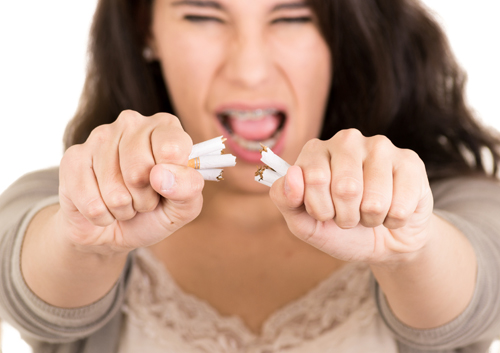
Cigarette smoke contains more than 6,000 chemicals, and at least 200 of those chemicals are known to be harmful to your health. When smoke is inhaled, moist oral tissues are saturated with excessive amounts of carbon monoxide, hydrogen cyanide, and a host of other known carcinogens. Most oral cancers originate in abnormal squamous cell activity, which are cells found on the lips, inside the mouth, and in the throat.
How Oral Cancer Begins
Cells exposed to consistently high levels of cigarette smoke may eventually suffer abnormal mutations within their DNA. Since deoxyribonucleic acid (DNA) is responsible for providing cells with instructions about growth, reproduction, and death, these instructions become distorted, which causes the cells to reproduce uncontrollably.
Essentially, that is what cancer is: rapid, unchecked growth of genetically mutated cells that encourages the development of malignant tumors. Unfortunately, the chemicals in cigarette smoke are strongly associated with oral cancer.
Signs of Oral Cancer
Early-stage oral cancer is often asymptomatic, which means symptoms appear only after the cancer intensifies and spreads. Possible signs of oral cancer include:
- Ulcers inside the mouth or on the lips that do not heal
- White or dark red patches inside the mouth
- Lumps inside or around the mouth (a lump could appear on your neck)
- Bleeding, numbness, and soreness in the mouth
- Chronic halitosis
- Loose teeth in the absence of tooth decay
Diagnosis and Treatment of Oral Cancer
Squamous cell oral cancer is the most common type diagnosed in smokers. Drs. Peter Vogel, Vijal Vadecha and our staff often discover squamous cell carcinoma lesions during dental examinations or cancer screenings. Depending on the stage of the oral cancer, treatment may begin with a biopsy or an exfoliative cytology procedure that involves collecting cells from the oral cavity using a scraper.
According to the Oral Cancer Foundation, oral cancer patients may need surgery, radiation therapy, a combination of surgery and radiation therapy, or chemotherapy to eradicate oral cancer.
Smoking, Cancer, and Tooth Decay
Not only is smoking the number-one cause of cancer but it is also detrimental to the overall health of your teeth and gums. Yellow teeth, bad breath, dry mouth, and expedited tooth decay are all caused by smoking, not to mention the damage smoke does to the heart, lungs, and kidneys.
In other words, don’t smoke!
Road Trip!
March 14th, 2024

The bags are packed, the trunk is loaded, the route is programmed into your GPS, the playlist is set, and your destination awaits! Sometimes there’s just nothing more appealing than a road trip. So, to make your trip even more enjoyable, here are some dental tips to help keep you feeling clean and fresh over the long haul.
- Fuel Up
If you’re bringing some road snacks, be sure to include a few that will help clean teeth and freshen breath. Packing a supply of bottled water helps you stay hydrated, washes away food particles, and eliminates the bad breath caused by dehydration. Carrots and apples are not only nutritious and tasty, they apply a bit of gentle scrubbing action to your enamel as you chew. Traditional travel favorites like granola bars, beef jerky, and chips tend to stick to the teeth and provide cavity-causing bacteria a leisurely feast, so enjoy them in moderation. (If you’re driving, save the snacks for a rest stop—not only is eating while driving prohibited in some areas, it’s a distraction you don’t need on the highway.)
- Roadside Diners
The occasional sticky, sweet, or chewy indulgence is fine at home, but when you have hours in the car ahead of you, you might want to turn down the pecan pie, the giant pretzels, and the roadside sea salt caramels. Again, cavity-causing bacteria love sugars and simple carbs, and food that finds its way into tooth crevices finds its way onto their menu. And, it goes without saying, passing up garlic, onions, and spicy foods will help your mouth feel fresher longer—and make your travel companions happier.
- Car Wash
Bring a travel-sized toothbrush and tube of toothpaste with you for a quick cleaning when you stop for a break. A ventilated case will keep your brush dry (bacteria like damp conditions) and away from questionable surfaces. Disposable mini-travel brushes are available that come with a bead of cleaner pre-loaded and ready to use—you don’t even need water for a cleaner mouth and fresher breath. Food particles do not make good travel buddies so don’t forget dental picks or floss. And if you can’t brush right away, try a rinse with water or chew a piece of sugarless gum. Sugar free gum can help stimulate saliva production, which is a good way to wash away food particles and neutralize acids in the mouth.
- Roadside Repair
Even with the best preparation, accidents can happen. That’s why you have a spare tire and a lug wrench in your trunk. It pays to be prepared for a dental emergency on the road as well. There are dental travel kits available in stores and online, or create one for yourself. Along with your first aid kit, pack dental picks, antimicrobial wipes, sterile gauze, a mirror, and any other supplies you think might come in handy. If you wear braces or a retainer, be sure to include dental wax in case of an uncooperative wire, and a case to protect and keep track of your retainer. And it’s a good idea to keep our Anthem office’s number on hand in case of emergency.
It’s a big country, and cruising the streets and highways is a wonderful way to explore it! But if you’re having any dental problems, be sure to see your dentist before taking off—after all your preparation, you don’t need a dental emergency to ruin your trip. Then, pack your bags, load your trunk, set your GPS, pick a playlist with something for everyone, and get ready to enjoy happy travels and healthy smiles!
Oral Cancer Facts and Figures
March 7th, 2024
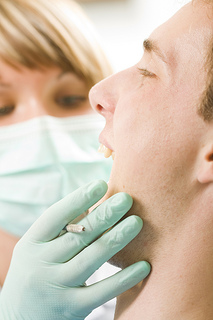
Oral cancer is largely viewed as a disease that affects those over the age of 40, but it can affect all ages, even non-tobacco and alcohol users. Oral cancer can occur on the lips, gums, tongue, inside lining of the cheeks, roof of the mouth, and the floor of the mouth. Our team at Daisy Mountain Dentistry recently put together some facts and figures to illustrate the importance of visiting our Anthem office.
Our friends at the American Cancer Society recommend an oral cancer screening exam every three years for people over the age of 20 and annually for those over age 40. Because early detection can improve the chance of successful treatment, be sure to ask Drs. Peter Vogel, Vijal Vadecha and our team to conduct an oral exam during your next visit to our Anthem office.
- Symptoms of oral cancer may include a sore in the throat or mouth that bleeds easily and does not heal, a red or white patch that persists, a lump or thickening, ear pain, a neck mass, or coughing up blood. Difficulties in chewing, swallowing, or moving the tongue or jaws are often late symptoms.
- The primary risk factors for oral cancer in American men and women are tobacco (including smokeless tobacco) and alcohol use. Risk rises dramatically (30%) for people who both smoke and consume alcohol regularly.
- Oral cancers are part of a group of cancers commonly referred to as head and neck cancers, and of all head and neck cancers they comprise about 85% of that category.
- Oral cancer is the sixth most common cancer among men.
- Oral cancer is more likely to affect people over 40 years of age, though an increasing number of young people are developing the condition.
- Death rates have been decreasing over the past three decades; from 2004 to 2008, rates decreased by 1.2% per year in men and by 2.2% per year in women, according to the American Cancer Society.
- About 75% to 80% of people with oral cavity and pharynx cancer consume alcohol.
- The risk of developing oral cavity and pharynx cancers increases both with the amount as well as the length of time tobacco and alcohol products are used.
- For all stages combined, about 84% of people with oral cancer survive one year after diagnosis. The five- and ten-year relative survival rates are 61% and 50%, respectively.
- It is estimated that approximately $3.2 billion is spent in the United States annually on treatment of head and neck cancers.
Cancer can affect any part of the oral cavity, including the lip, tongue, mouth, and throat. Through visual inspection, Drs. Peter Vogel, Vijal Vadecha and our team at Daisy Mountain Dentistry can often detect premalignant abnormalities and cancer at an early stage, when treatment is both less extensive and more successful.
Please let us now if you have any questions about your oral health either during your next scheduled appointment, by giving us a call or asking us on Facebook.
My teeth feel great. Do I still need to see the dentist?
February 29th, 2024

Absolutely. Checking in with Drs. Peter Vogel, Vijal Vadecha on a regular basis—usually every six months—is essential to keeping your smile looking its best. At Daisy Mountain Dentistry, we are proud to offer a number of preventive procedures to ensure the health of your mouth and the beauty of your smile. Your smile is just as important to us as it is to you!
Another good reason to visit our Anthem office is to check for hidden issues in your mouth you may not even realize you had. Bacteria, tartar, and cavities are known to form in the hard-to-reach crevices of your mouth and may only be detected through a professional exam. If left untreated, these cavities and decay can get worse, requiring more extensive treatment, and costing you even more time and money down the road. During your routine exam, Drs. Peter Vogel, Vijal Vadecha and our team will also check to make sure your fillings or other dental restorations you may have had are in good shape.
Preventing problems before they start is the key to optimal oral health. If it has been more than six months since your last visit, please contact our Anthem dental office to schedule your routine checkup! See you soon!
What to Do for Your Loose Tooth
February 22nd, 2024

One of the first exciting childhood experiences we outgrow is the excitement of discovering a loose tooth. Sadly, there’s no adult Tooth Fairy waiting to exchange a gift for a lost tooth, and, even worse, there’s no backup tooth all set to replace it.
If one of your permanent teeth is feeling a little less than permanent, don’t ignore the problem! Here are four things to do right away when you discover a loose tooth:
Eat Soft Foods
While you’ll probably automatically take caramels off the menu and ditch your chewing gum, crunchy foods such as nuts, chips, even apples can be a problem for a compromised tooth. Stick with soft foods and try to eat on the opposite side of your loose tooth.
Keep the Area Clean
The typical bacteria and food particles in your mouth won’t thoughtfully leave the area around your wiggly tooth untouched. But your normal brushing and flossing might be a little too much for a loose tooth. Gently rinsing with warm water should do the trick until you can see us.
Leave It Alone
Sometimes the hardest thing to do is to do nothing. But when it comes to a loose tooth, please choose this course of (in)action. You might recall having a loose tooth as a child, and how you’d automatically wiggle it with your tongue or your fingers. But you’ll also remember what happened at the end of all that wiggling—your baby tooth fell out.
Teeth are held in place by ligaments attached to the alveolar bone in the jaw. When those ligaments or bone are damaged because of injury or infection, your tooth feels loose. Wiggling your tooth back and forth can cause further detachment and expose you to more bacteria. So even though it might be tempting, leave your tooth alone until you can see us.
Call Your Dentist Immediately
The most important tip of all! Call Drs. Peter Vogel, Vijal Vadecha at once if you notice a loose tooth. It’s important to discover not only the best treatment, but the reason for your loose tooth as well. A loose tooth can be caused by several different conditions, and none of them should be ignored.
- A blow to your mouth
If your tooth, ligaments, or bone have suffered trauma, your dentist might be able to stabilize your loose tooth with a splint so that ligament and tissue can heal.
- Gum disease
Periodontitis (severe gum disease) is a chronic condition. Pockets form between your gums and teeth that become home to bacteria and infection. Over time, periodontitis can destroy gum, ligament, and bone tissue. Left untreated, it leads to loose teeth and even tooth loss. Gum disease is reversable when caught early enough, and even in later stages can respond well to a variety of treatments.
- Pregnancy
Hormonal changes during pregnancy can cause the ligaments and bones around your teeth to loosen, and loose teeth are the result. While this situation is usually temporary, taking care of your teeth and gums is essential during pregnancy, and Drs. Peter Vogel, Vijal Vadecha will have many important recommendations for your dental health.
- Teeth Grinding (Bruxism)
Your jaw and teeth can exert hundreds of pounds of pressure. When you spend your sleep hours grinding them, that force is applied to your teeth and the ligaments holding them. Small wonder that bruxism can lead to loose teeth. Your dentist will have ideas to help you stop teeth grinding, from behavioral changes to custom night guards.
Osteoporosis, bite problems, oral cancer, and other conditions can also cause loose teeth. Any condition that causes loose teeth should always be evaluated immediately to prevent more serious medical or dental problems.
Sometimes a loose tooth can’t be saved, and a professional extraction is the best solution. But if there’s a chance to save your tooth, treating the tooth carefully and visiting our Anthem office at once improve your odds considerably. Because there’s no adult Tooth Fairy, and really, no coins under a pillow will ever be as valuable as a beautiful, healthy smile.
Are you a tooth grinder?
February 15th, 2024

Perhaps you had a particularly irritating commute home from work, and you realize at the end that your jaw was clenched tight the entire time. Or maybe you grind your teeth when you are nervous or anxious about an upcoming business meeting. Most people grind their teeth from time to time, but it’s important to recognize the signs and symptoms of chronic tooth grinding. Known as bruxism, this condition can lead to oral health problems and dental issues later.
Signs and symptoms of bruxism
- Your partner might complain about the fact that you grind your teeth while you sleep. People who grind their teeth on a regular basis often do so during the night, and aren’t necessarily aware it is happening. However, your partner will more than likely notice if you develop this condition. If he or she mentions that it happens often, you might want to contact our team at Daisy Mountain Dentistry.
- You may experience a persistent and unexplained headache if you grind your teeth too often. You may not realize why you have this headache, because you are not aware of the fact that you have been grinding your teeth. Take note of any headaches you have, and if you cannot attribute them to another source, please give us a call to set up an appointment with Drs. Peter Vogel, Vijal Vadecha.
- Your jaw will more than likely become sore if you suffer from bruxism. If you wake up in the morning and have any discomfort in your jaw, you might have spent the night grinding your teeth. Our team can give you tips and advice for managing bruxism.
While many people associate their teeth grinding with stress, it actually is caused more often by crooked teeth, an overbite, or an under bite. If left untreated, bruxism can lead to a variety of complications, including dental injuries, hearing loss, and the onset of TMD. If you think that you might be a chronic tooth grinder, it might be time to set up an appointment at our Anthem office in order to find out which treatment options are available to you.
Why do wisdom teeth need to be removed?
February 8th, 2024

Drs. Peter Vogel, Vijal Vadecha and our team at Daisy Mountain Dentistry get this question a lot. Wisdom teeth are the last teeth to come in, once young people get their adult teeth. Because they are the last teeth to break through the gums, they are often called the third molars. There are four wisdom teeth: two on each side of the top and bottom of the mouth.
There is no hard-and-fast rule that says everyone must have the wisdom teeth removed. There are certain situations in which they either cause problems directly, or create a situation where there is a greater likelihood problems will arise eventually.
Impacted wisdom teeth
If Drs. Peter Vogel, Vijal Vadecha and our team say you have a soft tissue impaction, it means your wisdom tooth is covered by gum tissue that is preventing it from erupting — most likely because your mouth is too small to provide the tooth with the room it needs to emerge.
The term “partial bony impaction” means that gum tissue is covering the wisdom tooth, but part of the jaw bone is also covering it, in which case there is no room in your mouth for the tooth to erupt. The opposite end of this spectrum is a complete bony impaction, where the wisdom tooth is completely covered by gum tissue and the jawbone, which prevent it from ever erupting.
The importance of removing impacted wisdom teeth
Dentists often want to remove impacted wisdom teeth because of the likelihood that they will cause problems, or because a problem already exists. One such problem is pericoronitis, an acute abscess that affects partially impacted wisdom teeth. Food, bacteria, and other mouth debris can become lodged under the gum flap that covers the wisdom tooth, which prevents it from erupting. Pericoronitis symptoms include pain, swelling, and the presence of an abscess.
Regular dental checkups will enable your dentist to keep an eye on your wisdom teeth, especially if they have some type of impaction. Drs. Peter Vogel, Vijal Vadecha and our team at Daisy Mountain Dentistry typically recommend removal of impacted wisdom teeth because of the likelihood that severe infections such as pericoronitis will develop.
If you have any questions about wisdom teeth, or if you would like to schedule an appointment with Drs. Peter Vogel, Vijal Vadecha, please give us a call at our convenient Anthem office!
Is your child a mouth breather?
February 1st, 2024

Have you ever watched to see if your child is breathing through his or her mouth? Breathing through the mouth instead of the nose may lead to trouble for youngsters. Kids who typically breathe through their mouth—most often children who suffer from allergies—experience problems getting enough oxygen into their blood, a condition that affects their weight, size, sleep, and even their performance in the classroom and daily life.
Mouth breathing as a child can also lead to sleep apnea, behavior and learning problems, delayed speech, dental and facial abnormalities, and even breathing problems as your child grows. There are a multitude of reasons for an individual to mouth breathe, such as enlarged tonsils, adenoids, and deviated nasal septum, but the cause is usually allergies.
As bad as the condition sounds, we want you to know mouth breathing is a treatable condition. Doing so, though, requires early diagnosis and treatment. Since our team at Daisy Mountain Dentistry sees our patients every six months, we may be in a position to identify the symptoms of mouth breathing.
If you suspect your child is a chronic mouth breather, please give us a call at our convenient Anthem office to schedule an appointment with Drs. Peter Vogel, Vijal Vadecha.
Suffer from Dental Anxiety? Not a Problem.
January 25th, 2024

If you suffer from dental anxiety, we understand that paying a visit to our office can seem like a nearly impossible mission. Regardless of what the root of that anxiety might be, we’re here to tell you that at Daisy Mountain Dentistry, you have no need to be nervous. Our office is dedicated to making your dental experience as comfortable and stress-free as possible.
One of the best things to do if you experience dental anxiety is call our office in advance to let us know. By notifying us in advance, you give us the opportunity to provide you with the dental care you need in the way you need it.
We can prescribe a relaxation medication for you. During your appointment, we can provide a little bit of laughing gas to put you more at ease, teach you some behavioral techniques for relaxation, and make sure you’re never in the dark about what’s happening.
If dental anxiety makes you feel embarrassed, please be assured that you’re not alone. Studies show that as much as 75% of adults suffer some degree of dental anxiety! It might be helpful to remember that your doctor’s goal is the same as yours: We are here to keep your oral health in check so you can be your healthiest self. We certainly don’t want to make you uncomfortable in the process.
If you have any questions about other ways in which we can accommodate you during your visits, please don’t hesitate to contact our Anthem office!
Help! My gums hurt when I floss!
January 18th, 2024
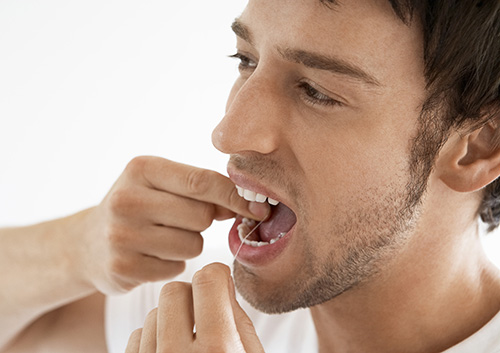
By no stretch is it rare for your gums to hurt during and after flossing. Even some bleeding is to be expected. This is especially true if you have not flossed in a long time. However, if your gums do indeed hurt when you floss, and unbearably so, there are some things you can do.
Be Gentle
Perhaps the most obvious way to combat gum soreness and bleeding is to be gentle. One of the most common occurrences of these gum problems is over-aggressive flossing. In other words, if you are too rough on your gums while flossing, either because you are out of practice or because you are in a hurry, soreness and hurting is to be expected. Instead, try taking your time and be gentle. Also, if you are just starting out, be patient and consistent, your gums will become more conditioned over time.
Use an Alternative Method
If being consistent and gentle does not work, there are other alternative methods of flossing that you can try. You can also try a water floss machine, or what is sometimes called a water pick. The device essentially shoots water into the crevasses between your teeth, and in other areas of your mouth, in order to dislodge food and plaque. These oral instruments also come with different attachments that allow you to reach many of the hard to see and reach areas of your mouth. And lastly, you can always buy floss that is not as abrasive to your gums. There is floss that comes with soft and gentle coatings that will do less harm to your gums while they are adjusting to the good oral hygiene habit you are creating.
Flossing is one of the easiest parts of oral hygiene to overlook. When you first start out, it is common that you may want to stop because of the pain it can initially cause. However, if you try one, or all, of the above mentioned methods, you will give yourself the best chance of being success with your flossing, and it won't hurt as much.
For more flossing tips, schedule an appointment at our Anthem office and askDrs. Peter Vogel, Vijal Vadecha or a member of our team!
Root Canal Procedure
January 11th, 2024

Five words no one welcomes: “You need a root canal.” But if you are delaying treatment because you are worried about pain and an uncomfortable day in the dentist’s chair, please think again! Modern root canal procedures are designed to repair your damaged tooth gently and efficiently, and leave you with a restored natural tooth that can last a lifetime.
- Why might you need a root canal?
First, a little tooth biology. Each tooth has a crown (the part we see above the gums) and one or more roots (the part of our tooth below the gum line that is attached to bone in our jaw). The tooth has three basic layers: the hard enamel and cementum that cover the outer crown and root, the softer dentin beneath that layer, and, on the inside, the pulp. Pulp is made of living tissue, and contains the blood vessels and nerves that nourish the tooth and keep it vital.
Even with the protection the enamel and dentin provide, sometimes the pulp can be infected or damaged. If you have suffered an injury to your mouth or jaw, or an infection has developed from an opening in the tooth caused by a deep cavity or crack, you may need a root canal to prevent further infection, pain, and even tooth loss. Call our Anthem office immediately if you feel pain with chewing or pressure, prolonged sensitivity to heat or cold, swollen, and tender gums around a tooth, or tooth discoloration.
- The Root Canal Procedure
If a root canal is necessary, the procedure is very straightforward. After the area around the tooth is numbed, we will make an opening in the crown to allow access to the pulp inside. Very small instruments will be used to clean the inner tooth and removed bacteria and dead or dying tissue. The area will be thoroughly disinfected, and the inside of the tooth shaped and then filled and sealed. A temporary filling or crown might be placed on the tooth to prevent bacteria and food from entering the site if a permanent crown needs to be created. The entire process usually takes from one to three visits.
If we suggest a root canal, it is because this is the best way to save your tooth. Please feel free to talk to us about your particular needs and concerns. Which tooth is affected, how many roots are involved, what type of filling or crown might be best—we will work with you to provide all the information you need and all the options you have available.
Common Concerns
- Are you concerned about pain?
The most painful part of a root canal is often the severe discomfort your tooth causes before treatment. And infections and damaged nerves can affect not only the injured tooth, but the gums, tissue and even bone surrounding it. With our modern dental techniques, a root canal procedure is often no more uncomfortable than a regular filling. The local anesthetic we use will prevent you from feeling any pain during the procedure, and, while the area around your tooth might be a bit sensitive following treatment, the pain caused by the infection or injury should be gone.
- Are you anxious about the procedure?
If dental treatment causes you anxiety, please let us know. There are several sedation options we can pursue to make this procedure less worrisome. Our goal is to make your treatment as gentle and comfortable as possible.
No one welcomes the news that a root canal is necessary, but with today’s procedures, this treatment can be just what you need to relieve your pain and keep your natural tooth where it belongs for many years to come. And that is welcome news, indeed!
Understanding Cavities
January 4th, 2024

Getting a cavity seems like delayed punishment for eating that special dessert every weekend or for the few days you forgot to floss. When you are doing everything right with minimal exception and a cavity is diagnosed, it is discouraging. Knowing how cavities form and what causes them is valuable in knowing how to prevent them. In this blog post, Drs. Peter Vogel, Vijal Vadecha will help you understand cavities!
A cavity is not a one-time event. It is actually a symptom of a disease called caries. Tooth decay is a result of an active infection and condition in the mouth. There are ingredients to this infection, which include bacteria, acid, your tooth, and a food source. The main bacterial culprit is S. Mutans. Bacteria live in a housing structure called biofilm. This offers them protection, food, and an ideal replicating environment.
Biofilm can be healthy if there is a balance of good bacteria. When you have caries, the numbers of “bad” bacteria increase and produce an environment where they thrive and therefore cause tooth decay. A main indicator of this is a pH measurement of your saliva.
Several factors can influence the biofilm pH. Foods and beverages all have different pH levels. The lower the number, the higher the acidity. Since acid promotes tooth decay, a beverage like soda will promote a cavity. Water, being neutral, is a good choice to promote healthy oral pH. Healthy eating can still cause cavities. Here is an example of a highly acidic, yet traditionally healthy meal:
Toast with store-bought strawberry jam, and a cup of cottage cheese topped with fresh cranberries.
Instead, here is a better choice, which involves mixing acidic healthy foods with alkaline (non-acidic) foods to reduce the overall pH:
Toast with almond butter, and Greek yogurt topped with fresh blueberries.
The first example will result in a very low pH in the mouth and even in the rest of the body. The second meal mixes highly acidic blueberries with an alkaline Greek yogurt. Dairy products from cows are highly acidic. Toast is acidic because of the yeast and almonds are alkaline.
A natural buffer is saliva. Whenever mouth breathing or medications compromise the saliva flow, the pH is going to drop and caries can go rampant. Getting a cavity is not just about the sweets or forgotten flossing sessions. It is about the pH levels and bacterial management.
For more helpful tips about how to avoid cavities, contact our Anthem office.
Healthy Resolutions for Healthy Teeth
December 28th, 2023

Every January 1st, you have your resolutions ready. No more nail biting. Lose ten pounds. Stop smoking. None of us are happy about those annoying bad habits we’ve picked up over the years. But if nothing else has helped you keep your resolutions, maybe seeing how they can improve your oral health will give you some extra willpower.
- No More Nail Biting
You can easily see how nail biting affects your fingernails, but its effects are more than cosmetic. The pressure this habit puts on tooth enamel can lead to cracks, chips, and enamel erosion. Nail biters have a greater risk of bruxism, or teeth grinding. (More on that below.) And the transfer of germs from fingers to mouth and mouth to fingers is a vicious circle that can lead to illnesses and infections in both fingers and mouth.
- Cut Down on Junk Food
Sugars and carbs help pack on the pounds, no doubt. Did you know that they can also help create cavities? Sugar is a favorite food for oral bacteria, which allows them to produce acids which attack and weaken tooth enamel. And carbs? They convert easily to simple sugars. Choose nutritious snacks and beverages, and you will keep those teeth healthy. You might even lose a few pounds!
- Lower the Volume
If your partner complains about sleepless nights thanks to your nocturnal teeth grinding, or your friends ask you to quit chewing on that cup of ice while they’re trying to watch a movie with you, listen to them! (If you can hear them over the grinding and chewing.) Bruxism can fracture teeth, cause headaches and jaw problems, and might even lead to loose teeth. Chewing hard foods can have the very same effects. Too much pressure from any source can damage your teeth. Grinding, chewing ice, crunching down on hard candies—any habit that’s loud enough to annoy others could be a warning to be more careful of your teeth.
- Don’t Put That in Your Mouth!
Helping you eat and chew nutritious foods—of course. Smiling—absolutely. Ripping off a piece of duct tape, tearing open a potato chip bag, holding your dog’s leash while you look for your keys, opening a tight bottle cap—no, no, no, and really no. Fractures and chips are common injuries when you use your teeth as tools. Your teeth have a crucial job to do, but that job description never includes “scissors” or “nutcracker” or “bottle opener.” Take that extra minute and find the tool you need!
- Drink in Moderation
Along with all the other consequences of over-indulging, too much alcohol in your diet can be bad for your oral health. Alcohol, especially paired with sugary drinks, helps create that acidic environment that leads to weakened enamel. More than that, it’s dehydrating. Without sufficient hydration, we don’t have the optimal saliva production we need to fight cavities. After all, saliva helps wash away food particles and bacteria, neutralizes acids, and strengthens enamel through remineralization. Ring in the New Year—moderately!
- It’s Time to Quit
Cigarettes, pipes, cigars, chewing tobacco—there is no tobacco product that is healthy for your body or your teeth! We’re all familiar with the discoloration tobacco can cause, but it also has serious oral health consequences. Oral cancer, gum disease, early tooth loss—all these conditions have been linked to tobacco use. Today there are more methods than ever before to help you quit. Make this your year!
You don’t have to wait for the New Year to start working on healthier habits. If you’d like to tackle teeth grinding, banish nail biting, stop smoking, or work on any other habits that can damage your health and your teeth, talk to Drs. Peter Vogel, Vijal Vadecha at your next visit to our Anthem office. And, don’t forget—resolving to see us twice a year for a checkup and a cleaning is a resolution that’s extremely easy to keep!
Do You Have A Cavity?
December 21st, 2023

Sometimes cavities are hard to avoid. Our team at Daisy Mountain Dentistry wants you to know you aren’t alone when it comes to getting cavities. They can appear in both children and adults, and in order to avoid the pain and hassle, you need to understand how they form and what to do to prevent them from developing in the first place.
Cavities form when bacteria, acids, or sugars build up and form plaque on your teeth, which can destroy your enamel. When you don’t brush and floss properly, the build-up can cause cavities to form. In essence, a cavity is a decayed part of your tooth that cannot be repaired by your body’s immune system. This is why a dentist will need to treat your cavity with a filling. If it grows for too long and manages to infect the root of your tooth, a root canal may be the only solution.
Cavities are often symptom-free; you might not experience any pain at first, other than the occasional irritation when you drink a hot or cold beverage. Other signs of possible cavities include persistent bad breath, pus or discharge around a tooth, black or brown discoloration, small pits or holes in a tooth, and perhaps a sticky feeling when you bite down. It’s crucial to treat cavities sooner rather than later if you wish to avoid excessive pain and the necessity of a root canal.
You can avoid cavities by keeping up with good oral hygiene, eating a well-balanced diet, and scheduling regular cleanings with Drs. Peter Vogel, Vijal Vadecha. They can still occur at any time, no matter what age you are, so make sure to brush, floss, and rinse every day. If you notice any of the above symptoms, please contact our Anthem office and schedule an appointment.
Can You Repair Your Tooth Enamel?
December 14th, 2023

There are lots of ads out there for toothpastes that claim to repair damaged tooth enamel.
Can you treat cavities and tooth decay at home? Well, mostly, no, you can’t.
Can you strengthen your enamel at home? Very possibly—in some circumstances. Let us explain!
Cavities and tooth decay start forming when the enamel on the tooth’s surface breaks down. To discover what causes this breakdown, we need to see how chemistry works with our biology.
Tooth enamel is mainly made from calcium and phosphate ions. These minerals combine to form hydroxyapatite, crystals which make up around 95% of our enamel. Hydroxyapatite crystals are so strong that tooth enamel is the hardest part of our bodies. What can weaken a substance this strong?
Acids. Acidic foods and drinks, as well as acids created by the bacteria in plaque, strip away calcium and phosphate ions in enamel, weakening the surface of the tooth. This is a process called demineralization, and it’s the first stage of tooth decay. Left alone, weak spots will become bigger and deeper until they form cavities.
And tooth enamel, unlike the rest of your body, isn’t living tissue. It can’t regenerate. Once bacteria and acids have created a deep enough cavity, only Drs. Peter Vogel, Vijal Vadecha can repair it by removing decay and filling the tooth.
Wait, this sounds a lot more like “No, you can’t repair your enamel” and much less like “It’s possible to strengthen your enamel.” But we’re not through!
Demineralization doesn’t equal cavities—yet. Careful attention to your habits and your diet can make a difference in whether your enamel continues to weaken or becomes stronger.
Our body’s first defense against demineralization is saliva. Calcium and phosphate ions in saliva bathe the teeth throughout the day, restoring the minerals which have been lost. This is called remineralization. Saliva also helps neutralize acids from the foods we eat. But with a diet heavy in acids, or a lot of plaque buildup, saliva just can’t keep up with the damage.
That’s where “enamel-repair” toothpastes come in. Toothpastes are available that contain hydroxyapatite to restore calcium and phosphates to weakened enamel. But for many of the most common enamel-repair toothpastes, the not-so-secret secret to their effectiveness is fluoride.
Dentists recommend fluoride toothpastes for several very good reasons. Fluoride is attracted to the minerals in tooth enamel and bonds with them. Once bonded, fluoride attracts the calcium and phosphate ions in saliva, helping restore lost minerals to the enamel. Even better, when fluoride bonds with the calcium and phosphate in our enamel, fluorapatite is created. This is a crystal even stronger and more acid-resistant than hydroxyapatite.
If you’re concerned about the strength of your enamel, and especially if you notice any signs of acidic erosion, talk to our Anthem dental team right away. Drs. Peter Vogel, Vijal Vadecha can:
- Recommend over-the-counter toothpastes or professional fluoride applications to help reverse early demineralization
- Provide dental bonding, a crown, or a veneer to protect a tooth with serious erosion
- Treat a cavity caused by more advanced tooth decay.
Keeping your enamel healthy at home can take many forms. By careful brushing and flossing to remove plaque, by watching the acids in your diet, by making sure you’re properly hydrated, and by using fluoride toothpaste, you can both reduce the risk of demineralization and help restore weak spots in your tooth enamel.
So, can enamel-repair toothpastes effectively repair your teeth? Yes, they can be effective—if demineralization is in its early stages and if you make them a regular part of your daily dental routine.
Can’t Take Another Bite?
December 7th, 2023

We’re not talking post-holiday “I can’t eat another bite” discomfort. No, we’re here to talk about the discomfort caused by bite pain.
Usually, our teeth and jaws work so harmoniously that we don’t even think about biting and chewing. But when a sharp jolt or a dull ache accompanies any sort of pressure on your tooth, it’s time to call Daisy Mountain Dentistry. Let’s look at a few of the possible causes.
- Tooth Decay
When a cavity reaches below the enamel and into the dentin, the middle part of the tooth, you might feel discomfort and sensitivity. If a cavity reaches the inner pulp, which contains the tooth’s blood supply and nerves, it’s not only very painful, it can lead to a serious infection called an abscess.
Root canal treatment can help save a tooth when decay has reached the pulp, but prevention is always the best option! Good dental hygiene, regular checkups, and prompt treatment of small cavities will help prevent deep cavities from forming.
- Damaged Dental Filling
A loose or damaged filling can be uncomfortable. Even worse, bacteria can get under a damaged filling where your toothbrush and floss can’t reach, causing decay which can eventually reach the pulp if undetected.
During your regular checkups, Drs. Peter Vogel, Vijal Vadecha will look for any signs of decay around and under your fillings, and will find any fillings which need replacing. If you notice a loose filling, or suffer discomfort when you bite down on a filling, don’t wait until your next checkup to visit our Anthem office.
- Malocclusion
When your teeth and jaws aren’t aligned properly, you can’t bite comfortably. And that can be just one of the troubles caused by a malocclusion, or poor bite. Alignment problems can include difficulty eating, speaking, and sleeping, tooth damage, headaches and jaw pain, and facial asymmetry.
If your bite pain is the result of tooth and/or jaw misalignment, we can refer you to an orthodontist to evaluate the way your teeth and jaws are working together.
- Bruxism (Tooth Grinding)
Your jaws can provide more than 20 pounds of pressure to your teeth when you need to chew food. When you grind your teeth, your jaws can produce hundreds of pounds of pressure on your teeth all night long. It’s no wonder you wake up with tooth or jaw pain. Over time, nightly grinding will damage enamel and can chip and even crack teeth.
Your dentist can create a custom-made nightguard that will protect your teeth from grinding pressure—relieving tooth and jaw pain, preventing more serious damage, and giving you a better night’s sleep!
- Cracked Tooth
A cracked cusp or a crack in your tooth needs to be treated as soon as possible. Some cracks can be treated by Drs. Peter Vogel, Vijal Vadecha, some might require a referral to an endodontist or an oral surgeon, and some cracked teeth are so badly damaged that they require extraction.
A painful cracked tooth can be obvious after a trauma, or it might not be obvious at all. So whenever you suffer dental trauma, call our office immediately for instructions. Speedy medical attention might be the difference between a repaired tooth and a lost tooth. (And save yourself from avoidable trauma by wearing your mouthguard whenever it’s appropriate!)
- Infection/Abscess
When the pulp inside a tooth is infected or inflamed, the result can be a painful abscess. Abscesses are pockets of pus caused by bacterial infection. An abscess isn’t just painful, it’s dangerous, because it can cause bone loss around the tooth and further infection if it’s not treated promptly.
Continuous severe pain, a swelling in the gums near your tooth, redness, fever, chills, a bad taste in your mouth, or bad breath can all be signs of a tooth abscess. See your dentist as soon as possible if you have any symptoms of an abscess. Your dentist may recommend a root canal procedure or refer you to an endodontist for root canal treatment or endodontic surgery.
Pain is an important signal that something is wrong, and you need to get to the root of the problem. Conditions which cause you pain often become more serious over time. For your comfort and your health, make an appointment at our Anthem office right away whenever you hesitate to take another bite.
Stress and Your Oral Health
November 30th, 2023

Stress symptoms—which include high blood pressure, severe aches, and insomnia—may be affecting your health, even though you might not realize it. You may think illness is the culprit when in fact stress may actually be the reason. While stress can be good for us sometimes, Drs. Peter Vogel, Vijal Vadecha and our team know stress can be physically harmful. But what is often overlooked is that stress can also take a toll on your mouth. Here’s how:
Teeth Grinding
It’s not uncommon for people dealing with stress to develop teeth grinding, also known as bruxism. People who grind their teeth at night may do so unconsciously, but the condition requires treatment to prevent the development of headaches, TMJ, and tooth damage. If you’re a night-grinder, talk to Drs. Peter Vogel, Vijal Vadecha. We may recommend a night guard.
Mouth Sores
Research suggests stress and depression harm your immune system, making it easier for infections to develop and stick around. That can mean canker sores or a cold sore outbreak. If mouth sores are a recurring problem for you, give us a call to schedule an appointment with Drs. Peter Vogel, Vijal Vadecha.
Bad Habits
Stress can lead to bad oral health habits such as smoking, drinking, and neglecting your daily brushing and flossing routine. If you’ve been feeling under pressure lately, try to keep up with your oral health routine—it will serve you well when your stress levels return to normal.
Drs. Peter Vogel, Vijal Vadecha and our team at Daisy Mountain Dentistry know there’s not always an easy way to reduce your stress levels, but eating healthy, exercising regularly, and spending time with friends and family are all good places to start.
What’s the Big Deal about Sleep Apnea?
November 30th, 2023

What’s the big deal about a little snoring during the night? Or feeling a bit drowsy during the day? Or an occasional bout of insomnia? If your sleep problems are few and far between, probably not a major worry. But if your sleep disruptions are frequent, getting worse, or more noticeable to those around you, your problem might be sleep apnea. And that can be a big deal.
Sleep apnea occurs in three forms:
- Obstructive sleep apnea
This is the most common form of sleep apnea. It can be the result of the muscles in the back of the throat relaxing during sleep to obstruct the airway. Obstruction can also be caused by a physical condition such as a deviated septum, excess throat tissue or enlarged tonsils. Loud snoring often results as the sleeper struggles to inhale through the obstructed passageway.
- Central sleep apnea
Central sleep apnea is caused by the brain failing to transmit the proper signals to breathe during sleep. The sleeper either stops breathing, or takes such shallow breaths that he or she can’t get enough air into the lungs.
- Complex sleep apnea
This condition is a mix of both obstructive and central sleep apnea.
Any of these forms of sleep apnea will cause a miserable night’s sleep. Sufferers actually stop breathing for a brief time. To start breathing properly again, our bodies move from the deep sleep we need to restore our physical and mental health to shallow sleep or even momentary wakefulness. And these disruptive episodes can happen dozens of times an hour, all night long. You might think you have gotten a full night’s sleep, while in reality you are suffering from sleep deprivation.
When you suffer from obstructive sleep apnea, the immediate consequences are easy to see and hear. Loud snoring, choking, constant drowsiness—you (and your loved ones) suffer from these symptoms night and day. But the hidden consequences of this disorder are even more dangerous. Sleep apnea has been linked to high blood pressure, heart disease, and strokes. It can cause memory problems, depression, and mood changes. Loss of focus and slow reflexes can lead to accidents. Complications from general anesthetics and medications can also become a serious risk.
Snoring is not the only symptom of sleep apnea. If you notice that you often wake up with a sore throat, a dry mouth, or a headache, have difficulty going to sleep at night or staying awake during the day, can’t concentrate, or constantly feel irritable—you should consider the possibility that you suffer from sleep apnea. Talk to Drs. Peter Vogel, Vijal Vadecha at our Anthem office. We can recommend options that will have you once again sleeping soundly in your bed, waking up refreshed and healthy. And that is a big deal.
Toothache: A dentist or the emergency room?
November 22nd, 2023

Emergency care dentists are equipped to handle any tooth emergency. Seeing us first takes less time than having to sit in a hospital emergency room, only to be told to see a dentist. When dental emergencies occur, seek emergency care with Daisy Mountain Dentistry as soon as possible. We are prepared and equipped for any type of dental emergency: day or night, seven days a week, we stand ready to advise and treat you with great dental care.
There are several types of dental emergencies, but only one or two should require a hospital emergency room visit. If you suspect you have a broken jaw or nose, emergency medical attention is required. For pain associated with teeth and gums or injury to a tooth, Daisy Mountain Dentistry is the better choice. Dental pain almost always becomes worse without treatment, and can create other serious health issues.
If a tooth has been traumatized or knocked out of your mouth, our team can treat the sensitive nerves and tissues that could be damaged. If you can replace the tooth quickly enough, chances are it can be saved. There are certain precautions to take during a dental emergency that could help preserve a tooth until you can see our professional dentists for emergency dental care.
Call our Anthem office at the first onset of pain. If you have lost a tooth, crown, or filling, try to keep the tooth or restoration moist. Teeth are strong, but they will crack and shift after an injury or the loss of a bridge or crown. If the crack extends to the root, or the loss of a tooth or crown leaves sensitive tissue or nerves exposed, the pain can be excruciating. Our emergency care dentists will always treat your pain immediately upon examination, and fix the problem or advise you of a plan to address the cause of the pain.
Make your appointment immediately if you have suffered an accident-causing tooth injury. If the pain is the result of decay or cavities, medication for infection may be necessary. Depending on the extent of the decay, a filling, extraction, or root canal may be recommended. These treatments are not available in a hospital emergency room, but can be completed quickly and comfortably at Daisy Mountain Dentistry .
Common Emergency Visits: From lost fillings to broken dentures
November 22nd, 2023

You never know when you're going to experience a dental emergency, but if you do, it should give you peace of mind to know that emergency dental care is available at our office 24/7. Whether you chip your front tooth playing softball, or your child knocks out a couple of teeth in a playground fall, receiving the emergency dental treatment you need is accessible and convenient.
If you're experiencing a dental emergency, our team at Daisy Mountain Dentistry is here to help you any time of the day or night. Dental emergencies should not be taken lightly, so don't delay. Contact our office as soon as possible. Common dental emergencies include the following:
Lost Fillings and Crowns
Fillings are used to repair cavities. Crowns, on the other hand, are used to cover broken or damaged teeth. Over time, it’s possible for both of these items to loosen and fall out. A lost filling or crown can be painful, because the exposed tissue may be sensitive. Hot and cold temperatures will cause discomfort. While a lost filling or crown might not be as severe a dental emergency as a broken or chipped tooth (most people respond quicker to pain than self-consciousness about their looks), you need to get it fixed as soon as possible.
Broken Dentures
If your dentures are broken, everyday tasks may become trying and arduous. If you can’t chew, swallow, or eat properly, the situation calls for emergency care. Depending on how damaged your dentures are, Drs. Peter Vogel, Vijal Vadecha may need to send out a mold of your mouth in order to have the manufacturer make a new pair. On the other hand, if the dentures are not damaged too badly, then we may be able to fix them in-house. If you're having problems with your dentures, you should give us a call as soon as possible.
From chipped and cracked teeth to lost fillings and broken dentures, dental emergencies come in all shapes and sizes. Emergencies are unexpected, but we want you to know that treatment is available, day or night. When your dental health is at risk, we are here to help. In the case of a dental emergency, don't wait; contact our Anthem office at your earliest convenience.
Oral-Systemic Health
November 16th, 2023

Oral-systemic health is the idea that oral health is a critical and interconnected component to a patient’s overall health and well-being. Studies show that people who have poor oral health are more likely to have other health conditions such as heart disease, diabetes, or a high likelihood of stroke.
Some of the data suggests that oral pathogens may trigger up to 50% of heart attacks, and that the oral bacteria P. gingivalis may cause a 13.6-fold increase in patients’ risk of a heart attack.
Still, the exact relationship between oral and overall health isn't fully known — whether one causes the other or how treating one might affect the other. But it should serve as a warning call to anyone suffering with poor oral health, especially periodontal disease.
More studies need to be conducted to establish the precise link between the two, but whatever it is, one thing is certain: good oral hygiene makes for good oral health. Many dentists and doctors realize the need to work together as a cohesive healthcare team to improve and maintain the health of their communities.
The American Dental Association says oral health is essential to overall health, and not just a luxury. They are setting goals to reduce the amount of tooth decay in low-income communities for both children and adults.
So what is a patient about this information regarding oral-systemic health? Here are some tips to increase and maintain your overall well-being:
- Have an effective oral hygiene routine. Brush twice a day for two minutes each time, floss daily, clean your tongue, and avoid sugary beverages.
- Visit your dentist regularly. Regular cleanings and checkups at your dentist’s office will keep your mouth clean and ensure you’re taking good care of it.
- Eat a healthful diet. A diet rich in fruits, vegetables, whole grains, and natural, unprocessed foods contributes to the overall health of your body.
- Stay hydrated. Drink plenty of pure, clean water throughout the day. A good rule of thumb is to drink eight eight-ounce glasses a day.
- Relax, destress. Stress can play a big role in all forms of disease. Take time during your day to relax, meditate, stretch, and allow your body and mind to rest.
If you have questions about your oral health and how it may be affecting your general health, feel free to ask Drs. Peter Vogel, Vijal Vadecha during your next visit to our Anthem office.
15.00
Are you nervous about seeing the dentist? You’re not alone!
November 16th, 2023

With advances in modern dentistry, a trip to Daisy Mountain Dentistry these days is pretty routine. But visiting Drs. Peter Vogel, Vijal Vadecha and our team still makes some patients anxious—so much so that they don’t go as often as they should and end up with costly complications down the road, such as tooth decay or gum disease.
When it comes to dental care, prevention is the best medicine. And that begins with regular checkups and dental cleanings at our convenient Anthem office. Today, we thought we would offer five tips for taking the pain out of a visit to see Drs. Peter Vogel, Vijal Vadecha:
1. Ask yourself: What are you most afraid of? Is it the sound of the drill? Do you have needle phobia? Have you been traumatized by previous dental visits? Write down your fears, one by one and talk about them during your visit.
2. Don’t wait. The more frequently your visit our office, the less work will need to be done at any given visit. Simply having your teeth cleaned professionally by Drs. Peter Vogel, Vijal Vadecha twice a year prevents many, if not most, problems down the road.
3. Bring a distraction such as music to your appointment. Just plug in those earphones, close your eyes, and get lost in the music. Listening to tunes can also be a pain killer.
4. Unwind. Inhaling slowly and counting to five helps. Try holding your breath for ten seconds, then exhale slowly to the count of eight, and repeat as needed.
5. Ask us. Before any given procedure, we encourage you to ask Drs. Peter Vogel, Vijal Vadecha or one of our assistants why we’re using the tools we’re using. Ask us what we’re doing, what the tool is used for, and how it benefits you. Also, please ask about anti-anxiety medications we may prescribe to help you relax during your appointment.
If you suffer from dental anxiety, a visit to Daisy Mountain Dentistry might seem like a daunting prospect. Perhaps you had a bad experience in the past, but whatever the reason, please know that at our Anthem office, there is nothing to be afraid of.
Remember, you’re not alone. We understand that going to the dentist isn’t easy for everyone. In fact, the Journal of the American Dental Association estimates that as many as 12 percent of adults suffer from dental anxiety so bad that they avoid the dentist altogether. Many more suffer from varying degrees of dental anxiety, which often results in poor oral health.
If you suffer from dental anxiety, your fears don’t have to keep you from seeing Drs. Peter Vogel, Vijal Vadecha. Our patients at Daisy Mountain Dentistry are our most important asset, and we strive to create a comfortable experience, no matter how long it has been since your last visit at our Anthem office. We hope to see you soon!
Nutrition Tips for Healthy Kids’ Smiles
November 9th, 2023

The grown-ups in your life want you to have a healthy, happy smile. That’s why they help you brush and floss, and make sure you come see Drs. Peter Vogel, Vijal Vadecha for checkups and cleanings. Did you ever wonder if there are other ways you can help build a beautiful smile? There are! And one of them is eating food that makes our teeth and gums strong and healthy.
Friendly Foods
- Enamel and Bone Builders
Calcium is a very important element that helps us grow strong bones and enamel, the hard covering on the outside of our teeth. Bacteria in our mouths can create acids that weaken enamel and lead to cavities, so we want to keep our enamel as strong as possible. Dairy products like milk, cheese, and yogurt are great sources of calcium, but you might be surprised to know dark green vegetables like kale, spinach and broccoli help build strong teeth as well, and strong teeth are less likely to get cavities!
- Good for Our Gums
Many foods have important vitamins that help keep our gums and mouths healthy. Vitamin C helps protect our gums and make them stronger. When we think of Vitamin C, we usually think of citrus fruits like oranges and lemons, but there are many other fruits and vegetables that give us this important vitamin, including mangos, potatoes, and strawberries. Vitamin A also helps keep our gums healthy. We can increase our Vitamin A by adding fish, leafy green vegetables, or orange colored foods to our diet.
- Natural Toothbrushes
Crunchy foods like apples, carrots, and celery can help keep our teeth clean. They act like gentle brushes to remove food and bacteria left on our teeth after eating. Chewing also increases saliva, which helps wash away food particles and bacteria. And, of course, drinking or rinsing with water after a snack helps clean our teeth when we can’t brush.
What Foods Aren’t Good for Our Teeth?
- Bacteria Builders
Plaque is a film of bacteria that sticks to our teeth. These bacteria make acids that soften our enamel and cause cavities. And what do these bacteria use for food? Sugar is one of their favorites! We can’t stop eating everything with sugar, of course, and we all deserve a treat every now and then. But to keep our teeth their healthiest, it really helps to cut down on sugary foods and drinks, and to brush or rinse with water when we do enjoy dessert.
- Acid Attacks
Bacteria can make acids that weaken our enamel, but we can also eat foods that damage our enamel and might lead to cavities. Drinks like sodas, citrus juices and even some sports drinks are acidic enough to make our enamel softer. Drinking with a straw or rinsing your mouth with water helps, but it’s a good idea to limit foods and drinks that make our enamel weaker over time.
- Sticky Stuff
Any food that stays on or between your teeth gives bacteria more time to grow and produce the acids that cause cavities. We can guess that hard candy and caramel would be a bad idea, but even healthy foods such as dried fruit and trail mix can be a problem when they stick to your teeth. If you eat something sticky, be sure to rinse with water or brush and floss as soon as you can.
You already know that brushing and flossing are the best way to keep your teeth clean, and that visiting us for checkups and office cleanings helps your teeth and gums stay strong and healthy. Eating well is just one more thing you can do to help. The next time you visit our Anthem office, talk to us about what you and your family can add to the menu for a lifetime of beautiful smiles!
How to Prevent Dry Socket
November 9th, 2023

When you have a tooth extracted, your body immediately sets to work to help protect the affected area. The blood that collects at the site of the extraction clots to cover and protect the wound. This is a normal response, and protects the nerves and bone that have been exposed with the removal of your tooth. Normally, the gum tissue will close over the area within a few weeks.
But sometimes the clot becomes dislodged or moved before you have a chance to heal. The result is that the nerves and bone in the extraction site are exposed to air and outside substances. Bacteria can contaminate the wound and lead to pain, infection, and further damage. This condition is known as dry socket.
There are certain activities that should definitely be avoided so you are not at risk for dry socket.
- Straws and suction: The action of using a straw causes suction that can dislodge the clot. You can still enjoy the soothing coolness of a milkshake, but use a spoon.
- Spitting: You might be tempted to rinse and spit immediately to clean your mouth, but spitting can also dislodge the clot. We will let you know how to clean your mouth and teeth for the next few days.
- Smoking: Not only does smoking provide a suction effect that can remove the clot, but smoking and chewing tobacco can slow healing as well.
There are also steps you can take to aid the healing process.
- Caring for your extraction site
Drs. Peter Vogel, Vijal Vadecha will give you instructions on caring for your mouth and teeth for the next few days. Gentle care for the extraction site is vital. And treat yourself gently as well. Rest if you need to, and avoid activities that might impact your wound.
- Think about your diet
Stick to soft foods for the first day or so and chew on the side opposite your extraction site. Carbonated and caffeinated beverages should be avoided, as well as food like peanuts or popcorn that lodge in the teeth.
- Watch for symptoms of dry socket
How do you know if you have a dry socket? Monitor your pain and the appearance of the site after the extraction. For the first few days, you might feel some pain in the immediate area. Pain that intensifies after three or four days is usually not a result of the extraction. An unpleasant odor or taste in your mouth could be a sign of dry socket. You might look in the mirror and notice that the clot is no longer there, or appears to have been dislodged. If any of these symptoms occur, call our Anthem office at once. If you are experiencing dry socket, the extraction site needs to be cleaned and protected from further injury, and we can prescribe antibiotics if needed.
Dry socket is a rare occurrence, but if you have any symptoms that concern you, we want to hear about them. We will work with you to make your extraction go as smoothly as possible. Talk to us about your concerns before any procedure, and we will provide detailed information for the healing process. Keep us in the loop as you recuperate, and we will work together to make your recovery a speedy one.
Weighing the Facts about DIY Scaling
November 2nd, 2023

The dental section of your local drugstore or favorite online site offers more dental tools for home care than ever before. Little angled mirrors. Tongue scrapers. Gum stimulators. Interproximal brushes. Why, there are even curettes and scalers to help you remove tartar at home.
But should you try do-it-yourself scaling (the technical term for scraping tartar off enamel) at home? Let’s weigh the facts.
- Tartar Buildup is Harmful
Plaque, a sticky biofilm composed of bacteria, food particles, saliva, and fluids, starts forming within hours after you brush. And within days, if it’s not brushed and flossed away, plaque starts to mineralize, becoming tartar, a hard, rough, yellow or brown deposit that you can’t simply brush away.
Tartar often develops in the places we where we don’t brush or floss effectively. If you run your tongue across the back of your front teeth and feel a rough surface, that might be tartar. If you check out the back of your mouth and discover yellow discoloration on your molars, that might be tartar. If you see brown staining between your teeth or at the gumline, that might be tartar.
Why worry about tartar, especially if it’s not visible? Several good reasons.
- Tartar provides a rough surface which makes it easier for plaque to stick to teeth, and more plaque leads to more cavities.
- Tartar irritates delicate gum tissue, which causes inflammation and gum disease. Not only can the gums themselves hurt, swell, or bleed, but they can begin to pull away from the teeth, creating pockets between tooth and gum. These deep pockets become home to harmful bacteria, making gums and the bone supporting your teeth more vulnerable to infection.
- When gum tissue recedes, the parts of your roots normally protected by that gum tissue are now exposed to bacteria and plaque. Because roots are coated with cementum, which is weaker than enamel, they are more vulnerable to cavities.
For all these reasons, cleaning tartar from your teeth is an essential part of every professional dental cleaning at our Anthem office.
- Your Dental Professional Is an Expert in Tartar Removal
Your dental team has extensive academic and clinical training which enable them to discover and remove any plaque or tartar thoroughly and effectively. They are also experts in using specialized tools to remove plaque and tartar gently and safely, including:
- Ultrasonic scalers, which use ultrasonic sound waves to break up tartar deposits.
- These metal hand tools have small, curved hooks on one or both ends, with sharp side edges and a pointed tip to fit between the teeth. They’re used to scrape away tartar above the gumline, and come in several angled shapes to accommodate the shape of different tooth surfaces.
- These tools look a lot like scalers and also come in a variety of shapes. The curette, though, can remove plaque above and below the gumline because its rounded tip and back are gentler around delicate root surfaces and gum pockets.
The scalers available at your drugstore certainly look a lot like these professional tools. But,
- Should You Try This at Home?
There are many DIY home projects which are satisfying and well worth your time—but DIY dental scaling isn’t one of them. Let’s take a look at some of the dangers of home scaling.
- Ineffective cleaning. Without removing tartar completely from around and under the gums, you’re more likely to suffer gum disease and cavities below the gumline.
- Your enamel is hard, but it’s not indestructible! A bit too much force, and you can scratch and damage tooth surfaces. And, if you’ve ever flossed a little too vigorously, you know how delicate your gum tissue is. The sharp ends of scaling tools can cause gum injuries, mouth injuries, and tongue injuries. Which brings us to . . .
- There’s not only the danger of infection due to cuts and lacerations, but you can accidentally push plaque and tartar into and under gum tissue, leading to irritation and infection.
- Finally, imagine using a sharp tool to scrape tartar from the back of your teeth, around your delicate gum area, and in pockets below the gum surface, using a tiny backwards mirror image to guide you in the dark interior of your mouth. There’s no way to make this sound like a good idea!
So, on balance, should you do your own scaling? We think the answer is clear. Keep your teeth healthy and plaque-free at home with regular brushing and flossing, and see Drs. Peter Vogel, Vijal Vadecha when it’s time for a cleaning. When you need tartar removal that’s safe, precise, and thorough, the experience and skill of your dental team outweigh any potential DIY satisfaction!
What causes tooth loss?
November 1st, 2023

When children lose baby teeth, it’s a time to rejoice. But when adults suffer from tooth loss, it may be a sign of a serious problem. That’s when it’s time to give us a call at Daisy Mountain Dentistry.
What are the reasons for missing teeth?
The loss of permanent teeth can occur for a variety of reasons, ranging anywhere from hereditary factors to tooth decay to traumatic injury. Here are the following reasons why adults suffer tooth loss:
- Gum disease: The number one cause of lost teeth in adults is gum disease, also known as periodontal disease, an infection of the structures that support the teeth. Once gum disease reaches and destroys the alveolar bone, the teeth begin to loosen and will eventually fall out or need to be extracted.
- Tooth decay: If cavities are left untreated, they can destroy tooth structure as well as cause infection in the supporting bone.
- Tooth injury: An injury can either knock out a tooth immediately or cause damage to the root or pulp that will later require extraction. We recommend using a mouthguard if you play sports.
- Tooth fracture: A fracture in a tooth is often caused by teeth grinding, or what Drs. Peter Vogel, Vijal Vadecha and our team call bruxism. A crown may be the answer, but depending on the location of the crack or fracture and how deeply it extends, the tooth may not respond well to repair with a crown and may need to be extracted instead.
What are the risk factors for tooth loss?
- Poor oral hygiene: Patients who only occasionally brush or floss their teeth are more likely to develop tartar, plaque buildup, and other bacteria that cause decay.
- Not visiting the dentist: Seeing Drs. Peter Vogel, Vijal Vadecha every six months for a cleaning and checkup prevents any developing oral health issues, as well as ensures that plaque and tartar do not build up over time.
- Smoking: Smokers and users of smokeless tobacco are more likely to develop periodontal disease that can cause tooth loss. If you are a smoker it is crucial to visit us on a timely schedule.
- Various health conditions: Patients with high blood pressure, diabetes, rheumatoid arthritis, and other chronic health issues are more likely to suffer from gum disease.
Scheduling an appointment with Drs. Peter Vogel, Vijal Vadecha at our Anthem office will give you an accurate diagnosis and a variety of treatment options. It’s important to know that periodontal disease is “silent,” meaning you will not always experience pain as a signal of infection. When caught early, treatments are usually successful.
Give us a call today to schedule your next visit!
Losing a Baby Tooth
October 26th, 2023

It seems like yesterday. There you were, comforting your baby through sleepless nights, soothing her with a dentist-approved teether, celebrating as that first tiny tooth poked through her gums. And now here she is running to show you that same tooth, wiggly, loose, and almost ready for the Tooth Fairy. Now what?
Be Prepared
Children normally lose that first tooth somewhere around the age of six, but a year or two earlier or later is not uncommon. If you ever took a business class, you might have heard of the inventory method called “First In, First Out.” Baby teeth operate much the same way! The two bottom front teeth, followed by the two upper front teeth, will probably be the first teeth your child loses. Once you notice some wiggling, let your child know what is going on and reassure her that it is a normal part of growing up.
What to Expect with that First Loose Tooth
Normally, baby teeth become loose when the pressure from the permanent tooth below gradually breaks down the roots of the primary tooth. If your child has a loose tooth, encourage him to wiggle, not pull. Typically, gentle wiggling is all that is needed to free a tooth that has lost most of its root and is ready to be replaced. Avoid pulling or forcing the tooth, because that can cause injury to the root area if the baby tooth isn’t ready to come out. Call our Anthem office if you have any questions about loose teeth. Drs. Peter Vogel, Vijal Vadecha and our team also have suggestions if the baby teeth don’t become loose on schedule, or if they stubbornly remain in place even after the adult teeth have started to show up. One important note—if your child ever loses a tooth through accident or injury, call us at once. We might need to provide a spacer to give your child’s permanent teeth the proper time and space to come in.
Celebrate this Milestone with Your Child
The arrival of the Tooth Fairy is a familiar way to mark the occasion, and she can leave your child a note, a small gift, even a brand new toothbrush. Or explore other options!
If your child is fascinated by stories and traditions, learn about El Ratón Pérez (Perez the Mouse), a familiar tooth-collector in many Spanish speaking countries, or his French cousin, La Petite Souris (the Little Mouse). In other parts of Europe, Asia and Africa, children throw teeth on the roof, drop them in a glass of water, or hide them in a slipper. This is a great opportunity for you and your child to explore the world!
If your child likes science, look into books that explain the biology of baby and adult teeth in an age-appropriate way. You could print a chart of the primary teeth and take notes on each lost tooth as it makes way for the permanent tooth below. Or track her progress with photos showing the baby tooth, the gap left by the tooth, and the adult tooth as it comes in.
Losing that first tooth is an important moment for your child—and for you. Be prepared to celebrate another milestone together, and always feel free to talk to Drs. Peter Vogel, Vijal Vadecha if you have any questions about this new stage in your child’s life.
What is biofilm?
October 25th, 2023

Biofilm, the protective housing for bacteria, is a hot topic in the medical and dental fields. Routinely taking an antibiotic for a bacterial infection has become more complicated because of biofilm. Bacterial infections may become resistant to antibiotics in part because the biofilm allows for communication among the bacteria, allowing the infection to be sustained.
You’re probably wondering, Drs. Peter Vogel, Vijal Vadecha , what does this have to do with teeth? Since we’re dental professionals, we can tell you why it’s important and what you should know! There is biofilm in your mouth; healthy biofilm and diseased biofilm. Both are made of the same general compounds, but when combined with certain amino acids and cellular chemicals, the diseased biofilm conquers and destroys.
Periodontal disease, otherwise known as gum disease or pyorrhea, is a biofilm disease. If you are undergoing treatment for gum disease and you do not continue with the treatment plan the disease will progress and/or spread due to the biofilm.
There are several ways to treat diseased biofilm. But remember, antibiotics cannot touch the bacterial infection if the biofilm is established.
When your exam is complete, the Ultrasonic or Piezo Scaler should be used. This method of spraying water disturbs the biofilm and provides an opportunity to treat the infection causing bacteria.
Remember, we all need healthy biofilm. Just as your skin protects your body, biofilm housing good bacteria protects your body. The bacteria in the biofilm replicate every twenty minutes. If your body has healthy bacteria, low levels of hydrogen peroxide are produced by the biofilm, preventing harmful bacteria from residing. Harmful bacteria do not like oxygen.
At your exam, we will take measurements around your teeth checking for “pockets”. The higher the number, the deeper the pocket giving more room for harmful bacteria where there is no oxygen. Ask what your numbers are and be involved in restoring your healthy biofilm.
Socket Preservation
October 19th, 2023

Dental implants are a marvel! They look just like your natural teeth, and, even better, they function just like your natural teeth. So, when you’re planning on a dental implant after an extraction, you want to make sure that your implant has the best chance of success—and we do, too. That’s why we might recommend a socket preservation procedure, where socket grafting takes place immediately after your extraction.
What is a socket graft, and what does it “preserve”? Let’s take a closer look.
Socket Preservation—A Logical Choice After Extraction
You’ve decided on a dental implant for some excellent reasons.
- A missing tooth can change the appearance of your smile.
- Your remaining teeth might shift to fill the empty space, causing alignment and bite problems.
- A lost tooth affects the amount, shape, and health of the bone surrounding your teeth.
No one wants to lose a tooth, but sometimes, due to injury or decay, an extraction is the only choice for your oral health. After your tooth is extracted, if the socket bone holding the tooth is perfectly healthy and the extraction is a simple one, we might be able to place an implant post in the socket right away.
But often, bone needs time to heal before placing an implant post, and you risk losing the bone size and density you need to make a future implant possible. How can you lose bone? That’s an unfortunate consequence of losing teeth. Teeth are important not just because they let us eat comfortably—they also help maintain bone health.
Without the stimulation of biting and chewing, the bone beneath the teeth begins a process called resorption. As older cells are absorbed back into the body, new bone cells aren’t produced as quickly to replace them. The alveolar bone, the thick ridge of the jaw which holds our sockets, shrinks in size. As the bone gets smaller, gum tissue shrinks around it, causing a sunken spot where your tooth used to be.
For a dental implant to anchor successfully in the jawbone, you need healthy bone that is high enough, wide enough, and dense enough to hold the implant post securely as it fuses with the bone.
A socket graft at the time of extraction provides two important benefits: grafting material fills the empty socket immediately, preserving the bone and gum area around it, and the graft material acts as scaffolding for new bone growth, creating a firm, dense foundation for your implant.
Grafting materials are gradually and safely absorbed as your new, healthy bone tissue replaces them. The result, after several months of healing, is an alveolar ridge with normal height and width and with the density needed to anchor an implant successfully.
The Grafting Procedure
Grafting material comes in different forms, including allografts (made from donor bone), synthetic grafts (made from synthetic materials which function like bone tissue), and autografts (bone taken from your own body). Growth factors may also be included in the grafting material to encourage new cell growth. Drs. Peter Vogel, Vijal Vadecha will recommend the type of graft which will work best for you.
A socket preservation procedure will frequently involve the following steps:
- Local anesthesia to numb the area before your extraction. You might choose sedation options as well, which we’re happy to discuss with you in advance.
- Careful cleaning of the site after the tooth is extracted.
- Filling the empty socket with bone grafting material.
- Placing a barrier or membrane over the graft to protect it as it heals.
- Suturing the surrounding gum tissue.
Aftercare Treatment
Aftercare treatment for a socket graft is a lot like the treatment for a tooth extraction. You’ll need to be careful around the graft area for several days as it heals, and we’ll give you specific instructions for your recovery. Normally, these may include:
- Don’t disturb or touch the area. Even pulling on lips or mouth to look at the site can put stress on your sutures.
- Immediately after the procedure, we can give you suggestions for reducing swelling and managing any pain you might be feeling.
- We’ll let you know when and how to rinse your mouth clean and when you can return to brushing. And no spitting!
- Eat carefully. We might recommend a liquid diet for a few days before transitioning to bland and cool soft foods. We’ll let you know the best diet for the period after your surgery. Don’t use a straw for your liquid diet, because suction can interfere with the wound.
- Treat yourself carefully for a few days by avoiding strenuous activities, including workouts.
- Don’t smoke. Smoking interferes with the healing process, and the suction involved does your graft no favors either.
- Visit our Anthem office for follow up appointments as recommended. We’ll monitor your healing, and give you a timeline for your future implant.
Preserving your socket now instead of repairing it later has many advantages. Immediate placement of a graft protects bone size and density, eliminates the need for a potential bone grafting procedure in the future, and makes it possible for you to enjoy the natural look and feel of a dental implant as soon as possible. If you have an extraction scheduled, let’s discuss why socket preservation might be your best path to an efficient, timely, and successful dental implant.
Troubles with Cementum? Prevent ‘Em!
October 19th, 2023

Our teeth are a lot more complicated than they look. Beneath that shiny white surface is an entire system of different cell tissues working together to keep each tooth vital and healthy.
- Enamel, the protective exterior of the crown (the visible part of the tooth), is the strongest substance in the body and the first line of defense against damage to our teeth.
- Dentin, the hard tissue under the enamel and cementum, has microscopic tubules that connect to the pulp.
- Pulp, the tissue at the center of the tooth, contains the nerves, blood vessels, and connective tissue that keep the tooth alive.
- Cementum, composed of connective tissue which forms the protective exterior of the root, also attaches to fibers in the periodontal ligaments which hold the teeth securely in the jaw.
Because cementum is below the gum line, it’s generally safe from the cavity-causing conditions that our enamel is exposed to every day. But there are still potential hazards that we should be aware of.
- Cementum Erosion
With a name like “cementum,” it’s logical to assume that this is the hardest tissue in the body. Actually, however, that distinction goes to our enamel. And if even our enamel can be damaged by bacteria and plaque, cementum doesn’t stand a chance!
How does cementum come in contact with cavity-causing bacteria? Gums often recede as a natural part of the aging process, leaving part of the root exposed. Gum disease, failure to brush and floss regularly, and heavy-handed brushing can lead to early gum recession. The newly exposed cementum is now exposed to the same conditions, which cause cavities in our enamel. But a root cavity can be trickier to treat and, because the cementum is not as strong as enamel, can progress more quickly. And if a cavity reaches the pulp, a root canal could be necessary.
But the erosion of cementum doesn’t have to result in a cavity to cause discomfort. When cementum is removed, the dentin beneath is exposed. Dentin, you’ll recall, contains tiny tubes that connect to the pulp of the tooth. The result? Conditions such as heat, cold, even an intake of air can cause tooth sensitivity as they stimulate the nerves in the pulp. If your hot coffee or ice cream cone is suddenly causing you pain, let us know. There are treatments, which can reduce tooth sensitivity.
- Gum Disease (Periodontitis)
In more severe cases of gum disease, the gums pull away from the teeth leaving pockets, which harbor plaque and bacteria. Left untreated, these pockets can become home to infections, which attack and destroy bone structure and connective tissue. Caught early, a treatment called tooth scaling and planing can help. In this type of deep cleaning, your dentist or endodontist will remove plaque and tartar and then smooth the root surface to make it harder for bacteria and plaque to stick. If the gums have receded too far, a gum graft might be necessary to protect the exposed roots.
- Trauma
The same traumas that can damage teeth above the gum line can result in injuries below it. Chewing on hard objects (ice, hard candies, wooden pencils), bruxism (tooth grinding), and sports injuries or accidents can cause cracks in the cementum. If your root is split or fractured, it might be possible to save your tooth, but sometimes extraction is the best option.
So how do you protect your cementum, hidden as it is under your gum line? The same way you protect the more visible parts of your teeth!
- Keep to a healthy daily routine of brushing and flossing. This will help prevent gum disease and keep gum recession at bay. Using a soft brush and brushing firmly but gently will remove plaque while protecting both enamel and cementum. If you notice tooth sensitivity, give us a call!
- Come in to our Anthem office for regular dental exams. The best treatment for gum disease is prevention. When you come in for regular checkups, we are able to discover early signs of gum disease before it becomes a serious problem. If you are suffering from more advanced periodontitis, there are treatments available.
- Safety first when it comes to your smile. If you chew on hard objects, talk to Drs. Peter Vogel, Vijal Vadecha about how to break the habit. If you grind your teeth, see us for solutions. If you play sports, let us know—often a mouthguard can help protect your teeth from injuries that could otherwise lead to more complex procedures or even tooth loss.
Maintaining your healthy dental habits is a lot like cementum—the foundation of a beautiful smile. Nothing complicated about that!
When to Begin Dental Care for Your Child
October 12th, 2023

Children’s oral health differs from that of adults in a variety of ways. Drs. Peter Vogel, Vijal Vadecha and our team want you to understand how you can provide the best care for your son or daughter’s teeth. It’s essential to understand what your child will need from you when it comes to his or her oral health in those first few years.
In-home dental care begins when your baby starts to show signs of developing the first tooth. We recommend that you bring your child to our Anthem office between the ages of one and two. Drs. Peter Vogel, Vijal Vadecha will take a look at your child’s tooth development and gums during this first scheduled appointment.
The initial appointment with your little one is designed to get him or her accustomed to our office. We recommend allowing your child to be in the exam room alone with us during the first visit in order to become comfortable with our staff at an early age.
We will go over several general matters during your child’s first visit:
- Look for signs of decay or other tooth or gum problems
- Make sure your youngster doesn’t have gum disease or cavities
- Examine your child’s bite, and check for misalignment that could lead to problems in the future
- Clean the teeth, and apply fluoride if your son or daughter is old enough
- Talk to you about proper oral health care for your
- Give you some tips for brushing and flossing your child’s teeth
- Answer any questions you may have about caring for your little one’s teeth
Once your child is old enough for his or her first visit to the dentist, you should begin to schedule regular cleanings every six months. If any problems arise before a scheduled appointment, call our Anthem location and we will be happy to answer any questions you may have.
Remember, creating healthy oral health habits with your child early on is crucial. We’re here to guide you through this process and make sure your child is healthy and happy.
Should You Get Dental Veneers?
October 12th, 2023

Dental veneers are a popular treatment to improve the appearance of your smile. Drs. Peter Vogel, Vijal Vadecha and our team want to help you understand whether this dental option is right for you.
Veneers, also known as laminates, are custom-made shells that cover the front of your teeth. They can change the color, size, or length of each individual tooth. The process can require between one and three trips to our Anthem office to complete.
This treatment is usually done for people who want to change the appearance of their smile: they can get rid of stains, gaps, or chips. Here at Daisy Mountain Dentistry, we know how getting veneers can dramatically change your smile and help improve your confidence.
Your initial appointment entails preparing the teeth and creating an impression. The impression will help us design each veneer to the exact shape and color you desire. You’ll come back in a week or two to have the veneers placed. Your veneers should last about ten years, as long as you practice proper care and hygiene.
There are plenty of benefits to getting veneers, but you should be aware of the potential downsides of this procedure. This process is irreversible and the veneers cannot usually be fixed. If they chip or crack, they’ll need to be replaced.
It is also possible for veneers to fall off due to excessive pressure from nail biting or chewing on ice. If you grind your teeth a lot, you’re more likely to expose your veneers to damage, which can be costly to repair.
In order to know whether veneers are right for you, schedule an appointment at our Anthem office for a consultation. We can decide what you’re looking to do with your smile and if this is the best option for you.
Year-End Insurance Reminder
October 5th, 2023

Drs. Peter Vogel, Vijal Vadecha, as well as our team at Daisy Mountain Dentistry, would like to give those patients with flex spend, health savings, or insurance benefits a friendly end of the year reminder that it’s high time to schedule your dental visits so you optimize your benefit.
Now is the time to reserve your appointment with us. Space is limited and we tend to get busy around the holidays, so don’t wait to give us a call at our convenient Anthem office!
Whitening Teeth with Braces
October 4th, 2023

Now that you are working hard to improve your dental health and appearance with your braces, it might seem like a logical time to whiten your teeth as well. But should you go ahead with home kits or a professional whitening? The answer might be yes, but not quite yet!
Toothpaste
The easiest way to whiten teeth is regular use of a whitening toothpaste. But these do not make a major difference in tooth color and may also contain abrasives which can damage ceramic brackets and make them more likely to stain. And, whether you have metal or ceramic braces, the brackets used are bonded to your teeth. Any part of your tooth covered by a bracket will not be affected by the whitening paste. Ask our office if you are thinking of using one of these products. We will be happy to recommend the best toothpastes to use while your braces are in place.
Whitening Strips and Trays
Whiteners can be applied at home with strips or tray kits. Strips are coated with a whitening gel and then pressed around your teeth. Tray kits provide a mouthguard-like appliance, which is filled with whitening gel. But neither strips nor tray solutions will whiten any area covered by brackets. When your braces come off, there might be noticeable differences in color on each tooth. Strips are difficult to apply with braces, and trays need to be custom-designed to fit your braces and make sure they don’t disturb your orthodontic work. One size most definitely does not fit all! Finally, these whitening agents can cause tooth and gum sensitivity, especially around the time of adjustments. Many manufacturers do not recommend using their products while you have braces. Please talk to us if you are thinking of using them.
Professional Whitening
A dental professional can whiten your teeth in office for the best possible results. The most effective treatments for your unique teeth are combined with protective care of your gums and mouth. Whether this treatment is appropriate while you have braces is something we are happy to discuss.
The best way to keep your teeth bright is to keep up your regular dental routine! Brushing and flossing are more important than ever now, because plaque builds up around brackets. Avoid foods that stain teeth and rinse or brush after every meal and snack. Drs. Peter Vogel, Vijal Vadecha will show you the best way to take care of your teeth while your braces are on—and that includes the best way to keep them white and bright. Talk to us about the perfect time to whiten your beautiful smile during your next visit to our Anthem office. And if you have to wait a few extra days for the smile you’ve been working toward, truly, the wait will be worth it!
Interproximal Cavities: The Inside Story
September 28th, 2023

Time to brush! So, you make sure you gently brush the plaque off the outside surfaces of your teeth. You want to present a gleaming smile to the world, after all. And you make sure to brush the inside surfaces as well, because who wants to feel a fuzzy patch of plaque every time their tongue hits their teeth? And, naturally, you remember to clean the tops of your molars, because those crevices make them more cavity-prone than any other surface.
Done? Not quite!
You might be surprised to learn that no matter how well you’ve brushed all the visible surfaces of your teeth, you’ve left quite a bit of enamel untouched—the adjoining, or touching, surfaces of the teeth which sit next to each other.
You’ve probably noticed that your bristles can’t . . . quite . . . reach all the enamel between your teeth (especially between your molars!) when you’re brushing. This means that food particles and plaque have an easier time sticking around. And when the bacteria in plaque are left undisturbed, especially with a banquet of food particles available, they produce acids which gradually eat away at the enamel covering our teeth, creating a cavity.
Here’s where we work in some specific dental vocabulary. “Interproximal” means between the adjoining, or touching, surfaces of the teeth. And an interproximal cavity is a cavity which develops on one of those side surfaces of your teeth.
- Discovering Interproximal Cavities
Clearly, a cavity between the teeth won’t be as obvious as other cavities. How will you know if a dental appointment is in order?
There are typical symptoms which can show up when you have a cavity. Chewing might be painful. You might feel pain or sensitivity when you eat or drink something which is hot, or cold, or sweet. But pain and/or sensitivity aren’t always present, especially when a cavity is just beginning to develop.
Regular exams are important so you can catch small cavities before they become more serious. That’s why, at your regular dental exams, Drs. Peter Vogel, Vijal Vadecha will always check for any signs of decay on every surface of each tooth, including those places which aren’t easily visible. And that’s why X-rays can be an important tool for locating these tricky cavities.
- Treating Interproximal Cavities
If Drs. Peter Vogel, Vijal Vadecha and our team finds a cavity between your teeth, there are different treatment options available depending on the size of the cavity:
- A typical cavity will require a filling. The decay will be removed, and then the area will be cleaned and filled. You’ll probably choose a filling material which can be matched to your enamel color if the restoration will be noticeable.
- If decay has spread to the pulp chamber inside the tooth, a root canal is often the best treatment option, with a crown applied afterward to protect the tooth.
- A tooth so decayed or infected that it cannot be saved might require extraction.
Dealing with any weakness in a tooth as quickly as possible is always better than waiting until a more complicated treatment option is needed. Of course, the best treatment is prevention, and, luckily for us, it’s not a complicated process at all.
- Preventing Interproximal Cavities
In fact, it’s about as basic as it can be—brush and floss effectively. We recommend brushing for two minutes at least twice a day and flossing once each day. While most of us are good about keeping up with brushing, sometimes that daily flossing is more a goal than a reality.
But it’s flossing which really does the trick when it comes to interproximal cleaning. If you floss correctly, food particles and plaque are removed from between the teeth and around the gumline—places where bristles just can’t reach. The next time you get your teeth cleaned at our Anthem office, ask for tips on how to perfect your technique. And, if you have difficulty flossing, ask about alternatives such as water flossers and interproximal brushes.
Preventing cavities on the exterior surfaces of your teeth is probably pretty much automatic by now, but don’t forget the potential for stealth decay! If Drs. Peter Vogel, Vijal Vadecha and our team find signs of erosion on the sides of your teeth, or if your hygienist lets you know that you’ve got a lot of interproximal plaque buildup, work with us to make sure “interproximal cavity” doesn’t become a working part of your dental vocabulary.
Is a Loose Tooth a Lost Tooth? Not Necessarily!
September 28th, 2023

When we were small, a loose tooth wasn’t a reason to be worried. On the contrary! It was a time to celebrate: A permanent tooth on the way. A sign that you were growing up. Perhaps even a lucrative visit from the Tooth Fairy. Losing a baby tooth had quite a few benefits.
Now that we’re grown, no such benefits are in store for us, because a lost adult tooth is gone for good. That’s why any time you notice a loose tooth you need to call Drs. Peter Vogel, Vijal Vadecha immediately. With prompt dental care, that tooth might be saved.
But first, a word about how our teeth stay firmly rooted in the jaw.
- The visible part (crown) of a tooth is protected by a layer of enamel. The root below is covered with a protective layer called cementum.
- There is a socket for each tooth in the alveolar bone of the jaw, where each root is firmly attached within the socket by the periodontal ligament which surrounds it.
- This ligament is made up of connective tissue, which attaches both to the cementum covering the root and to the alveolar bone. It not only holds the tooth in place, it cushions the tooth from the daily pressure of biting and chewing.
- The gums surround the teeth and bone, protecting them from bacteria.
If the tooth, bone, ligament, or gums suffer damage, the result can be a loose tooth.
Treating a Loose Tooth
The treatment you receive will depend on the reason your tooth is loose. There are many situations which can lead to a loose tooth or teeth, and many treatment options available to you. Some of the common causes and potential treatments include:
- Accident or Trauma
If you have suffered a tooth or jaw injury as a result of an accident or trauma, it’s very important to see your dentist or doctor immediately. You should be carefully examined to determine whether there is damage to other teeth or the jaw. Serious tooth or jaw bone injury might require treatment by an oral surgeon.
In some cases of damage to the periodontal ligament or tooth, even if your tooth is loose or extruded (partially out of its socket), it can be stabilized in place so that the ligament and tissue around it has time to heal.
We’ll make sure the root, nerves, and blood vessels are still intact, position the tooth back in its socket, and then anchor it to the adjacent teeth with a flexible splint for several weeks. In the case of an alveolar or a root fracture, a rigid splint may be used.
Splinting gives the periodontal ligament and bone surrounding it time to heal while keeping your injured tooth from further displacement.
- Bite problems & Bruxism
Your teeth are designed to withstand a lot of pressure—in fact, in some ways, pressure is essential for healthy teeth and bone. The normal pressure of chewing and biting stimulates bone tissue in the jaw. When a tooth is lost, that stimulation is gone and the result is gradual bone loss in the area underneath the lost tooth.
But sometimes, the pressure exerted by a malocclusion (bad bite) or bruxism (tooth grinding) is too forceful. The connective tissue which holds the teeth in place is damaged by these forces, and loose teeth can be the result.
If you have a serious malocclusion, an orthodontist can provide the relief you need with braces or aligners. If your bite problem is caused by a tooth or teeth which are a bit too high, the enamel can be carefully contoured and reshaped. In some cases, splints, either temporary or permanent, can also be used to stabilize several adjacent teeth so that any biting or chewing force is spread over the section as a whole.
If you grind your teeth, a night guard can be custom fitted to provide relief from the pressures and impact of tooth clenching and grinding. This special kind of mouth guard is known as an occlusal splint.
- Osteoporosis
Osteoporosis causes a loss of bone density throughout the body. Studies suggest that this disease can affect bone in the jaw, leading to weaker bone and looser teeth. Your physician will provide your best medical alternatives, and be sure to let us now if you are taking medication for osteoporosis before we plan your dental treatment.
- Periodontal Disease
Gum disease is one of the major causes of loose—and lost—teeth. Early gum disease, called gingivitis, should be treated promptly to avoid a more serious condition called periodontitis. Periodontitis can cause the gums to pull away from the teeth, creating pockets for bacterial growth and infection. Left untreated, this infection results in connective tissue and bone loss.
If you have serious gum disease, we might suggest a visit to a periodontist, a specialist trained in the treatment of the gums, periodontal ligaments, and bone surrounding the teeth. Deep cleaning procedures such as scaling and root planing, topical and oral antibiotics, and oral surgeries such as flap surgery or bone and tissue grafting can help reverse the effects of periodontitis. Bone loss cannot be reversed, but a graft can replace lost bone and allow healthy tissue to regenerate.
- Pregnancy
Hormonal changes can cause the ligaments and bone around your teeth to loosen, which can lead to loose teeth. While this might be an alarming development, it’s generally a temporary condition. Talk to us about how to take care of your teeth and gums during your pregnancy.
Hormonal changes can also make your gums more vulnerable to irritation and infection. In fact, swollen and tender gums are often one of the first signs of pregnancy. That’s another reason it’s very important to keep up with dental hygiene during pregnancy. If your gums are red, swollen, bleeding, or tender, give us a call. A periodontist can be especially helpful if gum problems persist.
What to do if you have a loose tooth
- Call us immediately. Timely professional care can mean the difference between saving your tooth and losing it.
- Avoid wiggling the tooth. This could loosen it further.
- Protect your loose tooth. Eat soft foods, and try not to chew near the affected area. And while a liquid diet might sound like a good idea, no straws, please. Straws require suction, which can further dislodge your tooth.
- Keep the area clean, gently.
What to do if a tooth can’t be saved
Baby teeth become loose and fall out because the permanent teeth coming in erode the smaller roots holding them in place. That’s why it’s so easy for parents to help their child’s wiggly baby tooth find its way from mouth to Tooth Fairy.
Adult roots, however, involve alveolar bone, ligaments, blood vessels, and nerves, so an extraction really needs to be done by a professional. We will also examine you carefully to discover the reason for the tooth loss, and to prevent further damage with additional treatment as needed.
Finally, if you do lose a permanent tooth, there is still much that can be done to restore your smile. Modern implants are almost indistinguishable from natural teeth, and, what’s more, they function just like natural teeth to stimulate the bone beneath them.
If you have any worries about your teeth, contact our Anthem office. A loose tooth is never a cause for celebration, but, with proper dental care, a loose tooth doesn’t always lead to a lost tooth. Restoring a firm bite and a heathy, confident smile? That’s a reason to celebrate!
Dental X-Rays: Are They Safe?
September 21st, 2023

X-rays have been a function of dental healthcare for a long time. That in and of itself should be good news, because it means we've had plenty of time to improve them. While there is always some risk in exposure to radiation, dental X-ray exposure has decreased significantly due to all the advances in technology. So there’s risk, but X-rays are quite safe.
Think of X-rays as you would about a car. Automobiles these days have all kinds of technology to make them as safe as possible. There's still a chance that you’ll suffer an accident. Would you stop using a car because of that risk? When it comes to dental X-rays, Drs. Peter Vogel, Vijal Vadecha and our team believe the positives clearly outweigh the negatives.
X-rays can be done digitally or with film. For film, X-rays require different exposures at different speeds to produce the image. Digital X-rays have software that automatically adjusts the exposure and produces the X-ray in a digital file. Since they substantially reduce your exposure to radiation, digital X-rays are the current standard in dental offices.
In addition to digital X-rays, lead aprons are an essential piece of X-ray safety. They help protect internal organs from X-rays by acting as a shield. They usually come with a thyroid collar as well, since that is one of the most vulnerable areas to X-rays in the body. Lead aprons can absorb up to 95% of any scatter rays that result from an X-ray. Not bad, right?
Although dental X-rays involve some radiation exposure (not all of it can be eliminated), so does everyday life. Getting too much sun, for example, can be dangerous. The truth is, we accumulate radiation in our bodies over a lifetime, so it’s worthwhile to be aware and avoid as much unnecessary exposure as possible. When it comes to your dental health, though, getting an X-ray — especially when your doctor says you need it — offers more benefits than risks.
Ask us about the type of dental X-rays we use during your next visit to our Anthem office!
Steer clear of that candy!
September 20th, 2023

At Daisy Mountain Dentistry, we know how tempting candy can sometimes be on our sweet tooth, but it’s important to remember that every candy and sugary treat you consume elevates your risk of developing tooth decay, which can break down your teeth.
While not all bad in moderation, when eaten in excess, candy can lead to big problems, especially if good oral hygiene habits are not followed. We have a few helpful tips if you just can’t stay away from all those treats:
1. Consume candy and other sweets during meals when your saliva can help neutralize the acids that are found in some candies, especially the sour variety.
2. Avoid sticky or hard candies, which can stay in your mouth longer than you think, resulting in acids being constantly exposed to your teeth. That leads to cavities and tooth decay.
3. Make sure the water you drink is fluoridated. Water that is fluoridated has been shown to help prevent cavities.
4. Make sure to maintain your daily oral hygiene habits. This includes brushing twice a day, and flossing at least once.
5. Visit our office twice a year for regular dental checkups and cleanings with Drs. Peter Vogel, Vijal Vadecha. During your visit, we can help catch problems such as cavities early to reduce the effects they have on your teeth, as well as give you tips for improving your oral health.
We hope these tips have helped! To learn more about cavity prevention, or to schedule your next visit at our convenient Anthem office, please give us a call!
Oral Health Concerns for Infants
September 13th, 2023

Because babies’ teeth don’t appear until around six to eight months of age, it’s a natural misconception that they don’t need dental care. But the steps you take as the parent of an infant can help your baby maintain good oral health and develop healthy dental habits in the future.
It’s easy to take care of a baby’s teeth and gums, especially when oral hygiene for your infant becomes part of the normal daily routine. Learn more about how you can promote good dental health for your baby with these tips and considerations.
Taking Care of Baby’s Oral Hygiene
- Dental Hygiene for Birth to Six Months. Cleaning your infant’s gums is as important as cleaning teeth will be later. Hold your baby in your arms, and with a clean, moistened washcloth wrapped around your index finger, gently massage his or her gums.
- Dental Hygiene for Six to 12 Months. After teeth begin to appear, it’s time to switch to a soft, children’s toothbrush for teeth cleaning. New research has shown that fluoride toothpaste is safe and recommended for use once your baby’s first tooth arrives. Gently brush your baby’s teeth after each feeding, in the morning, and before bedtime, just as you did before teeth appeared.
- Good Bedtime Habits. One of the most important things you can do to protect your infant from tooth decay is to avoid the habit of putting baby to bed with a bottle. Use other soothing bedtime activities, such as rocking and lullabies, to help your baby drift off to sleep.
- A Note about Dental Decay. Many people are unaware that dental decay is transmissible. Avoid placing your baby’s bottle, sippy cup, or pacifier in your own mouth to test the temperature. Likewise, don’t share utensils with your baby.
Partner With Your Dentist
Your baby should receive his or her first dental health checkup by the age of six months. Even though your infant may not have teeth yet, Drs. Peter Vogel, Vijal Vadecha can assess the risk your baby might face for oral diseases that affect hard or soft tissues. Drs. Peter Vogel, Vijal Vadecha can also provide you with instructions for infant oral hygiene, and explain what steps to add as your baby grows and develops.
Daisy Mountain Dentistry is your partner for good oral health, and we’re here to make caring for your baby’s dental hygiene and health easier and more enjoyable for you.
Relax with Sedation Dentistry
September 13th, 2023

Drs. Peter Vogel, Vijal Vadecha and our team at Daisy Mountain Dentistry understand that many of our patients have a fear of dentistry. You may be concerned about experiencing pain from sensitive teeth or routine procedures. General anxiety is also common. Do not put off visiting our Anthem office; we offer various types of sedation to take the pain and fear out of your dental procedure.
Nitrous Oxide Sedation
For many patients, nitrous oxide, combined with local anesthetics, will both provide pain relief and reduce anxiety. Nitrous oxide is beneficial because the dosage can be regulated during treatment and patients are normally capable of driving shortly after the procedure is completed.
Oral or Injected Sedation
With oral sedation, you may be given a pill or liquid to consume several hours before your procedure. You will not be able to drive yourself to the appointment. An oral liquid is often given to children before any shots or intravenous anesthesia. An intramuscular injection may be given at the office that provides relaxation benefits for 20 to 30 minutes.
Nitrous Oxide with an Oral Sedative
If you experience higher levels of anxiety, an oral or injected sedative can be offered before nitrous oxide is started. This is also effective for reducing anxiety regarding the injection of local anesthetics. A liquid medication followed by nitrous oxide is beneficial for children. This combination can produce a deep sedation level.
General Anesthesia
This type of anesthesia can be offered as an inhaled gas or intravenous liquid. If no oral sedative is given before the general anesthesia is administered, you should wake up quickly after your procedure is complete. An injection, pill, or liquid medication can be offered to reduce anxiety before intravenous sedation begins. Intravenous sedation can also be used at moderate-to-deep sedation levels without complete loss of consciousness.
Do not hesitate to ask Drs. Peter Vogel, Vijal Vadecha about receiving sedation or pain prevention when you visit. We will be glad to explain the options we have available and answer all your questions to ensure that your exam is pleasant for you.
Football Season? Practice Dental Defense
September 7th, 2023

It’s finally football season, and whether you’re on the field, at the game, or watching at home with friends, it’s time to work on some defensive dental strategies.
Taking the Field
If you’re playing team football, you already know just how important your mouthguard is. So important, it’s actually part of every uniform. But if your gridiron is the local park or your backyard, you need protection, too! Amateur sports cause a significant percentage of dental injuries every year, and that’s a statistic you don’t want any part of. A store-bought or custom-fitted mouthguard from our Anthem office will help protect your teeth and jaw in case of a fall or collision. If you have a player in braces, a mouthguard is especially important.
In the Stands
Cheering your team on with stadium food in hand is a time-honored game tradition. But some of those options are offensive players. How to hold the line? Cut back on foods that are loaded with sugars and simple carbs, as these are the preferred diet of cavity-causing bacteria. And if the food sticks to your teeth, that gives these bacteria extra time on the clock to produce enamel-damaging acids. Unfortunately, a lot of stadium food falls into these categories. Giant pretzels, soft drinks, chips, caramel corn—sticky, sugary, sticky, sugary, and sticky. But you don’t need to deprive yourself completely. Enjoy in moderation, and hydrate with water to increase saliva (which has many tooth-strengthening qualities) and to wash away food particles.
Home Field Advantage
For most of us, the best seats in the house are right in our living rooms—and our kitchens. Buffalo wings! Chips and salsa! Brats and sauerkraut! However tasty, these snack favorites have something else in common—acidity. Just as the acids produced by bacteria affect our enamel, so do the acids in our foods. Add sugars and simple carbs like sodas, chips, and fries to the party, and you have an enamel blitz attack. There are plenty of dental-healthy snack options available, such as vegetables with hummus dip, or cheese and whole wheat crackers, to add some variety to your menu. If you do eat acidic foods, don’t brush immediately after, since acids weaken tooth enamel, and brushing then can cause enamel erosion. Instead, rinse with water and brush after thirty minutes. You might miss part of the half-time show, but it will be well worth it.
Give some of these tips a try for a winning football season. On the field, at the snack counter, in your TV room, you can enjoy the game a little more by knowing that, when it comes to your dental health, you’re providing complete zone coverage.
September is National Gum Care Month!
September 7th, 2023

Can you believe it's already September? At Daisy Mountain Dentistry, we know that gingivitis, the early stage of periodontal disease, can be difficult to recognize. Many people don’t recognize the warning signs, bleeding and swollen gums, as a precursor to gum disease. This month, a national campaign is under way to raise awareness about gum health and periodontal disease, and we wanted to help do our part to spread the word!
Drs. Peter Vogel, Vijal Vadecha will tell you early recognition and action are the most important steps to health gums, and ultimately a health body, too! Studies are published every year linking oral health, including the gums, to the health of other areas of the body, such as your heart. One of the most important steps to improving the care of your gums is recognizing the warning signs for gum disease. These can include:
- Gums that appear red or swollen
- Gums that feel tender
- Gums that bleed easily (during brushing or flossing)
- Gums that recede or pull away from the teeth
- Persistent halitosis, or bad breath
- Loose teeth
- Any change in the way teeth come together in the biting position
If you happen to notice any of these signs with you or your child, please schedule an appointment at our convenient Anthem office as soon as possible. Drs. Peter Vogel, Vijal Vadecha and our team can take proactive steps to prevent gingivitis and gum disease, while showing you how to improve gum care in your or your child’s daily oral hygiene habits.
Scheduling Dental Procedures When You’re Pregnant
August 30th, 2023

Pregnancy leads to so many changes in your body, so it’s no surprise that your teeth and gums are affected as well! Dental care is very important during these months, so let’s look at some of the concerns you might have about treatments and procedures.
- Regular Exams and Cleaning
Yes and yes! Let us know you are pregnant when you make your appointment. Preventive care is especially important during pregnancy for keeping your gums healthy.
- Periodontal Care
Swollen and tender gums are often one of the first signs of pregnancy. Hormonal changes can make your gums more vulnerable to irritation and infection. Early gum disease, called gingivitis, should be treated promptly to avoid a more serious condition called periodontitis. This form of gum disease can actually cause the gums to pull away from the teeth, leading to pockets where infection can develop. Talk to us about scheduling extra cleanings, if needed, to avoid the plaque build-up that leads to gum disease.
- Regular Dental Work
If you need a cavity filled or a crown placed, talk to us about scheduling. It is important to keep your teeth healthy to avoid infection or more serious dental problems. If you do need restorative work, procedures are usually best treated during the second trimester, where morning sickness is less of a problem and reclining comfortably in the dental chair is easier than it would be in your third trimester.
- Emergency Work
If there is a dental emergency, call us immediately. You shouldn’t put off emergency work, as the complications of pain and infection can be harmful to you and your baby.
- Elective Treatments
If you are thinking about whitening your teeth or having other cosmetic dental work done, waiting until after your baby is born is usually recommended.
- X-rays
Most studies suggest that dental X-rays, because they are so limited in focus, are probably safe during pregnancy. But since there is no definitive answer at this time, it’s recommended to wait until after your baby is born for elective X-rays. In case of a dental emergency, however, an X-ray might be a necessity. If you are worried, talk to us about the shielding we use during X-rays, as well as scientific agreement about the safety of dental X-rays.
Let Drs. Peter Vogel, Vijal Vadecha know about your pregnancy, and we will work with you to schedule exams or treatments at our Anthem office so that your dental experience is both comfortable and safe. If you have any concerns, call us immediately. We know your pregnancy brings many significant changes to your life, but our concern for your health and well-being—that’s unchanging!
Electric or Manual Toothbrush: Why It Does (and Doesn't) Matter
August 30th, 2023
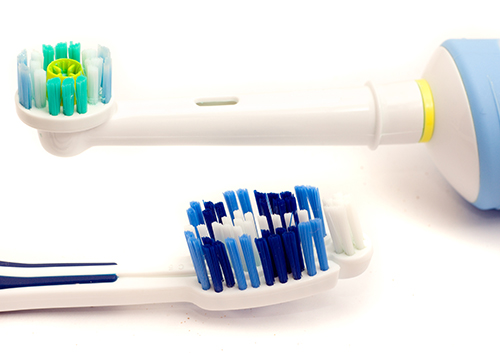
You live in the golden age of toothbrushes. Until a few decades people used twigs or brushes made from animal hair to clean their teeth: not very soft and none too effective.
Now, you have a choice of manual brushes with soft, medium, or hard bristles. Or you might choose to go with an electric toothbrush instead.
Have you ever wondered whether manual or electric brushes provide better cleaning? Actually, they both do the job. The key is to brush and floss every day, regardless of the kind of brush you prefer.
At our Anthem office, we like to say the best brush is the one you'll use. So if you prefer manual, go for it. If you prefer electric, turn it on.
Both types have their advantages but both types will get the job done as far as removing plaque.
Electric Toothbrushes
- Provide power rotation that helps loosen plaque
- Are great for people with limited dexterity due to arthritis or other problems
- Are popular with kids who think the electric brushes are more fun to use
- Can come with variable speeds to help reduce pressure on sensitive teeth and gums
Manual Toothbrushes
- Can help brushers feel they have more control over the brushing process
- Allow brushers to respond to twinges and reduce the pressure applied to sensitive teeth and gums
- Are more convenient for packing when traveling
- Manual brushes are cheaper and easier to replace than the electric versions.
In many ways, the golden age is just beginning. There are already phone apps available to remind you to brush and floss. New apps can play two minutes worth of music while you brush, help you compare the brightness of your smile or help explain dental procedures. Maybe someday we’ll even have programs that examine your teeth after brushing and identify spots you might have missed.
Shark Teeth
August 24th, 2023

It seems like sharks are everywhere these days—on land, sea, and air(waves). A halftime show meme gone viral. A week of summer TV devoted to our favorite apex predators. And who doesn’t have “Baby Shark” playing in their heads all day once they’ve heard it? But are we jumping the shark to discuss this topic in a dental blog?
Not at all! Because today, we’re going to talk about shark teeth—just not the ones you might be expecting.
One of the expected sights when a shark opens its mouth are those rows and rows of shiny shark teeth. Sharks can grow from two to 15 rows of teeth at any one time (and some sharks have even more). This means sharp new teeth are always ready to replace any shark tooth which is lost, broken, or worn out.
An unexpected sight? When children point to their new adult tooth or teeth coming in—right behind their still-firmly rooted baby teeth! This double set of teeth is called “shark teeth,” and, while it certainly might come as a surprise, it’s not all that uncommon. But why do children develop shark teeth at all?
After all, baby, or primary, teeth have small roots, and are designed to come out easily when the adult teeth start arriving. When a permanent tooth starts to erupt, it pushes against the root of the baby tooth above it. This pressure gradually dissolves the root of the primary tooth, and with nothing to anchor it, it’s now loose, wiggly, and ready to fall out. That’s why baby teeth often look like they have no roots at all when they eventually wiggle free.
Sometimes, though, the roots of a primary tooth don’t break down, which means baby teeth stay right where they are. It also means that the permanent teeth have to erupt somewhere else—usually behind those stubborn little baby teeth.
Shark teeth can first appear around the ages of five to seven when the permanent front teeth start arriving, or several years later, when the adult molars begin to come in. Any extra teeth in one small jaw naturally cause concerns about crowding and misalignment, especially when those extra teeth are molars. Fortunately, treatment is generally uncomplicated.
If the baby tooth is loose, time (and wiggling) might take care of the problem. But if the primary tooth or teeth just won’t budge, even after several weeks, it’s a good idea to schedule a visit with Drs. Peter Vogel, Vijal Vadecha—especially if your child is experiencing pain or discomfort.
An extraction is often suggested when a baby tooth has overstayed its welcome. Because of its smaller root, extracting a primary tooth is usually a straightforward procedure. Drs. Peter Vogel, Vijal Vadecha can let you know all the details, and can discuss sedation options if they’re appropriate for your child.
Whether baby teeth are left to fall out on their own, or given some assistance, most often your child’s permanent tooth will start moving to its proper position as soon as the space is available.
Unlike sharks, we don’t have an endless supply of replacement teeth, so it’s understandable to worry when you see anything unexpected. If you want to know more about shark teeth, or if you have any concerns, don’t hesitate to call our Anthem office for expert advice.
The Benefits of a Bright Smile
August 24th, 2023

Having a nice, bright smile can affect the way you look, and in turn, improve how you feel about yourself. With the help of Drs. Peter Vogel, Vijal Vadecha to provide you with a whitening treatment, you won’t have to be afraid to show your smile any longer.
It’s been shown that the first thing people typically notice is a person’s smile. Though many people don’t like to admit it, humans often judge others first on their looks.
Over time, your teeth may become stained from foods and beverages. Teeth-whitening techniques can be an effective solution to restore confidence in your smile and your life. Our team is here to help you regain your smile with brightened teeth that have been affected by wear.
Your smile can affect:
- Personal and work-related relationships
- Job interviews and meetings
- Success dealing with customers and potential clients
- Your confidence and general happiness
- Overall outlook on daily interactions
Regaining confidence in your smile can be helpful in all these areas of your life and more. If you think your smile has been holding you back, it may be beneficial to restore your white teeth with the help of Daisy Mountain Dentistry.
If you’re interested in enhancing your smile, feel free to reach out to our Anthem office and we will be happy to go over the whitening options we provide.
Pediatric Dental Emergency Know-How
August 17th, 2023

Parents are usually expert at taking care of their children’s injuries. You know how to disinfect a cut, soothe a bump on the head, and apply a bandage faster than you can blink.
But what happens if your child suffers a dental injury? Teeth can get broken, knocked out, or displaced from a forceful impact, and parents ought to know what to do in those situations, too. Luckily, Drs. Peter Vogel, Vijal Vadecha and our team are here to be a resource for such incidents!
Chipped front teeth are a common injury for young children. First, check to see if the teeth have been broken to the nerve. You can tell this is the case if you see layers and a pinkish center.
Then, wiggle each tooth to make sure it is not loose. If the teeth still feel firmly in place, that’s a good sign. Don’t worry if they are a little loose, because they will tighten again with time.
If your child develops a high temperature or bite sensitivity, treatment is necessary and could include a root canal.
A knocked-out tooth is an injury that requires more attention than just observation. Locate the tooth as soon as you can, and touch only the crown, not the root. Rinse any debris gently with milk or water and place the tooth back in its socket as soon as possible.
According to the American Association of Endodontists, a tooth has a high chance of survival and retention for life if it is returned to the socket within five minutes, and possibly up to 60 minutes, if soaked in milk or saline solution in the meantime.
Say your child is elbowed in the mouth and a tooth gets severely displaced but does not get knocked out. Attempt to shift it back into place by applying light pressure, but be careful not to use too much force. Give your child a cold pack for the swelling and contact our office as soon as possible.
Dental emergencies can be frightening for the child as well as the parent. The best advice we can offer is to stay calm and be assured that we are always here to help! Contact us at our Anthem office as soon as you can, if your child encounters a dental emergency.
When should I floss during the day?
August 17th, 2023
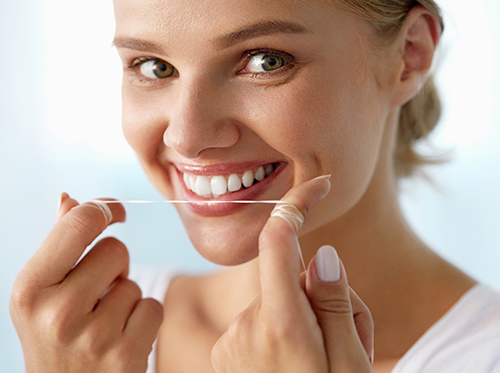
A vital step in your oral health routine is flossing. We hope our patients at Daisy Mountain Dentistry maintain good oral hygiene, including daily flossing between each visit to our Anthem office. A toothbrush is not always enough to get to the hard-to-reach areas of your mouth. When food remains between your teeth, bacteria starts to grow and will break down your enamel. This is where flossing comes in!
Should you floss before or after brushing?
Whatever your personal preference, you may floss before or after you brush your teeth. When you floss first, you can brush away any leftover dislodged food debris from your teeth. On the other hand, when you brush first, you will loosen the plaque between your teeth, which makes flossing more effective.
The essential aspect is that you floss thoroughly by using a fresh strand of floss and make sure to get between every tooth. Even if your teeth look and feel clean, don’t skip flossing or plaque will begin to build up on your teeth.
When is the best time to floss?
Although you should brush your teeth at least twice a day, Drs. Peter Vogel, Vijal Vadecha and our team recommend flossing your teeth thoroughly once a day. Many people prefer to floss before bed, so that plaque doesn’t sit between their teeth all night.
What kind of floss should I use?
You may choose between interdental cleaning picks or flexible floss strands to perform your daily flossing routine. If you have permanent oral appliances or restorations, be sure to follow the flossing instructions provided to you.
Do you need help flossing?
If you’re having trouble flossing or have questions about which floss is best for your teeth, contact our Anthem office and we can provide you with support. Be sure to keep up with your daily flossing routine, and we will see you at your next appointment!
How to get Brighter Teeth for Life
August 10th, 2023

Have you ever wondered why some people have dull and yellow teeth, while others have bright, white smiles? It’s not luck.
Everyone’s teeth naturally dull over time because of aging and the contact our teeth experience with staining foods, such as chocolate and coffee. However, teeth-whitening treatments can give you the whiter smile you’ve been after.
Get Regular Treatments
Unfortunately, the effects of teeth-whitening or bleaching treatments are only temporary, but regular treatments at Daisy Mountain Dentistry can help keep your teeth white for much longer.
The effects of in-office bleaching can last for several months to a year, so you may prefer to repeat your use of at-home bleaching kits every few months to maintain your white teeth. Whitening toothpastes do not contain bleach and are safe to use every day.
Have Realistic Expectations
Not everyone’s teeth can be turned bright white. Some just don’t respond to whitening treatments. If your teeth are a light yellowish color, they may readily respond to teeth-whitening procedures, but bleach will not likely work on grayish teeth. Brownish teeth tend to fall somewhere in between.
Practice Good Oral Hygiene
For the best whitening results, it’s necessary to keep your teeth in good health. Visible fillings, implants, or bridges that are metallic stand out against the white color you’ll want to achieve.
Maintaining good oral hygiene will help you avoid tooth decay and keep your smile bright. In addition to brushing your teeth twice a day, these actions can help promote a healthy mouth:
- Floss every day
- Visit our Anthem office every six months for professional cleanings
- Rinse your mouth with water after each meal and snack
- Limit sugary and starchy foods and beverages that can stain teeth, especially between meals
The Best Snacks for a Healthy Smile
August 10th, 2023

One of the most frequent questions that Drs. Peter Vogel, Vijal Vadecha and our team hear is about what kinds of snacks are best for a child’s dental health. Sugary snacks are inevitable sometimes, but it’s vital for you as a parent to monitor how frequently your child is eating the kinds of snacks that may give him or her a cavity or two down the line.
Unsurprisingly, the best snacks are healthy ones, though they may not always be the most appealing to your little ones. The good news is that healthy doesn’t mean you have to compromise on taste. Once your kids give these tasty snacks a go, they might become open to all things healthy!
- Fresh veggies and hummus
- Apple wedges with peanut butter
- Low-fat yogurt with berries
- Cubes of cheese and crackers
- Hard-boiled eggs with a little bit of salt and pepper
- Celery sticks with cream cheese and sunflower seeds
- A homemade milkshake with low-fat milk (or almond milk), the fruit of their choice, chia seeds, and cinnamon
- Lean proteins such as chicken breast, fish, and turkey
These snacks aren’t high in sugar but they contain all the nutrients your children need to have the necessary energy throughout the day.
This is only a sample of all the great, healthy snacks out there for your kids. For more ideas, ask us the next time you visit our Anthem office. It’s never too early to create healthy habits; they’re not only good for oral health, but overall health too. That’s a win-win, if you ask us.
How do I know if I need dentures?
August 2nd, 2023

The choice to get dentures is a permanent decision so there are several important factors you should take into consideration. Many people have teeth that are not able to be repaired due to a variety of reasons, but for those who have the option and the money to repair their natural teeth they need to consider every choice they may have.
You have a choice!
Yes, it’s true! We do have a choice about whether we will have to have dentures in the future. Many people don’t realize that just by taking certain precautions they can actually prevent any serious issues from arising. For example, it’s very easy to reschedule that dental cleaning. However, it’s very important that you keep every appointment because Drs. Peter Vogel, Vijal Vadecha will be able to catch small problems before you even realize you have them. Also, if there are any signs of gum disease you will know early enough to stop any further damage. One of the main reasons that many people end up needing dentures is because of either gum disease or because severe cavities have cause too many teeth to be extracted.
If you notice any of the following you should make an appointment at our Anthem office right away:
- Teeth are moving further apart
- Soreness or tenderness of the gums
- Trouble eating hard food
- Sensitivity
- You have already lost several teeth
- Toothaches
The key to avoiding dentures is prevention. Avoiding dentures is not impossible and can be as simple as staying on top of your oral hygiene. However, if you are currently experiencing any dental issues you should see Drs. Peter Vogel, Vijal Vadecha now, because a small problem can quickly escalate into a very large and expensive dental procedure.
Teeth Grinding: Not just a bad habit, but a dental concern
August 2nd, 2023

Perhaps you don't even know you grind your teeth. Maybe a spouse or loved one woke you up in the middle of the night and made you aware of what was happening.
For many people, teeth grinding is a habit and a mechanical reflex; when they’re awakened and informed they were grinding their teeth, they have no recollection of it at all. According to the American Dental Association, this is the nightly situation for roughly ten percent of Americans. From young children to the elderly, teeth grinding, known in the dental community as bruxism, is a serious concern.
Many people who grind their teeth in their sleep have no idea they're doing it. In fact, when they wake up in the morning they feel no jaw pain and their teeth are fine: if it hadn’t been for someone telling them about it, the teeth grinding would have gone unnoticed.
There are other people, however, who wake up with jaw pain, shoulder and neck pain, and headaches. Teeth grinding can cause a host of dental complications. From cracked teeth and receding gums to a misaligned jaw, teeth grinding is not something to take lightly.
Preventive measures are the key to combating bruxism, and a visit to Daisy Mountain Dentistry can set you on the path to a healthy and safe night sleep.
The Reasons for Teeth Grinding
There are many reasons for teeth grinding. For some people, it’s a habit they acquired when they were a child and never grew out of. On the other hand, some research claims that the condition is related to stress, anxiety, or some other type of psychiatric issue.
Still other studies point to everything from poor muscle control or over-eating before bed to gastro-esophageal issues. However, the root cause of the teeth grinding is less important than identifying preventive measures against it.
Common solutions to teeth grinding include:
- Wearing a protective nightguard
- Stress management techniques
- Medications and muscle relaxers
When you make an appointment with Drs. Peter Vogel, Vijal Vadecha at our Anthem office, we will assess your situation and determine what the best course of action is. Teeth grinding is a dental concern that can cause serious health issues down the road, so be sure to take preventive measures today.
What is a root canal?
July 27th, 2023

A root canal entails the removal of the nerve supply from a tooth. If you know the purpose of a root canal, the process may seem a little less intimidating.
Drs. Peter Vogel, Vijal Vadecha will explain the steps in person before your scheduled root canal. Here are some reasons why you may need one and how it will be done when you visit our Anthem office for your appointment.
Let’s look at the parts of a tooth. Teeth are made up of layers. The outside is the enamel you see, which is composed of minerals. The middle layer is called dentin. It is less dense and made of calcified tissues.
The center of the tooth, also known as the pulp, holds the nerves and blood vessels. When a tooth has decayed or been infected all the way down to the pulp, a root canal is used to remove and replace the root with a filling.
A cavity, sudden trauma, severe cracks, or other events that may cause nerve damage can start an infection of the root of your tooth. You may notice an infection if you experience abnormal pain, swelling, sensitivity, or change in tooth appearance.
Don’t hesitate to contact our Anthem office to schedule an examination if you notice these symptoms. We may need to take X-rays of the problem tooth to find out if a root canal is necessary.
Once an appointment is scheduled for a root canal and we’re ready to begin the procedure, you’ll be given anesthesia to keep you comfortable. The problem tooth will be isolated and sterilized. We work to remove all the infected area after that.
The treatment will include getting rid of nerve tissue and blood vessels, then filling in the spot where the nerve used to be. A crown is placed over the area to secure enamel from breaking down in the future and prevent the potential loss of the tooth. The root canal can block the possibility of having your tooth extracted due to decay or infection.
If you have further questions about root canals or notice any new issues in your mouth, please don’t hesitate to call our office and speak with a member of our staff. We’d be happy to answer your questions and schedule an appointment for you to come and get your problem tooth checked out.
Don’t forget: You can avoid having to undergo a root canal if we catch the problem early on!
Teeth Grinding
July 26th, 2023

If you are waking up with jaw pain, tension headaches, or facial pain, you may be suffering from a condition known as bruxism. This means you could be grinding or clenching your teeth while you sleep. Some people aren’t even aware they are grinding or clenching their teeth at night, until a visit to us reveals significant tooth enamel loss. Fortunately, there is a non-invasive and effective solution for teeth grinding, and the tooth enamel damage it can cause, in custom-fabricated nightguards.
Causes of teeth grinding
Tension, stress, and anxiety experienced during the daytime can carry over to an individual’s sleep, and lead the person to grind his or her teeth together or clench the teeth unknowingly. Sleep apnea is another condition that can result in bruxism. Regardless of the cause, however, frequent clenching and teeth grinding wears down the chewing surfaces of the teeth, reduces tooth enamel, and can result in a cracked or chipped tooth, crown, or filling.
Nightguards for teeth grinding
Custom nightguards are fabricated to fit like a glove and protect your teeth from the adverse effects of bruxism. Nightguards are created through a non-invasive process that simply takes an impression of the bottom and top rows of teeth. The result is a nightguard that is flexible, comfortable, and personalized to your mouth.
Benefits of nightguards
Nightguards are helpful to reduce or eliminate the symptoms of dental damage incurred as a result of teeth grinding. They can reduce the discomfort associated with a sore jaw, headaches, tooth sensitivity, ear pain, and facial pain that many patients experience as a result of clenching or grinding of their teeth. In severe cases of bruxism, patients can develop loss of hearing, jawbone misalignment, and TMJ. Therefore, customized nightguards can help prevent the progression of teeth grinding into these more serious conditions.
At-home tips to reduce or prevent teeth grinding
Although it’s important to wear your nightguard faithfully if you grind your teeth at night, you can follow a few self-care tips to help to prevent your teeth grinding from worsening.
- Reduce tension and stress. Whether you take a warm bath before bed, listen to soothing music, or exercise, practice stress-relieving activities to wash away the tensions of the day.
- Avoid alcohol. In some patients, alcohol increases teeth grinding tendencies.
- Avoid caffeine. In some individuals, caffeine increases the likelihood of teeth grinding.
- Focus on relaxing jaw muscles. Make a conscious effort to keep your jaw relaxed. A warm washcloth against your cheek, sticking your tongue between your teeth, and avoiding chewing pencils, pens, and gum are all ways to train the muscles of your jaw to stay relaxed.
If you suspect you may be grinding your teeth at night, visit Drs. Peter Vogel, Vijal Vadecha and our team at Daisy Mountain Dentistry for an evaluation at our convenient Anthem office.
Satisfying a Sweet Tooth
July 20th, 2023

Time for some sweet talk! Many studies have been done to figure out why we enjoy sugar so much. Is it brain chemistry? Is it blood sugar getting a bit low? Is it our bodies craving a quick burst of energy?
It’s probably all of the above and more besides. After all, our biochemistry makes use of sugars on a cellular level. The carbohydrates in our diet break down into sugars, and these sugars are the body’s preferred source of energy.
Problems arise when we get too much of a good thing. There’s a difference between the carbs we need to fuel our bodies and the sugars we add to foods for flavor. Too many added sugars in the diet are linked to a number of medical conditions, including obesity, diabetes, heart disease, even prematurely aging skin.
And, of course, a sugar-heavy diet has a direct effect on your oral health.
There’s no way to sugar coat it. Plaque is mainly composed of bacteria, which feed on sugars. As they digest sugar, they produce acids. These acids attack our enamel, dissolving the calcium and phosphorus minerals which keep it strong. Weakened enamel leaves teeth vulnerable to decay, and decay creates cavities.
It’s natural to want a sweet treat every now and then, but without some attention, it’s easy to go overboard with added sugars and empty calories. If you’re searching for a middle way, balancing your love for sweet things with your love for cavity-free checkups, read on!
Be Choosy
- Check and compare labels for added sugars. You’ll be surprised how many foods have a high sugar content, even such health-oriented foods as flavored yogurts, sports drinks, fruit drinks, and protein bars.
- Consider the (sugar) source. White and brown table sugars and syrups break down easily as we’re eating them, adding empty calories which provide little nutrition, and increasing acidic conditions in the mouth.
Fruits, on the other hand, provide vitamins, minerals, antioxidants, and fiber along with their natural sugars. Switch out cookies, cakes, and pastries and their processed sugars for fruit when you crave something sweet.
- Chocolate lovers, don’t despair! It’s true, unless you’re eating 100% cocoa, you are probably getting added sugar in your candy bar. But dark chocolate is rich in antioxidants, iron, zinc, magnesium, and other essential minerals, too. When you indulge in chocolate, give dark chocolate a try.
- Not all candies are created equal! Soft candy bars and candies are healthier for your teeth than sticky or chewy confections, which tend to remain on your enamel for quite some time. Choose a treat that won’t stick with you.
Watch Your Timing
- If you must snack during the day, it’s better to choose foods without a high sugar content. Bacteria use sugars to produce acids right away. Saliva can neutralize acids in the mouth, but it takes at least 20 minutes for the process to start.
More meals mean more sugar, more acid production, and more time for these acids to cause their damage. That’s why we also suggest you . . .
- Eat your favorite dessert with a meal instead of waiting until later. You’ll be able to enjoy it even more knowing you’re limiting your exposure to harmful acids.
- Taking your time is not a good idea when it comes to sweets. We don’t mean you should gobble your food. We do mean that taking sips of sugary beverages throughout the day, or sucking on slowly dissolving candies, gives you a lot more exposure to sugar over a longer period of time.
Small Changes Can Make a Big Difference
- Drink water after enjoying something sweet to help wash away and dilute sugar.
- Straws protect your teeth from a sugar-bath if you are drinking sodas, sweetened energy drinks, or other sugary beverages.
- Sugar-free gum provides a burst of sweet flavor without added sugar. And even better? Chewing gum increases saliva, washing away food particles and acids and bathing teeth in enamel-strengthening minerals.
It’s natural to appreciate a sweet treat every now and then. If you’re not ready for a completely treat-free life, talk to Drs. Peter Vogel, Vijal Vadecha at our Anthem office about the best ways to have your cake and eat it—or even better, to recommend healthy substitutes to satisfy your sweet tooth.
A Variety of Dentures to Meet Your Needs
July 19th, 2023

With advancements in prosthetic dentistry, patients are now able to wear dentures that are comfortable, natural looking, and long lasting. There are different options to choose from that will meet your individual needs, whether you have a few teeth missing or have lost all of your teeth. Drs. Peter Vogel, Vijal Vadecha will be able to help you decide which denture option is best for you.
Partial Dentures
Patients who receive partial dentures have some of their original teeth still in place and therefore only need a partial to replace the missing teeth and keep their existing teeth from moving. It also makes sense that patients need them to be able to eat comfortably. All dentures are made from porcelain or plastic and are made with comfort in mind.
Complete Dentures
If you have suffered from complete tooth loss, you would typically receive complete dentures. Immediately after you have your teeth extracted you will leave the dentist office with a set of temporary dentures. These will be worn for a few months while your mouth heals. After this initial wait time, your conventional or permanent dentures will be ready to be fitted.
Implant-Supported Dentures
Implant-supported dentures involve a more invasive procedure, but are also permanent. A select number of implants are placed into the jaw. The denture is then attached to the implant posts. You will be able to chew normally and maintain normal dental hygiene, like brushing and flossing.
Drs. Peter Vogel, Vijal Vadecha will be able to advise on which kind of denture would be the best based on your individual needs. Contact our Anthem office to schedule an appointment!
Do I lose my wisdom if I lose my wisdom teeth?
July 13th, 2023

The third molars have long been known as your “wisdom teeth,” because they are the last teeth to erupt from the gums – usually sometime during the late teens to early twenties. This is a time in life that many consider an “age of wisdom”; hence the term, “wisdom teeth.”
Extracting the third molars does not have any effect on your actual wisdom … and Drs. Peter Vogel, Vijal Vadecha and our staff are sorry to say that holding on to them can’t make you smarter, either. So if you somehow feel that you became wiser and smarter when your wisdom teeth appeared, chalk it up to age rather than teeth.
In fact, you may just be showing how smart you are by having your wisdom teeth removed. Mankind once relied on the wisdom teeth to replace teeth that were damaged or missing, thanks to a poor diet. But dietary changes and advances in modern dentistry make it possible for many people to hold on to their teeth for many decades, which eliminated the need for third molars.
For many people, wisdom teeth cause nothing but problems: becoming impacted, irritating surrounding gum tissue, or even causing other teeth to become crooked or overlap. By removing them, patients often enjoy a lower risk of decay, infection, and aesthetic complications.
So rest assured that extracting your wisdom teeth will have no effect on your immediate or long-term intelligence.
Do adults need fluoride treatments?
July 12th, 2023

Many dentists and hygienists recommend fluoride treatments for their adult patients. You might ask yourself, “Do I really need a fluoride treatment? I thought those were just for my kids.” After all, most insurance plans cover fluoride treatments only up to the age of 18.
What you need to know as a dental consumer is that studies have shown topical fluoride applications performed by a dental professional create a significant benefit for adults who have moderate to high risk for cavities.
There are several circumstances that warrant extra fluoride protection among adults. Many prescription medications reduce saliva flow or otherwise create dry mouth. A reduction in saliva increases cavity risk.
Adults often experience gum recession, which exposes part of the root surface of teeth. These areas are softer than the hard enamel at the top of the tooth, which makes them more susceptible to decay.
In addition, adults often get restorative work such as crowns or bridges. Fluoride can help protect the margins of these restorations, ultimately protecting your investment.
Today many people opt for orthodontic treatment (braces) as adults. Braces make it more challenging for patients to maintain good oral hygiene. Just ask your kids! Fluoride can keep the teeth strong and cavity-free even with the obstacle of orthodontic appliances.
Have you had a restoration done within the last year due to new decay? If you have, that puts you at a higher risk for cavities. Fluoride treatments are a great way to prevent more cavities in patients who are already prone to them.
How is that flossing coming along? You know you should floss daily, but do you? If your oral hygiene is not ideal, fluoride could be just the thing to keep your neglect from leading to cavities between your teeth.
Fluoride can also help with the growing problem of sensitive teeth. Diets high in acidic foods and beverages, general gum recession, and increased use of whitening products all tend to produce sensitive teeth. Fluoride treatments re-mineralize tooth enamel and reduce that sensitivity.
Patients who undergo radiation treatment for cancer also benefit from topical fluoride applications. Radiation damages saliva glands, thus greatly reducing the flow of saliva. Saliva acts as a buffer against the foods we eat and beverages we drink. Once again, less saliva greatly increases the risk of cavities.
If one or more of these conditions applies to you, consider requesting a topical fluoride treatment. Be sure to ask Drs. Peter Vogel, Vijal Vadecha at your next appointment whether you might benefit from a topical fluoride application.
Tell us about your summer!
July 6th, 2023

The dog days of summer are upon us, and what better time for Drs. Peter Vogel, Vijal Vadecha and our team to ask our patients about their summer!
Whether you visited our nation’s capital, went on a camping trip, or just stayed in Anthem and relaxed, we want to know how you’re all spending your summer! Please feel free to share your summer plans and experiences with us below or on our Facebook page as summer rolls on!
Summer Dental Health? Get into the Swim of It!
July 6th, 2023

On a sizzling hot day, there’s not much that makes us happier than heading to the water for a quick swim, some gentle laps, or even a rousing game of water polo. And this being a sizzling hot dental blog, we are happy to offer some tips on how to make your summer swim good for your dental health as well as your mental health!
- Mouthguards
You might use your mouthguard all the time—for biking, or basketball, or skiing. But in the pool? Absolutely! Anyone who has played water polo knows what a physical workout it is. Elbows! Hard tosses! Collisions! And it’s not just pool sports. Water-skiing on the lake, surfing in the ocean—anywhere humans and solid objects are involved, tooth and jaw injuries are possible. Don’t spend valuable summer hours tending to a cracked or broken tooth as a result of sports accidents.
And, unlikely though it seems, even hanging by the pool can be hazardous to your smile. Hard concrete edges wait to greet surfacing divers. Slippery cement and tiles surrounding the pool are the downfall of many a swimmer running to jump back into the water. Be aware of possible dental dangers, and use a mouthguard as a great proactive way to avoid them.
- Swimming Pools & Chlorine
Ah, the smell of chlorine! We all want to know that swimming pools are as clean as they can be, and one method of keeping them that way is with the addition of antimicrobials to the water. But too much exposure to chemicals can cause enamel erosion, or even a condition called “swimmer’s calculus.” Swimmer’s calculus is recognized by a hard, brownish, tartar deposit that appears on the front teeth of swimmers who spent a lot of hours in the pool. It’s a cosmetic problem, but one that’s difficult to get rid of without a professional cleaning. If you’re a competitive swimmer, or simply someone who spends many hours a week in treated water, give us a call if you notice hard-to-remove discoloration or tooth sensitivity.
- Retainers
Different people have different opinions on whether or not your retainer should be exposed to the chlorine in pool water. (Or the salt in saltwater or the bacteria in lake water.) Ask us for ours! But you’re best off leaving it in your bag or locker, anyway, because retainers can be easily lost in the water. They might be able to survive a swimming pool, but a lake or ocean rescue is very unlikely. Just remember to put your retainer in a case, in a safe spot, and replace it when you’re out of the water for the day.
Enjoy your time on the water, and don’t forget to schedule an exam with Drs. Peter Vogel, Vijal Vadecha and a professional cleaning if you haven’t been in the office for a while. If you do have a dental problem or an accident, give our Anthem office a call immediately. We want to make sure you dive in to summer fun with a healthy, beautiful smile!
Just What Is a Cavity, Anyway?
June 29th, 2023

So you might be wondering, just what are cavities? How do we get them? What do they do to our teeth? How can we prevent them? Let’s talk!
Our teeth need to be strong to bite and chew. That’s why they are protected by a coating called enamel, which is made up of very hard minerals. Enamel is the strongest part of our bodies—stronger even than our bones. But this doesn’t mean nothing can hurt it! And cavities, also called tooth decay, are one of the most common dangers facing our enamel.
So, what are cavities?
A cavity is a hole in your tooth enamel. If your tooth is not cleaned and repaired when a cavity is small, this hole can grow bigger until tooth decay reaches the inside of your tooth. Enamel doesn’t heal when it’s damaged, so you need to see a dentist to make your tooth healthy again.
How do we get cavities?
Bacteria are tiny little germs. Many kinds of bacteria live in our bodies, and some of them are quite helpful. The bacteria which cause cavities are not. These unhelpful bacteria join with our saliva and very small pieces of the food we’ve chewed to make a sticky film called plaque.
Like other living things, the bacteria in plaque need food. They get that food from the foods we eat, especially sugars and starches. As they eat, they change these sugars and starches into acids, and these acids attack the minerals which keep enamel hard and strong.
Because plaque sticks to our teeth, bacterial acids are able to make weak spots in enamel if the plaque isn’t brushed away. If you see a white spot on your tooth, that could mean that your enamel is losing minerals, and getting weaker.
What do cavities do to our teeth?
Over time, weak spots can grow bigger until there’s a hole in the enamel surface. If the cavity in your enamel is small, you might not notice it at first. But cavities can become wider and deeper, and even break through enamel to reach the inside of your tooth.
The inside of each tooth holds pulp, the part of your tooth which keeps it healthy. If tooth decay spreads to the pulp, it can cause more damage and infection, so it’s important to treat a cavity right away.
Dark spots on your enamel, a toothache, pain when you drink something hot or cold or when you bite down—these can be clues that you have a cavity, and you should visit us for an exam.
How can you prevent cavities?
Even better than treating a cavity is preventing one. Let’s make a list of some helpful do’s and don’ts for cavity prevention:
- Do: Feed yourself foods which are good for you.
Foods like milk and cheese and many dark green vegetables have lots of calcium and vitamin D to help keep your enamel strong.
- Don’t: Feed bacteria foods which are good for them.
Sugar and simple starches like potato chips are the kinds of foods bacteria like best, because they are easy to break down. This means more acids to attack your enamel.
This doesn’t mean you should never enjoy a treat! But eating lots of starchy snacks and drinking sugary sodas means more plaque, and more plaque can mean more cavities. If you’re eating something starchy or sweet, it’s a good idea to brush or rinse afterward.
- Do: Brush at least twice a day, for at least two minutes, with fluoride toothpaste.
This is the best way to get rid of plaque, which builds up every day. And fluoride toothpaste even helps make your enamel stronger.
- Don’t: Forget to floss.
Flossing takes a while to learn to do well, but it’s very important. Flossing helps prevent cavities between the teeth and near the gums.
- Do: Visit our Anthem dental office for exams and cleanings.
Not only will we look for cavities, we’ll let you know the best way to brush and floss so you can get your teeth their cleanest.
- Don’t: Feel bad if you get a cavity!
Some people are more likely to get cavities than others, even when they brush just right and eat healthy foods. If you have a cavity, we can remove decay and repair your tooth with a filling.
And one last thing to do: talk to Drs. Peter Vogel, Vijal Vadecha if you have any questions about the best ways to protect your teeth from cavities. We have lots of suggestions to help you take care of your healthy, beautiful smile!
How many times a day should I floss?
June 29th, 2023
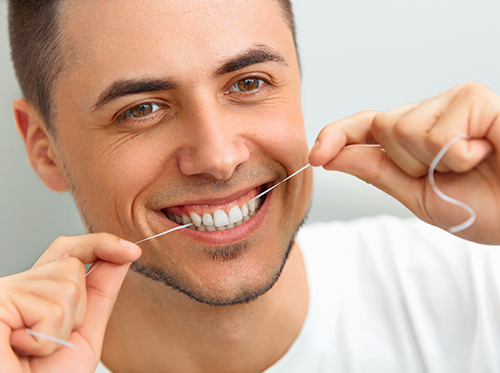
Flossing is one of the most important parts of your oral care routine. Many patients know they need to do it but find it difficult to fit into their busy lives. Well, here's the good news: flossing once a day is enough if you're doing a good job!
Some patients like to brush before they floss and others like to floss before they brush. Some like to floss in the morning when they have more energy, others like to floss at night so they can go to bed with a clean mouth. Don't get hung up on any of this, the important thing is that you floss and floss effectively no matter when you do it.
Effective flossing contributes to oral health in these ways:
- It reduces the chance of cavities between teeth, since cavities can only form on teeth covered with dental plaque and you're scraping that plaque away when you floss.
- Along with brushing, it reduces the amount of time the plaque is left on your teeth, allowing them to be in a state of healing and remineralization for longer.
- It removes plaque that accumulates at or below the gum line, aiding in the prevention of gum disease.
As you can see, flossing offers many benefits for such a simple and inexpensive technique. So if you're still wondering how much to floss, don't worry about it. Don't mistake the frequency of your flossing with the effectiveness of it. Choose a dental floss that you like and one time during the day when you can floss thoroughly and just do it! If you need more tips on how to floss correctly, ask Drs. Peter Vogel, Vijal Vadecha or any member of our Anthem team—we'd be glad to help you pick up this healthy habit!
Thumb Sucking, Pacifiers, and Your Baby's Teeth
June 22nd, 2023

Sucking is a common instinct for babies and the use of a pacifier or their thumb offers a sense of safety and security, as well a way to relax.
According to the American Academy of Pediatric Dentistry, the majority of children will stop using a pacifier and stop sucking their thumb on their own between the ages of two and four years of age. Prolonged thumb sucking or use of a pacifier can have dental consequences and needs be taken care of sooner, rather than later.
Many dentists favor pacifier use over thumb sucking because it makes it easier for parents to control and even limit the use of a pacifier. If thumb sucking lingers, the same strategies used to break the baby from using the pacifier can be used for thumb sucking.
Precautions
- Try to find "orthodontically correct" pacifiers, as they may reduce the risk of dental problems.
- Never dip a pacifier in sugar or honey to calm the baby.
- Give your baby a bottle of water at bedtime, never juice.
Dental Complications
Long term pacifier use can lead to an assortment of dental complications including:
- The bottom teeth leaning inward
- The top teeth slanting outward
- Misalignment of the baby’s jaw
The risk of any or all of these things happening is greatly increased if thumb sucking and pacifier use is sustained after the baby’s teeth start to come in.
Breaking the Thumb Sucking and Pacifier Habit
Most toddlers and children will stop sucking their thumb or using a pacifier between the ages of two and four on their own. However, if intervention is necessary here are a few tips to help your child break the habit:
- Slowly decreasing the use of a pacifier can be effective for many children. This method does not work very well with thumb sucking.
- Thumb sucking can be more difficult to break. Drs. Peter Vogel, Vijal Vadecha may recommend using an over the counter cream that you put on the child’s thumb; it doesn’t taste good and usually does the trick.
- Rewards can also help with the process.
- If these simple commonly used strategies do not work, there are oral devices that will prevent a child from sucking their thumb or a pacifier.
Talk to Drs. Peter Vogel, Vijal Vadecha and our team, as we have many tricks up our sleeves that will be effective in breaking your child’s thumb sucking or pacifier use.
Electric Toothbrush Innovations
June 22nd, 2023

If you’re happy with your manual toothbrush, read no further. But if you’re looking for more options than “firm,” “medium,” or “soft,” there’s a world of electric toothbrush innovations out there waiting to make your brushing routine not only more efficient, but interactive as well! What does innovative toothbrush technology offer?
A Menu of Brushing Options
Some brushes now offer several different modes to choose from, depending on how you want to use your electric toothbrush. There are options for sensitive teeth, polishing, deep cleaning, massage, or gum care along with the regular cleaning setting. Whether you want whitening action or a gentle massage for teeth and gums, there’s a brush out there for you.
Pressure Sensors
Electric toothbrushes are a great way to avoid brushing too vigorously. Even with soft bristles (which should be your go-to choice), a manual toothbrush can irritate sensitive gum tissue if it is applied with too much pressure. And over time, harsh brushing can lead to enamel damage. An electric toothbrush, on the other hand, provides consistent, gentle brushing with normal use. If you still have a tendency to be a bit heavy-handed, a helpful pressure sensor can provide a warning light or actually reduce the brush’s motor speed to get you back on track.
Smart Toothbrushes
There’s an app for it! Many electric models offer wireless connectivity to an app that monitors your brushing habits. You can track your brushing time, get a reminder when your brush head needs changing, even view a map of the areas you’re cleaning effectively—and the ones you’re missing. Check out individual models to see just what you can learn from your smart brush.
USB Charging
No need to search for outlet space or amass a collection of travel adapters any longer. USB charging cases makes your electric toothbrush convenient and portable.
And more innovations are in the works—fully biodegradable toothbrush heads, toothbrushes powered only by water or kinetic energy, and an app that offers games while you brush. For toothbrush traditionalists, a manual toothbrush will still do a great job. But if you are looking for the latest in toothbrush technology, explore what the newest electric brushes can do for you. Ask Drs. Peter Vogel, Vijal Vadecha during your next appointment to our Anthem office. The end goal of toothbrush innovation, after all, is healthy teeth and gums. Make your next selfie something to smile about!
How do I prevent oral cancer?
June 15th, 2023

The fact is, according to the Oral Cancer Foundation, close to 40,000 Americans will be diagnosed with oral or pharyngeal cancer this year, resulting in more than 8,000 deaths. Men face twice the risk of developing oral cancer as women, and men who are over age 50 face the greatest risk. The American Cancer Society recommends an oral cancer screening exam every three years for people over the age of 20 and annually for those over age 40. The five-year survival rate is only 50 percent, and oral cancer, which is the sixth-most common diagnosed form of the disease, is one of the few cancers whose survival rate has not improved. Today, Drs. Peter Vogel, Vijal Vadecha and our team would like to take this opportunity to remind all of our patients about the importance of maintaining good oral hygiene to prevent the disease.
So, what can you do at home to take an active role in preventing oral cancer?
The American Cancer Society recommends an oral cancer screening exam every three years for people over the age of 20 and annually for those over age 40. In addition, we encourage you to:
- Conduct a self-exam regularly. Using a bright light and a mirror, look at and feel your lips and gums. Try tilting your head back to look at and feel the roof of your mouth, and pull your cheeks out to look inside of your mouth, the lining of your cheeks, and your back gums. Pull out your tongue and look at all surfaces. Feel for lumps or enlarged lymph nodes in both sides of your neck and under your lower jaw. Please give us a call immediately if you notice any changes in the appearance of your mouth or any of the signs and symptoms mentioned above.
- Don’t smoke or use any tobacco products and drink alcohol in moderation.
- Eat a well-balanced diet. This includes eating a wide variety of foods from the five primary food groups on a daily basis to meet the recommended amounts of vitamins, minerals, carbohydrates, proteins, and fats you need in a given day.
- Limit your exposure to the sun. Repeated exposure increases the risk of cancer on the lips, especially the lower lip. When out in the sun, be sure to use UV-A/B-blocking sun protective lotions on your skin as well as your lips.
Please let us know if you have any questions about your oral health, either during your next scheduled visit, by giving us a call, or asking us on Facebook.
Celebrate Your Dad's Smile
June 15th, 2023

Father’s Day is coming up, and, just in case your dad has enough ties, we have some gifting suggestions for you. Here’s a selection of gifts large and small tailored to your dad’s interests and his dental health.
- The Outdoor Dad
If your dad is happiest out camping, or his most relaxed at the lake fishing, or gets rid of stress with a 20-mile hike, help your dad stay happy, relaxed, and stress-free with an emergency dental kit for any unexpected problems which might crop up during his adventures.
You can find these lightweight kits in sporting stores and online. Supplies like cotton rolls, dental floss, oral pain relievers, a dental mirror, and even temporary fillings are included, because, as your dad no doubt told you, it’s always best to be prepared!
- The High-Tech Dad
For the dad who’s first with the latest in smart phones and tablets, a new smart toothbrush might tick all the boxes.
Modern electric toothbrushes have plenty of options for the tech-savvy. They come with different settings for brushing and massaging. They can let your dad know if he’s brushed long enough (two minutes, please!), if he’s brushing too hard, or when the brush head needs to be retired. Smart models even link to apps, which can, among other things, map out any missed spots in his brushing coverage or suggest more effective brushing angles.
- The Dad on the Go
With his active life, any gift which makes your dad’s busy schedule run more smoothly is a good thing—such as a portable kit filled with dental necessities.
A travel toothbrush, a small tube of his favorite toothpaste, a compact mirror, dental picks, dental floss, and a mini-bottle of mouthwash are great basics for a confident smile any time of day. Put everything in a sturdy lightweight travel bag. And don’t forget to include a pack of sugarless gum! Sugarless gum helps increase saliva flow (for better hydration) and decrease oral acidity (to help prevent enamel erosion).
- The Dad with Gourmet Taste
If your dad has foodie tastes, a thoughtfully curated gift basket is a great idea for pleasing his palate and supporting his dental health.
Include items like cheeses, which are full of calcium and phosphorus for strong teeth. Fresh fruits provide vitamins for healthy teeth and gums. Nuts offer plenty of tooth-healthy minerals and vitamins, as well as packing a protein punch. For your dad’s sweet tooth, dark chocolate (at least 70% cacao) is a great source of antioxidants, iron, zinc, magnesium and other valuable minerals. It’s lower in sugar content, and some studies suggest that dark chocolate has cavity-fighting properties and supports gum health.
- The Athletic Dad
He can deke the goalie, throw a perfect spiral, and hit those threes from downtown. Or, at the very least, he gives his favorite sport his best shot! If your dad has some of his happiest moments, win or lose, on the ice, the gridiron, the court, or any other sporty venue, consider a custom mouth guard to protect his winning smile.
Custom guards are more comfortable than store-bought options because they are molded to fit the user’s teeth and mouth precisely. This is especially helpful for those with dental work like braces or bridges. And, because the fit is custom, breathing and talking are easier.
- The Picture-Perfect Dad
Your dad’s smiles light up family photos! And if he’s ever expressed an interest in lightening and brightening that beautiful smile, a professional whitening treatment might be a perfect gift.
Professional whitening at our Anthem office is the most effective way to brighten teeth, with results which are generally faster and more long lasting than over-the-counter treatments. And it’s done with your dad’s dental health in mind, with a checkup to make sure his teeth are in perfect shape before whitening, and with protective measures in place for sensitive mouth and gum tissue.
Of course your dad will appreciate another tie, or any other traditional gift, because you give it to him. But just in case you’re looking for something a little different to celebrate Father’s Day, choose a dental-healthy gift designed with your dad in mind—so you can celebrate his smile for years to come!
Lip Service
May 31st, 2023

When you think of Drs. Peter Vogel, Vijal Vadecha, you naturally think of your teeth. But your dental professional is concerned with more than the teeth, as important as they are. All aspects of your oral health—gums, bite, tongue, mouth—contribute to your well-being. So many elements go into creating your beautiful smile, and your lips? They’re front and center.
- SPF—BFF
You already know that sunscreen is your best friend when it comes to protecting your skin. But don’t forget your lips when you’re slathering on the sunscreen! Delicate lip tissue is also susceptible to the sun’s damaging UV rays. Use a lip balm or lipstick with an appropriate SPF (Sun Protection Factor) for your skin type, and apply it liberally. Don’t forget to reapply every hour or two, after eating and drinking, and after going in the water. And if you’re protecting your children from the sun’s rays, check with your doctor about using sunscreen on young lips.
- Healthy Hydrating
Dry, chapped lips are no one’s go-to look. And while moisturizers and balms can help dry lips recover, there’s a simple preventative measure you can take to avoid or reduce dryness. You know how important water is for our bodies, and it’s essential for hydrating our lips as well. Make sure you drink the recommended amount of water each day for lips (and skin!) that are healthy and hydrated.
Not so healthy liquids? Alcohol. Alcohol is dehydrating, which undoes the benefits of that water you’ve been drinking. More than that, excessive alcohol consumption has been linked to oral cancer, especially when coupled with tobacco use.
- Toss the Tobacco
All tobacco users have an increased risk for oral cancer. Pipe and cigar smokers are particularly at risk for lip cancers, and smokeless tobacco users have a greater risk of cancers on the inner lip surface. Need another reason to quit? Smoking leads to an increase in lip lines (wrinkles) and a decrease in lip volume.
- Oral Exams
When you come to our Anthem office for regular checkups, you can also get regular screenings for oral cancer and other oral conditions. While irregularities are often benign, lip cancer is one of the most common forms of oral cancer, and detecting cancerous or precancerous lesions as early as possible is important for treatment. If you have a sore or lump that doesn’t go away, a red or white patch of skin, bleeding or pain, or any other symptom that concerns you, talk to Drs. Peter Vogel, Vijal Vadecha.
Protect yourself from the sun, hydrate, use alcohol in moderation, give up tobacco if you are using it, and see your dentist regularly for examinations. These simple practices are beneficial not only for your expressive lips, but for your overall health and well-being. And feel free to spread the word—healthy habits and preventative care should be on everyone’s lips!
Foods can Wreak Havoc on Your Enamel
May 31st, 2023

It’s possible to develop tooth decay even when you take great care of your teeth. Brushing and flossing may not be enough to keep your teeth healthy, depending on your diet. Cavities, discoloration, and decay are still possible when certain foods feature in your daily intake. Keep an eye out for foods that will damage your enamel and cause the very issues you’ve been trying to avoid.
What causes enamel damage?
Tooth enamel is the hard outer layer of your teeth that is made of various minerals. Tooth decay results when the acids in your food react with the minerals in your enamel. Strongly pigmented foods may also cause unsightly discoloration on the surface of your teeth. Avoid wreaking havoc on your beautiful smile by identifying the foods that can harm your enamel.
Acid
Acidic food is your teeth’s worst nightmare! This is the greatest cause of enamel damage, even if you brush and floss regularly. To avoid damaging your teeth, make sure you can determine whether a food is acidic or not.
The pH levels are a way to determine acidity on a one-to-seven scale. This defines the relative acidity or alkalinity of a food or substance. Foods with high pH levels are not as likely to harm your enamel.
It’s wise to avoid or minimize foods that are high in acids. Highly acidic food can include fruits such as lemons, grapefruit, strawberries, grapes, and apples. Moderately acid foods may surprise you; they include tomatoes, maple syrup, pickles, and honey.
Not surprisingly, eggs and dairy products such as milk and cheese contain the least amount of acid. Red wine and coffee can also discolor your enamel if they’re drunk in excessive amounts.
What can I do to prevent enamel damage?
There are plenty of ways to avoid discoloration and decay of your enamel. The best thing to do is limit the amount of high-acid foods, including sugary juices and soda, in your diet.
Another way is to brush and floss regularly, an hour after each meal. If you can’t make time to brush, an easy solution is to swish your mouth with water or mouthwash to rinse away any leftover acidic particles.
Damaged tooth enamel may be common, but is avoidable when you know which foods to stay away from and the steps to take after you do eat highly acidic foods. Take our advice and you’ll be sure to slow down any future discoloration and decay that happens in your mouth.
For more advice on protecting your enamel, give our Anthem a call to learn more!
Good Teeth Lead to Sporting Success
May 24th, 2023

You already know that taking care of your teeth can help prevent tooth decay and the need for extensive work such as root canals or implants, which can be inconvenient and expensive. But the benefits of good teeth can go far beyond having an attractive smile and being able to crunch carrots and chew meat.
The American Dental Association explains that healthy teeth are linked to a lower risk for heart disease and diabetes. Furthermore, recent research published in the British Journal of Sports Medicine states that good teeth can improve athletic performance among elite athletes.
Researchers examined the oral health of nearly 300 athletes in 25 sports at the 2012 Olympics in London. They looked for conditions such as dental caries, gingivitis, dental erosion, and periodontal disease, and asked about recent visits to a dentist.
Study investigators also asked athletes whether their oral health interfered with quality of life or athletic training and performance. The study concluded that poor oral health and fewer dental visits led to interference with preparation for competition.
This can happen for a few reasons. Tooth pain can disrupt sleep, which leads to slower reaction times. Oral health conditions can indicate chronic inflammation in the body, which means suboptimal performances on an elite level. Tooth pain can interfere with focus during training and competition.
Unfortunately, merely taking good care of your teeth won’t turn you into an Olympic gold medalist. However, the benefits can still be worthwhile. Even if healthy teeth provide little if any detectable gain in your athletic abilities, the potential benefits of maintaining a healthy mouth clearly go far beyond an attractive smile.
Practicing good oral hygiene and seeing Drs. Peter Vogel, Vijal Vadecha regularly can promote your physical health, and maybe – just maybe – you will start to achieve an advantage over your weekend athletic opponents.
Your Snoring Might Be More Serious Than You Think
May 24th, 2023

Sleep apnea is a disorder in which breathing stops and starts repeatedly throughout the night. It’s most common among middle-aged adults, and the most prevalent symptom is loud snoring.
Sleep apnea occurs when the muscles in the back of your throat relax to the point where they inhibit your natural breathing. It can cause your breathing to stop for anywhere from ten to twenty seconds. In the worst cases, it can even stop your breathing for up to a few minutes.
In addition, people who suffer from sleep apnea wake up feeling tired and unrested. The condition may even lead to depression, high blood pressure, irritability, and memory loss. It puts you at a greater risk for heart attack and lowers oxygen levels in your brain.
All of this sounds scary, but the good news is that sleep apnea can be treated! One of the most common ways Drs. Peter Vogel, Vijal Vadecha can treat sleep apnea is by creating an oral device for you to wear while you sleep.
The device brings your jaw forward, which keeps the airway open and lowers the incidence of snoring. Another method is to use a continuous positive airway mask, often referred to as a CPAP. The mask fits over the mouth and forces oxygen through the throat while you sleep.
If you’re unsure about whether you may suffer from sleep apnea, visit our Anthem office and let Drs. Peter Vogel, Vijal Vadecha know. We can determine the appropriate treatment if any is needed. Don’t risk losing another night’s sleep over something we can easily treat!
Minimally Invasive Dentistry
May 18th, 2023

As the field of dentistry advances and the use of technology in the field increases, the concept of minimally invasive dentistry has emerged. Preservation of a healthy set of natural teeth for each patient should be the objective of every dentist. Minimally invasive dentistry is characterized by the following core beliefs:
- Regard original tissue as more valuable than its artificial counterpart.
- Preserve, rather than replace, original tissue.
- Focus on the prevention of disease above its treatment.
- When treatment is necessary, use invasive means as little as possible.
Prevention
- Prevention begins with good oral hygiene.
- Dental caries are considered an infectious disease.
- Early detection of caries and other diseases can prevent the spread of infection and, consequently, further damage to healthy tissue.
- Infection control can reduce the incidence of restoration practices by as much as 50 percent.
- Focus on remineralization of enamel and dentin as a preventive effort in treating caries.
Preservation
Our team at Daisy Mountain Dentistry will tell you the goal of minimally invasive dentistry is to preserve as much original tissue as possible. The preservation of original tissue leaves a tooth stronger in structure than one which has been modified through invasive measures.
When a restoration, such as a filling, must be made to a tooth, a greater amount of healthy tooth tissue than actual decayed tissue is often removed. An estimated 50 to 71 percent of the work a dentist completes involves repair or replacement of previous restorations. The use of durable restoration materials decreases the need for later repair or restoration work.
Treatments
Tooth tissue can be preserved at a greater percentage through the use of innovative adhesive materials. Glass ionomer cements release minerals into the surrounding tooth tissue and help prevent future cavities. Resin-based composite and dentin bonding agents are designed to bond to the enamel and preserve it.
New technology and the invention of small, hand-held tools allow for a less-invasive form of restoration. One such form is air abrasion, a technique that involves using powerful air pressure to direct aluminum oxide particles toward the tooth, which results in a gentler, less-damaging cut to the tooth.
For more information about minimally-invasive surgeries, or to schedule an appointment with Drs. Peter Vogel, Vijal Vadecha, please give us a call at our convenient Anthem office!
Whitening an Artificial Tooth
May 17th, 2023

It’s a bit of a contradiction: you are justifiably proud of your beautiful dental work, but you don’t want it to be obvious when you smile. Dental prosthetics such as veneers and crowns should blend perfectly with your natural teeth. If you have noticed your veneers are a different shade than your other teeth, or have a crown that is visibly darker than the teeth surrounding it, you are probably wondering if there is any way to lighten and whiten an artificial tooth surface. There is no one right answer, but let’s examine a few common scenarios to find the best solution for you.
If You Haven’t Started Your Dental Work and Want a Whiter Smile
If you are planning on getting a veneer or a crown, it’s best to take advantage of teeth whitening before you have the work done. Choosing a shade of bright white for your veneers and then trying to whiten your natural teeth to match it afterward is almost impossible. It’s a good idea to talk to us about whitening beforehand, and, if this is the best way to achieve the look you want, Drs. Peter Vogel, Vijal Vadecha can match the color of your new prosthetic to your newly whitened smile. The goal is to make your new veneer or crown a perfect match to your natural teeth.
If You Have Existing Veneers, Crowns, or Other Artificial Surfaces
Porcelain veneers cannot be whitened, but the good news here is that they don’t stain the way natural teeth do. Unlike our teeth, porcelain is non-porous, so it is very difficult for typical culprits such as coffee, tea, or red wine to have as much effect. Any surface stains that appear can usually be gently removed with a professional cleaning and polishing, where we will take care not to scratch the delicate surface of the veneer. Porcelain crowns and implants, like veneers, can be brightened with a professional surface cleaning, but their original color cannot be changed.
Composite veneers and composites used in dental bonding are more porous and therefore more likely to stain. They are also immune to whitening, but might respond somewhat to a careful professional polishing at our Anthem office.
Finally, if the color of your existing dental prosthetics is a concern, replacement is an option we can consider together.
Whether you have existing veneers and crowns or are planning future dental work, please talk with us about achieving a seamless blend of old and new for a beautiful, natural smile. It’s a bit of a contradiction: the best work is the work no one notices!
A Prescription for Oral Health
May 10th, 2023

You and your dentist are essential partners in making sure you have the best dental care. You do your part by eating a tooth-healthy diet, brushing and flossing as recommended, and seeing Drs. Peter Vogel, Vijal Vadecha regularly for checkups and cleanings.
And one more essential step you can take for your dental health? Let Drs. Peter Vogel, Vijal Vadecha know which prescriptions and over the counter medications you’re taking.
Medications Have Oral/Dental Side Effects
We’ve all grown used to hearing “Possible side effects include . . .” at the end of every pharmaceutical commercial. That’s because those unintended side effects can affect our health in any number of unexpected ways—and this includes oral health.
For example, a common side effect of many medications is xerostomia, or “dry mouth.” Because saliva helps keep our teeth and gums healthy by washing away food particles and oral bacteria and by reducing acidity in the mouth, a reduction in saliva production means a greater risk of cavities, gum disease, oral infections, denture discomfort, and bad breath.
Knowing a patient is taking one of the hundreds of medications which cause xerostomia allows Drs. Peter Vogel, Vijal Vadecha to both monitor the condition and suggest the most effective treatment options to control unpleasant symptoms.
Medications can cause not only dry mouth, but excessive gum tissue growth, oral sores, tooth discoloration, and changes in taste, among other side effects, so knowing which medications you’re taking can provide essential information for the diagnosis and treatment of these conditions.
Medications Interact
Medication might be needed for your dental treatment. Because certain drugs, supplements, and even some vitamins and foods can affect the way our bodies metabolize, absorb, and respond to other medications, we need to know which medicines you’re taking to arrive at your best treatment options.
- There are different classes of antibiotics used to treat oral infections. Knowing your medical history enables Drs. Peter Vogel, Vijal Vadecha to choose an antibiotic option which won’t interact with your other medications.
- Local anesthetics such as lidocaine, which numb the area to be treated, can also interact with certain medications. Drs. Peter Vogel, Vijal Vadecha can prescribe an alternative local anesthetic or adjust the dosage as needed.
- If you will be using sedation during your procedure, you have several options, including nitrous oxide gas, oral sedation, or IV sedation. Be sure we know about all of your medications beforehand because of possible interactions. Changes can be made to the type of sedation and/or the dosage as needed.
Medications Impact Treatment
It’s important for Drs. Peter Vogel, Vijal Vadecha to know if any of your medications will affect standard treatments.
Anticoagulants, for example, are a necessary medication for preventing blood clots from forming, and are often prescribed for certain heart conditions, after joint replacement surgery, or for anyone at risk for developing blood clots. Because these medications prevent the blood from clotting, it’s important to let us know if you are taking such drugs before any kind of oral surgery.
If needed, Drs. Peter Vogel, Vijal Vadecha can work with you and your doctor to create a treatment plan which will be safe, effective, and designed to work with any of your medications. You should never discontinue taking your prescribed medications before dental work without medical approval, as this can be dangerous.
We need the most up to date information about your health to provide you with the best care possible. Knowing which medications you take and why you take them can help us:
- Diagnose and treat any side effects from non-dental medications which have affected your oral health,
- Prevent drug interactions from occurring, and
- Tailor your treatment to your specific medical needs.
Your prescriptions, over the counter medications, and even herbal supplements and vitamins are essential information. It’s a good idea to make a list before your next appointment at our Anthem office so you have specific medications and their dosages at hand. It’s one small—but vital—step you can take to work with Drs. Peter Vogel, Vijal Vadecha for your best dental health!
Celebrate Your Mom’s Smile with These Mother’s Day Gifts
May 10th, 2023

Mother’s Day is around the corner, and if you’re looking for some different gifting ideas for one of the most important people in your life, we have some suggestions for you. Here are a variety of gifts large and small tailored to your mom’s interests and chosen to support her dental health. After all, that’s what we’re here for!
- The Techie Mom
If your mother hasn’t tried the latest in brushing technology, a new electric toothbrush might be the gift to warm her techie heart.
Modern electric toothbrushes have plenty of options for the tech-savvy. They come with different settings for brushing and massaging. They can let your mom know if she’s brushing long enough, or if she’s brushing too hard, or when the brush head needs to be replaced. Some models link to apps which show a map of just where she’s brushed, in case some spots tend to get overlooked and underbrushed.
- The Adventurous Mom
A week in the woods doesn’t faze her. Backpacking? Relaxing. Day hikes? No problem. So help your mom stay unfazed, unstressed, and problem-free with an emergency dental kit for peace of mind during those adventurous outings.
Lightweight kits are available in sporting stores and online. Supplies like cotton rolls, dental floss, oral pain relievers, a dental mirror, and even temporary fillings are included, because, as your mom no doubt told you, it’s always best to be prepared!
- The Gourmet Mom
For the mom who appreciates foods which both taste good and do good, consider a gourmet gift which can satisfy her palate and contribute to her health. While normally we wouldn’t recommend sugary chocolates as having any kind of health benefit, dark chocolates are the delicious exception to the rule.
Dark chocolate (at least 70% cacao) is a great source of antioxidants, iron, zinc, magnesium and other important minerals. It’s lower in sugar content, and some studies suggest that dark chocolate has cavity-fighting properties and supports gum health. For a personal touch, deliver homemade treats like dark chocolate-covered frozen bananas (low in acidity and filled with nutrients) or dark chocolate-dipped strawberries (a good source of vitamin C, which is great for her gums).
- The Athletic Mom
She can outski you, outrun you, and hit those threes with ease. If your mom finds her bliss on the slopes, the soccer pitch, the basketball court, or any other sporty venue, consider a custom mouthguard to protect that winning smile.
Custom guards are more comfortable than store-bought options because they are molded to fit the user’s teeth and mouth precisely. This is especially helpful for those with dental work like braces or bridges. And, because the fit is custom, your mom will enjoy easier breathing and talking while exercising.
- The Mom on the Go
With her active life, any gift which makes your mom’s busy schedule run more smoothly is a good thing—such as a portable kit filled with dental necessities.
A travel toothbrush, a small tube of her favorite toothpaste, a compact mirror, dental picks, dental floss, and a mini-bottle of mouthwash are great basics for a confident smile any time of day. Put everything in a stylish lightweight travel bag. And don’t forget to include a pack of sugarless gum! Sugarless gum helps increase saliva flow (for better hydration) and decrease oral acidity (to help prevent enamel erosion).
- The Media-Ready Mom
With those perfect selfie angles, your mom’s smiles light up social media! If she’s ever expressed an interest in lightening and brightening that beautiful smile, a professional whitening treatment might be the very gift for her.
Professional whitening at our Anthem office is the most effective way to brighten teeth, with results which are generally faster and more long lasting than over-the-counter treatments. And it’s done with your mom’s dental health in mind, with a checkup to make sure her teeth are in perfect shape before whitening, and with protective measures in place for sensitive mouth and gum tissue.
We hope this list is a helpful starting point for choosing a smile-healthy gift tailored to your mom’s interests. But we can’t close without adding one last gift perfect for every mother. Including a heartfelt letter or card telling her how much she means to you will put a smile on your mom’s face long after Mother’s Day has come and gone!
Does Your Filling Need Replacing?
May 4th, 2023

No matter how wonderfully something works for us, there comes a day when a replacement might be necessary. This holds true whether it’s the latest and greatest smart phone, or your perfectly prescribed eyeglasses, or your discreet and comfortable dental filling.
Wait, dental filling?
It’s true! While most dental fillings will last for many trouble-free years, there might come a time when a replacement is in order. Here are some signs to look for:
- Obvious Damage
Your teeth are under a lot of stress. The forces of biting and chewing place hundreds of pounds of pressure on teeth and jaws. And if you grind your teeth, your teeth are really getting a workout. What’s true for your teeth is true for your fillings. Over time, fillings can break down after years of this constant pressure.
If you notice a filling has become loose, or is cracked, or is pulling way from the edges of the tooth, give your dentist a call! A timely replacement can prevent decay from forming under the filling. Which leads us to . . .
- Pain in a Filled Tooth
When a filling is damaged, it no longer protects the dentin and pulp inside the tooth as effectively.
Why? Because your toothbrush can’t reach beneath your filling—but cavity-causing bacteria can. This means that cavities can develop underneath a filling that’s loose or damaged. Hidden decay will eventually progress into the pulp area of the tooth, which could lead to infection, root canal treatment, or even extraction.
If you’re suffering from pain or sensitivity in or around a tooth, it’s important to see your dentist right away to rule out hidden decay or other serious conditions.
- Cosmetic Concerns
Composite resin fillings are often used on front teeth because they can be carefully color-matched to our enamel for an almost invisible restoration. Over time, though, you might discover your composite filling has become quite a bit more visible.
Just like our enamel, composite fillings can become stained over time from foods like coffee and red wine, and from smoking. Does a discolored filling need replacement? If the filling is damaged, or if decay is present, yes. If the problem is surface cosmetic staining, Drs. Peter Vogel, Vijal Vadecha might be able to restore the original color of your filling with polishing. If you’re concerned about the color of your filling, talk to us about all of your options.
- Your Dentist Recommends Replacement
Part of each dental examination includes checking the condition of your restorations. If we notice a loose or damaged filling, or find decay beneath a filling, it’s time for a replacement.
You have more options that ever before when it comes to dental fillings. Gold fillings and silver amalgam fillings last from ten to 15 years or even longer, and are capable of withstanding chewing pressure and filling larger cavities. Composite fillings, although they might not last quite as long, are almost unnoticeable and perfect for visible teeth. Your dentist will recommend the filling which is best suited for your needs.
If you wait to replace a cracked or compromised filling, you’re taking a chance with the health of your tooth. Dental fillings provide years of durable, comfortable wear—but if it’s time for a replacement, don’t hesitate to call our Anthem dental office for an appointment.
The Best DH in Baseball
May 4th, 2023

Oh, wait—did you think we meant Designated Hitter? Oh, no, we’re not getting into that debate! What we want to talk about is the best Dental Habits you can practice when you’re on and off the field.
- When It Comes to Safety, Touch All the Bases
Basic baseball vocabulary lets you know it’s a tough sport. Brushback. High heat. Slide. Line drive. Hit-by-pitch. Not surprising, when it’s a game where weighty bats meet balls thrown at incredible speeds. Or where players slide into bases and stop line drives. So protect yourself. Wear a batting helmet. Use protective gear. And get yourself a mouthguard!
You can choose a one-size-fits-all stock guard, or a “boil-and-bite” model which fits a bit more closely to your teeth and mouth. But your best protection comes with a custom mouthguard. Custom guards are more comfortable, more durable, and make it easier to speak and breathe. If you or your young player wear braces, mouthguards are especially important to protect both teeth and orthodontics.
- Ball Park Snack Power Hitters
Sure, you’re not trying to match Babe Ruth’s hot dog-eating habits (a dozen dogs between two games of a doubleheader!), but we can set the bar higher than that. While it’s easy to rely on energy drinks, soft drinks, power bars, and other sugary and acidic treats to get you through nine innings, those sugars and acids put you at risk for cavities and enamel erosion.
Fresh fruits with peanut butter, vegetable sticks with hummus, cheese and whole grain crackers, yogurt, or lean meat with whole grain wraps—these and many other snacks can provide you with protein, healthy carbs, and natural sugars for an energy boost during a long game or practice. If you choose an energy bar for refueling, look for one without all the added sugars.
Hydrating is always important whenever you’re working out. And, while you can look for power drinks and energy drinks which are low in sugars and acids, a refillable water bottle is an easy, inexpensive, and effective form of hydration. Bonus: water helps wash away food particles and bacteria and helps neutralize acids in the mouth by maintaining saliva production.
- Biggest No-No?
A “no-no” is a no-hitter to baseball fans. But for your oral health, the most important no-no of all refers to tobacco.
Chewing tobacco is one of those old-time baseball cliches which we’re not nostalgic about. Chewing tobacco greatly increases the risk of neck, head, and mouth cancers, particularly oral squamous cell cancers. Don’t start the chewing tobacco habit—or any other tobacco habit, for that matter. If you do use tobacco, ask Drs. Peter Vogel, Vijal Vadecha for tips on quitting. Keep up with regular dental exams at our Anthem office for early detection of any potential warning signs of oral cancer.
When it comes to your dental safety, don’t get caught looking. For your best performance on and off field, avoid errors like playing without a mouthguard, exposing your teeth to acids and extra sugars, and using dangerous tobacco products of any kind. Play ball!
Why do wisdom teeth need to be removed?
April 27th, 2023

Sometime around the late teens or early twenties, people’s wisdom teeth start to erupt. These are the third and final set of molars. When wisdom teeth come in properly — meaning they are correctly aligned — they offer more chewing power. Unfortunately, more often than not, wisdom teeth are misaligned, crowd other teeth, and need to be removed.
Why do we have wisdom teeth?
It is thought that we have wisdom teeth because — back in the day — we ate a diet that consisted of more rough foods, like roots, leaves, and meat, all of which required more heavy-duty chewing power.
Reasons Wisdom Teeth Need to be Removed
While there is no clear-cut rule that says every single person needs to have their wisdom teeth removed, there are certain situations where one or more wisdom teeth are causing a problem or have a strong likelihood that problems will eventually arise in the future that warrant their removal.
1. Fully Impacted Wisdom Teeth
When a wisdom tooth is “impacted”, it means that the tooth is covered by gum tissue, thereby preventing it from erupting through the gum. This often occurs when the mouth is too small to allow enough room for the tooth to emerge. Because bacteria, food, or other mouth substances can be lodged under the gum that covers the wisdom tooth, it can lead to an acute abscess, known as pericoronitis.
2. Partially Impacted Wisdom Teeth
When a wisdom tooth is partially impacted, meaning the tooth is partially emerged from the gums, it almost always is advised to be removed. Because of its location in the very back of the mouth, a partially erupted wisdom tooth is more susceptible to not only decay and cavities, but also gum disease.
3. Other Reasons to Have Wisdom Teeth Removed
If you experience any of the below dental issues or changes in your dental health, removal of your wisdom tooth (teeth) may be necessary:
- Pain at or surrounding the wisdom tooth site, including the jaw or cheek area
- Repetitive infections
- Gum disease
- Tooth decay (extensive)
- Tumors
- Cysts
- Damage to surrounding teeth
It is important to know that the decision to have a wisdom tooth removed isn’t always cut and dry. It is essential to talk to Drs. Peter Vogel, Vijal Vadecha about the alignment of your wisdom teeth if they have already erupted, health of your wisdom teeth if impacted or partially impacted, and your overall dental health to determine what is best for your situation. Contact our Anthem office to schedule an appointment today!
Your Toddler’s First Dental Visit
April 27th, 2023

It’s common for toddlers to be wary of strangers, but their first experience at the dentist shouldn’t be a scary one. Drs. Peter Vogel, Vijal Vadecha and our team have five tips for you to make your child’s first visit to Daisy Mountain Dentistry easy as pie!
- Bringing your child to one of your own appointments before his or her first dental visit can calm your little one’s nerves. This gives your son or daughter the opportunity to get familiar with our office and see a cleaning isn’t very scary.
- Our big dental chair can be fun! Toddlers love games, and seeing the chair go up and down can make it seem like an amusement ride rather than sitting down for an exam.
- Drs. Peter Vogel, Vijal Vadecha and our team hand out cool toothbrushes and stickers to kids after their appointment. Your child will love the fun-colored toothbrush and can look forward to a post-appointment prize at the next visit.
- Schedule your appointment for a time that sets you up for success. Bringing your child to our Anthem office an hour before he or she is due for a nap may be a tantrum just waiting to happen.
- Kids love books! Try reading your toddler bedtime stories about what happens at the dentist before you come in for the appointment. We recommend Dora the Explorer’s Show Me Your Smile, written by Christine Ricci.
Fluoride Treatments—They’re Not Just for Kids!
April 26th, 2023

Fluoride has been one of the great game-changers in children’s dental health. Drinking fluoridated water. Using fluoride toothpaste. Scheduling fluoride treatments. All of these child-friendly dental habits help prevent cavities and strengthen tooth enamel.
And we adults enjoy the benefits of fluoride as well. Drinking fluoridated water. Using fluoride toothpaste. If only we hadn’t outgrown fluoride treatments… or have we? Time to have an adult conversation about fluoride treatments!
- To Start, Some Dental Chemistry
The enamel in our teeth is largely made of calcium and phosphate ions. These elements combine to form hydroxyapatite, the mineral crystals that make teeth and bones so hard and strong. But enamel isn’t indestructible. The oral bacteria in plaque create acids that cause demineralization, stripping away calcium and phosphate ions. This leaves the tooth surface weakened and vulnerable to decay.
Our bodies have a way of compensating for demineralization. Saliva is filled with calcium and phosphate ions that restore lost minerals. This balancing act goes on every day. When conditions in the mouth are too acidic, however, remineralization can’t take place as effectively. Here’s where fluoride is so beneficial.
- Why Fluoride?
First, because fluoride helps remineralize. Fluoride works on the surface of the tooth to attract the calcium and phosphate ions in our saliva, restoring them to our teeth. Even better, it joins with these ions to create fluorapatite. Fluorapatite crystals are larger, stronger, and more resistant to acids than hydroxyapatite. This means your teeth are not only remineralized, but stronger than they were originally!
- Why Adult Fluoride Treatments?
While fluoridated water and fluoride toothpaste might be all you need for strong enamel, there are several conditions that make fluoride treatments a good addition to your preventive care at our Anthem office.
- Problems with dental hygiene. Consider fluoride treatment if you have trouble brushing and flossing, if you wear braces, or if there’s any other reason that makes daily cleaning more difficult.
- Exposed roots. Gums often recede as we age, and can pull away from the teeth even further with added factors like gum disease, harsh brushing habits, teeth grinding, or smoking. As gums recede, parts of the tooth roots are exposed. Because roots are covered with cementum instead of the much harder enamel, they are more vulnerable to decay.
- Dry mouth. Medical conditions, medications, and aging can cause a decrease in saliva production. Because saliva helps wash away food particles and bacteria, bathes the teeth with minerals that strengthen enamel, and neutralizes acids, less saliva can equal more cavities.
- Our individual biology. Some of us are born with weaker tooth enamel, and so are more at risk for cavities—even with great brushing and flossing habits.
In all of these cases, fluoride treatments can provide the extra protection you might need for stronger tooth enamel and improved dental health.
- Treatments Are an Easy Addition to Your Dental Appointment
Regular fluoride treatments are neither complicated nor time-consuming. Fluoride can be administered as a varnish, a gel, a rinse, or a foam. It can be applied with a brush, a swab, as a mouthwash, or in a tray. After application, Drs. Peter Vogel, Vijal Vadecha will let you know if any follow up instructions, such as avoiding food and drink for 30 minutes after treatment, are necessary. That’s all there is to it. Protection lasts for months, and your dentist can let you know when a re-application is needed.
You’re doing the right thing by using a fluoride toothpaste and keeping up with your dental exams and cleanings. Ask Drs. Peter Vogel, Vijal Vadecha if a fluoride treatment is something that could strengthen your teeth and help prevent decay—it could be a game-changer for your dental health!
Sleep Apnea and Snoring
April 25th, 2023

Snoring may not be something you take seriously. You might even laugh or joke about it. But the fact is, anytime you or your partner snore to the point of waking, it could be a sign of serious health problems.
Sleep Apnea and Its Effects
Sleep apnea is a sleep disorder that is potentially dangerous, and the most common symptom is loud snoring. Breathing repeatedly starts and stops throughout the night, and you wake up feeling tired. Other serious effects from sleep apnea could be potentially dangerous to your health if left unaddressed.
Besides losing a good night's sleep, you may experience difficulty concentrating. Depression, risk of heart attack, irritability, high blood pressure, memory loss, sexual dysfunction, and chances of stroke all increase when sleep apnea is not treated.
Sleep apnea occurs when the muscles in the back of the throat relax to the point of inhibiting natural breathing. The muscles used to support the soft palate relax and the airway closes, causing breathing to stop for ten to 20 seconds. This lowers the oxygen level in the brain. As the brain senses the inhibited oxygen levels it rouses the sleeper awake so the airway can reopen. Normally, the reawakening is so brief the person won't remember it.
If you think you may have sleep apnea, visit our Anthem office and let Drs. Peter Vogel, Vijal Vadecha determine what treatment is needed. Without it, you could risk losing more than a restful night's sleep.
Prevention and Treatment
Anyone can develop sleep apnea, but it is more common among middle-aged adults who are overweight. Drs. Peter Vogel, Vijal Vadecha can help you determine the cause and suggest positive treatment.
A common treatment for apnea is the placement of oral devices that are designed to help keep the airway open. By bringing the jaw forward, the device opens the airway and thereby discourages snoring. We are experienced in sleep apnea appliances, and Drs. Peter Vogel, Vijal Vadecha can prescribe a fitted device and monitor its success with follow-up therapy.
A continuous positive airway pressure mask, known as a CPAP, is among the other treatment options. A mask is fitted over the mouth and forces oxygen through the throat while you sleep. The pressure holds the soft tissue and throat muscles open.
Our professionals at Daisy Mountain Dentistry can advise you of other ways to prevent sleep apnea, including weight loss, avoiding alcohol, or alternative sleeping positions. We can help you sleep return to easy sleep, knowing you are safer and healthier during your resting hours.
Navigating the World of Dental Insurance Terminology
April 25th, 2023

Unless you work for an insurance company, you probably do not spend a lot of your time studying all the terminology that dental insurance companies use to describe the treatments and services they cover. If it seems pretty confusing, here are some of the most commonly used dental insurance terms and what they mean.
A Basic Glossary
Annual Maximum–The maximum amount your policy will pay per year for care at Daisy Mountain Dentistry. It is often divided into costs per individual, and (if you are on a family plan) per family
Co-payment– An amount the patient pays at the time of service before receiving care, and before the insurance pays for any portion of the care
Covered Services– A list of all the treatments, services, and procedures the insurance policy will cover under your contract
Deductible– A dollar amount that you must pay out of pocket each year before the insurance company will pay for any treatments or procedures
Diagnostic/Preventive Services– A category of treatments or procedures that most insurance will cover before the deductible which may include services like preventive appointments with Drs. Peter Vogel, Vijal Vadecha, X-rays, and evaluations
In-Network and Out-of-Network– A list of providers that are part of an insurance company’s “network”
- If you visit in-network providers, the insurance company will typically cover a larger portion of the cost of the care you receive. If you visit someone who is not part of the network, known as an out-of-network provider, the insurance company may pay for a portion of the care, but you will pay a significantly larger share from your own pocket.
Lifetime Maximum– The maximum amount that an insurance plan will pay toward care for an individual or family (if you have an applicable family plan)
- This is not a per-year maximum, but rather a maximum that can be paid over the entire life of the patient.
Limitations/Exclusions– A list of all the procedures an insurance policy does not cover
- Coverage may limit the timing or frequency of a specific treatment or procedure (only covering a certain number within a calendar year), or may exclude some treatments entirely. Knowing the limitations and exclusions of a policy is very important.
Member/Insured/Covered Person/Beneficiary/Enrollee– Someone who is eligible to receive benefits under an insurance plan
Provider– Drs. Peter Vogel, Vijal Vadecha or other oral health specialist who provides treatment
Waiting Period– A specified amount of time that the patient must be enrolled with an insurance plan before it will pay for certain treatments; waiting periods may be waived if you were previously enrolled in another dental insurance plan with a different carrier
There are many different insurance options available, so you need to find out exactly what your insurance covers. It’s important to review your plan with a qualified insurance specialist. Don’t be afraid to ask questions about the policy so you can understand it fully and be confident that you know everything your policy covers the next time you come in for treatment at our Anthem office.
Common Wisdom Teeth Problems
April 25th, 2023

Have you ever wondered why people have wisdom teeth? These are a third set of molars that come in behind the rest of all your other teeth, usually during early adulthood. Scientists and anthropologists believe that wisdom teeth are a result of evolution, because our ancestors needed these extra teeth to handle their primitive diets. Nowadays, the average diet consists of fewer hard-to-chew foods, which renders wisdom teeth largely superfluous.
Most people begin to experience wisdom teeth pain between the ages of 17 and 25. Our ancestors nicknamed them wisdom teeth because they appeared at a time in life when we supposedly grew wiser.
If you’ve already had your wisdom teeth removed, you know how painful they can become if they aren’t taken care of promptly. If not, watch out for discomfort in the back of your mouth and let Drs. Peter Vogel, Vijal Vadecha know right away if you think your wisdom teeth are coming in.
In some cases, people do not experience any problems or discomfort with their wisdom teeth. These patients may keep their wisdom teeth intact if there’s enough room in their jaw to fit them properly. But this is generally not the case, so wisdom teeth can cause several concerns, depending on which direction they grow.
Common problems include:
- Damage to surrounding teeth due to the pressure from the emerging teeth
- Infection that causes the surrounding gums to swell and become painful
- Tooth decay due to the lack of room to clean the teeth properly
- Impaction (when the tooth is unable to break through the skin)
- A cyst that may damage the jaw, the surrounding teeth, and nerves
If you haven’t had your wisdom teeth removed yet, there are many symptoms to watch out for when they begin to grow. Symptoms may include:
- Pain or stiffness in the jaw
- Tooth irritation
- Swelling of gum tissue
- Crowding of other teeth
- Spread of tooth decay or gum disease on nearby teeth
If you’ve noticed these symptoms, schedule an appointment at our Anthem office. Don’t forget: This is a common procedure that will take some time to recover from. Allow your mouth to heal, and then you’ll be able to get back to a normal routine quickly and be free from pain!
Energy Drinks and Your Teeth
April 6th, 2023

When working out, studying late, or any time we feel like a bit of a boost would come in handy, energy drinks are a common go-to for many teens and adults. Energy drinks promise more focus and vitality, all wrapped up in clever names and eye-catching graphic designs. What they can’t promise, though, is a drink that’s good for your dental health.
Why? Because most energy drinks come with a high concentration of caffeine, acids, and/or sugar.
- Caffeine Consequences
Before we talk about your dental health, a word about caffeine. Too much caffeine in a short period can leave us jittery, anxious, irritable, and sleepless. A cup of coffee has about 100 mg of caffeine, and some energy drinks have three to four times that much.
While the recommended daily limit for adults who aren’t pregnant is 400 mg of caffeine, doctors suggest a much lower limit for children and teenagers. Among other reasons, sleep is especially important for developing brains and bodies, and caffeine interferes with healthy sleep.
You might have to go online to find out how various energy drinks measure up and compare in terms of caffeine, but taking the time to check them out is well worth it. Now, back to your dental health!
- Acid Attacks
Many energy drinks are very acidic. The tart flavors of energy drinks might please your palate, but they attack your enamel.
Our mouths are their healthiest when our saliva is neutral, balanced between acidic and basic on the pH scale. That’s somewhere around a 7 on a scale of 0-14, where lower numbers mean more acidic conditions. That burning feeling we get from acid reflux when stomach acids back up? That’s because stomach acid is a 1-2 on the pH scale. Many energy drinks rate an eye-opening (and not in an energetic way!) 1.5-3.5 on the pH scale, which means your teeth are bathing in acids.
Even tooth enamel, the strongest substance in the body, can’t stand up to these acids, because acids break down the mineral structure of your enamel. If your teeth are more sensitive to heat and cold, if they appear darker as the white outer layer of enamel thins, if your dentist has discovered weak spots in your enamel—you might be experiencing demineralization. Once enamel is gone, it can’t be replaced.
- Surplus Sugar
A well-known source of quick energy is sugar. A little more biology and chemistry here—sugar is a food which our bodies can break down quickly. And when sugar molecules break down, this breakdown releases energy—energy which we use to fuel essential bodily functions. This quick burst of sugar energy is why many energy drinks contain lots of added sugar. Some brands have more than 60 grams of sugar per serving—and 60 grams is almost 5 tablespoons!
We get all the sugar we require for our daily energy needs from the natural sugars found in fruits, dairy, even some vegetables and grains. With added sugars, we’re just adding empty calories, affecting the balance of our blood sugar and hormones, and increasing the risk of chronic health conditions—all while providing a convenient food source for the bacteria in plaque.
Because, just like our bodies find it easy to convert sugar to energy, the oral bacteria which cause cavities find it easy to convert sugar to acids. And just like the acids in foods, these acids attack the tooth’s mineral structure and break down its strength. Eventually, the weak spots in enamel grow larger and deeper and become cavities.
While most labels don’t let you know how much caffeine you’re getting, or the pH of the liquid inside, you can see how much sugar is being added to your diet with every can or bottle. Do look for added sugars before you choose your beverages.
If you have several energy drinks a day, a soft drink or two, plus the occasional sports drink—you’re bathing your teeth in acids and sugar all day long. With any beverage high in sugars and acids, limit your consumption. Rinse with water afterward, and don’t brush for about an hour to give your enamel time to remineralize after being exposed to the acids in your drink.
Better yet, choose healthier alternatives. Water is still the best way to hydrate. Try adding protein and carbs to your diet for more energy. Make sure you’re getting the vitamins you need with a balanced diet. If you see signs of enamel erosion, talk to Drs. Peter Vogel, Vijal Vadecha. The temporary boost you get from a bottle of caffeine, acids, and sugar might seem tempting, but it can have long-lasting consequences for your dental health!
Do Spring Allergies Mean (B)Looming Dental Problems?
April 6th, 2023

April showers bring May flowers, and May flowers bring . . . allergies. If you’re one of the millions of people who suffer from seasonal allergies, you might be suffering some dental side effects as well.
When you have pollen allergies, pollen triggers your body’s immune system to release histamines. Histamines are part of the body’s defense system. They cause the tissues in the nose and sinuses to become inflamed and swollen as they increase blood supply to these areas. They also cause your body to produce more mucus.
Normally, mucus from the sinus cavities drains into the nasal cavity and then down the back of the throat, where it mixes with saliva and is swallowed. We never even notice it. Until it’s allergy season. Unfortunately, our defense mechanisms can have some offensively unpleasant consequences.
- Headache & Facial Pain
Our sinus cavities are small hollow spaces in the bones of the head which are filled with air and, like our nasal cavities, are lined with mucous membranes. It’s these membranes, not surprisingly, which produce mucus. And though we might turn up our noses at this slippery topic, mucus is actually quite helpful for trapping and filtering out unwanted hitchhikers like bacteria, viruses, dust, pollens, and other pollutants in the air we breathe before they reach our lungs.
When histamines are released, normal mucus production increases to filter out those tiny pollen invaders. At the same time, tissue around the nose and sinuses swells up, which can trap mucus inside the sinus cavities. This, in turn, causes increased pressure within the sinuses, and this pressure brings on allergy-related headaches and facial pain.
- Nasal Congestion & Postnasal Drip
With the occasional runny nose or sneeze, you can blow your nose once or twice and that’s that. During allergy season, greatly increased mucus production might see you spending all day within reaching distance of your box of tissues. But when the tissue in your nose is swollen as well, you now find yourself with nasal congestion.
A stuffy nose means excess mucus has to exit somewhere else, which means this extra, often thicker, mucus all drains into the back of your throat. This is postnasal drip, and it can make you miserable in several different ways. Hoarseness. Coughing during the day. Worse coughing at night. Sore throat. Nausea. Difficulty swallowing.
All these allergy symptoms are uncomfortable enough! But, to add to our discomfort, allergies can lead to uncomfortable oral symptoms as well.
- Tooth Pain
A common result of allergies is tooth pain. How does this happen? It’s because of the way our bodies are designed. The maxillary sinus cavities are directly above the roots of our upper molars.
When sinus cavities are congested and sinus pressure builds up, it also puts pressure on these roots. The result is tooth pain, usually affecting several upper molars at once.
- Dry Mouth
One of the natural responses to a stuffy nose is mouth-breathing—we can’t go without air, after all! But exposing the inside of the mouth to all that air dries out delicate gum and mouth tissues. It also reduces normal saliva flow. This can cause xerostomia, more commonly known as dry mouth.
Because saliva neutralizes acidity in the mouth and washes away bacteria and other germs, lower saliva production means greater risk of cavities, infections, and bad breath. Dry mouth can also cause gum irritation and gingivitis, because less saliva means more harmful bacteria build-up between the gums and the teeth.
- Antihistamines & Your Oral Health
If histamines are the problem, are antihistamines the obvious solution? This is a good question for Drs. Peter Vogel, Vijal Vadecha or your physician. Antihistamines can be very drying—so you might find you’re experiencing dry mouth even when all those other pesky allergy symptoms have disappeared. And, if you already suffer from xerostomia, it’s especially important to get your doctor’s advice before buying over the counter antihistamines.
In allergy season, just like any other time of the year, be sure to hydrate and keep up with brushing and flossing for fresh breath and healthy teeth and gums. Talk to Drs. Peter Vogel, Vijal Vadecha if you have persistent tooth pain, dry mouth, or irritated gums—it’s always best to rule out other causes like infection or decay.
But, if your problems are caused by allergies, you don’t have to wait until the next snowfall to get relief. Talk to your doctor or allergist for ways to reduce or eliminate your symptoms before allergy problems start blooming into dental problems. You’ll breathe easier!
How safe are dental X-rays?
March 30th, 2023

Drs. Peter Vogel, Vijal Vadecha and our staff rely on digital X-rays to help us diagnose oral conditions and process images at incredibly high speeds. You can also view digital X-rays in real time while we examine your mouth with an intraoral camera and upload the images to a software program. A chairside computer monitor lets you see these images as we refine areas of concern to ensure an accurate diagnosis.
But are dental X-rays safe?
Yes! They emit 80 percent less radiation than exposure-type X-rays and provide detailed images to improve diagnosis and treatment. We can now detect dental problems in their earliest stages without subjecting you to unnecessary radiation. The amount of radiation released by digital X-rays is “negligible,” which means the amount is so small, that it can be safely disregarded.
Safe enough for children and pregnant women, digital X-rays detect microscopic pitting in tooth enamel and other abnormalities in the oral tissues that might have remained undetected with traditional X-rays. When Drs. Peter Vogel, Vijal Vadecha and our staff discover dental caries in their earliest stages, we can initiate treatment measures that will effectively prevent cavity development, tooth decay, and potential tooth loss.
Patient appointment lengths are shortened with digital X-rays as well, because images are immediately viewable and do not require the exposure time associated with old-style X-rays.
How Digital X-Rays Differ from Traditional X-Rays
Instead of using cardboard-contained film, we insert a small sensing device about the size of a pen in your mouth and engage the digital X-ray machine by manually manipulating control buttons. Within seconds, images appear on the monitor that can later be stored in your file or sent to another doctor for further examination.
The increased resolution afforded by digital X-rays means that patients are able to understand the seriousness of their dental issues better, and are more inclined to follow through with procedures recommended by Drs. Peter Vogel, Vijal Vadecha.
Safer, Better and Faster
For detection of cancerous tumors in their early states, digital X-ray technology offers vast improvements over film X-rays because of its cutting-edge image processing capability. Early detection of oral cancer and dental caries is the best way to prevent any type of oral health problem from exceeding the treatable stage.
Regular Cleanings Lead to Healthier Mouths and Bodies
March 30th, 2023
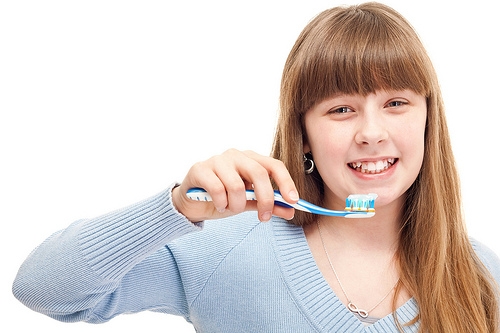
The American Dental Association and dentists everywhere, including our own Drs. Peter Vogel, Vijal Vadecha recommend that you schedule an appointment every six months for a cleaning and checkup. Despite this universal recommendation from the experts, some people believe regular cleanings and checkups are unnecessary unless there is something wrong with your teeth—for example, a cavity or a toothache. In fact, coming in for a six-month checkup and cleaning is one of the most important things you can do for your oral health, as well as your overall health.
Why It’s Important to Visit Regularly
Numerous studies have shown that oral health is closely tied to the overall health of your whole body. In fact, having a healthy mouth can help the rest of your body stay in balance. On the other hand, an unhealthy mouth can cause all kinds of problems for you down the road.
One of the most important things we do at Daisy Mountain Dentistry when you come in for cleanings is remove plaque that has collected on your teeth and around your gums. If left untreated, plaque build-up can cause inflammation and irritation around your gums, and lead to gum diseases like gingivitis and periodontal disease.
According to the American Academy of Periodontology, periodontal disease has been linked to increased risk for serious health conditions such as heart disease, stroke, diabetes, inflammation, osteoporosis, and pregnancy complications.
Most oral health issues will begin with subtle changes before progressing into more serious conditions. If you visit us for regular checkups, we may be able to identify common indicators that could lead to larger issues down the road. If we only see you at our office every few years, it becomes more difficult to catch these conditions before they grow into bigger and more painful problems.
What happens at a dental checkup?
When you come in for your regular checkup, there are several things our dentists and hygienists may do, including:
- Take X-rays to determine the overall health of your teeth, jaw, bones, and the tissue surrounding your teeth, including a check for early signs of tooth decay, abnormal growths, cavities, and other damage that is not immediately visible
- Perform a thorough cleaning of your mouth and teeth to remove any excess plaque and tartar, then polish and floss your teeth
- Check for signs of gum disease or evidence of tooth decay
- Examine your bite, and look for broken or damaged teeth
- Identify any changes to your gums or teeth since your last visit
- Examine your head and neck for signs of oral health problems
Waiting to visit Drs. Peter Vogel, Vijal Vadecha until you already have a problem, like a cavity, is like waiting to put gasoline in your car until after you run out and your vehicle is stalled on the side of the road. Once you have a problem, the ripple effect can cause you a lot of pain, take considerably more time, and cost a lot more money to fix than if you had come in for preventive care and cleanings every six months.
References: American Academy of Periodontology (2012). Gum Disease Links to Heart Disease and Stroke. Retrieved from http://www.perio.org/consumer/mbc.heart.htm
Brushing Mistakes You Don’t Know You’re Making
March 23rd, 2023

It’s great that you’re enthusiastic about your dental health! Here are some tips from Drs. Peter Vogel, Vijal Vadecha and our team to make sure you are getting the most out of your brushing by avoiding common mistakes.
Choose the right brush
In almost every case, a soft brush provides the right amount of bristle-strength to clean your teeth and gums effectively. Hard bristles can damage sensitive enamel and gum tissue, so treat yourself kindly. Also, choose a brush head that’s the right size for your mouth, since a toothbrush that’s too large can be uncomfortable and unable to reach all the areas you need to brush.
Don’t keep your brush too long
Three months is about the average life of a toothbrush. Over time, bristles become frayed or worn and lose their effectiveness. It’s also a good idea to replace your brush after an illness.
Be gentle
Even with a soft brush, it’s possible to brush so hard that your enamel and gums are affected. Think of yourself as massaging your teeth and gums rather than scrubbing them.
Use proper technique
Using a “sawing” back-and-forth motion is hard on your enamel and misses plaque and debris between the teeth. Hold your toothbrush at a 45-degree angle, especially at the gumline, to gently remove plaque. Use short strokes or a circular motion to clean as much of the surface and between the teeth as possible. Make sure you cover all the surfaces of your teeth: outside, inside, and chewing. And don’t forget your tongue!
Take your time
Brushing twice a day for two minutes each time is the standard. Most people brush much less; try using the stopwatch on your phone or a two-minute timer to make sure you are spending enough time brushing. On the other hand, if you brush too hard or too often, remember that over-brushing can lead to problems for your gums and enamel.
Your daily routine might be fast and furious, but your dental routine requires a gentle, methodical approach. Ask at your next visit to our Anthem office, and we will be happy to help you design the perfect brushing practices for your busy life.
How do I handle my child’s dental emergency?
March 23rd, 2023

Kids are active, and with lots of activity comes the potential for mishaps. Before an emergency occurs, you’d be smart to stay informed about the problems your child may encounter.
Here are a few things you should keep in mind about teething pain, loose baby teeth, and other common dental issues.
Teething Pain
Discomfort while teething is common for babies from the time they are four months until they are about two and a half. Teething can cause drooling, tender gums, and irritability. To help relieve your child’s discomfort, gently rub his or her gums with wet gauze or offer a cold teething ring.
Loose Baby Tooth
It is normal for a child’s first set of teeth to become loose and fall out. If a tooth is knocked out by a forceful blow, however, you should make an appointment with our office to determine whether any damage may have occurred. You should also book an appointment if the baby tooth that’s on its way out develops a crack but doesn’t fully fall out.
Issues with Permanent Teeth
Sometimes, permanent teeth can come in before the baby teeth have fallen out. In this event, schedule an appointment with us even if your child does not report discomfort or pain. Drs. Peter Vogel, Vijal Vadecha will need to determine if the permanent teeth are coming in correctly to avoid problems later on.
Bleeding Gums
Bleeding gums can have multiple causes: periodontal disease, rough brushing, or an injury to the gum tissue. If your child experiences heavy bleeding, it’s vital to call our office immediately. Wash the youngster’s mouth with warm salt water and put gentle pressure on the area to soothe it before your appointment.
Drs. Peter Vogel, Vijal Vadecha and our team are always here to address any concerns you may have regarding your child’s dental health. Contact our Anthem office for emergency services 24 hours a day, seven days a week.
Flossing Fact or Flossing Fiction?
March 16th, 2023
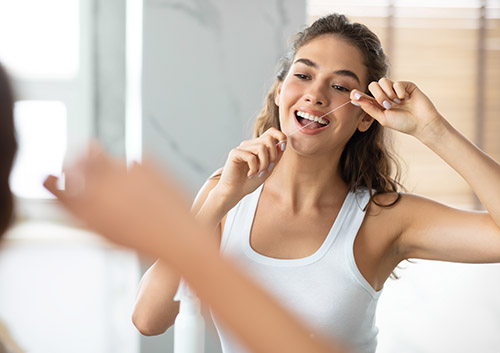
Somewhere in a bathroom drawer or medicine cabinet, we all have one—that little plastic dental floss dispenser. And whether you use your floss every day (yay!), or have completely forgotten it was in there (not so good), just how much do you know about that sturdy string? Let’s find out!
- Flossing has been around for hundreds of years.
FACT: It’s been just over two hundred years since Dr. Levi Spear Parmly, a dentist in New Orleans, suggested his patients use waxed silk thread to clean between their teeth. This is considered the first “official” invention of dental floss, although using some form of tool to get rid of food particles between the teeth has been around since prehistoric times.
- Brushing well is the same as flossing.
FICTION: It’s really not. While brushing does a great job of cleaning food particles, plaque, and bacteria from your enamel, there are some places those bristles can’t… quite… reach. Floss was designed to clean plaque and food from between the teeth and close to the gum line where your brush doesn’t fit.
- There’s more than one way to clean between your teeth.
FACT: Indeed there is! Not only are there many varieties of dental floss (waxed, flavored, round, flat, thick, thin, in a dispenser, attached to miniature floss wands), but you have alternatives if using any kind of floss is difficult for you. Water-flossers direct a pulsing stream of water between and around the teeth and gum line to remove food particles and plaque. Another useful alternative is the interproximal brush, a tiny little cone-shaped brush designed to remove food and plaque from those hard-to-reach spots.
- Flossing helps prevent gum disease.
FACT: Scientific studies haven’t provided definitive answers. But Drs. Peter Vogel, Vijal Vadecha and our team strongly recommend daily flossing as one of the most important things you can do to prevent gum disease. Gingivitis, or mild gum disease, is caused by irritated, inflamed gum tissue. Gum tissue becomes irritated and inflamed as a response to the bacteria, plaque, and tartar, which stick to your teeth. Anything you can do to help remove these irritants will reduce your risk of gum disease.
- Flossing helps prevent cavities.
FACT: We strongly recommend daily flossing to remove the food particles and plaque, which lead to cavities. Brushing removes cavity-causing plaque from the outer surfaces of your teeth. But there’s a lot of enamel between your teeth as well. Flossing removes plaque from these hidden spots, helping to prevent interproximal (“between the teeth”) cavities from forming.
- Bleeding when you floss is normal.
FICTION: Bleeding isn’t a typical reaction to flossing. Bleeding gums could be an early sign of gum disease caused by plaque and tartar buildup. On the other hand, if you floss too hard, or go too deeply below the gum line, you can make delicate gum tissue bleed. Ask Drs. Peter Vogel, Vijal Vadecha for tips on perfect flossing technique.
- You need to floss after every meal.
FICTION: Dental professionals generally recommend brushing twice a day and flossing at least once each day. But this suggestion comes with some exceptions. If you have braces, your orthodontist might recommend flossing after eating. And certainly, for removing pesky food particles, flossing or interdental picks are a sensible choice after any meal.
- Your dentist will never know that you haven’t been flossing.
FICTION: Nope. Sure, you can miss flossing a few times and catch up before your appointment at our Anthem office. But built-up plaque between the teeth, red, swollen, or bleeding gums, and gingivitis and interproximal cavities let both you and Drs. Peter Vogel, Vijal Vadecha know that you’ve been neglecting good dental habits.
- It’s never too late to start flossing!
FACT: Flossing is a simple, quick, and inexpensive way to maintain tooth and gum health. If you haven’t had much luck flossing in the past, ask Drs. Peter Vogel, Vijal Vadecha for flossing tools and techniques that will work for your specific needs. Start now, and see what a difference it will make at your next checkup!
If you had all these flossing facts at your fingertips, congratulations! But if you didn’t, no need to worry, because the real test of your knowledge is in its application. Flossing properly at least once each day will give you something far more rewarding than blog-quiz kudos—you’ll see that regular flossing rewarded with healthier teeth and gums!
Thumb Sucking
March 16th, 2023

Learning to suck their thumbs is one of the first physical skills babies acquire. In fact, ultrasound images have revealed babies sucking their thumbs in the womb! Babies have a natural sucking reflex, and this activity is a normal way for your baby to soothe herself.
If your toddler still turns to her thumb for comfort, no need to worry. Most children give up this habit as they grow, and generally stop completely between the ages of two and four. But what of the child who doesn’t? Should you encourage your child to stop? And when?
When Thumb Sucking Becomes a Problem
After your child turns five, and certainly when her permanent teeth start to arrive, aggressive thumb sucking is something to watch for. This type of vigorous sucking, which puts pressure on the teeth and gums, can lead to a number of problems.
- Open Bite
Our bites are considered normal when the upper teeth slightly overlap the lower where they touch in the front of the mouth. But with aggressive thumb sucking, teeth are pushed out of alignment. Sometimes this results in a condition called “open bite,” where the upper and lower teeth don’t make contact at all. An open bite almost always requires orthodontic treatment.
- Jaw Problems
Your child’s palate and jaw are still growing. Aggressive thumb sucking can actually change the shape of the palate and jaw, and even affect facial structure. Again, orthodontic treatment can help, but prevention is always the better option!
- Speech Difficulties
Prolonged thumb sucking has been suggested as a risk factor for speech disorders such as lisping, the inability to pronounce certain letters, or tongue thrusting.
The consequences from aggressive thumb sucking can be prevented with early intervention. What to do if you are worried?
Talk to Us
First, let us reassure you that most children stop thumb sucking on their own, and with no negative dental effects at all. But if your child is still aggressively sucking her thumb once her permanent teeth have started erupting, or if we see changes in her baby teeth, let’s talk about solutions during an appointment at our Anthem office. We can offer suggestions to help your child break the habit at home. There are also dental appliances available that can discourage thumb sucking if your child finds it especially hard to stop.
Work with your Child
- Be Positive
Positive reinforcement is always best. Praise her when she remembers not to suck her thumb. Make a chart with stickers to reward every thumb-free day. Pick out a favorite book to read or activity you can share.
- Identify Triggers
Children associate thumb sucking with comfort and security. If your child turns to her thumb when she’s anxious, try to discover what is bothering her and how to reassure her. If she automatically sucks her thumb when she is bored, find an activity that will engage her. If she’s hungry, offer a healthy snack.
- Talk about It!
Depending on her age, it might help your child to understand why stopping this habit is important. We are happy to explain, in a positive, age-appropriate way, just how breaking the thumb sucking habit will help her teeth and her smile.
Again, most children leave thumb sucking behind naturally and easily. But if what is a comfort for your child has become a concern for you, please give us a call. Drs. Peter Vogel, Vijal Vadecha will work with you and your child to prevent future orthodontic problems and begin her lifetime of beautiful smiles.
Oral Cancer
March 9th, 2023

Drs. Peter Vogel, Vijal Vadecha and our team want you to have the healthiest possible smile in the healthiest possible body. Oral cancer can affect the mouth, tongue, throat and jaw. Early detection is vital for the best possible outcome when treating this disease. That is why we check for symptoms of oral cancer at every dental examination.
What can you do to reduce the chance of oral cancer? Reduce your risk factors. You can help prevent oral cancer by adopting these healthy habits:
- Don’t smoke. Don’t chew tobacco. Don’t use a pipe. If you use any tobacco products, quit. Tobacco use is the single largest risk factor for head and neck cancers. Talk to us—we have suggestions for helping you break the habit.
- Drink alcohol in moderation. Heavy drinkers have a higher rate of oral cancer. More than one to two drinks per day can be considered heavy drinking, depending on factors such as weight, age, and even gender. Check with your doctor to find your personal definition of moderation.
- Eat a healthy diet. Cancer-fighting fruits and vegetables are a great addition to any menu.
- Protect yourself from the sun. Help prevent sun-related lip cancers by always wearing a UVA/UVB blocking sun screen or lip balm whenever you are working or playing outside—and reapply frequently.
- Some forms of the HPV virus have been linked to oral cancer, and those affected are generally younger and less likely to be smokers. Research indicates that the HPV vaccine, known for preventing several types of cancer, might also help prevent HPV-related oral cancers.
- Schedule regular dental exams. We are trained to recognize oral cancer and precancerous conditions that you might miss.
Of course, cancer can occur even with the healthiest habits. Do come see us if you detect any of these symptoms:
- A sore or ulcer that doesn’t heal, or persistent tenderness and pain in the mouth
- Lingering sore throat, hoarseness, or vocal changes
- Pain in the neck or ear that doesn’t go away
- A lump, a rough or thickened area, or eroded tissue in the skin lining the mouth
- Red or white patches in the lining of the mouth or on the tongue
- Difficulties chewing, swallowing, speaking, or moving the tongue or jaw
- Numbness in the tongue or mouth
- Changes in the way your natural teeth or your dentures fit together.
Not every symptom is caused by cancer, but it is important to rule out the possibility. We are trained to recognize early signs of oral cancer, and can recommend further tests if needed. Call our Anthem office immediately if you have any concerns. Early detection and treatment lead to the most successful outcomes.
Aging and Dental Health
March 9th, 2023

What’s life like for the average 60-year-old today? It’s complicated! We travel. Or we work out. Or we relax with friends. We pursue favorite hobbies or we develop new ones. We work, or start businesses, or volunteer for schools, museums, and charities. We practice the art of writing letters or we text our grandchildren. Whatever else we do, we do our best to stay healthy so we can live our lives to the fullest.
Part of living our lives to the fullest means caring for ourselves. And caring for ourselves means learning how to look out for the potential dental problems that might come with age, and how to keep ourselves in the best of dental health.
- Gum Disease
Gum disease, or periodontitis, is not uncommon in older patients. Certain medical conditions, such as diabetes, can leave you more vulnerable to gum disease. Because gum disease is often symptom free, it can remain unnoticed until the disease has progressed. Good oral hygiene and regular visits to the dentist are the best means of prevention—we are trained to discover gum disease in its earliest stages, and can treat it before the disease causes serious damage to gums, teeth and bone. But if you have delayed seeing a dentist, the good news is that there are many methods of treating gum disease available, including antibiotics, professional plaque removal, and periodontal surgery.
- Tooth Decay
As we age, our gums can recede from the teeth. The new root area that is exposed is more vulnerable to decay because it is not shielded by the hard enamel which protects the upper part, or crown, of the tooth. Maintaining your brushing and flossing routine is the best way to keep cavities from developing. If gum recession is severe, there are surgical methods we can discuss to restore gum health.
- Time
Cosmetically, teeth can yellow with age as the dentin beneath the enamel darkens and the enamel covering it thins. Years of coffee, wine, smoking and other stain-makers take their toll. If you are self-conscious about the appearance of your smile, talk to us about suggestions for whitening and brightening.
Medically, over time our teeth are subject to damage. Enamel and tooth surfaces can wear away, leaving our teeth more at risk for breaks or fractures that can lead to infection, which can result in the need for root canal work. Simple chewing puts an amazing amount of pressure on the teeth—and if you grind your teeth, there is even more stress placed on them. See us regularly for ways to maintain strong teeth, to repair damage if necessary, and to keep your gums and bones healthy if you are a denture wearer.
- Dry Mouth
Dry mouth can be a problem for older patients, often caused by medical conditions or medications. When we produce saliva, it helps remove sugar and the acids sugars produce which attack our enamel. Without normal saliva production, we are more vulnerable to cavities. Dry mouth can also lead to mouth ulcers, oral thrush, sores and infections. If you have been suffering from this condition, talk to us. Drs. Peter Vogel, Vijal Vadecha and our team have suggestions that will help.
- Oral Cancer
Oral cancer is something we look for during every check-up. And, if you ever notice any change that causes you concern, call us immediately. Early treatment of oral cancer and other oral diseases leads to the best possible outcome.
- Keep Up With Your Dental Care
The best way to keep our teeth and mouths healthy as we age is with prevention. Regular daily brushing and flossing and office visits twice a year for an examination and a professional cleaning are habits that should last a lifetime. Make sure to tell us about any medical conditions you may have and any medications you are taking, to avoid interactions and relieve unpleasant side effects.
What’s life like for the average older person today? There is no average older person! As we age, we are free to explore our interests in any number of creative and individual ways. But there is one goal we have in common: we all want to keep our smiles healthy and attractive. Call our Anthem office for preventative and restorative care. We want to help you work toward an ageless smile!
Why Do Molars Seem to Get More Cavities?
March 2nd, 2023

Probably because, for many kids, molars do get more cavities. So let’s answer two better questions: Why do molars get more cavities? And, how can we help prevent them?
It’s the Pits. (And Fissures.)
The reason molars are so useful—and more likely to develop cavities—is because of their shape. Unlike our front teeth, which are used to bite through foods, molars are used to grind and chew. That’s why they are so much larger, with a flat surface on top. Well, not exactly flat.
When you look at a molar, you’ll notice that the top isn’t really smooth at all. It’s covered with little indentations known as pits and longer grooves called fissures. These irregular features both trap food particles and make it more difficult for bristles to clean them away. Cavities in molar surfaces are so common that they even have a specific name: “pit and fissure cavities.”
But molar biology does not mean tooth decay is inevitable! There are steps you can take to protect your children’s molars as they grow, while you’re providing them with dental strategies that will keep their adult molars healthy and cavity-free.
Preventing Pit and Fissure Cavities
- Don’t Just Brush—Brush Effectively
The first step in preventing any kind of cavity is brushing properly. Your child should be brushing at least two minutes, at least twice each day. And while the time we spend brushing is important, technique is also key.
When you’re showing your child how to brush, be sure that the tops of molars, upper and lower, get brushed thoroughly, with special emphasis on cleaning pits and fissures. Make sure the toothbrush is small enough to fit your child’s mouth comfortably and reach all the tooth surfaces. Replace worn-down brushes or electric toothbrush heads after three to four months when they no longer clean as effectively.
Your child will probably need adult supervision from toddler years through the early years of grade school to learn how to brush properly. This is time well spent, as your child learns cavity-preventing brushing techniques which will last a lifetime.
- Eat a Tooth-Healthy Diet
Plaque bacteria use the sugars in our food to make acids. These acids break down the mineral strength of tooth enamel and eventually lead to cavities. And because pits and fissures are great hiding places for bacteria and food particles (especially sticky ones), molars are even more at risk for cavities. Limiting sugary, sticky foods like sweet treats and simple carbs helps reduce that risk.
Acidic foods like flavored juices, sour candies, sodas, and power drinks also weaken enamel and can leave teeth more vulnerable to decay. Help your child avoid cavities by limiting acidic foods and drinks, making them part of a balanced meal, and/or rinsing with water after eating.
- Use Fluoride Toothpaste
Fluoride toothpaste not only reduces the risk of cavities, it also helps strengthen enamel that has been weakened by bacterial and dietary acids. Win-win!
- Ask About Sealants
Sealants are invisible, safe coatings which protect molars by preventing food and bacteria from getting trapped in their uneven surfaces. The top of the molar is first treated with an etching solution to allow the sealant to bond tightly to the tooth, a thin coat of sealant is painted on, and then it’s hardened under a curing light. That’s all there is to it.
Sealants are often recommended when children’s permanent molars first erupt, when they are especially at risk for cavities. Sealants can last from three to five years (or even longer), and studies have shown a dramatic reduction in cavities for patients who use sealants compared to patients with untreated teeth. Depending on your child’s individual needs, Drs. Peter Vogel, Vijal Vadecha might recommend a sealant for baby molars as well.
- Regular Exams and Cleanings
It might be hard for you to tell if your child’s molars have been affected by sticky plaque, or sugary foods, or acidic drinks, or inadequate brushing, or any other potential cavity-causers. It’s not a difficult job for Drs. Peter Vogel, Vijal Vadecha, though! Through regular checkups and cleanings at our Anthem office, we will discover any conditions that might lead to cavities, and, if necessary, treat small cavities before they lead to more serious decay.
Statistically, childhood molars have a greater chance of developing cavities than incisors and canines. Help your child beat the odds by understanding why these teeth are at risk and by working with your dental team to give your child years of healthy teeth now and a future filled with beautiful smiles!
Pros and Cons of Veneers
March 2nd, 2023

You might have a small chip in a tooth from an unfortunate encounter with peanut brittle, or even several chips from a touch football game that got a little out of hand. Perhaps you have a gap in your teeth that you’ve always wanted to address. Or it could be that you are not happy with the shape or color of your teeth, and are looking for a straighter, brighter smile. In all these cases, veneers may the perfect solution for you.
Veneers are one of the most dramatic ways to improve your smile:
- Realistic Appearance: A dental veneer is a thin shell of porcelain that is bonded to your tooth. Because they are semi-translucent, much like actual enamel, veneers look like natural teeth.
- Rapid Transformation: Normally, the application of veneers requires only a few visits. Your tooth will be shaped to accommodate the veneer for a smooth, flat appearance. A mold will be made to ensure an exact fit. On a subsequent visit, the new veneer will be bonded to the tooth permanently.
- Whiteness that Lasts: Veneers are stain-resistant, so if you are looking for a long-lasting bright smile, they are a good option. (If you are getting only a few veneers, it is a good idea to have your natural teeth whitened to the shade you desire before the veneer color is selected. Veneer color is permanent.)
There are also some aspects to consider before going ahead with the procedure:
- Be Sure About Your Decision: Veneers are a permanent choice. Some enamel might need to be removed for the veneer to fit and the surface of your tooth will be treated to allow the veneer to bond to it properly.
- Check Your Overall Dental Health: You should have a check-up before starting the process to make sure your teeth and gums are healthy enough for veneers. If you have severe orthodontic issues, grind your teeth, or have a habit of clenching your jaw, your veneers will be put under pressure they were not designed to take. We can let you know if you are a good candidate for this procedure.
- Expense: Veneers are more expensive than some other options, such as whitening and bonding, but can offer more benefits. Veneers will cover staining that whitening cannot eliminate. Their translucent quality makes them look more realistic than bonding, and they are also far more stain resistant. The cost of a crown might be comparable, and a crown is recommended if there is significant damage to the underlying tooth. If you are looking for cosmetic improvement only, veneers leave more of the tooth intact.
- Longevity: Veneers do not last forever, and will need to be replaced eventually. However, they can have a life expectancy of ten to 15 years, and we can give you tips to keep your veneers looking and lasting their best.
If you decide veneers are right for you, give our Anthem office a call. We will be happy to discuss the procedure with you and help you discover the best possible path to your best possible smile.
Brushing Tips for Kids
February 23rd, 2023

You’re all set for your happy morning and nighttime ritual. You’ve provided your son with his favorite action hero toothbrush and your daughter with her favorite flavored toothpaste. You’ve gotten them into the healthy habit of two minutes of brushing twice each day. You’ve introduced them to flossing. You have favorite brushing songs! Stickers! Gold stars! And, best of all, you’re teaching great brushing techniques.
Kids need the same basic brushing tools and skills as adults. What makes for the best cleaning?
Find the right brush
No matter how cute—or heroic—the brush, it needs to have soft bristles to protect enamel and delicate gum tissue. The head should be a perfect fit for your child’s mouth. And if the handle is easy to grip and hold, you have a winner.
Find the right toothpaste
The bubblegum flavor might appeal to your child, but it’s the fluoride that helps to prevent cavities. Talk to us about the right time to start using fluoride toothpaste and the right amount for your child’s brush.
Teach your child the angles
If your child is too young to brush alone, start geometry lessons early. Holding the brush at a 45-degree angle toward the gums will clean bacteria and plaque from the tooth surface and the gum line. And don’t forget the chewing surfaces and the insides of the teeth. When your child begins brushing on her own, coach her as she learns the best way to clean all the surfaces of her teeth.
Easy does it
Teeth and gums should be massaged, not scrubbed. Brushing too hard can damage not only tender gum tissue, but even your child’s enamel.
Learn to let go
No matter how comfortable and appealing the brush, after three or four months, it’s time for a change. Frayed bristles don’t clean as effectively, and making up for it by brushing harder isn’t the answer (see above). Also, toothbrushes can build up quite a collection of bacteria over time (see below), so a fresh brush is a must!
Everything in its place
A toothbrush should dry thoroughly between uses without touching other brushes. Placing a brush in a plastic container doesn’t let it dry and encourages bacterial growth. And a toothbrush needs its own space—touching toothbrush heads means sharing toothbrush bacteria. The best way to keep toothbrushes as dry and as germ-free as possible is to store them upright, without touching other brushes, in a clean, well-ventilated area.
Rinse and repeat
Your child should rinse his toothbrush before and after using it, and be sure to rinse his mouth as well. That should get rid of any leftover food particles brushing has removed.
Finally, keep up the good work! As you teach your child proper brushing techniques, and make sure she uses them as she grows, you are preparing her for a lifetime of great checkups with Drs. Peter Vogel, Vijal Vadecha at our Anthem office. Give yourself a gold star—you’ve earned it!
How do I clean my baby’s teeth?
February 23rd, 2023

Creating good dental hygiene habits early in your child’s life is essential to the health of his or her teeth, even when your infant doesn’t have any. By starting now, you can set the foundation for your son or daughter’s oral health later on in life.
When do I start?
The best time to begin brushing your baby’s teeth is before that first tooth ever comes in. Wipe your little one’s gums gently with a soft washcloth soaked in warm water every day. Not only will this help to get rid of bacteria in the mouth, but it will also familiarize your child with a daily brushing routine.
What do I use?
When your child’s teeth begin to emerge, it’s time to switch to a baby toothbrush. Select one with a big grip for your hand and a small head that’s easy to maneuver in your baby’s mouth.
Your little one won’t need toothpaste until he or she is about a year old; and even then, only a small amount is necessary. Apply an amount the size of a grain of rice and move to a pea-sized amount when your infant is about two years old.
By around six years, your child will probably rinse and spit without your help. At this time, you may introduce a child-friendly fluoride mouthwash.
How do I do it?
Until about age five or six, it’s likely your child will still need your help with brushing teeth. Gently scrub over all the teeth and gums, even where teeth have yet to come in. It may be helpful to explain what you are doing and how you are doing it, so your toddler can learn to brush her or his teeth alone.
Paired with regular visits with Drs. Peter Vogel, Vijal Vadecha at our Anthem office, proper hygiene habits instilled in your child early on will set up a good foundation for a healthy mouth in the future.
The Link Between Dental Hygiene and Your Overall Health
February 16th, 2023

When patients of Daisy Mountain Dentistry hear any mention of oral or dental hygiene, they probably think of brushing and flossing their teeth. Although these are extremely important, the term dental hygiene encompasses much more than that. Your mouth’s health, including your teeth, has an important impact on your overall physical health. The National Institute of Dental and Craniofacial Research published the surgeon general's first ever report on dental health. It is called A National Call to Action to Promote Oral Health. In that report, the Surgeon General states that the 1948 World Health Organization expanded its earlier definition of health to "a complete state of physical, mental, and social well-being, and not just the absence of infirmity."
The Importance of Oral Health to Total Overall Health
One of the most important themes that the dental health report stressed is that you cannot be healthy without oral health. It went on to explain that oral health and general health are inextricably linked, and therefore can't be seen as two separate things. Because oral health is so critical to overall health, it should be included in all community health programs. For individuals, this means that it is just as important to take care of your mouth, your teeth, and your overall oral health as it is to take care of the rest of your body. The two most prevalent dental diseases are caries (cavities), also known as tooth decay, and periodontal (gum) disease.
Ways that Oral Health Impacts Overall Health
One important way in which good oral health contributes to better overall health is seen in the findings of several studies in which the blood sugar levels of diabetic patients were significantly lowered when their periodontal (or gum disease) was successfully treated. Your mouth has roughly 500 different species of bacteria. Many are harmless, and some are even good bacteria that help maintain the balance of your intestinal flora. Harmful bacteria can infect your gums, causing gingivitis. Your body's immune system may try to fight off the alien invaders, but they attack your gums, causing inflammation and bleeding when you brush.
Now that you know how important good dental hygiene is, be sure to see to get your teeth cleaned every six months, have regular dental checkups, brush and floss your teeth at least twice daily, and replace your toothbrush at least every couple of months. Call us to schedule your next appointment at our convenient Anthem location.
I haven’t been to the dentist in years; what should I expect?
February 16th, 2023
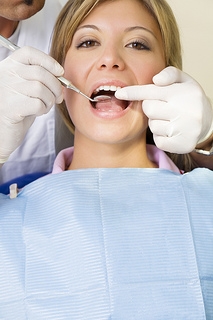
Time flies when we are not at the dentist! Before you know it, years may have gone by. Let’s take a moment to explain what takes place when a patient comes back to receive care after an extended period of time.
After a while, small dental concerns or issues can grow into an unexpected journey of discovery and expense. Anxiety is common and expected. Let’s discover first of all, “What brings you here today?” It is a good place to start and once the initial concerns are addressed, a comprehensive plan to restore optimum dental health can be arranged. During the first appointment Drs. Peter Vogel, Vijal Vadecha and our team want you to feel comfortable, and establish a confidence allowing you to be open with any questions.
Your visit will take approximately 90 minutes. First, a complete medical and dental history will be recorded and reviewed in one-on-one interview style. This is the time to voice any concern, anxiety issues, worries, etc. Then, X-rays are taken to provide additional information about what is happening beneath the surface of your teeth and gums. Finally, a series of screenings including those for oral cancer, home care evaluation, and periodontal disease are conducted to complete your oral health evaluation.
The hygienist has a great eye for other conditions such as broken fillings, cracked teeth, active decay, and other dental concerns. Then, Drs. Peter Vogel, Vijal Vadecha will come in for a comprehensive exam and list and prioritize your dental needs. Our treatment coordinator will present scheduling options, insurance coverage, and payment plans.
Our team will coach you and help you gain control of your own dental destiny with good home care habits. You will receive a bag with a toothbrush, floss, appropriate toothpaste, and any other specialized tools for your needs. You will know how often you need to return for hygiene visits or other dental appointments.
Our patients at Daisy Mountain Dentistry are our most important asset, and we strive to create a comfortable experience, no matter how long it has been since your last visit at our Anthem office. From phone conversations to financial arrangements to clinical treatment, we want you to feel confident that our team will meet your needs.
Choose Chocolate on Valentine's Day
February 9th, 2023

From a student handing out sweets for her classmates to an older married couple exchanging boxes of candy, Valentine’s Day is the time of year when people like to show affection by gifting sugary treats to their loved ones. Whether you’re on the giving or receiving end of Valentine’s Day candy, you can celebrate the holiday in a healthier way by making dark chocolate your confection of choice.
Contribute to Your Health
According to the Cleveland Clinic, studies have shown that the cocoa beans used to make chocolate contain flavonoids, which can help protect the body against damage from various toxins. Flavonoids may also help lower blood pressure and improve blood flow to the heart and the brain. Dark chocolates typically contain a higher amount of flavonoids than other types, making them a great choice for chocolate lovers. However, you should keep in mind that many companies produce chocolate that is so heavily processed that the flavonoids are largely eliminated. Your best bet is to look for high-quality dark chocolates and cocoa powders that have undergone minimal processing.
Protect Against Cavities
If you think there’s no way candy could ever be beneficial for your teeth, think again. The Texas A&M Health Science Center has reported that the tannins present in cocoa beans may actually help prevent cavities by interfering with bacteria’s harmful interaction with teeth. Just like with flavonoids, tannins have been found to be present more often in dark chocolates, rather than milk chocolates, giving you another great reason to choose the richer, sweet varieties.
Avoid a Sticky Situation
One more benefit of choosing chocolate over other candies is that it is less likely to get stuck in the crevices and spaces between teeth. Gooey sweets like taffy can stay lodged in the mouth for longer periods of time, putting you at a greater risk for developing cavities. When you choose your chocolate, be sure to avoid types that also contain sticky ingredients like caramel or marshmallow, and instead opt for the plain varieties.
Remember that the health benefits you can receive from dark chocolate are largely based on eating the candy in moderation. With that being said, it’s easy to make this delicious and health conscious switch when you’re out shopping for your sweetheart, friends, loved ones, and yourself. Have fun satisfying your sweet tooth this year and Happy Valentine’s Day from all of us at Daisy Mountain Dentistry!
The Start of Valentine’s Day
February 9th, 2023

Valentine’s Day, also known as Saint Valentine’s Day, has been said to originate with a Catholic priest named Valentine several thousand year ago. Valentine defied the emperor at the time by secretly marrying men and their brides after the emperor had made it illegal to marry. Emperor Claudius II did this because he wanted as many single young men to fight in his war as he could get.
Valentine disobeyed the emperor’s edict by continuing to marry couples until he was sentenced to death. Before his execution, he sent a letter to a secret love and signed it “From your Valentine.” Drs. Peter Vogel, Vijal Vadecha and our team have come up with some suggestions on how you can celebrate this Valentine’s Day, whether you have a valentine of your own or not.
Valentine's Day Ideas
- Enjoy a tasty treat. There are plenty of options when it comes to cooking and/or baking on Valentine’s Day. Make your significant other his or her favorite meal or sweet treat, or make your own favorite dish to enjoy on this day. Oh, and be sure to make enough for leftovers!
- Make a personalized card. Instead of buying a card from the grocery store, take the time to make your own for a loved one. People love handwritten notes, especially when it’s from someone special. If you’re single this Valentine’s Day, make a card for fellow single friend to brighten the day and remind the person that he or she is also loved.
- Watch a movie. We all know there are plenty of romance movies out there. Put on your favorite romantic comedy, or pick up your significant other’s favorite movie to watch together. Even better, if you’re single, pick up your own favorite movies to watch to pass the time this Valentine’s Day.
- Do nothing! We all know Valentine’s Day can sometimes get a lot of hype. If you’re worried about not making a reservation in time, don’t feel like planning an extravagant night out, or simply not in the holiday mood this year, spend your day sitting back and relaxing.
Valentine’s Day is a time to celebrate love and spend quality hours with the people you care about the most. Whether you’re in a relationship or single, take some time today to appreciate those you love in your life.
We wish you a happy Valentine’s Day celebration and look forward to seeing you at our Anthem office during your next appointment.
Natural Ways to Soothe a Toothache
January 26th, 2023

Toothaches can come in many different forms, but no matter which, they’re always uncomfortable. Drs. Peter Vogel, Vijal Vadecha and our team want you to know there are simple ways to cure this common problem.
Toothaches can be caused by infections, gum diseases, teeth grinding, trauma, or having an abnormal bite. Several symptoms may become noticeable when you start to experience a toothache. You might develop a fever, have trouble swallowing, notice an unpleasant discharge, and most often feel lasting pain when you bite down.
If you begin to notice any of these symptoms, try to manage the pain with the simple remedies below. If the pain continues, contact our Anthem office and schedule an appointment, because a bigger issue might be involved.
- First, try rinsing your mouth out with warm salt water. This helps to disinfect your mouth and may soothe the region where the toothache is occurring. Hydrogen peroxide can also help if you swish it around in your mouth.
- Applying a cold compress or ice pack to your jaw in area that hurts can help with swelling.
- Make sure to floss your entire mouth thoroughly. The problem could be caused by food debris stuck between your teeth.
- Certain essential oils possess pain-relieving qualities, including clove, nutmeg, eucalyptus, or peppermint oil. Use a cotton swab and dilute one of these oils, then apply it to the problem tooth and/or gum area. Repeat the process as needed. This can also be done with apple cider vinegar.
- Similar to essential oils, peppermint tea can soothe and slightly numb the area. Swish it around in your mouth once it has cooled off for temporary relief.
- You may also soothe a toothache by eating Greek yogurt. You might be surprised to know that yogurt contains healthy bacteria that can help fight against pain.
- Crushed garlic can be rubbed on the aching area to help relieve pain. Garlic contains allicin, which slows bacterial activity. The application may burn at first but it has been known to help treat inflammation.
When it comes to preventing toothaches, you can take various measures. Always make sure you brush and floss every day, though. If you schedule regular oral examinations by Drs. Peter Vogel, Vijal Vadecha, you will decrease infections that may cause toothache from spreading.
If you’ve tried the methods listed above and your toothache hasn’t gone away, call our Anthem office and we can schedule an appointment to figure out the cause of the problem and provide a solution.
Keep It Cheesy for a Long-Lasting Smile
January 26th, 2023

You’ve heard people tell you to say “cheese” when you’re having your picture taken, probably more times than you can count. There is another reason you should be saying “cheese” … or “YES” to eating cheese.
Although Drs. Peter Vogel, Vijal Vadecha and our staff routinely encourage our patients to brush their teeth after eating, the one time you don’t want to do that, at least not immediately, is after eating cheese.
Study Finds Important Benefit From Eating Cheese
CBS News reported on the results of a study that was published in the May/June 2013 issue of General Dentistry, a publication of the Academy of General Dentistry. The study showed that cheese increases dental plaque pH, but in this case, the plaque increase isn’t a bad thing. When you eat cheese, you increase the pH of the plaque on your teeth, and create a protective coating that may lower your risk of getting dental caries -- more commonly known as cavities.
An analysis of the story from the General Dentistry journal, including the details of the study and its participants, was published in Science Daily. The study looked at 68 children between the ages of 12 and 15. A similar study was conducted by British researchers who reported their findings in the British Dental Journal in 1999.
How the Study Worked
For the 2013 study, researchers divided kids into three groups. Participants in group one ate cheddar cheese. Participants in group two drank milk, while participants in group three ate sugar-free yogurt. All participants were told to eat or drink their assigned foods for three minutes, after which they swished water in their mouths.
Researchers tested every participant’s mouth at ten, 20, and 30-minute intervals. They found no changes in the mouths of participants in the milk drinking and sugar-free yogurt eating groups, but every time they tested the pH levels in the mouths of the ones who had eaten cheese, researchers saw the levels quickly increased.
They concluded that cheese has anti-cavity properties. That isn’t the only benefit, however. Another study, in which related findings were reported, appeared in the Journal of Contemporary Dental Practice in the summer of 2000. In that study, researchers found that cheese may give teeth a protective coating that helps lessen enamel erosion caused by acidic foods, particularly from sugar-sweetened soft drinks.
So don’t just say cheese for pictures. If you want to have a happy, healthy and long-lasting smile, go for cheese. It’s good for your bones, too!
Wiggle Room
January 19th, 2023

When you’re pregnant, you expect physical changes. That’s part of the excitement of the journey! What isn’t expected—and not nearly as exciting—is when your familiar smile seems to be changing as well.
If you’ve noticed that your teeth feel loose, or that your regular tooth alignment has shifted, you might be experiencing one of the unexpected, but quite common, side effects of pregnancy—tooth mobility.
How is this “wiggle room” possible? After all, you’re making sure that you’re eating a diet rich in protein, vitamins, and minerals, including calcium, vitamin D, and all the other nutrients which keep teeth and gums healthy. You’re brushing and flossing regularly to prevent cavities and gum disease. You haven’t changed your healthy dental habits, so why are you seeing different results?
The answer lies in the hormonal changes which occur with pregnancy. Your body has significantly increased production of hormones such as estrogen, progesterone, and relaxin. One of the benefits of these higher hormonal levels is their relaxing effect on your ligaments and joints. Relaxed ligaments and joints help make pregnancy and childbirth easier.
But you can’t target hormones just where they’ll be most useful. An increase in hormones affects the ligaments and joints throughout your body. And while this explanation might seem unrelated to loose teeth, it is, in fact, the “root” of the matter.
A complex support system holds our teeth securely in their sockets. Instead of being rigidly fused to the jaw, each tooth root is surrounded by a periodontal ligament within the socket. This ligament is largely made of flexible connective tissue, and attaches to both the root of the tooth and the bone tissue of the jaw, holding the tooth in place. Its flexibility helps cushion your tooth from pressure and impact, and allows the tooth movement which makes orthodontic work possible.
The hormones which relax ligaments and joints throughout the body have that same relaxing effect on the flexible ligaments and joints in the mouth. So it’s not uncommon to find that your teeth feel a bit looser, or that your customary tooth alignment has shifted, or that you’re experiencing discomfort in your jaw joint, especially if you grind or clench your teeth.
Fortunately, while loose teeth are alarming, it’s most often only a temporary condition. Your teeth and ligaments should return to their normal, stable status after your baby is born. But because dental health can impact on your pregnancy, see us if you notice any changes in your smile. We want to rule out any other causes of tooth mobility, including gum disease, tooth abscesses, or other serious conditions.
Other proactive prenatal tips to keep your smile its healthiest?
- Call us when you learn about your pregnancy. We can offer suggestions for caring for yourself and your dental health during this exciting time.
- Keep up with your dental hygiene. Brushing and flossing are more important than ever to keep your gums healthy.
- And, because your gums might be more prone to gingivitis now, extra cleanings as needed can keep plaque buildup from forming.
- Don’t forget your regular appointments at our Anthem dental office for exams and cleanings. We want to help prevent any small problems from becoming larger ones.
Pregnancy is a time of many physical changes. Drs. Peter Vogel, Vijal Vadecha will work with you to ensure that one thing which remains constant is your beautiful, healthy smile!
Building Blocks for a Healthy Grown-Up Smile
January 19th, 2023

Even before a baby is born, those tiny baby teeth are already forming. Expectant mothers can help ensure that their children’s baby teeth will be strong and healthy by getting the recommended amounts of proteins, vitamins, and minerals in their prenatal diets.
But a mother can’t “eat for two” to make sure her child’s adult teeth are healthy—children’s permanent teeth begin real growth and development only after birth. What can we do to encourage strong permanent teeth as our children grow and develop? Here are four important building blocks parents can use to lay a healthy foundation for their children’s grown-up smiles.
Serve a Tooth-Healthy Diet
The same vitamins and minerals that help create baby teeth are essential for creating healthy adult teeth. Tooth enamel, the hardest substance in the body, is almost completely made up of calcium phosphate minerals. A diet which provides the recommended amounts of calcium and phosphorus helps your child’s body grow strong enamel. And don’t forget vitamin D, which our bodies need to absorb calcium and phosphorus.
A tooth-healthy diet should include several servings of foods which provide calcium, such as dairy products (milk, yogurt, cheese), dark leafy vegetables, and fortified juices, cereals and tofu. Phosphorus can be found in proteins like meat, fish, and poultry, as well as beans, nuts, dairy, and whole grains. Egg yolks and fatty fish are natural sources of vitamin D, and it’s easily available in fortified foods such as cow’s milk, soy milk, cereals, and orange juice.
Use the Right Amount of Fluoride
Fluoride is called “Nature’s cavity fighter” for a reason. Fluoride reduces the risk of cavities and helps strengthen tooth enamel. Drs. Peter Vogel, Vijal Vadecha can offer invaluable advice on when to start and how to use fluoride toothpaste to protect your child’s baby teeth and developing adult teeth.
Can there be too much of this good thing? While fluoride is a safe and effective way to protect teeth in normal, recommended amounts, too much fluoride can lead to fluorosis. This condition can cause cosmetic changes in the enamel of permanent teeth, from almost invisible lighter spots to darker spots and streaking.
How to make sure your child gets the right amount of fluoride?
For children under the age of three, use a dab of toothpaste no larger than a grain of rice. Ask Drs. Peter Vogel, Vijal Vadecha if fluoride toothpaste is recommended.
Young children can’t always understand the idea of spitting and rinsing after brushing, so children between the ages of three and six should use only a pea-sized dab of fluoride toothpaste, and need you there to make sure they spit and rinse afterward.
Ask us about local water fluoride levels if you have any concerns about using tap water for drinking or for mixing formula, keep fluoride toothpastes and other products out of the reach of children, monitor your children while they brush, and always check with us before giving your child a fluoride rinse or supplement.
Help Your Child Retire Harmful Thumb Sucking and Pacifier Habits
Your child might self-comfort with the help of a pacifier or thumb sucking, which can be a valuable soothing habit. But it’s important to talk to Drs. Peter Vogel, Vijal Vadecha to see just how long this soothing habit should last. Around the age of four, aggressive thumb or pacifier sucking can lead to problems for permanent teeth.
Vigorous sucking can cause protruding upper front teeth. Aggressive sucking can lead to changes in the shape of your child’s palate and jaw. Open bite malocclusions, where the upper and lower teeth are unable to meet, and overbites, where the upper teeth overlap the lower teeth more than they should, can also be the result of lengthy and forceful thumb sucking.
Take Care of Baby Teeth
Baby teeth are important! They bite and chew food, and they work with the tongue to help your child learn to pronounce words properly. And there’s one more important reason to make sure primary teeth stay healthy: they serve as the place holders which guide permanent teeth into their proper spots.
When a baby tooth is lost too early, due to decay or injury, the teeth on either side can drift into the empty space, preventing a permanent tooth from erupting where it needs to. Any misalignment or crowding which results may require orthodontic treatment in the future.
Call our Anthem office if your child unexpectedly loses a baby tooth. There may be no cause for concern, or, if there’s a potential problem, an appliance called a “space maintainer,” which keeps the baby teeth from shifting out of place, can be fabricated especially for your child.
Your child’s adult teeth are being formed now. Work with us to make sure the building blocks of present and future dental health are in place. You’re giving your child the foundation for a lifetime of beautiful, grown-up smiles!
Good Dental Hygiene Gives You Better Overall Health
January 12th, 2023

What do you think of when you hear the term dental or oral hygiene? Brushing and flossing tend to come to mind, since that is what the terms imply.
What you might not know, however, is that good dental hygiene involves much more than just your mouth. That’s the tip of the iceberg … just a piece of the complex puzzle that is the human body.
Simply put, you cannot be fully healthy if you don’t have good oral health. Studies have shown that oral health and body health are closely linked and in fact almost impossible to define as separate phenomena.
Take gum disease, for example. It’s one of the most common dental infections, but it doesn’t just affect your gums. According to the Academy of General Dentistry, gum disease can be directly linked to more serious complications such as strokes and heart disease. Doesn’t that make you want to floss a little more often?
This goes the other way, too. Many oral events like sores, swollen gums, and dry mouth syndrome, which might seem fairly trivial and even harmless, may be signals of a much bigger problem: possibly leukemia, kidney disease, diabetes, or pancreatic cancer.
Now that you’ve been made aware of just how vital dental health is for your overall health (and vice versa), the best thing to do is what you’re probably already doing: making sure you brush and floss, as well as maintain a well-balanced diet. It’s also smart to keep away from cigarettes and tobacco, because both are known to contribute to periodontal disease.
In addition, be sure to keep getting your teeth cleaned every six months! If you’re due for a cleaning, give our Anthem office a call to schedule an appointment at Daisy Mountain Dentistry.
Healthy Diet, Healthier Gums?
January 5th, 2023

Since gum disease is one of the most common adult diseases, it’s no wonder Drs. Peter Vogel, Vijal Vadecha and our team stress the importance of prevention. Effective brushing and flossing, regular dental appointments for exams and cleanings, and a prompt visit to our Anthem dental office if you notice symptoms of gingivitis (early gum disease) are all important steps to prevent more serious periodontal disease from developing.
One more step you can add to keep your gums their healthiest? Add some gum-healthy foods to your shopping cart! To see how your diet can help prevent gum disease, let’s look at what can cause gum disease.
When plaque builds up between teeth and gums, the bacteria found in plaque cause our gum tissue to become inflamed, swollen, and painful. Left untreated, the gums pull away from the teeth, leaving pockets where bacteria collect and can cause infection.
Prolonged inflammation can lead to the destruction of gum tissue and the connective tissues which anchor our teeth to the alveolar bone in the jaw. Bone loss and even tooth loss can result from untreated gum disease.
Fortunately for us, there are foods that fight inflammation, help with healing, and strengthen and support gum tissue before problems develop. Let’s take a look at some of the valuable gum-healthy nutrients you can add to your diet with some tasty additions to your shopping list:
- Vitamin A
This vitamin is essential for the health and healing of mucous membranes, including both our gums and the soft membranes in our mouths. Vitamin A is found in animal products such as dairy foods, meat, and liver, or formed in the body from beta-carotenes, found in plant foods such as carrots, peppers, pumpkin, squash, and sweet potatoes.
- Vitamin C
Vitamin C is one of the so-called “essential nutrients.” These are nutrients that are necessary for our bodies to function properly, and which can only be supplied in our diets. Vitamin C is needed to help our bodies produce collagen, the substance that provides support and structure to our tissues. It also helps us repair tissue, and is a powerful antioxidant. One of the obvious signs that your diet doesn’t contain enough vitamin C is inflamed and bleeding gums.
When we think vitamin C, we instantly picture citrus fruits. Oranges, lemons, limes, grapefruit, and all their cousins are a wonderful source of vitamin C. Looking for a little more variety? You’re in luck! Fruit fans can load up on strawberries, kiwi fruit, mangos, and papayas. Love your veggies? Red peppers, kale, cauliflower, Brussels sprouts, and broccoli contain more vitamin C per serving than a medium orange.
- Vitamin D
Vitamin D, of course, is essential for dental health because it helps us absorb the calcium that keep teeth (and bones) strong. And there’s more! It helps the body fight infection and reduce inflammation, and studies have suggested a link between vitamin D and better gum health.
Sunlight exposure leads our bodies to produce vitamin D naturally, but it is available in foods as well. Fatty fish, such as salmon, tuna, and herring, are a rich source of the vitamin, as are cod liver oil and egg yolks. It’s also available in foods fortified with vitamin D, such as cow’s milk, soy milk, orange juice, and even many cereals. And while you’re getting the benefit of vitamin D from dairy, you’re also enjoying the proteins they contain, one of which helps neutralize acids in the mouth that can irritate gums. Bonus!
- Iron
Iron deficiency can lead to a common form of anemia, where your body isn’t creating enough red blood cells to deliver the oxygen your tissues need. (In fact, one of the most noticeable symptoms of anemia is pale gums.) This condition can cause a number of problems, including an immune system that doesn’t work as well as it should. A strong immune system helps us fight infection, including gum disease and other oral infections.
A diet rich in iron can help prevent anemia. We absorb the most iron from foods such as meat, eggs, and fish, but iron is also present in beans, lentils, leafy greens, whole grains, nuts, and prunes if you’re looking for flavorful vegetarian options.
- Omega-3s
Research has shown a possible relationship between getting the recommended dietary amounts of omega-3s and a lower occurrence of periodontitis. In other studies, omega-3s have shown promise in reducing the periodontal inflammation that can lead to severe gum disease.
Our bodies can’t produce omega-3 fatty acids on their own, but fatty fish such as salmon, tuna, herring, and sardines, a variety of high-fat seeds and nuts, and plant oils contain several different types of omega-3 fatty acids. Some foods are fortified with omega-3s, or your doctor might recommend fish oil (and algae oil for vegetarians) as a supplement.
Speaking of supplements, why not just add vitamin, mineral, and other nutritional supplements to our daily diet? Believe it or not, there can actually be too much of a good thing. Body chemistry requires balance, so talk to your doctor about whether or not supplements are necessary in your particular diet, and just what kinds and how much to take.
Whew! That’s a lot to think about for one shopping cart, but that’s just a small portion of the many foods—and the many vitamins and minerals—you can add to your menu to support oral health in a tasty, effective, and positive way.
After all, when we think about the “do’s and don’ts” of a dental-healthy diet, it’s all too often a collection of “don’ts.” Don’t eat a lot of sugar. Avoid acidic foods and beverages. Cut down on refined carbs. And all of those suggestions are important, because the early stages of gingivitis are often easy to miss.
But let’s not forget the things we can actually do to be proactive with our gum health. Besides good dental hygiene and regular checkups at our Anthem office, eating a well-balanced diet helps keep your gums their healthiest—and while we can do a lot to treat gum disease, the very best treatment of all is prevention!
I drink a lot of coffee. Could it be hurting my smile?
January 5th, 2023

At Daisy Mountain Dentistry, we know most of our patients enjoy a cup of coffee or two throughout the day. But what many of you don’t know is that coffee can be especially tough on your teeth because tannic acid (the substance that makes the dark color) etches into the pits and grooves of tooth enamel, staining your pearly whites and being generally detrimental to your smile.
Coffee is one of the most popular beverages in the world, with more than 50 percent of people drinking a cup daily. Other foods and drinks such as wine, chocolate-flavored beverages, and soft drinks can all cause tooth enamel discolorations. A hot cup of Joe, however, goes one step farther: extreme temperature changes in your mouth can cause teeth to expand and contract. This allows stains to penetrate deep into the micro-cracks of your tooth enamel.
Additionally, caffeine is considered a diuretic, which means it causes the body to lose fluids. So when you enjoy coffee or any kind of caffeinated beverage, it slows the production of saliva and causes dry mouth, which can potentially lead to bad breath and even tooth decay.
If you just can't make it through the day without a cup of java, we encourage you to consider these tips to help make sure your teeth stay in tip-top shape:
- Drink a glass of water with your coffee or rinse with a glass of water after every cup. Not only does it help neutralize and rinse away the acid left behind from the coffee, but it also helps replenish fluids drawn out of your body by caffeine.
- Chew gum after you drink coffee. Chewing gum will help keep your saliva production up and prevent dry mouth.
- Enjoy your beverage with a straw so that tannins don’t make contact with your front upper and lower teeth.
- Switch to decaf. Each cup of regular coffee you drink has an average of 110 milligrams of caffeine. Decaf has the same great taste with only two to 12 milligrams of caffeine.
Drs. Peter Vogel, Vijal Vadecha and our team also invite you to visit our convenient Anthem office for whitening options. We can help bleach your teeth with proven and professional products. To learn more about whitening options available at Daisy Mountain Dentistry, please give us a call!
New Year's Eve
December 29th, 2022
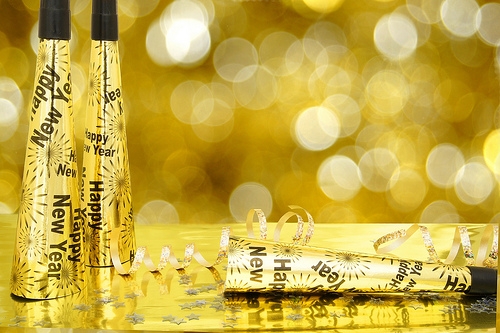
Watching the clock tick down the final seconds until midnight, many of us- Daisy Mountain Dentistry included- feel nostalgic about the passing year and hopeful about the new one to come. New Year’s Eve is one of the most widely celebrated holidays in the world, with over-the-top celebrations taking place in dozens of countries. The Gregorian calendar, which is widely used in Western nations and around the world, was implemented in 1582. Since that time, December 31st has marked the final day of the year, with midnight heralding the beginning of a brand new year. In the United States, New Year’s Day is a public holiday; government offices, schools, public organizations, and many businesses are closed for the day. Ponder the following fun facts as you think about your plans for the holiday:
- Approximately one billion people watch the New Year’s Eve ball drop in Times Square, New York City. This televised event is one of the most iconic New Year’s celebrations in the world. For many years, watching the ball drop meant tuning in to Dick Clark’s Rockin’ New Year’s Eve, an iconic television special dear to the hearts of many viewers.
- The idea for the New Year’s Eve ball came about because of a citywide ban on fireworks. Before 1907, when fireworks became illegal in New York City, celebrations included an elaborate fireworks show. The large, glittering, illuminated ball was developed as an alternative. Although the first ball was heavy at 700 pounds, the modern New Year’s Eve ball is made of Waterford crystal and tips the scale at six tons!
- The top five New Year’s resolutions are: to lose weight, quit smoking, get a new job, return to school, or increase personal savings. However, approximately 88% of New Year’s resolutions fail. But don’t let that discourage you! Resolutions are most likely to succeed when they are clear, achievable goals. Setting out a concrete plan to achieve your resolution also boosts your chances of success.
- Eating black-eyed peas on New Year’s Day is said to bring good fortune in the new year. Collard greens, cabbage, and ham hocks are also considered lucky foods to enjoy. Just steer clear of the chicken or turkey dinners; eating poultry is a bad omen for the year to come.
Whether you plan to stay in Anthem, or head out into the crowds to watch the ball drop in Times Square, New Year’s Eve is a time to enjoy friends and family. Send your loved ones well wishes for the New Year, and look for that special someone to share a midnight kiss with for good luck!
It's a Wrap: Ending the year with a smile!
December 29th, 2022

People have been ushering in the New Year for centuries but it became an official holiday in 1582 when Pope George XIII declared January 1st to be the day on which everyone would celebrate the New Year. At midnight people would yell, holler, and blow horns to scare away the evil spirits of the previous year so the New Year would be joyous and filled with opportunity. Nearly 500 years later, we still greet the New Year by whooping and hollering, but in a celebratory manner instead. Whether you intend to ring in the New Year quietly at home in the Anthem area or have plans to join the countdown at a gala extravaganza, these tips can help you ring out the old and usher in the new with a smile.
Tips for a Happy New Year's Eve Celebration from Daisy Mountain Dentistry
- Be Safe. There's no way to predict the behavior of others on New Year's Eve, but you can be responsible for your own behavior to keep yourself safe. If adult beverages will be part of your celebration, plan on spending the night wherever you are or line up a designated driver to bring you home after the party is over.
- Enjoy Family and Friends. Spending time with the important people in your life is what makes the holidays enjoyable. Coordinate your schedules and choose New Year's Eve activities that everyone in the group will enjoy. You don't have to go to a party to ring in the New Year; some people like to go bowling, see a movie, or have a great meal at home.
- Accessorize with a Smile. Whether you dress up or have a quiet dinner with family and friends, one of the best accessories you can add to your attire is a beautiful smile.
New Year's Eve is a time to gather with friends and family, reflect on the year that's coming to an end, and look forward to the new one with anticipation. Enjoy this transitional holiday in a way that's safe, healthy, and fun. After all, counting down until the clock strikes 12 marks the beginning of a full year of opportunity ahead of you. From Drs. Peter Vogel, Vijal Vadecha, have a great new year!.
What Are Dental Sealants?
December 22nd, 2022

You’re constantly playing defense. Your child spends two minutes in the morning and two minutes at night carefully brushing and flossing with a fluoride toothpaste. You make sure sugary and acidic foods are not a major part of your diets. Your child visits our Anthem office for regular exams and cleanings. Really, how can a cavity get past all that?
But even with the best defensive practices, you don’t have a level playing field—literally. The tops of our molars and premolars don’t have the smooth, easy-to-clean surfaces that our other teeth have. If you look at the chewing surfaces, you will notice deep grooves which toothbrush bristles have a much harder time reaching.
Plaque and food particles can become trapped in these grooves (known as pits and fissures), providing perfect conditions for a cavity to develop. That is why cavities are so common in newly erupted molars. Dental sealants protect these teeth from cavities by providing a barrier which smooths out the surface of the tooth and prevents food and bacteria from reaching the molar’s crevices.
Most sealants are invisible plastic resin coatings which we apply in our Anthem office. Usually the procedure is so quick and easy that no dental anesthetic is required. Each tooth will be examined first. If we find any signs of early decay, we will gently treat that area before beginning.
When the tooth is ready, it will be cleaned and dried. An etching solution will be brushed on to the dry surface to roughen the area a bit so that the sealant will hold to the tooth more effectively. A thin coat of the sealant is then painted on and hardened under a curing light. And that’s it!
Once teeth are sealed, they should be cleaned and flossed just as carefully as before. Regular exams and cleanings are still very important, and we can monitor the condition of the sealant and the sealed teeth. Properly applied, sealants can last from three to five years, or even longer.
Who should consider sealants? Sealants are typically recommended when the permanent molars first erupt. Children’s enamel takes a while to become its strongest, and so these just-erupted teeth are more at risk for cavities. Sometimes Drs. Peter Vogel, Vijal Vadecha will recommend sealants for primary (baby) teeth if needed. But even adults can benefit—talk to us if you are interested and we will let you know if sealants might be right for you.
Sealants are a simple, safe, and minimally invasive way to prevent cavities. Studies of sealed molars and premolars show a dramatic reduction in cavities compared to untreated teeth. Sealants are one of the most effective ways to defend your teeth or your children’s teeth from tooth decay. And as we’ve all heard—defense wins championships!
Four Great Additions to Your Dental-Healthy Diet
December 22nd, 2022

Calcium from dairy products for strong bones and teeth? Check. Vitamin C from fruits and vegetables for gum health? Check. Protein from lean meats, eggs, and fish to create, maintain, and repair tooth and gum tissue? Check, check, and check.
These nutrients are probably the most well-known players in the production of a dental healthy diet, but there are several other important minerals and vitamins we need to balance the cast. Drs. Peter Vogel, Vijal Vadecha and our team take a look at some of these lesser-known but equally vital actors.
- Phosphorus
Calcium is the mineral we hear about most often for maintaining strong teeth and bones, but it doesn’t act alone. Phosphorus is necessary for our bodies to make full use of calcium. Phosphorus is absorbed best from animal foods like meat, fish, and poultry, but it can also be found in beans, nuts, whole grains, and dairy products.
- Magnesium
Magnesium also works with calcium, and promotes bone density and the strength of our hard enamel. If you are looking to add magnesium to your diet, you have a spectacular variety of options, including salmon, tuna, chickpeas, green leafy vegetables, nuts, avocados, seeds, brown rice—even dark chocolate!
- Vitamin A
This vitamin is essential for the health and healing of our mucous membranes, which include our gums and the soft membranes in our mouths. Vitamin A is found in animal products such as dairy foods, meat, and liver, or formed from beta-carotenes, found in plant foods such as carrots, peppers, pumpkin, squash, and sweet potatoes.
- Vitamin D
Even though we might make sure to get plenty of calcium to keep our teeth and bones healthy, we will never get the most out of a calcium-rich diet without vitamin D. Vitamin D not only helps with bone density, it actually helps our bodies absorb calcium so we can put it to work for us. It has also been shown to promote gum health by reducing the inflammation that can lead to gum disease. Sunlight exposure leads our bodies to produce vitamin D naturally, but it is available in foods as well. Fatty fish, such as salmon, tuna, and herring, are a rich source of the vitamin, as are cod liver oil and egg yolks. The only plant that produces vitamin D is the mushroom, but it is also available in foods fortified with vitamin D, such as cow’s milk, soy milk, orange juice, and even many cereals.
You want your diet to be part of your healthy lifestyle, and more and more we are coming to discover just how important a balanced diet is to our dental health as well. The fascinating fact is that all of the nutrients which support our dental health work together and depend on each other to play their roles effectively. Talk to Drs. Peter Vogel, Vijal Vadecha at your next checkup at our Anthem office for some suggestions on finding the dietary balance that works best for you.
Best Ways to Prevent Bad Breath
December 15th, 2022

Nobody likes bad breath, and although it can sometimes be difficult to tell if you have it, it is always better to practice good oral health than risk having a smelly mouth. There are many ways to reduce or eliminate bad breath, some are definitely more effective and longer lasting than others. Check out ways to do so below.
Floss Regularly
As difficult as it can be to remember to floss regularly, when it comes to bad breath, flossing is one of the easiest and most cost effective ways to freshen your mouth. See, flossing reduces the plaque and bacteria found in areas of your mouth that a toothbrush simply can't reach, and in turn, it rids your mouth of the smell associated with that bacteria. While flossing may not eliminate bad breath on its own, if you do it along with other health oral hygiene habits like brushing, then you may just develop a fresher smelling mouth.
Use Mouthwash
Using some sort of mouthwash can really freshen up your breath, especially if you find it still smells after brushing and flossing. There is a wide variety of mouthwash products on the market, however, you can also create your own by simply using baking soda mixed with water.
Always Brush after You Sleep
Whether after taking a nap, or having a full night of sleep, you will want to brush your teeth in order to reduce bad breath. The truth is, bacteria accumulates in your mouth while you are sleeping (even during a short nap) and that is ultimately the source of bad breath. So next time you wake from a good slumber, give your mouth some brushing and you will find it makes a big difference in the freshness of your breath.
There are many ways to freshen your breath beyond just using gum or mints, the above mentioned are just a few for you to try. Test them out and you will likely find your bad breath problem is solved, or at least considerably reduced. Of course, you can always ask Drs. Peter Vogel, Vijal Vadecha at your next visit to our Anthem office.
Breaking Bad Oral Habits
December 15th, 2022

The effects of bad oral habits are something our team sees all too often. You might have bad oral habits that stem from childhood, possibly because your parents did not know about proper oral care or force you to follow it. Or, your bad habits could develop gradually, like slacking on your frequency of brushing.
Bad oral habits can lead to tooth decay, gum disease, and consequences such as losing teeth and experiencing bad pain. They may be deeply ingrained and easy to continue, but you can break them with a little effort. Focus on developing good habits to replace your current ones, and eating a diet that is healthy for your teeth.
Replace Bad Habits with Good
Breaking your bad oral habits may not be as difficult as you expect when you focus instead on developing good habits. These new good habits can naturally replace your bad habits.
- Brush your teeth after each meal or at least twice a day.
- Visit a dentist every six months for an exam and a professional cleaning.
- Floss your teeth every day.
These good habits may not seem natural, so you can take steps to make sure you follow these behaviors. For example, make a daily checklist with your scheduled sessions of brushing and flossing your teeth and using mouthwash. You can also set a timer to be sure you brush your teeth for the full recommended two minutes.
Eat Properly
Poor eating habits can be detrimental to your teeth. A common mistake is to let food, especially carbohydrates such as starch and sugar, stay on your teeth for a long time. You can stop doing this by rinsing your mouth with water after each meal or snack. Also, avoid candy and soft drinks between meals, since the sugar sits on your teeth.
A healthy diet provides the nutrients you need to maintain strong teeth. The mineral calcium is key for healthy teeth, so try to get your three daily servings of high-calcium foods, such as low-fat milk or yogurt, canned fish, or fortified soy or almond milk. Also include vegetables and fruits, which have a high water content.
If you need more tips about breaking your bad oral health habits, contact our Anthem office and speak with Drs. Peter Vogel, Vijal Vadecha or a member of our team.
I’m on a diet and getting MORE cavities!
December 8th, 2022

Health gurus rave about replacing unhealthy food choices with healthy ones in your diet. If you want to maintain your beautiful smile as well as your waistline, choose foods that are good for your teeth and good for losing weight. This article will discuss some of the worst healthy foods for your teeth and gums, and what you can do to continue to enjoy them.
When watching your weight, snacks heavy in sugar and starch are the first target for elimination. You want to trade those empty calories for something with more nutritional value. A healthier snack is fruit and vegetables. When you are substituting empty calories with whole foods such as fruits and vegetables, consider a few implications for your dental health.
The most acidic fruits are grapes, grapefruit, and strawberries. Want to know the number-one worst healthy food for your tooth enamel? Apples! An apple a day may keep the doctor away but you may soon be calling your dentist.
Another healthy food often incorporated into dieting is salads. But consider what you put in those salads. Salad dressings are filled with vinegar and sweeteners. These make a salad very acidic and can change the pH of your mouth from alkaline, which is good for your teeth and gums, to acidic, which puts your smile at risk for erosion and decay.
Last but not least is diet soda. You might be cutting down on the calories but you are still putting your teeth at risk for decay. Though calories are reduced, the acid is not.
You do not need to eliminate any of these foods from your diet. Simply alter what you do after eating these foods to decrease the amount of acid your teeth are exposed to.
During your next visit to Daisy Mountain Dentistry in our Anthem office, we can discuss your diet. We may recommend using certain products to fortify your teeth or change the way you routinely care for your teeth.
Please enjoy the wonderful whole foods that are great for a healthy waistline. A healthy waistline and a healthy smile have a positive influence on your general health. A healthier you is a happier you. The happier you are, the more you smile. Keep your smile brilliant and beautiful with the care your teeth deserve at the practice of Drs. Peter Vogel, Vijal Vadecha.
Five Common Reasons for Emergency Care Visits
December 8th, 2022

A dental emergency can strike anywhere, anytime, and without warning. Perhaps you’re playing a game of touch football on Thanksgiving and your brother-in-law decides to up the ante and tackles you, accidentally knocking out your two front teeth. Or maybe you’re on vacation somewhere in the tropics and decide to go deep-sea fishing, but when you’re climbing onto the boat you slip on the dock, fall, and chip three of your teeth. From misplaced fly balls to bagel seeds causing a painful bout of inflammation, there are all kinds of dental emergencies.
Here are the five most common reasons for emergency care visits.
- Somehow you've managed to knock out a tooth. Whether it's the result of a sports injury or because of decay, when you lose a tooth, you need emergency dental care. If the tooth is salvageable, then it can be reattached to the socket, but this needs to be done within a one- or two-hour window.
- A chipped tooth is the most common dental emergency. Small chips can be caused by food (chicken bones and nuts have sent many people to the dentist); however, it's usually some sort of accident or injury that more often causes a chip. While you might be embarrassed to walk around with a gaping chip in your front tooth, it is easily fixed with a bond, crown, or veneer.
- A broken tooth is more severe than a chipped tooth. When a tooth breaks, it might be due to a small or hidden chip. However, chances are the pain and discomfort will be more severe.
- It might seem comical, but getting a piece of food lodged in the wrong place can result in a dental emergency. If something gets stuck deep in a crevice, it can cause pain and inflammation.
- The loss of a filling happens more often than you think. When you lose a filling, you need to receive emergency care immediately. If you don’t, you risk further damage to your tooth.
When you injure your teeth or mouth, you need to seek emergency care as soon as possible. In the event of a suspected emergency, don't wait. Contact Drs. Peter Vogel, Vijal Vadecha immediately.
Three Valuable Dental Treatments
December 1st, 2022
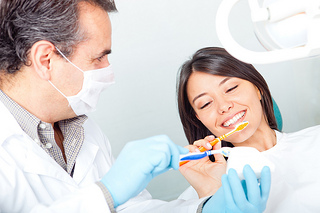
In our office, we customize treatment for every patient. Amid all of the fillings, crowns, and veneers, we find there are three treatments that are most valuable when offering our patients options: dental implants, bite guards, and teeth whitening.
Dental implants are a great tool for those who have lost teeth from trauma, genetic predetermination, decay, or fracture. Technology and design have allowed these implants to look and function like a natural tooth. They are a great investment when maintaining bone structure and smile presentation.
In our fast-paced lives, people take their stress and tension out on their teeth. Clenching and grinding, or bruxism, is on the rise. This is traumatic to crowns, fillings, and natural teeth. Headaches are a symptom of bruxism and when not treated, jaw joint inflammation and pain are a result. Bite guards are often worn at night when most of the action occurs. Many are not even aware of this habit until presented with evidence of cracked teeth, broken crowns, and pain.
Last, but most definitely not least, is whitening. Tooth whitening is safe and effective. There are different types of tooth whitening: in-office, custom trays, and over-the-counter strips. Each is effective, though at different levels. First, and your best option, is done in the office. The gums are protected and a gel with high potency is applied to the teeth. Some methods have a light shining on teeth and some have timed intervals without the light. Next are custom trays, which require an impression of your bite. Trays are picked up at a later date. At that point, instructions are given and the gel and trays are delivered. A final option is whitening strips, which can be found in many local stores. They are effective, though the whitening process is slower and some areas may not whiten.
Each treatment has risks and rewards that should always be considered prior to any treatment. Implants must be well cared for. Bite guards must be an accurate fit and worn regularly. Comfort is most important. Whitening causes temporary sensitivity and some people’s teeth whiten better than others.
Consider what your needs are, and then customize your wants to fit into the equation. A little stability from implants, protection from a bite guard, and a brilliant smile may be just what the doctor ordered. And if you have any questions, don’t hesitate to call our office, Daisy Mountain Dentistry.
What Are Chalky Teeth?
December 1st, 2022

You’ve always taken care of your child’s smile. You make sure thorough brushing and flossing take place twice a day. You serve foods high in vitamins and minerals and low in sugar. You make and keep regular dental appointments at our Anthem office. But even with the best dental routines, sometimes conditions can occur that will require additional professional care.
One of these conditions can affect your child’s enamel while the tooth is still forming. When baby teeth or adult teeth appear, you might notice white, creamy yellow, or brown spots in otherwise healthy-looking enamel. These spots are softer and rougher than normal hard, smooth enamel. Because of their texture and color, such teeth are often referred to as “chalky teeth,” but this condition is actually known as enamel hypomineralization.
What is hypomineralization?
Enamel is the strongest substance in our bodies—stronger even than bones. Enamel is largely composed of minerals. If something disrupts the process of enamel development in baby or adult teeth, the result can be abnormally low mineral content in the enamel. This leaves teeth weaker and more likely to suffer decay and damage.
Premature birth, low birth weight, and other pre-natal factors have been suggested as risk factors for hypomineralization in primary teeth enamel. Permanent teeth can be vulnerable to this condition as well. Adult teeth are forming in young children well before they make an appearance. It’s been suggested that certain early childhood factors, such as recurring high fevers, some diseases, even specific antibiotics, can interrupt the formation of the enamel and lead to hypomineralization of adult teeth.
What are the results of enamel hypomineralization?
Children with this condition are much more likely to experience rapid tooth decay because of their weaker, more porous enamel, especially in the molars. Further, they tend not to respond as well to the numbing effects of local dental anesthetics, while their teeth tend to be more sensitive to pain. Cases can be mild, moderate, or severe. In severe cases, teeth might require crowns or possibly extractions, but even mild discoloration and other cosmetic problems can lead to self-consciousness in your child.
How can we help?
Catching this condition early is very important. If your child has had any medical conditions that might affect tooth development, let Drs. Peter Vogel, Vijal Vadecha know even before that first tooth comes in. If you notice anything unusual about a new baby or adult tooth, give us a call. For primary or permanent teeth, the sooner we can begin treatment, the better the long-term outlook.
We might suggest fluoride applications or desensitizing treatments. We can apply sealants to reduce the risk of cavities, and use bonding to restore discolored or weak patches in the tooth. Both of these methods have greater success if the enamel near the affected area is in good condition, so early treatment is vital. If teeth require more protection, crowns are often the best choice. We will design a treatment program to suit your child’s individual needs now and for the future.
How can you help?
Dental hygiene is important for every child, but especially for a child with weak and porous enamel. Because children with hypomineralized enamel develop cavities more quickly that those with strong enamel, it is very important to watch your child’s diet and keep to a regular, careful, and thorough routine of brushing and flossing at home. Be attentive to any sensitivity problems, and be sure to follow any suggestions we might have for strengthening enamel.
Remember, early diagnosis and treatment is always best! If at any time you notice chalky patches, or have any other concerns about the appearance of your child’s teeth, if they seem to be causing your child pain or are unusually sensitive, call Drs. Peter Vogel, Vijal Vadecha immediately. We want to work with you to treat any current problems and to prevent new ones.
How HPV and Oral Cancer are Related
November 24th, 2022

Did you know that Human Papilloma Virus (HPV) and oral cancer are linked? This information may prevent you or a loved one from suffering from oral cancer if a diagnosis is made early. Drs. Peter Vogel, Vijal Vadecha and our team want you to understand how you can prevent the spread of oral cancer and protect yourself if you have HPV.
People don’t often speak up about this common virus, but we believe it’s important to educate yourself to prevent the potential spread of oral cancer. According to the Centers for Disease Control and Prevention, up to 80% of Americans will have HPV infections in their lifetime without even knowing it. Symptoms usually go unnoticed, though it’s one of the most common viruses in the U.S. The body’s immune system is generally able to kill the HPV infection without causing any noticeable issues. If you think you might have HPV, talk with primary care physician about getting the preventive vaccine or taking an HPV test.
According to the Oral Cancer Foundation, “HPV is the leading cause of oropharyngeal cancers (the very back of the mouth and throat), and a very small number of front of the mouth, oral cavity cancers. HPV16 is the version most responsible, and affects both males and females.”
Common signs of oral cancer may include:
- Ulcers or sores that don’t heal within a couple of weeks
- Swelling, lumps, and discoloration on the soft tissues in the mouth
- Difficult or painful swallowing
- Pain with chewing
- Persistent sore throat
- Numbness of the mouth or lips
- Lumps felt on the outside of the neck
- Constant coughing
- Earaches on one side of your head
If you experience any of these side effects, please contact Daisy Mountain Dentistry as soon as possible.
We hope this information will help you understand the interactions between HPV and oral cancer. Please remember to take precautionary steps if you notice anything out of the ordinary with regard to your oral health. If you have any questions or concerns, contact our Anthem office.
Recovering from Oral Surgery
November 24th, 2022

If you need oral surgery, Drs. Peter Vogel, Vijal Vadecha and our team will use our expertise and training to ensure that you have the best possible surgical outcome. And we want to make sure you have the best possible outcome for your recovery as well. Here are a few of the most common aftercare suggestions for making your healing as comfortable and rapid as possible.
- Reduce Swelling
Ice packs or cold compresses can reduce swelling. We’ll instruct you how to use them if needed, and when to call our Anthem office if swelling persists.
- Reduce Bleeding
Some amount of bleeding is normal after many types of oral surgery. We might give you gauze pads to apply to the area, with instructions on how much pressure to apply and how long to apply it. We will also let you know what to do if the bleeding continues longer than expected.
- Reduce Pain or Discomfort
If you have some pain after surgery, over-the-counter pain relievers such as ibuprofen might be all that you need. We can recommend those which are best for you. If you need a prescription for pain medication, be sure to take it as directed and always let us know in advance if you have any allergies or other reactions to medications.
- Recovery-friendly Diet
Take it easy for the first few days after oral surgery. Liquids and soft foods are best for several days following surgery. We will let you know what type of diet is indicated and how long you should follow it depending on your particular procedure. We might, for example, recommend that you avoid alcohol and tobacco, spicy, crunchy, and chewy foods, and hot foods or beverages for several days or several weeks.
- Take Antibiotics If Needed
If you have been prescribed an antibiotic, be sure to take it as directed. If you have any allergies to antibiotics, let us know in advance.
- Protect the Wound
Do NOT use straws, smoke, or suck on foods. Avoid spitting. Part of the healing process can involve the formation of a clot over the surgical site which protects the wound. If the clot is dislodged by suction or spitting, it can prolong your recovery time, or even lead to a potentially serious condition called “dry socket.”
- Maintain Oral Hygiene
Depending on your surgery, we might recommend that you avoid rinsing your mouth for 24 hours, use salt water rinses when appropriate, and keep away from the surgical site when brushing. It’s important to keep your mouth clean, carefully and gently.
- Take it Easy!
Rest the day of your surgery and keep your activities light in the days following.
These are general guidelines for recovery. If you have oral surgery scheduled, we will supply you with instructions for your specific procedure, and can tailor your aftercare to fit any individual needs. Our goal is to make sure that both your surgery and your recovery are as comfortable as possible.
Dental Veneers
November 16th, 2022
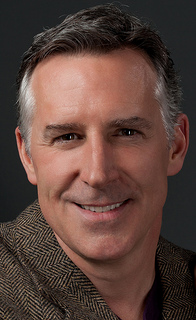
Are you looking to improve the appearance of your front teeth? Dental veneers are widely used to improve the appearance of front teeth and are a much more conservative option than a full dental crown. Veneers can be used to improve the appearance of staining, large gaps, large fillings, chipped teeth, or overall shape. Veneers are a thin covering over the front and biting end of the tooth used to restore the beauty of a smile. Over the years we have helped many patients who opted for veneers and now have the confidence to smile again.
Dental veneers are made in a lab from long-lasting porcelain materials. The shade can be chosen to a desirable color to whiten the appearance of your smile. Dental veneers are usually placed on the anterior, or front teeth, where the chewing forces are not as hard as the back teeth. The process of placing veneers is relatively easy requiring only two dental appointments. In some cases, only one appointment is needed. It depends on the fabrication process.
The first appointment is to “prep” the teeth and take an impression to be sent to a lab to fabricate the veneers. Veneers are fairly conservative in the preparation as it requires a small amount of space to be created on the face (front), bottom, and sides of each tooth to allow space for the veneer to be placed and look natural. You will leave the office with temporary veneers for the next week or two while the permanent veneers are being made.
The second appointment is to place the veneers and make minor adjustments if needed. What a difference it makes in the appearance of the teeth! If you’re interested in learning more, give Drs. Peter Vogel, Vijal Vadecha a call today!
Diet and Dental Health: What to eat and what to avoid
November 9th, 2022

You are probably aware that guzzling soda and drinking those sugary Starbucks Frappuccinos aren’t particularly good for your dental health. But how much thought do you give to the effects of your diet on your teeth? Practicing healthy eating habits isn’t just helpful for your waistline, it also ensures that your teeth stay strong and cavity-free.
How diet affects dental health
Our team at Daisy Mountain Dentistry will tell you that your mouth is a complicated place on a microbiological level. Harmful bacteria form dental plaques which convert the sugars in food to acids that wear away at tooth enamel. Meanwhile, saliva washes away some of the detrimental acids, while minerals work to rebuild where teeth are damaged. The foods you eat are important for managing this balancing act between harmful bacteria and helpful rebuilding agents.
Rethinking your diet to prevent cavities
Carefully considering your dietary choices is a smart way to become mindful of the foods you eat and how they affect oral health.
Foods to eat
- Calcium- and phosphorus-rich foods. We’ve all heard that milk builds strong bones, and your teeth are included in that. Milk, cheese, nuts, and chicken are strong sources of calcium and phosphorus. These minerals are used to repair damage to the teeth’s enamel.
- Crunchy fruits and vegetables. Biting into an apple stimulates saliva flow, which washes harmful acids from the surface of your teeth. Turn to other crunchy fruits and vegetables, including carrots, celery, pears, and lettuce, to increase saliva production.
- Sugar substitutes. If you have a sweet tooth but want to decrease tooth decay, sugar substitutes such as Stevia or Equal provide a sugary kick without harming your teeth.
Foods to avoid
- Sugary snacks. Cookies, cakes, candies, and other sugary treats provide a feast for the acid-producing bacteria in your mouth. Furthermore, these foods often get stuck in the ridges of your teeth, and provide a breeding ground for new bacteria.
- Acidic fruits and vegetables. Foods high in acidity, such as tomatoes, citrus fruits, berries, peaches, and lemons, wear away the enamel of your teeth. Because these foods can be part of a healthy diet, remember to brush after eating them or swish with a mouth rinse to protect your teeth.
Eating well is an essential part of keeping your teeth healthy. Consult Drs. Peter Vogel, Vijal Vadecha about your diet for tips on food habits that keep your teeth strong and cavity-free. For more information about the link between your diet and your oral health, or to schedule an appointment with Drs. Peter Vogel, Vijal Vadecha, please give us a call at our convenient Anthem office!
Getting Ready for Winter
November 2nd, 2022

Winter Is Coming.
Okay, that sounded a lot more dramatic in a popular fantasy series. But here in the real world, winter is coming as well, so let’s look at some easy steps you can take to keep your teeth and gums healthy during this icy season.
Remember to Hydrate
Dehydration is dangerous for your health in general, and it’s also bad for your dental health. A dry mouth is more vulnerable to gum disease and tooth decay because there’s less saliva to help maintain a healthy oral environment. Saliva helps wash away food particles and bacteria, works to neutralize the cavity-causing acids they produce, and strengthens tooth enamel with its mineral content.
Summer means heat and perspiration—two obvious causes of dehydration. Winter, though, has its own more subtle ways to dry you out.
- Just as you lose moisture through summer perspiration, you lose moisture with a winter workout as well. That foggy cloud you see when you exhale outdoors? That’s water vapor leaving your body.
- Cold weather means it’s time to kick up the heating system a few degrees. But unlike heated summer outdoor air, heated winter indoor air is not as humid, so it’s more drying.
- Some of us just aren’t as thirsty during winter months, and so we don’t hydrate as regularly as we do in the summer. And while summer menus tend to offer foods like salad, fruits, and iced drinks which automatically provide us with a lot of water content, winter menus? Not so much. Keep up with your daily recommended amount of water throughout the year for a healthier body and healthier teeth and gums.
Wear Your Mouthguard
Whether it’s skiing, hockey, snowboarding, or skating, those winter sports can be hard on your teeth. That’s why it’s important to wear your mouthguard when you’re getting the most out of the snow and ice. Mouthguards help prevent injuries to your teeth and provide protection for your jaw and mouth, too.
And a sport doesn’t have to involve snow and ice to be a winter hazard for your teeth. The combination of hard courts, flying elbows, and body contact make basketball a leader in the dental injuries competition. In fact, any sport which involves potential falls or personal contact is a good candidate for a mouthguard.
Mouthguards are available in several forms:
- One-size-fits-all, pre-formed mouthguards can be found in drugstores and sporting goods stores.
- “Boil-and-bite” models are warmed in hot water and then shaped when you bite down. The fit is somewhat more comfortable than a stock guard.
- Custom-made guards from your dentist are precisely molded to your teeth and mouth, letting you speak and breathe more comfortably.
If you haven’t gotten a mouthguard yet, or your old high school guard was retired years ago, talk to Drs. Peter Vogel, Vijal Vadecha about a custom guard. While the over-the-counter options are better than going unprotected, a custom mouthguard fits your teeth perfectly—and comfortably!
Get to the Bottom of Winter Sensitivity
That first breath of frosty air might be more alarming than invigorating when tooth pain and sensitivity makes being out in the cold an unpleasant experience. Sensitivity to cold air or warm winter drinks can be an important symptom, caused by a number of dental conditions such as:
- Cracked teeth
- Cavities
- Exposed dentin (the layer of the tooth underneath your enamel)
- Receding gums
- Over-vigorous brushing
If the cold weather is keeping you indoors because of oral sensitivity, give us a call.
Even though this can be a very busy time of year, if you’re due for a checkup and cleaning at our Anthem office, or if you have any concerns about your teeth and gums, make time for your dental health. We want to make sure you’re ready to enjoy every frosty moment of the season!
Just What Is Plaque?
October 26th, 2022

From the time you were small, you’ve been warned about the dangers of plaque. Why? Because:
- It’s an unappealing film that sticks to your teeth
- It causes cavities
- It causes gum disease
And really, do we need to know much more than this to motivate us to brush? But if you’re in a curious mood, you might be wondering just how this soft, fuzzy film accomplishes all that damage. Let’s take a closer look at the sticky problem of plaque.
How does plaque form?
We live with hundreds of species of oral bacteria, most of which are harmless, and some of which are actually beneficial. But when our oral ecosystem gets out of balance, problems can occur. For example, without regular and thorough brushing and flossing, we start to build up plaque.
Plaque starts forming within hours of your last brushing. And even though plaque fits the very definition of “seems to appear overnight,” this biofilm is actually a complex microbial community with several different stages of development.
- It starts with saliva.
Saliva is vital to our oral health, because it keeps us hydrated, washes away food particles, neutralizes acids in the mouth, and provides minerals which keep our enamel strong. Saliva also contains proteins, which help form a healthy, protective film on the tooth surface. This film is called a pellicle.
- Bacteria attach to the pellicle.
There are species of oral bacteria that are able to attach themselves to the pellicle film within hours of its formation. As they become more firmly attached, they begin to grow and divide to form colonies, and are known as the early colonizers of the plaque biofilm.
- A complex biofilm forms.
If you’ve skipped brushing for a few days (please don’t!), you’ll notice a fuzzy, sometimes discolored film on your enamel—that’s a thriving plaque community, and it only takes a matter of days to go from invisible to unpleasant.
If you’re not removing plaque regularly, it can harden further and become tartar. And once you have tartar buildup, you’ll need the care of a dental professional to remove it.
- What happens if we ignore plaque and tartar?
We get cavities and gum disease.
How does plaque cause cavities?
- The bacteria in plaque, like all organisms, need nutrients.
Our normal oral environment and the food in our everyday diets provide the nutrients plaque needs. And, as we mentioned above, certain types of oral bacteria convert these nutrients into acids. Foods such as carbohydrates, starches, and sugars are most easily converted into acids, which is why we recommend that you enjoy them in moderation.
- The biofilm promotes acid production.
Within the plaque film, anaerobic bacteria (bacteria which don’t use oxygen) convert sugars and starches into acids. As the plaque film becomes denser, it blocks acid-neutralizing saliva and oxygen from reaching these bacteria close to the tooth’s surface, creating an ideal environment for the bacteria to produce their acid waste products.
- Acids attack enamel.
The sticky nature of plaque keeps these acids in contact with tooth enamel, where, over time, acids dissolve minerals in enamel, weakening the mineral structure of the tooth.
How does plaque cause gum disease?
- Bacteria cause inflammation and gingivitis.
The bacteria in plaque irritate the delicate tissue of the gums, which causes an inflammation response which can leave your gums swollen, red, bleeding, or tender. This early form of gum disease is gingivitis. Fortunately, good dental care and careful brushing and flossing can usually prevent and even eliminate gingivitis.
- Plaque and tartar can lead to periodontitis.
When plaque and tartar build up around and below the gumline, the gums pull away from the teeth, leaving pockets where bacteria collect, leading to infection as well as inflammation. Infections and constant inflammation not only harm gum tissue, they can destroy the bone supporting the teeth. This serious gum condition is periodontitis, and should be treated immediately to avoid further infection and even tooth loss.
How do we fight plaque?
From the time you were small, you’ve learned how to fight plaque:
- Brush at least twice a day for two minutes, and be sure to brush all of your tooth surfaces and around the gumline.
- Floss to remove plaque from between the teeth and near the gumline.
- Visit our Anthem office for a thorough professional cleaning.
Be proactive. If you have any questions, talk to Drs. Peter Vogel, Vijal Vadecha about the best way to keep plaque at bay. We can show you the most effective ways to brush and floss, recommend anti-plaque toothpastes and rinses, even suggest plaque-revealing tablets if you’re missing some trouble spots.
We’ve only brushed up on some plaque basics, because there is a lot more to discover about this complex biofilm. Happily, even with all there is to learn about plaque’s growth and development, it’s reassuring to know that getting rid of it is quite simple—with just a soft-bristled brush, some dental floss, and a few minutes of your time each day, you’re on the way to a healthy, happy, plaque-free smile.
Protect Your Enamel from Dental Erosion
October 19th, 2022

We know that the foods we eat and drink can have a definite impact on our smiles. Staining is an unhappy side effect of many of our menu favorites. That’s why we sip red wine through a straw, rinse with water after a slice of blueberry pie, and cut back on the coffee and tea after a single cup (or two—we’re not perfect!). And sugar is the fuel for cavity-causing bacteria, so we try to substitute water for soda, or replace the hot fudge sundae with grilled fruit. And we always brush carefully after indulging.
So far, so good. But while we’re saving our brilliant smiles from stains and decay, let’s not forget one other source of diet-related damage—acids. Acidic foods and beverages can actually erode the surface of our enamel, leaving our teeth more vulnerable to sensitivity and discoloration.
What Is Dental Erosion?
Enamel is the strongest substance in our bodies—stronger than bone—but it is not indestructible. And acids are one of the major causes of enamel damage. (In fact, it’s the acids produced by bacteria that lead to cavities.) Luckily, our bodies are designed to protect our enamel. Saliva helps clean the teeth by washing away food particles and it neutralizes acidity as well. But a diet that’s too heavy in acidic foods can undo all this good work and upset the healthy pH balance in our mouths.
Why is this a problem? Because acidic environments actually cause the minerals in our enamel to break down, a process known as “demineralization.” This weakening of the enamel leaves teeth more sensitive to heat and cold. It can even lead to discolored teeth, as thinner enamel allows the brownish-yellow dentin underneath the enamel surface to become visible.
Are You Aware of Acids?
We can immediately guess at some of the most acidic foods. Citrus fruits and juices, tomatoes in their many culinary forms, anything pickled in vinegar, coffee, tea, wine—these foods are certainly acidic, but also a regular part of many a healthy diet. You don’t need to avoid these foods altogether, but it’s best to enjoy them as part of a meal or enjoy them sparingly. And balance out some of these high-acidity foods at mealtime with low-acidity choices like bananas, bread, and dairy products.
Other sources of damaging acids might surprise you. Studies have linked sodas, energy drinks, and sports drinks to higher levels of tooth erosion. The combination of citric acid, phosphoric acid and/or carbonation raises acidity levels in the mouth. And because we tend to sip them all day long, it’s like a continuing acid bath for our enamel. Water is always a healthy alternative for hydration, but if you do indulge in a soda or sports drink, rinse with water after drinking. And don’t swish—just swallow.
Won’t Brushing Help?
Yes, but watch your timing. Because the acids in foods weaken enamel, brushing right after a big glass of orange juice or a soda can actually be even more abrasive for tooth surfaces. We recommend waiting anywhere from 20-60 minutes to brush. This gives your saliva the chance to not only wash away acids, but to “remineralize” your teeth, bathing them in the phosphate and calcium ions that strengthen enamel.
If you notice any of the symptoms of dental erosion, including pain, sensitivity when you eat or drink something hot, cold or sweet, or yellow discoloration, talk to Drs. Peter Vogel, Vijal Vadecha during your visit to our Anthem office about what you can do to help protect and strengthen your teeth. Unfortunately, our bodies can’t produce new enamel. By avoiding foods that stain, by reducing sugars that lead to decay, and by limiting the acidic foods that erode our enamel, we give ourselves the best opportunity for a lifetime of beautiful, healthy smiles.
The Perks of Dairy
October 12th, 2022

We all remember hearing this: “Finish your milk, it’s good for your bones!” If you have kids of your own now, you may catch yourself repeating many of the things you were told growing up.
Though parents occasionally exaggerate to get their kids to do certain things (such as eat veggies or behave), they’re spot-on about milk. Consuming enough dairy every day is crucial for growing children, because this can set them up to have strong and healthy teeth for the rest of their lives.
To understand the effects of dairy on your child’s teeth, take a look at tooth structure. Think of it in terms of layers: the innermost layer is the living tissue, the second layer is dentine (a calcified tissue), and the final one is the enamel, aka the white part of the tooth. Keep in mind that 96 percent of your enamel is made up of minerals like calcium.
Now, milk and other dairy products are excellent sources of calcium, so when you consider the need to build strong enamel for the first line of defense, it’s easy to see the connection between dairy and good dental health. When your son or daughter consumes dairy products, the body sends the incoming calcium to growing bones, which includes teeth.
This makes children’s teeth and bones stronger all around. Growing youngsters who do not get enough dairy in their diet are at risk for improper tooth development, as well as other dental problems.
According to the U.S. Department of Agriculture, children under the age of eight should be receiving at least two and a half cups of dairy per day. Children older than eight require three full cups, which is the same amount recommended for male and female adults.
If you’re looking for easy ways to incorporate dairy into your children’s diet, try snacks like cottage cheese, a milk-based smoothie, yogurt, cheese sticks, non-fat milk, and fruit parfaits, to name a few. Once you get a feel for what they like most, furnishing the ideal amount of dairy to their diet should be no problem!
If you’re concerned about your child’s teeth or have questions about a healthy diet, don’t hesitate to contact our Anthem office and ask a member of our team.
October is National Dental Hygiene Month: A simple oral health routine for your busy lifestyle
October 5th, 2022

Adults are no strangers to feeling like there is never enough time in the day to get everything done. Your alarm clock rings and within minutes you ping pong around trying to spread peanut butter on sandwiches, answer your cell phone, remove the dog hair from your clothes, and make sure your child has completed his or her science fair project. Brushing your teeth can easily fall to the wayside. That is why our office promotes a simple, daily oral health regimen that you can easily incorporate into your busy lifestyle.
The American Dental Hygienists' Association (ADHA), in partnership with the Wrigley Jr. Company, is celebrating National Dental Hygiene Month (NDHM) during October. The ADHA encourages people to "Brush. Floss. Rinse. Chew...Keep it Clean, Keep it Healthy!" and offers some great tips for a quick and effective home oral health routine, below:
Oral Health Routine at Home
- Brushing your teeth twice daily is the most important thing you can do to diminish the accumulation of plaque and the potential for other oral problems such as cavities and gingivitis.
- Flossing once daily removes plaque and food from beneath the gums and between teeth that brushing alone cannot remove. Tooth decay and gum disease often begin in these areas.
- Rinsing your mouth with an antibacterial, non-alcohol based mouthwash kills plaque and gingivitis germs that brushing and flossing do not catch. We recommend using a mouthwash with the ADA Seal of Acceptance.
- Chewing sugar-free gum helps produce saliva, which battles cavities. The gum also neutralizes plaque, strengthens enamel, and removes remaining food. It is especially important to chew gum after eating or drinking.
It's easy to put the toothbrush down in order to take care of matters you feel are more urgent, but remember, a good oral health routine at home is the best way to prevent periodontal disease. "Periodontal disease is the most common cause of tooth loss in adults. An estimated 75 percent of Americans reportedly have some form of periodontal disease," said the ADHA. Periodontal disease also is linked to more serious illnesses such as diabetes and stroke.
Also, remember to keep regular visits with our office. Drs. Peter Vogel, Vijal Vadecha can help you learn more about proper care for your teeth and gums.
Adult Mouthguards
September 28th, 2022

You make sure your daughter wears her mouthguard to every soccer practice. Your son doesn’t step on the basketball court without his. Why not protect your smile as well?
Athletes of all ages in team or recreational sports can help prevent dental injuries with a protective mouthguard. If you bike or ski, play racquetball or squash, skate, or sky dive, a mouthguard will help keep your teeth and gums healthy as you keep fit.
Mouthguard Options
Our office will be happy to talk to you about whether a mouthguard is a practical addition to your workout gear. There are many options available to you, including:
Stock: Preformed appliances available at sporting goods stores and drugstores. These are the most affordable, but are a one-size-fits-all option and may not be a comfortable fit for you.
Boil-and-Bite: Also available at sports shops and drugstores. This guard is formed by placing it in hot water and then biting down to allow it to conform to the shape of your mouth.
Custom: Our Anthem office can create a personalized mouthguard just for you. Individual mouthguards are the most durable and comfortable option, in general, and provide the best fit for ease of talking and breathing while exercising. You may also have special dental conditions, such as the placement of crowns or braces, which could be a factor in your decision.
Whichever option you choose, remember to wear your mouthguard regularly while exercising. A proper mouthguard cannot only help prevent injuries to your teeth, but to your face and jaw as well. A healthy smile and a healthy body are a winning combination. The next time you visit Drs. Peter Vogel, Vijal Vadecha, let’s talk sports!
Five Things You Didn't Know About Cavities
September 21st, 2022

Most people know when they have a cavity—they can either see it on their tooth or... ouch! They can feel it! But there are certain things that many of our patients don't know about cavities that could save them a trip to our Anthem office!
1. Not all sugars are created equal
It's quite well known that eating dietary sugars in excess along with poor oral hygiene leads to dental decay such as cavities. This is due to the fact that the bacteria in your mouth feed on these sugars and excrete acids as a byproduct of that process, thus causing decay. But xylitol, a sugar alcohol derived from birch or corn, actually prevents the bacteria from converting sugars into acids.
Xylitol is available in the form of gum, mints, toothpaste, and even in a granulated form much like regular cane sugar. You might consider trying some xylitol products between meals to keep your mouth clean and fresh.
2. It's not always what you eat but HOW you eat
Are you a grazer, always snacking between meals and never satisfied? We now know that this kind of eating can contribute to cavities and other oral health problems.
Every time you eat anything with carbohydrates in it, you're feeding the bacteria in your mouth, which in turn produce acids. If you're constantly eating, it doesn't allow your saliva time to bring the pH of your mouth back into a more alkaline, neutral state. It takes your saliva about 20 minutes to neutralize the acids in your mouth after eating.
It's especially easy to harm your teeth in this way with soft drinks, sipping all day long. So, it's best to avoid sugary drinks and junk food, and if you need a snack opt for healthy vegetables or what are known as "detergent foods." If you do decide to drink a soft drink or eat something sugary, have it all at once and not over the course of the day.
3. Flossing is one of the most important oral hygiene techniques
Although most of our patients are aware that they need to brush, sometimes they can get lackadaisical when it comes to flossing. And that's a big mistake. Flossing is one of the most important (and we daresay, easiest) things someone can do to help prevent cavities and tooth decay.
You see, as we've already mentioned, the bacteria in your mouth that cause cavities feed on the food you eat. So if you've got pieces of that food stuck between your teeth all day and night, every day, that's asking for a problem.
Flossing clears that bacteria-feeding food out from between your teeth. Floss daily and whenever you decide to do it, morning or night, just do it!
4. A dry mouth can lead to cavities and tooth decay
Your teeth's best defense against cavities and tooth decay is actually your saliva! We've already talked about the pH neutralizing effect saliva has. So if you find you have a dry mouth often, make sure to have some water to sip on. Or why not try some xylitol mints or gum to get your saliva production kicked into action?
5. Over-brushing can damage your enamel
If you brush like a construction worker with a jackhammer, you should ease up! Brushing too hard can scrape away at your teeth's enamel, which leaves them more susceptible to cavities and decay. Brush lightly, with your brush angled at the gum line for two minutes, twice a day. That's all that is required!
Diastema, or, Mind the Gap!
September 14th, 2022

Diastema is a medical term meaning “space between”—or what Drs. Peter Vogel, Vijal Vadecha and our team less formally call a gap between the teeth. Such gaps are common for children as they make the transition from baby teeth to adult teeth, and usually close when all the permanent teeth arrive. But not always!
Sometimes a gap, usually between the upper front teeth, stays with you into adulthood, but doesn’t affect your perfectly heathy teeth. Sometimes a diastema develops due to medical conditions or trauma. Whether you would like to close a gap for cosmetic reasons, or need to address gaps that have developed because of dental problems, your treatment will depend on the causes of the diastema.
- The Relationship of Jaws and Teeth
Most of the time, we think of braces as straightening crooked teeth. For many braces wearers, the jaw can’t accommodate all of the adult teeth without crowding. But it’s also possible to have too much space for incoming teeth, and this can lead to a gap between two or more teeth. Orthodontic treatment is a common choice to close this kind of gap, using braces or clear aligners to move the teeth closer together.
- Prominent Labial Frenulum
The labial frenulum is a band of muscular tissue that connects the upper lip and the top of the gums. If it is too large, tissue can extend beyond the top of the front teeth. A gap develops when the front teeth simply can’t meet because of the tissue between them. Oral surgery can reduce the size of the frenulum, if necessary, and often orthodontic treatment is the go-to option to close the diastema.
- Small Teeth or Small Gap
Occasionally, a few teeth are noticeably smaller than their neighbors. Bonding, veneers, and crowns can be used to enlarge these teeth, making them proportionate to the teeth around them. These treatments can also be successful in reducing a gap between the front teeth.
- Missing Teeth
Sometimes people are born missing a tooth. Sometimes people lose a tooth to injury or decay. And while the space left by a missing or lost tooth is a noticeable gap in itself, the remaining teeth can shift to fill the void, causing other gaps to develop as well. A dental implant or bridge can both replace a missing tooth and maintain the normal spacing of the teeth that surround it.
- Gum Disease
Left untreated, periodontitis (gum disease) can damage or even destroy the bone tissue which holds and supports the teeth. This, in turn, leads to “tooth mobility,” or loose teeth. Spaces between the teeth become more noticeable and larger over time. After the gum disease is treated, patient and dentist can explore options for reducing or eliminating spaces between the teeth.
- Harmful Oral Habits
Tongue thrusting and thumb sucking are two habits that can affect the alignment of the front teeth. Both behaviors pressure the teeth to move forward, which can cause separations between them. Learning how to change these behaviors will help prevent or stop the expansion of a diastema and potentially serious malocclusions (bad bites).
If you would like to discuss your diastema for aesthetic reasons, talk to Drs. Peter Vogel, Vijal Vadecha for ways to reduce or eliminate the gap. If your diastema is the result of a medical condition, we will be able to recommend treatment options available at our Anthem office. If you’re teeth and gums are healthy, and you enjoy the individuality of your diastema . . .
- Embrace the Space!
A diastema can be a signature look for you and your smile. Normal brushing, flossing, and regular dental care will keep your smile bright, healthy, and uniquely you. And if you’re happy, healthy, and confidant, why, there’s no reason to mind the gap at all!
Back to School? Remember Your Dental Homework!
September 7th, 2022

It’s a busy time of year. Book lists! Supplies! New clothes! (How did they outgrow those shoes already?) And while you’re preparing your family’s list of back-to-school necessities, here are a few essential reminders to help your child begin the school year with a healthy smile.
- Review
It never hurts to review the basics before the start of the school year, and that holds true for dental care as well! Make sure your child is brushing two minutes twice a day, and using floss or another interdental tool to clean between the teeth. If his toothbrush has been in use since the end of the last school year, it’s probably time to replace it. Bristles are at their best for about three months—after that, they become frayed and worn, and can’t remove plaque as effectively.
- School Supplies for Braces Wearers
If your child is going to school with braces for the first time, send her off with the tools she needs. A travel-sized toothbrush and tube of toothpaste are perfect for a quick brushing after lunch, while dental floss and a threader or dental picks will take care of any after-lunch particles lurking in brackets and wires. Orthodontic wax is a great product to have on hand if a wire or bracket is causing irritation. If your child uses clear aligners or a retainer, make sure a protective case is always close by, ready to use every time the appliance is removed. And it’s a good idea to include the number of your dentist and orthodontist in her contacts in case of emergency.
- Exams
If your school requires a dental exam before the start of classes, be sure to make your appointment at our Anthem office now! Regular checkups with Drs. Peter Vogel, Vijal Vadecha are vital for preventing small problems from becoming bigger ones, and a professional cleaning will remove the plaque even careful brushing can miss.
A positive, confident start can set the tone for the academic year, so your homework might include monitoring summer reading, providing required supplies, and making sure your child is well-rested and ready to go. You can also help your child to a positive, confident start by monitoring brushing habits, providing the necessary tools for appliance-wearers, and making sure your child is up-to-date with dental exams and cleanings. Because entering the classroom with a beaming, healthy smile—that’s an A+ way to begin the school year!
Happy Labor Day!
August 31st, 2022

Labor Day is upon us, and that means the non-official end to summer. Before the kids head back to school and temperatures start to cool down, this is your last chance to barbeque in the beautiful Anthem community, head to the lake, and wear your favorite pair of white pants.
About Labor Day
Each year, Labor Day is celebrated on the first Monday of September. It is the one day of year Americans celebrate their achievements in work, which the US Department of Labor says has contributed to prosperity and well-being of America as a whole. Americans have been celebrating Labor Day since the 1880s, and today it is an official federal holiday.
Interesting Facts About Labor Day
- Every year, more than 30 million Americans travel over Labor Day weekend.
- Canada was the first to celebrate Labor Day, and the US soon followed.
- President Cleveland made Labor Day and official US holiday in 1894.
- Labor Day marks the beginning of the NFL and NCAA sports seasons for fans.
- Labor Day marks the end of hot dog season, when Americans consume seven billion hot dogs.
Thanks for being a valued patient of our dental office. Our staff would like to wish you a safe and happy Labor Day weekend. Enjoy your time off!
I can't stop grinding my teeth! How can a dentist help?
August 24th, 2022

Drs. Peter Vogel, Vijal Vadecha will tell you that while you are sleep, your mouth may be very active. If you find yourself waking up with headaches, facial pain, neck aches, or a sore jaw, you may have tooth grinding, a condition we also call bruxism.
We see many people who experience some extent of tooth grinding, but a very small percentage of the population actually experiences symptoms severe enough to warrant visiting a doctor. If you continually experience any of the symptoms listed above, we encourage you to give us a call at our Anthem office so that we may be able to diagnose and treat the problem.
The most common treatments include:
- Reducing your stress level to help relax your jaw muscles and prevent grinding
- A custom-made night guard to cushion your teeth and protect them from damage
- Changing your eating habits. Coffee, tea, or alcohol before bed can increase your chance of nightly grinding
- If your jaw or teeth are misaligned, Drs. Peter Vogel, Vijal Vadecha may also recommend a brace to decrease grinding.
Grinding your teeth can have serious consequences that, if left untreated, can lead to tooth fractures and damage to the TMJ (temporomandibular joint).
If you think your teeth may not be getting the rest they need at night, we encourage you to give us a call and schedule an appointment with Drs. Peter Vogel, Vijal Vadecha. Call us today!
Is gingivitis preventable?
August 17th, 2022

The earliest sign of gum disease is called gingivitis (sometimes called periodontal disease), and is an inflammation of the gums. If left untreated, gingivitis can lead to gum tissue loss, loss of bone that supports the teeth, and eventually tooth loss. The good news is that gingivitis is easily treatable at Daisy Mountain Dentistry. Better yet, gingivitis is nearly 100 percent preventable.
Gingivitis is usually caused when plaque and bacteria accumulate on the gums, generally due to poor oral hygiene. A patient with gingivitis will have red and puffy gums that will likely bleed when he or she brushes or flosses.
It is almost entirely within our patients’ power to prevent gingivitis by brushing and flossing on a daily basis. In addition to good oral health habits, regular visits to see Drs. Peter Vogel, Vijal Vadecha will also help with early detection. We can often detect minor inflammation and other signs of gingivitis before it causes any discomfort or issues.
If left untreated, gingivitis will eventually progress to periodontitis, a breakdown of the tissue and bone that support the teeth. Smokers, women who are pregnant or menopausal, people with heart disease, diabetes, epilepsy or HIV infection, and people who suffer from poor nutrition are more likely to have gum disease.
To learn more about gingivitis, or if you suspect you have gingivitis, we encourage you to give us a call at our Anthem office today!
Plaque Attack? Let’s Fight Back!
August 10th, 2022

Plaque is a sticky subject! It sticks to the enamel of our teeth above and below the gum line, and it collects around fillings, braces, and other dental work. Plaque is one of the major causes of tooth decay and gum disease, and our teeth are under daily attack by this filmy menace.
What are the facts about plaque, and how can we fight back? Read on for some effective strategies!
What Is Plaque?
Plaque is a sticky film that builds up on our teeth, largely made up of millions of different types of oral bacteria. Plaque is a colorless biofilm at first, but as it collects, it takes on a white or yellow tint. If you haven’t brushed for a few days, that fuzziness you feel on your teeth is plaque build-up. Unless it’s removed, plaque hardens within a matter of days to become tartar.
- Tip: You can remove plaque with careful brushing and flossing, but it takes a dental professional to remove tartar. Be proactive!
Why Does Plaque Cause Cavities?
Bacteria in plaque use our food as their food, especially sugars and carbs. They then transform these nutrients into acids, which attack our tooth enamel, weakening it and leaving it vulnerable to further erosion and eventual decay.
- Tip: Cavities aren’t the only damage caused by accumulated plaque. Plaque also collects along and below the gum line. If tartar forms here, it irritates delicate gum tissue, leading to gingivitis and more serious gum disease. Make sure you don’t forget your gums when you brush and floss.
When Does Plaque Build Up?
The short answer? Plaque is always forming, because oral bacteria are a natural part of our biology. (In fact, there are even oral bacterial which are beneficial.) Plaque starts building up within minutes after eating, and during the night as we sleep.
That’s why we recommend brushing for two minutes at least twice a day, and flossing at least once a day. If you have braces or oral issues that make brushing more often advisable, ask us for suggestions for your best brushing schedule.
- Tip: Just because plaque is unavoidable, that doesn’t mean we need to give the bacteria in plaque any additional encouragement. Every time you have a meal or a snack that’s heavy in carbs and sugars, you are providing more fuel for acid production. Cutting down on foods like sugary desserts and sodas is not only nutrition-healthy, it’s tooth-healthy!
Where Does Plaque Collect?
Plaque builds up all over tooth surfaces, at the gum line, and even below the gum line. It’s especially easy to miss in hard-to-reach places like the irregular surfaces of molars, between the teeth, behind our front teeth, and near the gum line.
- Tip: One of the ways plaque avoids detection is its invisibility. Fortunately, if you’re having trouble brushing away all your plaque, there are plaque-disclosing toothpastes and chewable tablets available in the dental aisle which reveal the plaque hiding between, behind, or around your teeth by tinting it with a can’t-miss color. Just brush the color away, and you’ve brushed the plaque away as well.
How Do We Clean Away Plaque?
Use the Right Tools
Floss at least once a day. There are different materials, sizes, and coatings for floss, so you can find one that’s comfortable for you. Floss reaches those spots in between teeth and around the gum line that brushes miss.
Choose a soft toothbrush (soft bristles are better for your enamel) and change it every three to four months, or as soon as the bristles show wear. Make sure the head is the right size—too big, and it’s not only uncomfortable, but you won’t be able to reach all the surfaces you need to.
- Tip: If you have trouble removing plaque with a manual toothbrush, consider an electric model. Several studies have shown a reduction in plaque with the use of an electric brush.
Use the Right Toothpaste
There are many toothpastes specifically formulated to fight plaque and tartar. And fluoride toothpastes not only fight cavities, they can strengthen your enamel.
- Tip: Studies have shown that toothpastes with baking soda, in particular, are effective in reducing plaque. Ask us for a recommendation the next time you’re in for a cleaning.
Use the Right Technique
What not to do? A forceful, horizontal sawing motion is awkward, hard on your enamel, and misses plaque and debris between the teeth. Technique is important—not for style points, but for cleaner teeth!
Hold your toothbrush at a 45-degree angle, especially at the gum line, to gently remove plaque from teeth and gums. Use short strokes or a circular motion to clean as much of the surface and between the teeth as possible. Brush the inside of your front teeth with careful vertical strokes—remember, that’s one place where plaque is easy to overlook. The same holds true for the tops of your molars, so thoroughly clean those uneven surfaces.
- Tip: Do you floss before or after you brush? While both methods have benefits, many dentists and periodontists suggest flossing first. But really, if you are flossing daily, no matter what the order, you’re doing it right!
Who Can Help You Fight Plaque?
Even when you do your best at home, plaque can still be a sticky problem. That’s why we advise regular professional cleanings. We can not only remove any plaque that’s been overlooked, we can eliminate the tartar which can cause serious gum disease. And, of course, we can give you all the information you need to keep your teeth their cleanest.
- Final Tip: It’s important to schedule cleaning appointments at our Anthem office on a regular basis to help prevent tooth decay and gum disease. Ask us for phone, text, or email reminders when it’s time for your next cleaning.
True, you’re fighting plaque every day, but you have all the tools you need to make sure your teeth and gums stay healthy. You’re winning the battle with plaque every time you eat a nutritious meal, every time you brush and floss, every time you see Drs. Peter Vogel, Vijal Vadecha for a checkup and a cleaning. With that kind of strategy, plaque doesn’t stand a chance. And your bright smile and healthy teeth and gums? That’s a victory worth celebrating!
Hot Day? Three Drinks to Leave Home When You’re Packing the Cooler
August 3rd, 2022

Whew! It’s a hot one! And whenever the temperature soars, you need to stay hydrated, especially when you’re outside or exercising. But all cold drinks aren’t equal when it comes to healthy hydration. Which beverages shouldn’t have a prime spot in your cooler when you’re wearing braces or aligners?
- Soft Drinks
You’re probably not surprised to find soft drinks at the top of the list. After all, sugar is a) a big part of what makes soda so popular, and b) not a healthy choice for your teeth.
Sugar is a favorite food source for the oral bacteria that make up plaque. These bacteria convert sugar into acids, and these acids attack the surface of your tooth enamel. Over time, the minerals which keep enamel strong begin to erode, and weakened, eroded enamel is a lot more susceptible to cavities.
So, what about sugar-free drinks? Does this make soft drinks a better choice? Unfortunately, you can take the sugar out of many sodas, but you can’t take the acids out. Most soft drinks are very acidic, even without sugar, and will cause enamel erosion just like the acids created by bacteria will.
- Fruit Drinks
Fruit juice provides us with vitamins, which is great, but it’s also full of natural sugars and acids. And blended fruit drinks and fruit punches often contain added sugars and added citric acids. Best to choose 100% fruit content and check the labels before you buy. (And you can always get refreshing fruit flavor by adding a slice of fruit to a glass of water.)
- Sports Drinks
You might be surprised to see these on the list—after all, they promise healthy hydration while you’re working out. And hydration is healthy—but sugars and acids aren’t. Even when the label tells you there’s no added sugar, that same label will often reveal high amounts of citric acid. In fact, some sports drinks are more acidic than sodas.
We’ll make an exception, though, for thirsty people who participate in sports or activities that require a lot of physical exercise and produce a lot of sweat. When we sweat, we lose electrolytes, those ionized minerals which help regulate many vital bodily functions. Talk to Drs. Peter Vogel, Vijal Vadecha about which sports drinks are best for you if you need to replenish your electrolytes when working out.
So, what’s your best hydration choice on a hot day? Water! It not only hydrates you, it cleans your teeth, it helps you produce saliva, and it often contains tooth-strengthening fluoride. But if you only have sports drinks in the cooler, or if you just want to enjoy a soft drink or a bottle of juice from time to time, no need to go thirsty. We have some ways to make sure your teeth are safer, even with this tricky trio:
- Rinse with water after you drink a sugary or acidic drink. And remember to brush when you get home.
- Be choosy. Check labels for added sugars and acids.
- Don’t sip your drinks all day long. Saliva actually helps neutralize acids in the mouth, but sipping acidic beverages throughout the day doesn’t give saliva a chance to work.
- Use a straw to avoid washing your enamel in sugars and acids.
You need to keep hydrated when it’s hot. When you’re packing your cooler, choose drinks that are healthy for your entire body, including your teeth and gums. Ask our Anthem team for the best choices in cold drinks to make sure you’re getting the hydration you need—without the sugar and acids you don’t!
Are dental X-rays safe?
July 27th, 2022

YES! X-rays have been used in dentistry for a long time, and the amount of radiation has significantly decreased with advances in technology. While there is risk in every health diagnostic procedure at Daisy Mountain Dentistry, the benefits must outweigh the risks. Dental X-rays do indeed fall into this category.
X-rays are exposed to a type of film to produce an image. The amount of X-rays required to produce this image differs with film speeds. Speed E or F is highly recommended, and digital X-rays require up to 50% less than speed E or F film. The digital X-ray software can adjust the exposure to produce a quality image. Digital X-rays are becoming a new standard and are most common.
Lead aprons have been used to reduce the amount of scatter radiation. All X-ray units have a cone to focus the X-ray beam so the exposure is highly localized. Lead aprons continue to be worn as a precaution for pregnant women, and a thyroid collar should also be worn. In most cases, this is sewn into the lead apron.
We get radiation exposure from environmental factors as well as healthcare diagnostic and treatment tools. To place this in perspective, in one year a person is expected to have 360mRem per year from the sun, air etc. By comparison, a single set of bitewing X-rays is 0.3mRem. Radiation can accumulate in our body over a lifetime, and additional exposure should be avoided whenever possible.
Caring for Your Cat’s Dental Health
July 20th, 2022

While you make sure your family is getting the best care possible, with regular dental checkups and cleanings at our Anthem office, there is one family member that might be hiding under the bed when it’s time for tooth care. Periodontal disease is the most common clinical condition affecting adult cats—and it is completely preventable!
Periodontal disease starts when the bacteria in your pet’s mouth form plaque. The plaque can harden into tartar, and, if plaque and tartar spread under the gum line, can be responsible for a number of serious problems. Tooth loss, tissue damage, bone loss, and infection can be the result of periodontal disease. Professional dental treatment is important if your cat is suffering from periodontal disease, and your vet can describe the options available to you.
But, like with humans, prevention is the best way to assure these problems never develop, and there are several methods for avoiding plaque and tartar build-up.
Brushing: Yes, there are toothbrushes and toothpastes specifically designed for your cat! If a toothbrush is not working for you or your pet, there are cat-sized finger brushes available as well. Daily brushing is most effective, but try for at least several times each week. The process of introducing brushing should be a slow and gentle one, and seafood and poultry flavored pastes make the process more palatable. (Human toothpaste is not good for your cat due to its abrasiveness, and swallowing the foam might pose a danger to your pet.)
Anti-plaque rinses and gels: If despite your gentle persistence your cat simply will not cooperate with brushing, there are other options! Rinses and gels containing Chlorhexidine are effective and do not usually pose a problem for pets—although they might not take to the flavor. Rinses can be squirted inside each cheek or gels can be applied to the teeth with a toothbrush or finger brush. Talk to your vet to find the safest and most effective products.
Diet: Whether they use a particular shape and texture to simulate brushing or an anti-tartar ingredient, several pet foods claim to reduce the accumulation of plaque and tartar. Your vet is the best resource for nutritional suggestions to make sure your cat’s dental and physical diet is as healthy as it can be.
Whether you try brushing, rinses, gels or a tooth-friendly diet, patience and a gentle touch are the best way to introduce dental hygiene. Talk to your vet at your cat’s next checkup, and find out what you can do to keep your feline friend healthy and happy. An ounce of prevention might be worth a pound of purr!
Tips for a Whiter Smile
July 13th, 2022

Everyday life can take a toll on the whiteness of our teeth: Foods we love as well as soft drinks and coffee can stain them over time. Poor brushing and flossing can also leave behind tooth stains. Even injuries to teeth or gums can cause some yellowing, and in certain cases, medicines can contribute to discoloration.
So don’t get discouraged if you notice your smile has dimmed. You can definitely take action to restore the natural beauty of your teeth. Here are some of the best ways to whiten them:
- Drink through a straw or cut back on coffee and soft drinks to reduce risk of stains.
- Brush and floss every day.
- Try a whitening toothpaste or mouthwash.
- Visit our Anthem office every six months for regular cleanings.
We also offer in-office professional whitening at our Anthem office. These whitening products are much more effective than whiteners you can buy at the store and are completely safe. Since they’re stronger, application by a member of our team is essential to achieve the best results.
Still, some teeth can resist bleaching. If that’s the case, we can try several other techniques, such as deep bleaching that applies whitening agents over several visits, veneers and bonds that cover existing stains with a whiter, brighter surface, or laser whitening.
If a whitening session is something you’d like to pursue, be careful about whom you trust to perform the procedure. Avoid using “bleaching stations” in shopping malls or at fairs. These so-called whitening techniques can irritate your teeth and gums, and leave them highly sensitive to pain.
Also, operators of these whitening stands will make customers apply the bleach themselves, to avoid charges of practicing without a license. That should serve as a red flag and a caution to seek trained professionals like Drs. Peter Vogel, Vijal Vadecha, instead.
Teeth Whitening For a Bright Summer
July 6th, 2022

Summer brings sunshine and warm weather, and many of our patients begin thinking about brightening their smiles this time of year. A whiter smile is one just one visit away at Daisy Mountain Dentistry!
Teeth whitening is safe, quick, and inexpensive. It can be used to correct many tooth discolorations which may have been caused by staining, aging, or chemical damage to teeth. Using the latest in whitening technology, we can offer a safe method for creating the beautiful smile you've always wanted. Just let us know at any appointment if you would like a brighter smile.
Get your beautiful smile today! Give us a call at our convenient Anthem office to schedule an appointment!
Teeth Whitening For a Bright Summer
July 6th, 2022

Summer brings sunshine and warm weather, and many of our patients begin thinking about brightening their smiles this time of year. A whiter smile is one just one visit away at Daisy Mountain Dentistry!
Teeth whitening is safe, quick, and inexpensive. It can be used to correct many tooth discolorations which may have been caused by staining, aging, or chemical damage to teeth. Using the latest in whitening technology, we can offer a safe method for creating the beautiful smile you've always wanted. Just let us know at any appointment if you would like a brighter smile.
Get your beautiful smile today! Give us a call at our convenient Anthem office to schedule an appointment!
Teeth Whitening For a Bright Summer
July 6th, 2022

Summer brings sunshine and warm weather, and many of our patients begin thinking about brightening their smiles this time of year. A whiter smile is one just one visit away at Daisy Mountain Dentistry!
Teeth whitening is safe, quick, and inexpensive. It can be used to correct many tooth discolorations which may have been caused by staining, aging, or chemical damage to teeth. Using the latest in whitening technology, we can offer a safe method for creating the beautiful smile you've always wanted. Just let us know at any appointment if you would like a brighter smile.
Get your beautiful smile today! Give us a call at our convenient Anthem office to schedule an appointment!
Teeth Whitening For a Bright Summer
July 6th, 2022

Summer brings sunshine and warm weather, and many of our patients begin thinking about brightening their smiles this time of year. A whiter smile is one just one visit away at Daisy Mountain Dentistry!
Teeth whitening is safe, quick, and inexpensive. It can be used to correct many tooth discolorations which may have been caused by staining, aging, or chemical damage to teeth. Using the latest in whitening technology, we can offer a safe method for creating the beautiful smile you've always wanted. Just let us know at any appointment if you would like a brighter smile.
Get your beautiful smile today! Give us a call at our convenient Anthem office to schedule an appointment!
Snack Attack
June 29th, 2022

Should a quick bite between meals make us feel guilty? Or worse, make our teeth suffer a greater risk of cavities? Let’s avoid both those possibilities! We have several tooth-healthy snacking strategies designed to help you keep your enamel cavity-free while preventing snacker’s remorse.
But first, a word or two about why we may find snacking unappetizing.
- Please, Don’t Feed the Bacteria!
The bacteria in plaque feed on sugars and leave acidic waste products behind. These acids attack enamel, dissolving the calcium and phosphorus minerals that keep it strong. Weakened enamel leaves teeth vulnerable to decay. That’s why Drs. Peter Vogel, Vijal Vadecha and our Anthem team recommend avoiding a steady diet of sugary treats.
Even if you’re not reaching for a soda, or grabbing a candy bar, many snack foods are filled with added sugars. Check the nutritional labels before you indulge to avoid sugar surprises.
- Off Balance?
Bacteria plus sugar equals more acidic conditions in the mouth. This change in the oral pH balance also reduces our natural defenses against cavity-causing acids.
A well-balanced oral environment depends on saliva to keep acids in check. Saliva washes away lingering food particles after meals, and it neutralizes acidic conditions in the mouth over the course of the day.
How does snacking interfere? Immediately after eating or drinking, acids in saliva increase. It takes about 20 minutes for saliva’s neutralizing process to begin. When we snack throughout the day, saliva doesn’t have a chance to reduce acids as long or as effectively.
- Staying Power
Sticky and chewy snacks tend to stick to the tops of molars and between the teeth. This gives bacteria more fuel and more time to attack tooth enamel. It’s not just candies that are the culprits here. Chips, bread, pizza crusts, pastries—these simple carbs stick to teeth and break down easily into sugars.
But we promised some *positive* strategic snacking ideas. Here are some ways to make sure that snacking doesn’t put you at a much greater risk for cavities.
- Be Choosy
Avoid processed treats that are high in added sugars. If you’re craving something sweet, fresh fruits provide sweetness with vitamins included.
Crispy fruits such as apples and Bosc pears, as well as vegetables like celery and carrots, provide gentle scrubbing action to help clean teeth between brushings.
Snacking on cheese helps neutralize acids, and other dairy products are high in calcium and phosphorus, helping rebuild the minerals that acids leach out of enamel.
Eat whole grain breads, pastas, and pastries. They offer more nutrients, and don’t break down into sugars as easily.
Finally, when it’s time to indulge in a sugar-rich treat, save it for a meal. There’s a better chance that other foods will balance the acids created by sugar, and you’ll be getting the most out of saliva’s neutralizing abilities. Speaking of which,
- Stay Neutral
When you’re craving something flavorful without giving bacteria more fuel for acid production, consider sugar-free gum. Sugar-free gum saves you from adding sugar to your diet, and it increases saliva production as you chew. If we give you the all-clear, chewing a piece or two of gum during the day can help curb your sugar cravings and protect your enamel.
Thirsty? Drink water instead of sodas or energy drinks with your snacks. Water washes away food particles, cuts down on acidity, and provides fluoride to strengthen and protect teeth.
- To Brush or Not to Brush?
It’s always a good idea to brush after eating. But since eating sugary or acidic foods can leave enamel vulnerable to toothbrush abrasion, many dentists recommend waiting 30 minutes after you snack before brushing. Ask Drs. Peter Vogel, Vijal Vadecha what’s best for your teeth.
If you can’t brush, rinse with water after eating or drinking.
If you wear braces or aligners, be sure to check with Drs. Peter Vogel, Vijal Vadecha about snacking, gum, best times to brush, and any other diet questions.
Talk to Drs. Peter Vogel, Vijal Vadecha about your snacking habits. Learning when and how to snack is as important as deciding what to snack on. Finding the perfect balance means you can enjoy a mid-day energy boost without guilt—and without risking tooth decay!
What exactly is periodontal disease?
June 22nd, 2022

Periodontal disease is an infection of the tissues that surround and support your teeth. Our team at Daisy Mountain Dentistry wants you to know that this common ailment can be fixed with little worry if treated properly.
Periodontal disease is usually identified through dental X-rays, probe depths, and visual exams. If left untreated, it can lead to tooth sensitivity, premature tooth loss, or discomfort and pain in your mouth. Some common symptoms to watch for include bleeding or swollen gums, bad breath, teeth movement, or jaw displacement.
Factors that may increase your risk of developing periodontal disease may include poor oral hygiene, smoking/chewing tobacco, genetics, stress, inadequate nutrition, pregnancy, diabetes, and some medications. Some of these causes are avoidable, but others are not.
If you have diabetes, you may be more prone to periodontal disease due to the greater difficulty in controlling blood glucose levels. Studies have shown that once periodontal disease is treated, glucose levels become more responsive to control as well. If your risk for periodontal disease is heightened by one of these factors, make sure to watch for the signs and keep up with your daily oral hygiene routine.
How can you treat this common disease that affects almost half of the population? Depending on the severity, treatment can include a medicated mouth rinse, antibiotic treatment, laser therapy, or scaling and root planing. It’s useful to recall that this condition can vary from mild to severe, which is why you should make an appointment at our Anthem office if you notice any of the above symptoms.
Getting Ready for Summer Sports
June 1st, 2022

With the warmer and longer days here, we know many of our patients at Daisy Mountain Dentistry will be much more active in the summer. Though most of our patients are probably already ready to hit the field for some summer fun, we thought we would discuss a few precautions to take when it comes to keeping your teeth safe as you enjoy playing your favorite sports.
Use a Mouthguard
Are your kids participating in contact sports this summer? If the answer is yes, we strongly encourage you to have them fitted for a mouthguard at Daisy Mountain Dentistry before the season starts. Athletes can avoid serious mouth and jaw injuries by using a mouthguard.
Be Mindful of Sports Drinks
While sports drinks can be refreshing after a game, they unfortunately contain high levels of sugar and citric acid, which are known to erode the teeth and reduce the minerals in the outer tooth enamel. The simplest way to prevent sports drinks from damaging your teeth? Avoid them completely and drink water instead. Water is a great option to keep you hydrated before, during, or after a game.
Floss, Floss, Floss
While we always tell our patients about the importance of flossing, it is especially important on the day of the game. Athletes are likely to consume more sugar; from energy bars and chews to gum, you are not doing your teeth any favors. All that sugar may give you that extra bounce in your step when out on the field, but we want you to remember to floss when you get home, or else contend with an increased risk of cavities down the road.
If you have any questions about keeping your teeth and mouth healthy while participating in summer sports, please give us a call at our Anthem office! Have fun!
Memorial Day and Getting Ready for Summer
May 25th, 2022

Memorial Day didn't become an official holiday until 1971, but Americans started gathering annually in the spring to remember those who lost their lives in war during the 1860s, right after the Civil War. Celebrated on the last Monday in May, people still decorate the grave sites of war veterans and hold memorial services, but Memorial Day has also evolved into a day that signifies the beginning of summer.
During the summer months, many people take road trips to visit family members. Some head off to the airport to enjoy a long-awaited vacation far away, while others look forward to spending time with friends and family at home. However you spend Memorial Day and the subsequent summer months, there are a few things you can take care of to ensure your summertime is enjoyable.
Checklist for an Enjoyable Summer
- Have the AC Checked. During the hottest days of summer, many families find themselves sweating it out due to a broken air conditioning system. Be proactive so you can avoid waiting for hours or days because the HVAC repair person is booked solid. Have your air conditioning system checked before or around Memorial Day each year.
- Ensure Security While You're Away. When you leave for vacation, the last thing you should have to worry about is the security of your home. Install a home security system, if possible, and put a timer on your lights so they go on and off at normal hours. You can also alert your local police department that you'll be gone, and ask them to drive by your house once in a while to make sure everything is okay.
- Visit Drs. Peter Vogel, Vijal Vadecha Before Vacation. Many people put off exams until after summer vacation. Avoid the crowds and make sure your physical and oral health are in top shape prior to vacation time so there are no unpleasant surprises.
Our team at Daisy Mountain Dentistry wants you to look forward to Memorial Day and the days of summer by preparing to spend the time safely and comfortably. As you plan ahead, take care of your health and secure your home, you can place your focus on creating memories with family members and friends while enjoying your favorite Memorial Day traditions.
Easing the Teething Blues
May 18th, 2022

Every moment of your baby’s first year of life is precious, since every day your child grows a little, develops new skills, and discovers new things. Most of it is wonderful, but parents don’t like to see their babies in pain. That’s why teething can be such a hard experience. However, you can take steps to make it easier for you and your baby.
What to Expect
Most babies begin teething around the age of six months, when the lower central incisors start to appear. Shortly after this time, the upper central incisors poke through, followed by the lateral incisors, first molars, canines, and second molars. Unfortunately, you’ll probably know that your baby is teething not because you see these teeth come in, but because your baby will be in discomfort. These are some of the signs to watch for when you’re expecting your baby to begin teething.
- Tender and sore gums
- More drooling than before
- Being crankier than usual
- Chewing on hard objects
What You Can Do
As a parent, you want to do everything you can to make your child more comfortable. These are some approaches that Drs. Peter Vogel, Vijal Vadecha and our team recommend:
- Take a clean moistened wash cloth or use your own washed finger to rub your baby’s gums and provide relief due to the pressure.
- Provide a firm rubber teething ring for your baby to use, but don't use the type that is filled with liquid.
- Use a bottle. A bottle filled with cold water can be soothing. Don’t give your baby formula, milk, or juice constantly because the sugar can cause tooth decay.
- Medications can help for extreme crankiness. Infant Tylenol is an example, but it’s best to check with your pediatrician before giving your baby medications.
You might also want to take special care to dry the drool. It’s not just to keep yourself and your baby dry. Keeping your baby’s skin dry can help prevent irritation.
When to Visit Us
Once your child’s first tooth comes in, it’s time to start thinking your baby’s first trip to our Anthem office. The American Dental Association suggests that you bring your child to the dentist within six months of the appearance of the first tooth, or at about one year of age. Drs. Peter Vogel, Vijal Vadecha can do a quick check for tooth decay, and we’ll make sure you know how to take care of your child’s new teeth.
Amalgam Fillings vs. White Fillings
May 11th, 2022

Many varieties of fillings are available at our Anthem office. Most people are familiar with traditional amalgam fillings: those big silver spots on top of teeth.
Made from a mixture of silver, tin, zinc, copper, and mercury, amalgam fillings have been used to fill cavities for more than 100 years. They offer several advantages, including:
- High durability for large cavities or cavities on molars
- Quick hardening time for areas that are difficult to keep dry during placement
- Reduced placement time for children and special-needs patients who may have a difficult time keeping still during treatment
Although dental amalgam is a safe and commonly used dental material, you might wonder about its mercury content. You should know that when it’s combined with the other metals, mercury forms a safe, stable material.
The American Dental Association, U.S. Centers for Disease Control and Prevention, U. S. Food and Drug Administration, and World Health Organization all agree that based on extensive scientific evidence, dental amalgam is a safe and effective cavity-filling material.
White Fillings
Newer, mercury-free, resin-based composite fillings (white fillings) are also available at our Anthem office. Composite resin fillings are made from plastic mixed with powdered glass to make them stronger.
Resin-based fillings offer several benefits for patients, including:
- They match the color of teeth
- Less tooth structure needs to be removed than with amalgam fillings
- BPA-free materials can be used
Resin-based composite fillings also have some disadvantages, including:
- Higher cost than amalgam fillings
- Inlays may take more than one visit
- Requires more time to place than amalgam fillings
There’s a lot to think about when you have to get a cavity filled. We recommend you do your homework and speak with Drs. Peter Vogel, Vijal Vadecha before deciding what’s best for you or your family.
The Root of the Matter
May 4th, 2022

A strong, healthy smile is built on a strong, healthy foundation. Let’s take a moment to explore just what creates that foundation—your roots.
The Root of the Matter
The visible part of your tooth is called the crown. And while we spent the great majority of our time thinking about what goes on above the gum line—brushing, flossing, whitening, sealing, preventing cavities—the roots, the parts of the teeth below the surface, are also essential to our dental health.
- What’s inside the root?
The inside of each tooth holds pulp, which is living tissue made of nerves, blood vessels, and connective tissue. The nerves in the pulp allow us to feel pain when a tooth is damaged, decayed, or infected. Tiny blood vessels provide oxygen and nutrients to the cells.
The inside of each root also contains pulp, located in one or more root canals. These canals are small tunnels that travel from the pulp chamber to the tip of each root. Nerves and blood vessels connect pulp tissue to the nervous and circulatory systems in the body, entering and exiting the tooth from very small openings in the root tip.
- What’s outside the root?
On the outside, while roots look like crowns, they’re covered with a different protective surface. Roots are covered by cementum rather than enamel. This is a hard tissue, but not as hard as enamel. But cementum has another advantage—it not only helps protect our teeth, it helps them stay anchored in our jaws. (More on this below.)
- How many roots are we talking about?
The number varies, not just depending on the tooth, but depending on the individual. Most adults have 32 adult teeth: eight incisors, four canines, eight premolars, eight molars, and four wisdom teeth, or third molars. Because the number of wisdom teeth can range from four to zero, though, that total can be smaller.
Rooted to the Spot
The reason that you can rely on your teeth for a lifetime of chewing, biting, and grinding food is the fact that they’re so securely anchored in the jaw.
- Alveolar bone in the jaw contains a socket for each tooth.
- A thin layer of connective tissue called the periodontal ligament lines the socket and surrounds each root. It’s filled with fibers that attach to the root’s cementum covering and to the alveolar bone, holding the tooth securely in place.
- The periodontal ligament not only anchors the tooth, it cushions it from the daily pressure of biting and chewing.
- Finally, the gums surround the teeth and bone, protecting them from bacteria and plaque.
Even though this design is very secure, there are situations where the root becomes vulnerable. In that case, you should see Drs. Peter Vogel, Vijal Vadecha at our Anthem office right away. Our goal is for you to keep your teeth healthy and strong, and for a lifetime!
Whitening Before Veneers—A Bright Idea?
April 27th, 2022

It’s time. You’ve decided. You’re going to get veneers. Whether it’s to repair a cracked or chipped tooth, to cover discoloration brought on by a root canal or medical condition, to fill in gaps between teeth, or for any other cosmetic reason, veneers can give you back your natural, confident smile.
And now you have just one more decision to make: should you whiten your teeth beforehand?
Many dental professionals find that, for most of us, the best results occur with professional whitening before veneer placement. Why?
- Your veneers will be carefully matched to the teeth surrounding them.
You don’t want your veneers to look anything but natural, and so Drs. Peter Vogel, Vijal Vadecha will make sure that their color is indistinguishable from your other teeth. But there is one important difference between tooth enamel and veneers:
- Teeth are porous.
As hard as it is, enamel is still porous. And the fact that teeth are porous means that teeth can discolor over time. Coffee, tea, red wine, sodas, darkly hued fruits, and fruit juices—teeth readily absorb pigments from foods. And smoking? Not only one of the worst habits for your health, it’s one of the major causes of tooth discoloration. This is the downside of having porous enamel.
The upside? The fact that enamel is porous also means that you can brighten your smile with a whitening procedure.
- Veneers aren’t as porous.
Veneers are generally made of porcelain or a composite resin, with some key differences between them.
Porcelain has a translucent quality that looks like natural enamel, and it is very durable. Porcelain veneers are recommended when teeth have significant chips or gaps. They are also especially stain-resistant.
Composite veneers aren’t as expensive, and usually don’t need as much tooth structure removed to bond them to the tooth. They might not last as long as porcelain, and they aren’t quite as resistant to staining.
When you visit our Anthem office, we can discuss the pros and cons to find the perfect veneers for your needs. Just remember,
- Once created, veneers can’t change color.
Veneer color should be considered permanent. If your porcelain veneers seem to have dimmed a bit, often a gentle professional polishing will bring them back to their original shine. Composite veneers, as well, can respond to polishing and cleaning. This is the upside of permanent veneer color.
The downside? Veneers can’t be whitened to match your newly whitened tooth enamel. If you decide to whiten your teeth at a later date, your veneers might appear darker than your surrounding teeth. If you want to change veneer color, you will need to replace your veneers. So . . .
Now that you’ve decided to transform your smile with veneers, take a little extra time to talk to your dentist. Find out if whitening makes sense for you for a perfect, uniform match between your other teeth and your veneers. And then be ready to enjoy your matchless smile!
My teeth don't line up any more. Why?
April 20th, 2022

If your teeth don't line up like they used to any more, you may be suffering from temporomandibular joint disorder, often called TMD. This is a term that can actually be applied to any condition that occurs because the temporomandibular joint (TMJ) is inflamed.
The temporomandibular joint is essentially the hinge that holds your lower jaw to your skull, and when it is inflamed or damaged in any way, it can be extremely painful. You have two temporomandibular joint, one on each side of your jaw, and it is typical to experience TMD in both sides at the same time.
Shifting of the Teeth
The reason that your teeth may not line up as they once did is that the ball and socket joints are often out of alignment and, as mentioned above, often very inflamed as a result. In order to correct the problem, Drs. Peter Vogel, Vijal Vadecha may prescribe dental orthotics such as a lower jaw splint.
Sometimes, the wisdom teeth can play a role in the shifting of the teeth as well. If shifting wisdom teeth is combined with TMD, it may be necessary to have your wisdom teeth removed. Dental splints may follow if your teeth don't shift back to their proper positions on their own.
TMD is certainly a difficult thing to deal with, so if you experience your teeth shifting, scheduling an appointment at our Anthem office is the smartest course. We want to help you get your smile back, so give us a call anytime.
Dental Filling Options
April 13th, 2022
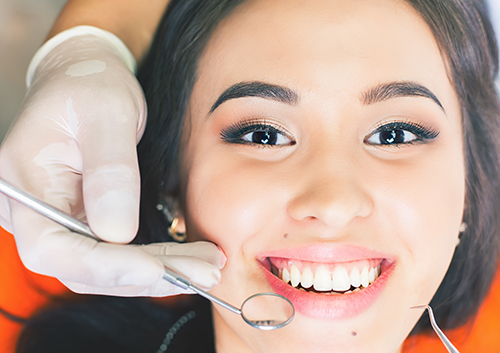
You’ve made an appointment at our Anthem office to treat your cavity, the decayed area has been removed, and the site has been cleaned and prepared for a filling. Now it’s decision time. What kind of filling should you choose? Well, that depends. There are durability, aesthetic, and price considerations involved in any of your choices, so let’s look at some options before you decide.
Gold
This is a classic choice for a reason. Gold is very durable and can last longer than fillings made from other materials. Because they are crafted from precious metal, gold fillings are more expensive than other alternatives. They are also most often indirect fillings—that is, they are not immediately placed in a tooth, but are formed based on a mold of your tooth taken on your first visit and set in position on a second visit. A gold filling is also noticeable, which can be a matter of concern or a style statement!
Metal Amalgam
An amalgam is a mixture, and an amalgam filling is usually composed of several metallic elements, including silver, tin, copper, and mercury. This filling is also very durable and is one of the most cost-effective choices. Its silver color does not blend into the tooth, so visibility is a factor. Amalgam fillings are considered a safe option, but, if you wonder about potential metal allergies or the amount and kind of mercury involved, we will be happy to discuss your concerns. One possible drawback to amalgam fillings is that sometimes more tooth structure needs to be removed to accommodate them, so this is also a subject we can discuss.
Composite Resins
These fillings are often selected because they are both durable and almost invisible when the color is matched to your tooth. Made of acrylic resin and powdered glass, a composite filling is what is called a “direct filling”—one that can be completed and bonded to the tooth in one visit. These are often more expensive than amalgam fillings, but might be preferable for cosmetic reasons, especially when a front tooth is involved. They also need less tooth structure removed to accommodate them and can be better bonded to small excavations than some other options. They can be prone to staining over time.
Ceramic
Ceramic fillings have the virtue of being virtually undetectable. They can be color-matched to your teeth for a seamless look, and are more stain-resistant than composite fillings. They are also a more expensive option, and, like gold fillings, can involve a two-phase process with a filling molded to fit the excavation site placed in your tooth on a second visit.
Drs. Peter Vogel, Vijal Vadecha and our team are happy to discuss all of your options before it is time to treat your cavity, since there are a number of factors which might impact your decision. A molar will require a more durable filling than a front tooth, while being less visible when you smile or speak. Insurance plans might pay for only a portion of a filling’s cost if it is more expensive than an amalgam, or will pay for a composite filling only if it is in a visible location. We can help you decide which filling best fits all your needs, providing you with the healthy and beautiful smile you deserve!
This April, Let’s Celebrate National Facial Protection Month!
April 6th, 2022

Poor April. While other months celebrate romance, or giving thanks, or costumes and candy, April has—April Fool’s Day and a tax deadline. We might be forgiven for thinking these two dates seem more like warnings than celebrations.
So here’s a new topic for the April calendar: National Facial Protection Month! Take the opportunity this month to review your safety practices while you’re enjoying your favorite activities.
- Mouthguards
If you have a mouthguard for sports or athletic activities, wear it! In any activity or sport where humans come into contact with solid objects (including other humans) tooth injury is possible. A mouthguard will help protect you from dental injuries caused by falls, physical contact, or other accidents that might happen in your active life. And it’s not just your teeth—mouthguards protect your lips, tongue, and jaw as well.
You can buy mouthguards in stock sizes or shape-to-fit options, or you can have a guard custom made especially for you at our Anthem office. Custom mouthguards fit perfectly and are designed to make breathing and speaking easy and comfortable. And if you wear braces or have fixed dental work such as a bridge, a custom mouthguard can protect your smile and your appliances. Talk to Drs. Peter Vogel, Vijal Vadecha about mouthguards for some great advice on how to protect your teeth and mouth.
As long as we’re discussing facial protection, let’s look at some other ways to keep safe as you keep active.
- Helmets
If there’s a helmet available for your sport, use it! Helmets are especially important for protecting athletes from brain injury and concussion, and they help protect the face and jaw as well.
- Face Guards
If you’ve experienced a puck speeding toward you, or a defensive tackle hurtling your way, or a fast ball coming in at 90 miles an hour, you know the importance of wearing a face guard. These guards can help protect your eyes, face, teeth, and jaws. Many sports now recommend using face guards—it’s worth checking to see if your sport is one of them.
- Eye Protection
And let’s not forget eye protection. Whether it’s safety glasses or a visor, protecting your eyes and the bones around them is extremely important. You can even get sports goggles or protective sports glasses with prescription lenses to keep you safe and seeing clearly.
We have the training and experience to help treat and restore injured teeth. But we will be the first to tell you, the very best treatment is prevention!
So here are a few suggestions for your calendar this month:
- If you haven’t gotten a mouthguard yet, now’s the time. Tooth and mouth injuries occur in sports beyond hockey and football. If you play basketball, ski, skateboard, ride a bike—in fact, almost any sport where you can fall or make contact with a person or object—a mouthguard is a must.
- If you need to replace an ill-fitting or damaged helmet and face guard, do it before your next game. And do replace a bike helmet if you’ve been in a crash—most likely it won’t be as protective, even if damage isn’t visible.
- Talk to your eye doctor about protective eyewear if off-the-rack products don’t work for you.
- If you are a parent or caregiver, make sure your child athlete has the proper facial protection—and uses it.
- If you are a coach, make sure your athletes have the right protective gear—and wear it.
- It’s also a great time to commit to using your protective gear every single time you’re active.
But, wait—these reminders are helpful and important, but weren’t we promised something to celebrate this April? Good catch! The great news is, using facial protection for sports and athletic activities gives you rewards you can celebrate all year: fewer injuries, fewer visits to the emergency room, and a beautiful, healthy, intact smile. Suit up!
What kind of toothbrush and toothpaste should my child use?
March 30th, 2022

Drs. Peter Vogel, Vijal Vadecha and our team know that as a parent, you want your child to be as healthy as possible. By now, you probably know that your son or daughter’s oral health plays a huge role in overall health.
When there are so many toothpaste ads and different styles of brush to choose from, it can be difficult to know which will serve your child the best. We recommend you break down the decision process to make it simpler.
First, your child’s age and stage of development are vital to consider. Until about the age or 12, your youngster may not be prepared to brush or floss adequately alone, due to dexterity issues. If that’s the case, it can be easier to use a battery-powered toothbrush to improve the quality of brushing.
Next is to select the right size of toothbrush head to fit your child’s mouth. As a general rule, the head of the toothbrush should be a little larger than the upper portion of the child’s thumb.
Flossers are great for children and easy to use. They have handles and a horseshoe shape on one end with floss in between. Your child can choose a color he or she likes as well as the handle size, shape, etc.
Not only are there many brands of toothpaste to choose from, there are also many different ingredients that offer varying benefits. Kids are at high risk for developing cavities so you want to make sure the following ingredients are in your child’s toothpaste if you wish to avoid problems later on.
Sodium fluoride is the standard ingredient for cavity prevention, while stannous fluoride is anti-bacterial and anti-cavity. Anti-sensitivity toothpastes often contain potassium nitrate, and triclosan can be found in one particular brand for anti-bacterial action.
Fluoride should not be ingested, so if your child can’t spit yet, use a toothpaste that contains xylitol. This is a natural sweetener and should be the first ingredient listed on the tube.
Now comes the fun part: choosing a flavor! Your little one may sample different flavors and select the one he or she likes the best. A youngster is more likely to adopt good brushing habits if the flavor is appealing.
Don’t hesitate to speak with Drs. Peter Vogel, Vijal Vadecha if you need to make an appointment at our Anthem office, or if you have any questions about toothpastes or toothbrushes.
The Science of Sugar
March 23rd, 2022

Some languages have many different words for love. Some have many different words for snow. One language even has different words for a tasty layered sandwich. Is that a hoagie or a hero you’re having? A sub? Grinder? Po’boy?
“Sugar,” though, is a single word which has taken on many meanings, from casual endearment to monosaccharide molecule. Today, we’re examining scientific definitions, with a short and sweet look at the science of sugar.
Chemistry
First, let’s get basic—all the way down to the molecular level.
Carbohydrates, fats, and proteins are the three essential macronutrients which keep our bodies running. Sugars are molecules made of carbon, hydrogen, and oxygen atoms, and all carbohydrates are made of these sugar molecules, from single unit structures to very complicated chains.
Sugars called monosaccharides are the most basic of the carbohydrates. “Monosaccharide” comes from the Greek words for “single” and “sugar,” and monosaccharides are the sugars we mean when we talk about “simple sugars.” Why are they simple? Because a monosaccharide is a single molecule which can’t be broken down into smaller carbohydrates.
While there are several types of monosaccharides, the three major simple sugars are:
- Fructose—the sugar we get from fruit.
- Galactose—the sugar found in milk.
- Glucose—the sugar our bodies use the most. It’s found in plants, and also produced when our bodies break down other carbs. Fun fact—this is the only sugar essential for brain cell function.
When two monosaccharide molecules join together, they form a disaccharide (not surprisingly, from the Greek for “two sugars”). Again, there are quite a few disaccharides, but we tend to concentrate on three in our diets:
- Lactose (glucose + galactose)—found only in milk and dairy products.
- Maltose (glucose + glucose)—the sugar chiefly produced by grains.
- Sucrose (glucose + fructose)—produced in plants. These plants include sugar cane and sugar beets, from which we get our refined table sugars.
The reason sugar molecules are so important is because of how our bodies use them.
Biology
Our bodies use the glucose in carbs for energy. As foods break down, first through digestion and then in the cells, the chemical bonds which hold glucose molecules together break as well. This action releases energy, and this energy fuels all our bodily functions.
But even though we need carbohydrates to keep our bodies going, and even though sugars are the easiest carbs to use for energy, there’s a reason no one recommends a diet filled with extra sugar.
Our bodies get all the sugar they need from the natural sugar in the foods we eat. Natural sugars are found in fruits, dairy products, even some vegetables and grains. Along with that sugar come vitamins, minerals, antioxidants, fiber, and/or protein.
Extra sugars added during baking or mixing or processing for flavor and sweetness provide none of these nutrients. These sugars are known as “added sugars,” and have more serious consequences than just empty calories.
Once we have the sugars we require, there’s no need for more. Extra sugars are stored in liver, muscle, and fat cells for later use. When we eat too much sugar, this carefully balanced system is upset, with negative effects for, among other things, weight, blood sugar, insulin levels—and our dental health.
Nutrition and Dental Health
You know that a sugar-filled diet often means a cavity-filled checkup. Why? Because it’s not just our bodies that break down sugar for fuel.
The oral bacteria in plaque also need sugars for food, which they use to make acids. An acidic environment in the mouth weakens and dissolves the minerals which keep tooth enamel strong. And these weak spots are vulnerable to decay. A steady diet of sugar-filled foods means that your enamel is constantly under acid attack.
Cutting down on added sugars is one of the easiest and best ways to cut down on added cavities. Reading recipes, checking out labels, learning to recognize added sugars—this is nutritional research which has sweet results.
How to recognize added sugars? Here’s where language gives us plenty of words to fill our linguistic sugar bowl. Whether the ingredients are called agave nectar, honey, molasses, syrups, treacle, or table sugar, they’re really just sugar. More specifically, they’re all sugars made up of glucose and fructose, with at best a trace amount of vitamins and minerals—and usually not even a trace!
To make our lives easier, labels on food packaging now let us know exactly how much of the sugar in any product is “added sugar.” You expect to find a high percentage of sugar on dessert labels, but you might be surprised to read how much sugar is added to foods like energy drinks, sports drinks, flavored yogurts, cereals, spaghetti sauce, and many more of the items in your grocery cart. Spend an extra minute examining the label, and save yourself many empty calories.
Monosaccharides, disaccharides, glucose, fructose, maltose, agave syrup, treacle, and on and on—so many words for so many kinds of sugar. When it comes to dental health, let Drs. Peter Vogel, Vijal Vadecha have the last word on sugar science. During your next visit to our Anthem office, talk to us about reducing unnecessary sugars in your diet for a future filled with the sweetest of healthy smiles.
Going Green for St. Patrick’s Day?
March 16th, 2022

Happily for all of us who like to celebrate with friends and family, there’s no need to be Irish to enjoy St. Patrick’s Day. Every March 17th, many of us take the opportunity to display a bit of Gaelic spirit.
- Green Clothing (it’s tradition!)
- Green Hat (for a jaunty look)
- Green Shamrock (always the perfect accessory)
- Green Hair (for the adventurous among us)
- Green Grins?
Here’s where we draw the line. Emerald Isle? Delightful! Emerald smile? Not so beguiling.
That traditional St. Patrick’s party fare—green-frosted sweet treats and green-colored pastries and green-foamed beers—is full of green-tinted food dyes, which can leave us with teeth in subtle shamrock shades. Luckily, most of us will have only a very temporary tinge to remind us of our dietary shenanigans, and there are simple ways to rid yourself of the green sheen:
- Indulge sparingly in colorful cuisine, and drink water afterwards to rinse away green-dyed foods and beverages.
- Use a straw for green drinks.
- Brush your teeth. (Not only will you brush away the green, but you’ll brush away the sugars from sweet green desserts and the acids from sour green brews.)
- Try a whitening toothpaste.
One special note: if you’ve just whitened your smile, best to eliminate strong food dyes from your diet for a few days. Teeth are more sensitive to staining after whitening, because the whitening process temporarily makes them more porous. Give yourself a few days, and your enamel will be back to (stain)fighting strength.
So, celebrate on the 17th and feel secure that on the 18th, your smile won’t be “wearing the green” any longer. But if you find that you’re not happy with the appearance of your smile anytime during the year, if you have more permanent staining caused by natural darkening over time, or workdays fueled by black coffee, or a diet filled with tomato sauce, dark berries, red wine, and other tasty (but discoloring) food, you’re still in luck.
Ask Drs. Peter Vogel, Vijal Vadecha about professional whitening procedures at our Anthem office for a brighter, more confident smile. And with a bright, confident smile, every day’s a reason to celebrate!
Are My Child’s Baby Teeth on Schedule?
March 9th, 2022

Your darling three-month old is crying and fussy—can she be teething already? Or, your happy baby boy has just celebrated his first birthday—with only one tooth in that beautiful, gummy smile. Is this normal? Probably! While baby teeth do typically erupt (come in) in the same order for all babies, and around the same time, there is still a lot of flexibility in the time it takes for a full, healthy smile to develop.
Baby teeth actually form before your baby is born, and those 20 teeth are there under the gums waiting to come out and shine. And even though there are no firm and fast dates for each of these primary teeth to erupt, it’s helpful to have a general overview of typical teething patterns so you know what to look forward to.
Incisors
These little teeth create a charming baby smile, and, if your finger has been in the wrong place at the wrong time, a very sharp one as well! That is because these tiny incisors are made to bite into foods. You might notice this when you introduce solid foods, even if the majority of your child’s “chewing” is done with her back gums. These teeth are the earliest to arrive.
- Six to ten months old: The lower central incisors (bottom front teeth) are often the first to come in.
- Eight to 12 months old: The upper incisors (8-12 months) are the next to show.
- Nine to 13 months old: The upper lateral incisors on each side of the front teeth arrive.
- Ten to 16 months old: The lower lateral incisors appear.
First Molars
Because these are larger teeth, babies often experience another bout of teething pain at this time. The large flat surface of each molar helps your child to chew and grind food, so he can handle a wider variety of foods and develop his chewing skills.
- 13 to 19 months old: You can generally expect to see the upper first molars arrive.
- 14 to 18 months old: The lower first molars appear.
Canines (Cuspids)
Fitting between the first molars and the incisors, the strong, pointed shape of the canine teeth allows your child to grip food and break it apart more easily.
- 16 to 22 months old: The upper two canines make their way into the space between the incisors and the first molars.
- 17 to 23 months old: The two lower canines appear.
Second Molars
By the age of three, most children have a full set of baby teeth.
- 23 to 31 months old: The second pair of bottom molars start erupting—you are in the home stretch!
- 25 to 33 months old: The upper second molars come in—completing that beautiful set of 20 teeth!
Baby teeth are extremely important, as Drs. Peter Vogel, Vijal Vadecha will tell you when you visit our Anthem office. They help your child eat and chew, develop face and jaw muscles, assist proper speech formation, and provide space for the adult teeth to come in properly. Now that your child’s smile is complete, keep providing him with the same care and attention you have been giving those little teeth since the arrival of the very first incisor.
It seems that so much of new parenthood is scheduling—when to feed her, when to put her to bed, how many hours between naps. But we soon find out that every baby is not on the same schedule, and the same is true for the arrival of their teeth. We should see your baby when that first tooth comes in, or by his or her first birthday. And if you ever have concerns at any time about your child’s teething schedule or teething delays, always feel free to give us a call.
How do I know if my gums are receding?
March 2nd, 2022

Gum recession, a common result of gum disease, occurs when the gum tissue that surrounds the teeth wears away or pulls back, forming pockets between the gumline and exposing more of the tooth. Gum recession occurs gradually, so you might not know that you have it. Left untreated, gum recession can result in tooth loss. In addition, there are several studies that suggest that gum disease is associated with modest increases in coronary heart disease. Here are five ways to know if your gums are receding.
1. Healthy gums are firm, light pink, and very elastic. If your gums don’t fit that description, then it’s time to visit our Anthem office. Red, swollen gums are a common symptom of gum disease, and may lead to gum recession.
2. Do your gums bleed easily when you brush or floss? If you have gum recession, even if you brush gently and with toothpaste specifically designed for sensitivity, it may still result in bleeding.
3. When you look in the mirror, do you see more of a tooth than you used to? This is one of the easiest ways to tell if you have gum recession. When gums recede, more of the tooth is visibly exposed. Look for lines or notches along the bottom of the teeth, as this typically indicates areas where the gums have receded.
4. One of the first signs of gum recession is tooth sensitivity. Does it hurt when you bite down or chew? The more gums recede, the more painful it is going to be. However, before you experience tooth sensitivity or pain, you may notice awkwardness when you bit down. When gum recession occurs, teeth can shift slightly, making it feel as if they are not properly aligned.
5. Loose teeth are a symptom of advanced gum recession and periodontal disease. In other words, the supporting bone structure of the teeth has already begun to deteriorate. If left untreated, it will result in tooth loss.
From deep cleaning (scaling) to gingival tissue grafting surgery, there are several ways to combat gum recession and periodontal disease. How gum recession is treated depends on how far advanced it is. Talk to Drs. Peter Vogel, Vijal Vadecha about what options are best for you.
Ease up on your gums — don’t brush your teeth too hard!
February 23rd, 2022
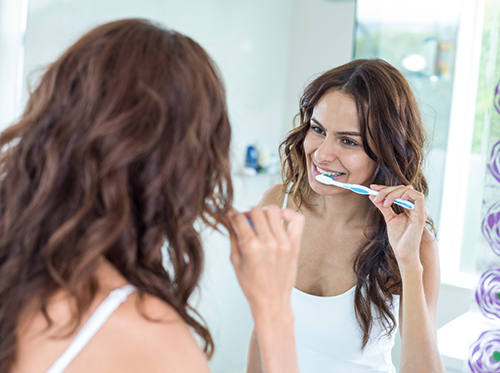
A lot of patients go at their teeth like they were sanding an old floor—that is to say, way too hard! Brushing too hard is probably the most common mistake patients make in their oral care routine, and it can be detrimental to the gums and teeth.
What can brushing too hard cause?
- Receding gums
- Bone loss around teeth
- Loss of teeth
- Tooth sensitivity, especially to hot and cold
- Worn down enamel
Brushing too hard wears away at your gums, which can lead to the neck of the teeth being exposed. This part of the tooth isn't covered by hard enamel like the rest of the tooth and hence the soft inner layer, or dentin, is exposed. Dentin is very sensitive to hot and cold and much more susceptible to bacterial decay. Once the gums recede due to improper brushing, it’s usually irreversible.
How to brush your teeth properly
You know you're supposed to brush your teeth twice a day, so why not do it right? First and foremost, you should only ever brush with a soft bristled brush—not medium or hard—unless directed otherwise by Drs. Peter Vogel, Vijal Vadecha. Unless you have braces or specific oral health issues, brushing twice a day for two minutes is usually plenty.
The main purpose of brushing is to remove plaque from your teeth and gums. Plaque is actually soft and is a buildup of bacteria, saliva, and food debris. You really don't need to brush hard to remove it, just make sure you aim your toothbrush at the gum line (where plaque grows) and brush in small circular motions, never a back-and-forth motion.
It's also wise to hold your toothbrush gently. People tend to brush harder the tighter they hold their toothbrush.
Still have questions about proper tooth brushing technique or gum health? Ask any staff member or Drs. Peter Vogel, Vijal Vadecha during your next visit to our Anthem office; we'd be happy to help!
What is a crown?
February 16th, 2022

If you have never had a crown before, you might be wondering why crown treatment is best, what the procedure involves, and which type of crown to choose. Let’s get down to the basics of crowns!
A crown is the best way to treat many dental conditions, either to strengthen and save the tooth or to improve its appearance. We might suggest a crown if you have any of the following conditions:
- A filling that needs to be replaced, without enough tooth structure left to fill properly
- A tooth that is fractured or broken, or so weak that it might fracture
- A recent root canal
- An implant
- A bridge which needs a crown to serve as the base for attachment
- A tooth that is discolored or irregularly shaped
On your first visit to our Anthem office, Drs. Peter Vogel, Vijal Vadecha will prepare the tooth that will be receiving a crown. A tooth might have to be built up if there isn’t enough of the original tooth left, or the top and sides of the tooth will be shaped down so that the crown fits smoothly and evenly with your other teeth. An impression will be made and sent to a dental lab so that a crown with the perfect fit for your tooth and mouth can be created. A temporary crown will be put in place to protect your tooth while the final crown is fabricated.
The permanent crown is a cap which covers your tooth. It can be made of various materials, which all offer different advantages:
- Metal Crowns—made of gold, platinum or base metal alloys, these are the longest lasting. Because of their metallic color, they are often chosen for back molars where they are less visible.
- Porcelain Over Metal—because the color of the porcelain is matched to your natural teeth, these crowns look very realistic. Porcelain is more fragile than metal, so there is the possibility that they won’t be as durable.
- Resin—less expensive than other options, but these crowns are more fragile and do not wear as well.
- All Porcelain/All Ceramic—the most realistic looking option, especially for front teeth, and also suitable for anyone with a metal allergy. They are, again, not as strong as metal crowns, and can be subject to damage.
- Stainless Steel—often used for baby teeth or as a temporary crown for adult teeth.
We’ll discuss your options and help you decide on the best type of crown for you. When the crown is finished at the dental lab, you will have one more visit where the crown will be secured in place. We will make sure your bite is comfortable and the color and appearance of the crown are satisfactory. We will also give you instructions for the next few days following the procedure, and can make adjustments if needed.
A crown is a perfect example of form and function working together: a crown maintains the beauty of your smile and preserves the health of your tooth. If you need a crown, we will be happy to talk to you about your best options for a strong, long-lasting, and natural smile.
The Transformation of Valentine's Day
February 9th, 2022
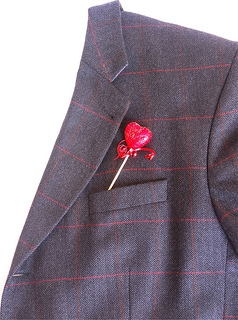
Did you know the actions leading to the beginnings of Valentine's Day were actually centered on the avoidance of war? A Catholic priest named Valentine defied the orders of the Emperor Claudius II and secretly married young men and their brides after the emperor had declared it illegal because only single, young men could be sent to war. Rather than lose potential soldiers to fight his war, Claudius attempted to hoard them by proclaiming marriage illegal.
Valentine continued to marry young couples anyway and, eventually, was put to death for it in 270 AD. Before his death, he sent a letter to a secret love and signed it “From your Valentine”. Nearly 1,800 years later, people are still signing letters and cards in this manner. This year, carry on the tradition started long ago, while adding your own twist. Here are a few suggestions.
Simple and Creative Valentine's Day Ideas
- Memorialize it with a Photo. Couples often have photos taken around Christmas, but Valentine's Day photos allow you to capitalize on romance. Famous couple Julia Child and her husband, Paul, had their picture taken together every Valentine's Day and included their sense of humor with silly props.
- Return to Your First Date Location. Even if your first date together was at a local hotdog stand, its sentimental value can make it a fun part of your Valentine's Day agenda. Be creative and make a treasure hunt with clues that lead your partner to the original date location, where you can express your love with flowers or a gift.
- “From Your Valentine” Messages. Deliver your message in a creative way to make this Valentine's Day stand out from the others. Bake your partner's favorite treat and write a message on it with a tube of icing, or draw a note on the steamed up mirror so it shows up when your partner takes a shower.
Although Valentine's Day is a day to celebrate love, it doesn't have to be a special day only for couples. If you're single, use this special day to shower yourself with love, because you're worth it! After all, the priest Valentine believed so strongly in the sanctity of love that he was willing to risk his life for it. Whether you're in a relationship or single, young or old, romantic or not, Valentine's Day is for you. Happy Valentine’s Day from the dental office of Drs. Peter Vogel, Vijal Vadecha.
Post-Procedure Care
February 2nd, 2022

As with any surgery, post-procedure care is of utmost importance after getting periodontal surgery. Bleeding, pain, swelling, and other sensations are common and should be expected to a degree. This can manifest as small amounts of blood in your saliva, pain after anesthesia wears off, and swelling around the lips and cheeks. However, these symptoms should start improving after a several days.
Below you'll find recommendations from Drs. Peter Vogel, Vijal Vadecha on what you should do to make your post-procedure experience as quick and painless as possible:
Don't smoke - After your surgery you should definitely not smoke. Smoking will inhibit your body's ability to heal the surgical site.
Don't drink alcohol - If you are taking prescription or over-the-counter pain relievers, don't drink alcohol. And it is a good idea in general to avoid alcohol after surgery, since excess alcohol consumption suppresses immune system function and slows the healing process.
Take pain medication as prescribed or an alternative - Pain is to be expected for at least the first week after your procedure. If you choose to take the prescription medication that is prescribed to you, do so as directed. However some patients have found over-the-counter pain medication works for them. You may also consider natural herbs instead of pharmacological solutions. Try turmeric, arnica, or white willow bark (which is what aspirin is derived from, so the same warnings for aspirin apply to white willow bark.)
Eating with your surgical site in mind - It is best to chew on the other side of your mouth for the first several days so as not to irritate the surgical site. Avoid overly cold or hot foods as well. Softer foods like mashed potatoes, oatmeal, and fruit will be more comfortable to chew.
Avoid brushing the surgical site - You can start brushing and flossing your teeth the day after the procedure but avoid the surgical site.
Don't rinse for the first 24 hours - After the first day has passed you can rinse with a mild mouthwash to keep your mouth, dressing, and surgical site clean.
We're here to answer any questions you have after your procedure and will help you as best we can. Pay special attention to any excessive bleeding or discomfort. Contact our Anthem office immediately if you have tried addressing the issue on your own but are still having trouble.
My child has autism. What should we expect at your office?
January 19th, 2022

At Daisy Mountain Dentistry, we know that as many as one in 88 children today have some form of autism, a complex brain disorder that affects a child's ability to communicate or form relationships, and makes a child appear distant, aloof, or detached from other people or surroundings. Autism varies widely in symptoms and severity, and some people have coexisting conditions such as intellectual disability or even epilepsy.
That is why Drs. Peter Vogel, Vijal Vadecha and our team are specially trained to provide dental care to the entire special needs community, including autistic children. We know that a visit to the dentist with an autistic child can be difficult. In addition to the common fears associated with strangers, there are also unfamiliar sounds, sensations, bright lights, and tastes with which your child may not be comfortable. We work with parents to make sure visiting the dentist is not so traumatic for our autistic patients.
Drs. Peter Vogel, Vijal Vadecha and our team also know that patients with autism may be more interested in equipment and instruments than in us. We show our patients every piece of equipment we are going to use in a way that they can understand. We also allow a patient to sit in a parent's lap in the open bay if he or she is not feeling at ease. We want your child to enjoy getting to know us and to be comfortable while under our care.
A pleasant, comfortable visit at our Anthem office builds trust and helps put your child at ease for future appointments. Before a visit, we ask parents or guardians to bring their child's favorite toy, comfort item, music, or other coping device their child requires. We have a caring and compassionate team and know how to help autistic children acclimate themselves to a dental environment. We may not get everything done at the first visit, but we are able to schedule several appointments so that your child can get used to our office, the dentist, instruments, and our staff.
Children, especially those afflicted with autism, are not born with a fear of the dentist, but they can fear the unknown. Our team at Daisy Mountain Dentistry genuinely cares for our patients beyond their teeth, and are more than happy to discuss any concerns you may have, as well as answer questions about your child's ongoing dental treatment. Please give us a call to learn more or schedule an appointment with Drs. Peter Vogel, Vijal Vadecha.
Common Emergency Care Visits: Toothaches and Abscesses
January 12th, 2022

You never know when a dental problem may arise. Unfortunately, they don’t necessarily occur during office hours. Drs. Peter Vogel, Vijal Vadecha can provide you with the proper information and treatment options to prevent the problem from becoming worse.
Abscess
An abscess is a bacterial infection, and will normally cause pain and swelling around the affected tooth and gum area. Though antibiotics are not always necessary, you should be seen by Drs. Peter Vogel, Vijal Vadecha as soon as possible. If left untreated, the infection may grow and cause more serious issues.
Toothache
Toothaches can have many causes. Sometimes it’s as simple as food lodged between your tooth and gums. Rinse your mouth with warm water and try flossing the area to dislodge the particle. If your gums begin to bleed, stop flossing.
Fractures or cavities can also cause toothaches as well as sensitivity to heat or cold. Please schedule an appointment to ensure a minor problem doesn’t develop into a serious one. You may require acetaminophen or another pain reliever before your visit.
If you can’t be treated right away, keep these tips in mind:
- If you have fractured a tooth, rinse the area with warm water to keep the surfaces clean. Apply a cold compress to the outside of your facial area to reduce swelling.
- A tooth that has been knocked out should be kept moist, in a clean container, until you can receive treatment.
- Do not apply aspirin directly to a damaged tooth or gum area, because this can cause tissue irritation.
- If you suspect your jaw has been broken, go to an emergency room immediately.
- If you have bitten or damaged your lips or tongue, rinse your mouth well with warm water. If bleeding continues, seek other medical attention right away.
If you experience an emergency, please contact our Anthem office and provide us with as much information as possible. This way, we can offer recommendations that will assist you until you’re able to arrive for an appointment.
Remember: procrastinating about getting treatment can turn a minor problem into a major one!
A Brighter Smile for the New Year
December 29th, 2021

The beginning of a new year is the perfect opportunity for a fresh start for you and your smile. At Daisy Mountain Dentistry, a brighter smile is quick and easy!
Given the latest in whitening technology, whiter teeth are only an appointment away. Teeth whitening is a safe, quick, and inexpensive way to create the dream smile you’ve always desired. We can offer a safe method that corrects tooth discolorations that may have been caused by staining, aging, or chemical effects.
So, start the new year off right and get a whiter smile today! Give us a call at our convenient Anthem office to schedule an appointment!
Is Coffee Damaging Your Smile?
December 22nd, 2021

Coffee is one of the most popular drinks in the world. Many people have a cup, or two, or even three a day. It’s common to drink it in the morning to wake up and get ready for the day, as an afternoon pick-me-up, or just to catch up with a coworker or friend.
These days there are many different kinds of coffee flavors to enjoy, so it’s almost impossible for a person not to like it. But as delicious as coffee is, it’s worthwhile to be aware of the effects it has on our dental health.
Coffee contains a lot of tannic acid, which is what causes its dark color. Tannic acid ingrains itself into the grooves of tooth enamel, and that leads to serious stains. In addition to containing tannic acid, the fact that coffee is generally served very hot makes your teeth expand and contract, which allows the stains to penetrate even farther into the enamel.
Drs. Peter Vogel, Vijal Vadecha and our team know it’s not easy to kick the caffeine habit. If you find yourself needing a cup of joe every day, here are some helpful tips to consider:
- Switch to decaf coffee.
- Make it a habit to drink a glass of water with your coffee to rinse away the acid.
- Try enjoying your coffee with a straw so the tannic acid makes less contact with your front and lower teeth.
- Pop in a piece of gum after your coffee to help prevent a dry mouth.
If you’re feeling ambitious, you might find that setting a limit on the number of cups of coffee you have per week or even per day can be helpful. You are always welcome to contact our Anthem office to discuss potential whitening options as well. We’re here to help!
How do I make my child’s diet safe for his or her teeth?
December 15th, 2021

The food you feed your child can have a lasting effect on his or her oral health. In fact, diet plays a major role in whether a child develops cavities and decay, which can lead to many dental visits and potential tooth loss. So what should you feed your child to ensure he or she has a healthy smile for life?
Foods to Avoid
It is normal for your child to take interest in many foods -- especially those filled with sugar and carbohydrates. But as tasty as these foods are, they can cause rapid decay when eaten in excess. That’s not to say your child can never have sugar again. Drs. Peter Vogel, Vijal Vadecha and our staff suggest limiting starchy and sugary foods such as candy and potato chips as much as possible.
Remember that some seemingly healthy foods can present the threat of decay too. Some of the most common culprits are sticky foods like peanut butter, raisins, and granola bars, which can stick to the teeth after eating. If you serve these foods to your child, be sure to have him or her brush immediately after eating to remove any lingering sugary residue.
Beverages
Many beverages marketed toward children contain sugar servings that far exceed the daily recommendations from national health organizations. They suggest no more than three to four teaspoons of added sugar per day for young children.
Make an effort to serve only water to your child any time other than meal times. During meals, allow your child to have milk or juice, but in limited serving sizes. Most importantly, never allow your young child to sleep with a bottle or “sippie cup” full of juice or milk. Doing so can cause rapid tooth decay: a condition known as “baby bottle caries.”
A Healthy and Balance Diet
So long as your child is brushing regularly and eating a healthy, balanced diet full of fruits, vegetables, lean proteins and whole grains, you should have little or no problem with tooth decay. For more questions about how your child’s diet affects his or her oral health, contact our Anthem office to schedule a consultation.
Post Oral Surgery: Signs of Infection
December 8th, 2021

Oral surgery can be intimidating, especially if you show any signs of an infection afterwards. Drs. Peter Vogel, Vijal Vadecha and our team want you to be informed about what to watch for after you’ve undergone surgery.
Oral surgery procedures are intended to reduce pain and prevent infection. Sometimes complications occur after your surgery, and if infection ensues, it will require swift medical attention.
People undergo oral surgery for many reasons, such as:
- Impacted or infected teeth
- Tooth loss, jaw problems
- Facial injuries or infections
- Birth defects
- Sleep apnea
Symptoms of Infection
- Pain that won’t go away with medication
- Steadily swelling of gums, jaw, or face
- Redness or oozing of pus from the area
- Fever that doesn't subside
- Difficulty opening the mouth or jaw
- Excessive bleeding for 24 hours
- Difficulty breathing or swallowing (emergency situation)
After the initial surgery, don’t become worried right away if you notice any of these symptoms. It’s normal to show some blood and swelling after surgery, but that should stop fairly soon with the help of gauze and medication.
You will most likely be numb from the procedure and we will advise you to avoid hard foods for the first day. Pain medication will be administered, and you should take it before you begin to notice pain. A cold compress can also help with swelling and initial pain.
You will be advised not to brush your teeth in the region where the surgery occurred. You may use a prescription mouth rinse, or you can gargle with warm salt water to reduce the swelling. If you follow these directions, you can speed the healing process for a quick recovery.
Don’t fret: a post-surgery infection is not a common development. It happens most often to people who have a compromised immune system or diabetes. Let Drs. Peter Vogel, Vijal Vadecha know beforehand if you have either of these and we may prescribe an antibiotic to help prevent the spread of infection in the areas of your mouth that get worked on.
If you think you may be experiencing complications after a surgery, please don’t hesitate to reach out to our Anthem office for advice.
Adults Can Get Cavities Too
December 1st, 2021

Sure, you brush your teeth and floss regularly, so you might think you’re off the hook when it comes to the dental chair. However, it’s just as important for adults to get regular dental exams as it is for kids. Cavities are common among adults, with 92% of people aged 18 to 64 having had cavities in their permanent teeth, according to the National Institute of Dental and Craniofacial Research.
How cavities form
Our mouths are teeming with hundreds of types of bacteria. Some are helpful and maintain good health, while others are harmful. Certain types of bacteria process the sugars in food and release acid in return. Although minor decay can be naturally reversed by your body, Drs. Peter Vogel, Vijal Vadecha and our team at Daisy Mountain Dentistry will tell you that eventually the acid wears away the enamel and creates small holes in the surface of teeth.
Cavity prevention for adults
Some people are naturally more prone to cavities than others. However, making a few lifestyle changes can dramatically reduce your likelihood of developing cavities.
- Food choices. Eating plenty of fresh fruits and vegetables increases saliva production, and reduces cavity risk. It is also important to avoid foods that get stuck in the ridges of your teeth. Candy, cookies, and chips should be eaten sparingly.
- Beverages. Most people know that drinking soda contributes to tooth decay. However, fruit juices and energy drinks also contain large amounts of sugar. Whenever possible, replace these sugary beverages with tea or water, which rinses your mouth and prevents decay.
- Fluoridated water. Fluoride is a naturally-occurring chemical that facilitates enamel growth. Most municipal water supplies are fortified with fluoride, so drinking tap water is a great way to keep teeth healthy. People with well water may use fluoridated toothpaste or other supplemental forms of fluoride to decrease cavity risk.
- Brush teeth and floss frequently. Gently brushing teeth several times a day removes the harmful bacteria that cause cavities to develop. If possible, brush your teeth after each meal or when drinking sugary beverages. Flossing regularly removes small particles that get trapped between teeth, which further decreases tooth decay.
One of the most important steps in cavity prevention is visiting your dentist at least twice a year. Consistent dental exams ensure that cavities are caught early, before they cause major damage to your teeth.
For more information about avoiding cavities, or to schedule an appointment with Drs. Peter Vogel, Vijal Vadecha, please give us a call at our convenient Anthem office!
Energy Drinks and Dental Health
November 24th, 2021

Are energy drinks bad for your teeth? Many of our patients at Daisy Mountain Dentistry ask us this question, so here’s the scoop.
Energy drinks have been on the rise, taking up more and more space on grocery store shelves. Drinks such as Red Bull, 5-Hour Energy, Monster Assault, Rockstar, and the like promise to jump-start your day, give you more energy, and help you feel more alert. But they also do a lot more than that. Turns out, they do a pretty good job of stripping your teeth of enamel, which is a very bad thing.
Many of these energy drinks are loaded with a lot of citric acid. In addition, they are laden with preservatives (not to mention sugar), not only to enhance flavor, but extend shelf life. While enamel loss, tooth decay, teeth sensitivity, and cavities cannot be blamed entirely on energy drinks (improper oral hygiene at home and lack of professional dental care also play a role), they can wreak havoc on the health of your teeth and gums, especially when consumed in more than moderation. Over time, energy drinks can strip enamel, which is the outer layer that protects your teeth.
What can you do?
Although Drs. Peter Vogel, Vijal Vadecha and our team aren't recommending you drink energy drinks at all, if you must drink one occasionally, there are a few things you can do to minimize the damage to your teeth.
- Drink through a straw.
- Don’t hold the drink in your mouth before swallowing.
- Rinse your mouth with water immediately after drinking this kind of beverage. Water helps both to neutralize the acid and to increase the production of saliva.
- Chew sugar-free gum immediately after, to increase saliva production.
- Don’t brush your teeth right after drinking an energy drink. Wait at least an hour instead, because the combination of the acid and brushing will further damage tooth enamel.
The best advice is to refrain from drinking energy drinks altogether. One of the best hydrators is water. Water is a natural energy-booster and hydrator, and it doesn’t contain calories.
Give us a call today at our Anthem office if you have any questions or concerns about energy drinks and dental health. We can provide additional tips and a treatment plan to help reduce enamel loss, eliminate tooth sensitivity, and repair cavities and tooth decay as a result of drinking energy drinks.
Four Tips for Soothing a Toothache
November 17th, 2021

Whether it’s a dull and throbbing ache or a sharp pain, toothaches can come in many different forms. Chances are you’ve had the discomforting experience once or twice in your life. It’s the type of experience that nobody wants to have, because a toothache can be as annoying as fingernails scratching a chalkboard.
What’s a good way to describe a toothache? Let’s see … your mouth feels as if it’s being besieged by one of those Loony Tunes-style jackhammers. As fate would have it, toothaches always seem to occur over the weekend or after-office hours, leaving you to suffer and forcing you to cancel your reservation at that high-end restaurant you’ve been anticipating all week.
Not so fast!
While you’re probably going to want to skip the rib-eye steak, there are numerous tried-and-true home remedies you can use to ease the pain until you can make an appointment with our office. Here’s a look at four ways to soothe a toothache.
- Don’t underestimate the power of salt water. Rinsing your mouth with warm salt water will both soothe your toothache and disinfect your mouth. However, make sure the water is warm; cold water can further exacerbate a sensitive tooth. Follow up the saltwater rinse by swishing your mouth with hydrogen peroxide.
- Clove oil, eucalyptus oil, peppermint oil, and vanilla extract are proven to be comforting elixirs. Dip a cotton swab in one of these mixtures and apply it to your tooth and gums. These substances, which you may even have in your kitchen cupboards, are known to have pain-relieving qualities. For the best results, repeat the application throughout the day.
- Eating yogurt is good for toothaches and mouth pain. Yogurt is filled with healthy bacteria that combat pain. Afterward, place a cold compress on your jaw.
- Try flossing. Your toothache might be throbbing and severe, but there’s always a chance the pain is caused by a piece of food awkwardly lodged in your teeth.
We hope that helps! Give Daisy Mountain Dentistry a call to learn more!
Dental X-rays: The Inside Story
November 10th, 2021

We’re all friends here, so if you sometimes feel a bit nervous before your dental appointment, no judging! Ask us about any worries you might have. We are happy to explain procedures, equipment, and sedation options so you know just how safe and comfortable your experience can be. And if X-rays are a concern, we can put your mind at ease here as well.
What Exactly Are X-rays?
Sometimes patients feel reluctant about the process of imaging because X-rays are a kind of radiation. But the fact is, radiation is all around us. We are exposed to radiation naturally from our soil and water, sun and air, as well as from modern inventions such as cell phones, Wi-Fi, and air travel.
Why is radiation so common? Because matter throughout the universe constantly gives off energy, and the energy that is emitted is termed radiation. This radiation takes two forms—as particles (which we don’t need to consider!) and as traveling rays. This second type is known as electromagnetic radiation, created by photons traveling in regular waves at the speed of light.
We are exposed to electromagnetic radiation every day, because, whether we can see them or not, these different wavelengths and frequencies create various forms of light. Radio waves, microwaves, infrared, visible, and ultraviolet light, X-rays, and gamma rays are all part of the electromagnetic light spectrum.
Different types of radiation on this spectrum have different wavelengths and different frequencies, and produce different amounts of energy. Longer wavelengths mean lower frequencies and less energy. Because X-rays have shorter wavelengths and higher frequencies than, for example, radio waves and visible light, they have more energy.
How Do Dental X-rays Work?
An X-ray machine produces a very narrow beam of X-ray photons. This beam passes through the body and captures images of our teeth and jaws on special film or digital sensors inside the mouth (intraoral X-rays), or on film or sensors located outside the mouth (extraoral X-rays). These X-ray images are also known as radiographs.
Why are X-rays able to take pictures inside our bodies? Remember that higher energy we talked about earlier? This energy enables X-rays to pass through the softer, less dense parts of our bodies, which are seen as gray background in a radiograph. But some substances in our bodies absorb X-rays, such as the calcium found in our bones and teeth. This is why they show up as sharp white images in radiographs.
There are different types of common dental X-rays which are used for a number of reasons:
- Bitewing X-rays, which are used to check on the health of the back teeth.
- Periapical X-rays, which allow us to look at one or two specific teeth from crown to root.
- Occlusal X-rays, which show the entire arch of teeth in the upper or lower jaw.
- Panoramic X-rays, which use a special machine to rotate around the head to create a complete two-dimensional picture of teeth and jaws.
- Cone Beam Computed Tomography, an external device which uses digital images to create a three-dimensional picture of the teeth and jaws.
Why Do We Need X-rays?
If all of our dental conditions were visible on the surface, there would be no need for X-rays. But there are many conditions that can only be discovered with the use of imaging—infection, decay, a decrease in bone density, or injuries, for example, can show up as darker areas in the teeth or jaws. Among their many diagnostic uses, X-rays can help us find:
- Cavities between teeth or under old fillings
- Damage to the tooth’s pulp which might require root canal treatment
- Injuries to teeth or roots after trauma
- Abscesses, tumors, or other conditions that might be causing swelling or pain
- Position and development of wisdom teeth
- Ideal placement for implants
- Health and density of the jaw and alveolar bone
X-rays can also serve an important preventative role, by discovering small problems before they become major ones.
How Do Dentists Make Sure Your X-rays Are As Safe As They Can Be?
First of all, the amount of radiation you are exposed to with a dental X-ray is very small. In fact, a set of bitewing X-rays exposes us to slightly less than the amount of radiation we are exposed to through our natural surroundings in just one day. Even so, Drs. Peter Vogel, Vijal Vadecha and our team are committed to making sure patients are exposed to as little radiation as possible.
Radiologists, the physicians who specialize in imaging procedures and diagnoses, recommend that all dentists and doctors follow the safety principal known as ALARA: “As Low As Reasonably Achievable.” This means using the lowest X-ray exposure necessary to achieve precise diagnostic results for all dental and medical patients.
The guidelines recommended for X-rays and other imaging have been designed to make sure all patients have the safest experience possible whenever they visit the dentist or the doctor. We ensure that imaging is safe and effective in a number of ways:
- We take X-rays only when they are necessary.
- We provide protective gear, such as apron shields and thyroid collars, whenever needed.
- We make use of modern X-ray equipment, for both traditional X-rays and digital X-rays, which exposes patients to a lower amount of radiation than ever before.
- When treating children, we set exposure times based on each child’s size and age.
And now that we’ve talked about some things you might like to know,
Please Let Us Know If . . .
- You’re a new patient, with previous X-rays taken during regular exams or for specific procedures. Ask to have your older X-rays sent to our office. With digital X-ray technology, this transfer can be accomplished with e-mail! Having your dental history available lets us notice any changes that have taken place.
- You’re pregnant, or think you might be pregnant. Even though radiation exposure is very low with dental radiographs, unless there is a dental emergency, dentists and doctors recommend against X-rays for pregnant patients.
X-rays play an important part in helping us make sure your teeth stay their healthiest. If you have any concerns, contact our Anthem office. When it comes to making sure you’re comfortable with all of our procedures, including any X-rays that might be necessary, we’re happy to give you all the inside information!
Halloween: Candy, costumes, and more!
October 27th, 2021

All Hallows' Eve, more commonly known as Halloween, is a yearly event celebrated on October 31, and one that is anticipated by the young and young at heart all over the world. Some scholars claim that Halloween originated from Celtic festivals that honored the dead or that celebrated the harvest, while others doubt that there's any connection at all to Samhain (a Gaelic harvest festival.) Regardless of its origin, our team at the dental office of Drs. Peter Vogel, Vijal Vadecha hopes that Halloween is fun and enjoyed by all of our awesome patients!
Trick or treat?
In North America, Halloween is predominantly celebrated by children who dress up in costumes, which range from scary to cute, who then go around the neighborhood knocking on doors asking "trick or treat", and they are given candy in return. Trick-or-treating is a time honored tradition, and though many parents groan at the pounds and pounds of candy collected by youngsters and fear for the health of their teeth, there are a few things you can do to help their teeth stay in great shape until the candy is gone:
- Limit the amount of candy they can consume each day
- Have them brush their teeth after eating candy
- Avoid hard, chewy candies as they can stick in hard to brush places
- Keep candy out of sight to reduce temptation
- Don't buy candy too far in advance to limit pre-Halloween consumption
- Help or encourage your children to floss
Halloween Fun
Halloween isn't just about gorging on candy; there are other events associated with this festive day including carving jack-o'-lanterns, painting pumpkins, decorating sugar cookies, bobbing for apples, going to haunted houses, or just curling up on the couch with a bowl full of popcorn and watching some classic, scary movies.
Halloween Around the World
Some countries, like Australia, frown upon Halloween, claiming it is an American event and not based in Australian culture, while others like Italy have embraced the fun and celebrate much as Canadians and Americans do. Mexicans have been celebrating this fun day since around 1960, and it marks the beginning of the Day of the Dead festival. Some countries in Europe have come late to the party, but since the 1990s, countries like Sweden, Norway, and Germany have started celebrating Halloween as well, and finding children in costumes or having ghosts hanging in windows has become commonplace.
Halloween is about fun; stepping outside our normal lives and donning a costume or gathering with friends to knock on doors and ask for candy is as much a part of our culture as hot dogs and barbecue on Labor Day. Have a safe and happy Halloween from the team at Daisy Mountain Dentistry!
What to do about Dry Mouth
October 20th, 2021

Xerostomia, commonly known as dry mouth, is a condition in which the salivary glands in the mouth don’t produce enough saliva. Saliva keeps the mouth moist and cleanses it of bacteria. A lack of it makes for an uncomfortably dry mouth that is also more susceptible to infection and disease.
Symptoms of dry mouth include:
- Dryness or a sticky feeling
- Frequent thirst
- Burning sensations or redness in the throat or on the tongue
- A sore throat or hoarseness
- Difficulty chewing, swallowing, or tasting food
Dry mouth usually comes about as a side effect of certain medications or medical conditions, but can also be caused by damage to the salivary glands because of injury or surgery.
If you're experiencing any of the symptoms of dry mouth, here are a few tips for what to do:
Double-check medications: If you are taking any prescription or over-the-counter medications, speak with Drs. Peter Vogel, Vijal Vadecha to see if any of these could be causing the dry mouth as a side effect.
There may be ways to alleviate the symptoms.
- Stay hydrated: Whether you have dry mouth or not, it’s essential to stay hydrated. Drink plenty of fresh and pure water throughout the day. A good rule of thumb is to drink eight eight-ounce glasses of water a day.
- Suck or chew on a natural, sugar-free candy or gum: Sucking on candy or chewing gum will keep your salivary glands producing saliva. Healthier versions of sugar-free candy and gum are available these days. Some are made with xylitol, a sugar alcohol that actually helps prevent tooth decay.
- Add moisture to your living spaces: Try adding a vaporizer to your bedroom or the rooms where you spend the most time. It’s best for your home to have a humidity level of between 40 to 50%. Anything less than 30% is too low. You can measure humidity with a hygrometer, which is easy to find at your local department store or online.
These are just a few general tips, but if you’re experiencing the symptoms of dry mouth often and it’s interfering with your life, pay a visit to our Anthem office. That way you’re more likely to get to the root of the problem.
My gums are shrinking!
October 13th, 2021
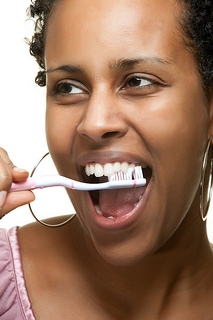
Have you ever looked in the mirror and noticed that your teeth looked longer? Does it seem like your gums are shrinking? This condition is called recession—many adults have it. Let’s look at some of the causes and what you can do about it.
During your exam at Daisy Mountain Dentistry, we will take measurements to check for periodontal disease. Dental professionals take recession measurements to see how much attached gingiva is present. This is the kind of tissue that is most resilient to infection.
The more recession, the less attached gingiva. The less attached gingiva, the less bone support. The less bone support, the higher your chances of tooth loss. It is quite a domino effect.
Don’t lose hope. The effect can be halted once you know the cause of your recession.
Do you ever wake up with your jaw clenched, and/or a headache that originates just above your ears? Clenching or grinding your teeth can cause recession. When there is added stress on a tooth, it flexes at the gum line.
Over time this causes microscopic breaks in the enamel and then a notch appears. The gum line is forced to move away from its original position. If this is something you see in your mouth, we can discuss the possibility of an occlusal guard at your next visit.
How do you brush your teeth? Do you brush in a straight line or circles? What kind of bristles do you use? Are the bristles on your toothbrush frayed?
When you brush in a circle, you are sweeping all along the gum line, removing the plaque from most angles. When you brush in a straight line, you may often miss the concave portion of the gums. This leaves plaque behind and leads to gingivitis. Whenever gingivitis occurs, the body attacks supporting structures like bone while trying to get rid of the infection. This is periodontal disease, which can cause recession.
Recession may also result from an irritant on the gums, such as a bar from a partial denture or orthodontic appliance (braces).
Gums do not “grow back.” The most common treatment for advanced recession is a tissue graft. There are many different kinds of tissue grafts.
Other factors can cause recession. If you think recession is happening in your mouth, schedule an appointment with Drs. Peter Vogel, Vijal Vadecha to discuss your options, so you can make the appropriate treatment choice.
Fall’s in the Air? Think Fall Dental Care
October 6th, 2021

Whether you already miss the sun’s bright rays, or can’t wait for some cool, crisp weather and colorful leaves, summer is making way for fall. And the change of seasons might mean it’s time for some adjustments to your dental care routine.
Fall’s in the Air, and You Can Feel It
You might enjoy the brisk weather and the cool autumn breezes, but you’d enjoy fall much more without the tooth sensitivity that cold weather can bring. Sensitivity can be the sign of a cracked tooth, gum disease, or even something as simple as too-energetic brushing. If you’re experiencing sensitivity outdoors or with hot and cold foods, don’t give up your nature walks and hot cider! Give Drs. Peter Vogel, Vijal Vadecha a call, and we’ll get to the root of your problem.
Fall Sports
The baseball mitts, surfboards, and water skis have been retired for the year, but that won’t stop you from enjoying exercise and team sports. And while you’re keeping your body healthy, remember to keep your teeth and jaws healthy as well. A mouth guard is an essential piece of equipment for any autumn contact sport like football or soccer, and is also a good idea for biking, skateboarding, and other physical activities where a fall or a collision is a possibility.
Fall Feasts
‘Tis the season for sugary Halloween treats, bountiful Thanksgiving desserts, and those over-the-top holiday lattes. By all means, celebrate the season. And celebrate your dental health (and your overall health) as well by enjoying these treats in moderation.
Why not take this opportunity to explore some of autumn’s more nutritious seasonal offerings? Brussels sprouts, sweet potatoes, carrots, pumpkins, and apples are part of a fall harvest of fruits and vegetables rich in vitamin A, vitamin C, potassium, calcium, and other nutrients that help keep our teeth and gums their healthiest. (And if the pumpkins and apples make their way into pies, no one will complain.)
Fall Semester
Many schools require a dental exam before the start of the academic year. If you haven’t made an appointment for your child, now’s the time to do it! And don’t forget a professional cleaning to remove plaque and tartar. Nothing starts a school year off better than entering the classroom with a bright, healthy smile.
And don’t forget to call our Anthem office for your own regular checkup if it’s that time of year. Spring, summer, winter, fall—it’s always the right season for taking care of your dental health!
How Missing Teeth Can Affect Your Health
September 29th, 2021

According to the American Academy of Periodontology, an estimated three out of four Americans suffer from gum disease. In milder cases, the disease is called gingivitis. More severe cases are called periodontitis. Despite the prevalence of periodontal disease (and it is very common), only three percent of people who suffer from periodontal disease get treatment for it. Gum disease has been linked to other serious diseases, including cancer, diabetes, and heart disease.
Periodontal Disease Is Common Among Americans
The Journal of Dental Research published the findings of a joint study from the Centers for Disease Control (CDC) and the American Academy of Periodontology (AAP). The study compared the full periodontal exam that participants received for this study against partial periodontal exams participants received for an older study.
The results show the rate of periodontal disease today could be as much as 50 percent higher than earlier estimated. Shockingly, this means that about twice as many Americans as previously believed suffer from gum disease – either moderate or severe.
The Link between Chronic Illness and Periodontal Disease
Many people who have chronic medical problems don’t have dental insurance, or the money to spend on dental care. Not surprisingly, this and a lack of understanding about proper oral hygiene leads to situations in which an initially minor problem turns into something far more severe, and probably preventable.
Gum diseases and cavities are caused by infections. When you get a cavity, the infection develops in the tooth itself. You may never feel anything, so unless you get regular, twice-a-year dental exams, you might not know there is a problem.
With gum disease, the infection occurs in the bones and tissues that form the gums and support the teeth. The tissues that surround teeth, and the bones that lie below the gums, are necessary to hold your teeth in. When those aren’t strong enough to support your teeth, you lose them.
Tooth loss has been linked to heart disease, diabetes, and an increased risk for kidney disease. Gum disease and severe infections in the mouth can spread to other parts of the body faster than people realize. A healthy mouth is alkaline. It’s vital for you to maintain an alkaline pH to keep harmful bacteria away.
When people eat, their pH changes, and the environment inside the mouth becomes more acidic. Since the typical American diet is very acidic, harmful bacteria thrive in the mouth. Typical foods include breads, grains, starches, and sweets – the foods people love the most. Since it isn’t always possible for people to brush after every meal, the mouth pH remains acidic, and the acid contributes to faster tooth erosion.
What does all this mean for you? The health of your mouth is more important than you realize. Get those regular dental exams, and make sure that you and your family keep to a regular routine of brushing and flossing. Good oral hygiene can help prevent periodontal disease, and that will lower your risk of tooth loss.
The Five Most Common Reasons for Emergency Visits
September 22nd, 2021

An emergency usually evokes panic, and for good reason. Emergencies don’t discriminate when it comes to time or place. They’ll happen during your vacation, at home, while you’re shopping for groceries, at the movies … whenever they can.
We’ve identified the five most common reasons for emergency visits to our office, so if you ever find yourself in one of these situations, don’t hesitate to reach out and schedule an appointment with us!
- Getting a piece of food stuck where it doesn’t belong. This might sound trivial, and even comical, but a piece of food stuck and left unattended can cause inflammation, pain, and a serious infection.
- Losing a filling. If this happens to you, it’s crucial that you receive care immediately. The purpose of a filling is to shut off a space where bacteria can enter. If that barrier is breached, your tooth becomes more vulnerable to decay.
- A chipped tooth. Even if the chip is small, it’s essential to get it repaired before it grows bigger. Unless chips are affecting a nerve, they are usually easy to repair with a crown, bonding, or veneers.
- A broken tooth. This can result from a small, hidden chip in the tooth. It’s clearly something to address quickly, because the pain will be much more severe than what you’ll feel with just a chip.
- Losing the entire tooth. This is the worst of the list. When you lose a tooth, you should not delay in seeking emergency care. Usually, you have a window of one to two hours during which the original tooth can be salvaged and successfully reattached.
Though any of these scenarios can be nerve-wracking, Drs. Peter Vogel, Vijal Vadecha and our team are here to assist you with any and all dental emergencies. Don’t wait; give our Anthem office a call!
What to Do If You Lose a Filling
September 15th, 2021

It really doesn’t happen very often. But sometimes you bite into something that is much harder than you anticipated. Sometimes you grind your teeth without realizing the pressure you’re putting on them. Sometimes you have a cavity that has stealthily developed beneath an earlier filling. And the result is—sometimes you lose a filling.
What to do when this happens? If you’re at a loss for ideas, we have some suggestions.
- Don’t panic
Usually, a cracked, broken, or lost filling is not an emergency situation. That being said, it’s still important to . . .
- Call us immediately
Drs. Peter Vogel, Vijal Vadecha will be able to give you the best advice as to how to take care of your tooth until you can make an appointment. And if your dental problem might be a dental emergency, we can make sure you are seen as soon as possible.
- Take care of your tooth
Keep your tooth and the area around it clean. Brush gently to keep food particles away from the newly exposed tooth surface. You can (carefully) rinse around the area with a bit of water or salt water as recommended.
Your lost filling might not inconvenience you at all. But if you feel sensitivity when the tooth is exposed to air, or when you eat hot or cold foods, or if you feel pain when you bite down, let us know. We can recommend some over the counter medications and pain relievers that can help.
If you’re experiencing severe pain, call us at once.
- Diet
This might not be the time for sticky caramels, frozen treats, or extra-hot beverages. Make yourself comfortable by avoiding chewing with your compromised tooth, and postponing foods that could trigger sensitivity.
- Make a dental appointment as soon as you can
Don’t put off treatment, even if the filling was a small one, and even if the tooth is causing you no discomfort.
There might be further damage or decay that should be treated. A tooth that required a large filling is often more fragile than an intact tooth, and might need to be fitted with a crown in order to protect it. A missing filling might reveal deep decay which has exposed the pulp of the tooth to infection or damage, and a root canal might be necessary. A seriously damaged tooth might require extraction. Delaying treatment could result in a more complex restoration.
See us as soon as you discover a problem with your filling, and we will make sure not only that your tooth is treated appropriately, but that the reason for the lost filling is discovered. While no filling lasts forever, if the cause of your lost filling is tooth grinding or decay, it’s important to be proactive to prevent further problems.
Losing a filling? It really doesn’t happen very often. But that’s not a lot of comfort if you do happen to lose or break a filling. If you’re at a loss for what to do next, contact our Anthem office. You’ll find yourself smiling again in no time!
The Truth about TMJ
September 8th, 2021

TMJ is the quick way of referring to your Temporomandibular Joint. Pardon the pun, but that’s quite a mouthful! What is this joint, what does it do, and, if your Drs. Peter Vogel, Vijal Vadecha and our team have told you that you have a TMJ disorder, what can we do to help?
The Temporomandibular Joint
Your two temporomandibular joints are amazing works of anatomical design. These are the joints where the temporal bone in the skull meets the mandible bone of the jaw, and allow our mouths to open and close, move back and forth, and slide from side to side. Muscle, bone, and cartilage work together to provide easy movement and to cushion the joint. But sometimes, the joint doesn’t work as smoothly as it should, and this can lead to Temporomandibular Joint Disorder, or TMD.
When Should You Suspect You Have TMD?
You might have TMD if you experience any of these symptoms:
- Painful chewing
- Pain around your TMJ, or in your face or neck
- Earaches
- Changes in your bite
- Jaws that are limited in movement or lock open or shut
- Clicking, popping or grating noises when you open and shut your jaw
There are many conditions linked to TMD. If you grind your teeth at night, have arthritis in the jaw, have suffered an injury or infection in the area, or have problems with your bite, for example, you might be more likely to have TMJ problems. If you suspect you have TMD, or suffer from any of the symptoms listed above for an extended period, give us a call.
Treating TMD
During your visit to our Anthem office, we will check your medical history, and examine your head and neck. We can take an X-ray or scan if needed for further examination of the joint. Because there is no real scientific agreement yet about the best way to treat TMJ disorders, a conservative treatment plan is often best. If you do show signs of TMD, we might first suggest relaxation techniques, over-the-counter pain relievers, or the use of ice packs or moist heat compresses. A change to a softer diet can help, and you should stop chewing gum and making any exaggerated jaw movements.
If these self-care practices aren’t effective, we might suggest a nightguard. This appliance is a comfortable and flexible mouthguard custom fitted for you, and will bring relief from teeth grinding when worn at night. If this treatment is not effective, talk to us about other options.
Luckily, most cases of TMD are temporary and don’t become worse over time. But any persistent discomfort is a good reason to visit us. Whether you have TMD, or any other problem causing you pain in the head or jaw, we want to help.
Celebrate Labor Day by Getting Away
September 1st, 2021

Labor Day honors the contributions that workers have made to this country, and for many Americans, the holiday is a great time to relax at home with family and friends. But there are quite a few people who celebrate the holiday by getting out of town, with an estimated 33 million people traveling more than 50 miles over Labor Day weekend each year. If you’re dreaming of a great Labor Day escape but you’re not quite sure where to go, here are a few ideas from our team at Daisy Mountain Dentistry to give you some travel inspiration.
Explore a National Park
On a national holiday like Labor Day, it’s only fitting to experience the beauty of America’s landscapes by heading to the nearest national park. If you’re confined to an office most days of the year, national parks can provide a relaxing and scenic escape, whether you’re by yourself, traveling with a group of friends, or bringing the whole family along. Depending on how close you live to the nearest park, you can stay for an afternoon or for longer than a week. With 58 parks located in 27 states, there are plenty of beautiful areas to choose from.
Chow Down in a BBQ Haven
Barbecuing is a popular Labor Day activity, but instead of sweating over your own grill or oven, try visiting one of the country’s BBQ capitals. U.S. News and World Report names Memphis as the top BBQ destination, with more than 80 BBQ restaurants in the city, most notably Corky’s BBQ and Central BBQ. Kansas City is also known for the sweet taste of its sauces, while central Texas is said to have perfected the technique of smoking tender and flavorful brisket.
Relax on the Beach
Many people think of Labor Day as the unofficial start of fall, which brings cooler temperatures, more rain, and for many people, an end to lazy days at the beach. End your beach days with a bang by taking a trip to one of the coasts or to a lakeside beach. For an added dose of festivity, find a city or town that celebrates the occasion with a fireworks display over the water.
Whether you’re looking to turn your getaway into a full week affair or you simply want to experience a quick escape, make the most of your holiday by changing your surrounding scenery. Happy Labor Day from the dental practice of Drs. Peter Vogel, Vijal Vadecha!
The Secret to Fresh Breath
August 25th, 2021

Bad breath: We’ve all dealt with it. You’ve been around people who have it and, like it or not, you have had it yourself. It can be embarrassing and uncomfortable, but how do you know if you have it? There is actually a simple test you can do to see if you have bad breath.
Wash your hands well, then put your finger in your mouth, way in the back. Scrape a little saliva from the back of your tongue, and then dab it on the back of your hand. Wait for one minute, then hold your hand to your nose and sniff. Is it fresh as a daisy? Or do you need to keep reading and learn how to freshen your breath?
How Bad Breath Starts
There are several ways that bad breath starts. Knowing the causes of bad breath is a solid start toward the cure.
- The bacteria in your mouth: Bacteria is always in your mouth. It covers your gums, hides between your teeth, and hangs out on your tongue. As it multiplies, it produces toxins that cause the foul odor in your mouth.
- Your bad habits: If you smoke cigarettes, a pipe, or cigars, or chew tobacco, you are not only harming your mouth and body, you are creating some really smelly breath.
- Your tonsils: If you still have your tonsils, they can be the cause of bad breath. They are pitted, so smelly substances can collect in the pits and lead to bad breath.
- Stomach issues: A stomach virus, ulcer, GERD, and other stomach issues could be the cause of your bad breath. A low-carb diet can put your body into a state of ketosis, which causes very bad breath.
- The foods you eat: Garlic, onion, and other pungent foods will linger with you … on your breath.
Tips for Busting Bad Breath
Achieving fresh breath isn’t difficult, but it does require a little work. Try these tips for fresher breath and a healthier mouth.
- Brush your teeth after every meal. You can also pick up a tongue scraper to use a couple of times a day to remove any lingering bacteria on your tongue.
- Floss once a day to remove food particles between your teeth as well as plaque. Your mouth will thank you.
- Gargle with special mouthwash to banish bad breath. The oxygen in it will kill the bacteria in your mouth that is causing your bad breath, and leave you fresh as a daisy!
- Drink water to avoid dry mouth, which is a common cause of bad breath.
- Ease your tummy troubles with antacids and other remedies. Ginger tea is a great tummy tamer.
- Chew gum that contains xylitol. Saliva keeps your mouth moist, and chewing gum makes you salivate. Bye bye, bad breath!
- Eat yogurt. It contains “good” bacteria that helps balance your gut and gives you a healthier mouth.
- Soothe your sinuses. Sinus infections can cause you to have bad breath. Actually, it is the post-nasal drip that causes the foul odor. Cure the infection and your breath will improve.
- Avoid all tobacco products (cigarettes, pipes, cigars, chewing tobacco, and snuff).
- Eat a healthy diet of fresh fruits and vegetables, lean meats, and whole grains.
And don't forget! Get regular dental checkups at Daisy Mountain Dentistry.
The Secret to Fresh Breath
August 25th, 2021

Bad breath: We’ve all dealt with it. You’ve been around people who have it and, like it or not, you have had it yourself. It can be embarrassing and uncomfortable, but how do you know if you have it? There is actually a simple test you can do to see if you have bad breath.
Wash your hands well, then put your finger in your mouth, way in the back. Scrape a little saliva from the back of your tongue, and then dab it on the back of your hand. Wait for one minute, then hold your hand to your nose and sniff. Is it fresh as a daisy? Or do you need to keep reading and learn how to freshen your breath?
How Bad Breath Starts
There are several ways that bad breath starts. Knowing the causes of bad breath is a solid start toward the cure.
- The bacteria in your mouth: Bacteria is always in your mouth. It covers your gums, hides between your teeth, and hangs out on your tongue. As it multiplies, it produces toxins that cause the foul odor in your mouth.
- Your bad habits: If you smoke cigarettes, a pipe, or cigars, or chew tobacco, you are not only harming your mouth and body, you are creating some really smelly breath.
- Your tonsils: If you still have your tonsils, they can be the cause of bad breath. They are pitted, so smelly substances can collect in the pits and lead to bad breath.
- Stomach issues: A stomach virus, ulcer, GERD, and other stomach issues could be the cause of your bad breath. A low-carb diet can put your body into a state of ketosis, which causes very bad breath.
- The foods you eat: Garlic, onion, and other pungent foods will linger with you … on your breath.
Tips for Busting Bad Breath
Achieving fresh breath isn’t difficult, but it does require a little work. Try these tips for fresher breath and a healthier mouth.
- Brush your teeth after every meal. You can also pick up a tongue scraper to use a couple of times a day to remove any lingering bacteria on your tongue.
- Floss once a day to remove food particles between your teeth as well as plaque. Your mouth will thank you.
- Gargle with special mouthwash to banish bad breath. The oxygen in it will kill the bacteria in your mouth that is causing your bad breath, and leave you fresh as a daisy!
- Drink water to avoid dry mouth, which is a common cause of bad breath.
- Ease your tummy troubles with antacids and other remedies. Ginger tea is a great tummy tamer.
- Chew gum that contains xylitol. Saliva keeps your mouth moist, and chewing gum makes you salivate. Bye bye, bad breath!
- Eat yogurt. It contains “good” bacteria that helps balance your gut and gives you a healthier mouth.
- Soothe your sinuses. Sinus infections can cause you to have bad breath. Actually, it is the post-nasal drip that causes the foul odor. Cure the infection and your breath will improve.
- Avoid all tobacco products (cigarettes, pipes, cigars, chewing tobacco, and snuff).
- Eat a healthy diet of fresh fruits and vegetables, lean meats, and whole grains.
And don't forget! Get regular dental checkups at Daisy Mountain Dentistry.
Should I use mouthwash?
August 18th, 2021

Mouthwashes are commonly used as a part of a daily oral care regimen. Not only do they freshen breath, but some are capable of improving dental health too. Using a mouthwash daily can rinse fine debris away and out of reach while brushing. It can also make the teeth and gums more resilient to decay and disease.
Types of Mouthwashes
There are several types of mouthwashes available today that Drs. Peter Vogel, Vijal Vadecha and our team at Daisy Mountain Dentistry want you to be aware of. Some do little more than freshen breath and are known as cosmetic mouthwashes. These are ideal for quickly eliminating odors that linger after eating, drinking, or taking medication. Using a cosmetic mouthwash does not offer any health benefits.
Other mouthwashes offer more comprehensive benefits; they can potentially prevent tooth decay and gum disease. Mouthwashes that contain antimicrobial agents work by preventing the buildup of plaque that can lead to gingivitis and decay of the tooth enamel. However, it should be noted that the use of a mouthwash is never a substitute for regular brushing and flossing.
In some cases, prescription mouthwashes are necessary to treat patients with gum disease or who have undergone periodontal surgery. These specialty mouthwashes are designed specifically for the treatment of gum disease and should not be used outside of their intended use. The majority of mouthwashes require no prescription.
Tips for Choosing a Mouthwash
The choice to use a mouthwash and which one to use is between you and your dentist, depending on your individual oral health needs. If you determine that a mouthwash is right for you, look for one that contains fluoride, if possible. Fluoride provides an added layer of protection for your teeth, and helps them become more resistant to decay. As always, if you have any questions or concerns when choosing a mouthwash, please give our team at Daisy Mountain Dentistry a call for assistance in selecting the rinse that is best for you. Or, we invite to ask us during your next visit to our Anthem office!
Water: It’s Not Just for Brushing!
August 11th, 2021

We turn on the tap and it comes rushing out. We walk down the hall at work or school and stop at the fountain without even thinking about it. It’s the one item on the menu we most likely won’t have to pay for. Let’s face it—we’re probably taking water for granted. So let’s take a moment and look at the many wonderful things that drinking water does for our teeth and dental health!
- Cleaning Our Mouths
We can’t always brush right after eating to get rid of food particles. Bacteria feed on the sugars and starches left behind, and produce acids that lead to tooth decay and gum disease. Drinking water with our meals washes away lots of this food residue and dilutes the amount of acid our teeth are exposed to.
- Protecting Our Teeth
Water helps with saliva production, and saliva distributes important minerals such as fluoride and calcium to our teeth. This process helps strengthen enamel that might have been eroded by acidic foods and bacteria and makes our enamel less vulnerable to cavities.
- Preventing Cavities and Dry Mouth
Fluoride is a mineral that strengthens the structure of our teeth. Because so much of our water is fluoridated, you can get this essential mineral with every glass. If you don’t have access to fluoridated water, or if you tend to drink only bottled water (which may or may not have fluoride), please talk to Drs. Peter Vogel, Vijal Vadecha about the best way to strengthen and your teeth and help prevent cavities.
Drinking the recommended amount of water per day also helps prevent dry mouth, a condition caused by decreased saliva production. Saliva not only helps remineralize our teeth, as mentioned above, but also works to wash away bacteria and acids that lead to cavities, gum disease, and bad breath. Luckily, we can help ourselves stay hydrated with most liquids, as well as fruits and vegetables that are rich in water content. But the easiest, most effective and often least expensive way to hydrate is with water.
Water just can’t be taken for granted. It’s a marvel of cleaning, protection, and prevention—and it’s calorie-free!
Dental Emergencies while Traveling
August 4th, 2021

You’ve planned your dream vacation. Your reservations are made. You’re packed and ready. You’ve even scheduled a dental checkup at our Anthem office to make sure you catch any potential problems, have finished any major work, and have an up-to-date chart.
But things don’t always go according to even the best of plans. So, what to do if you find you have a dental emergency while traveling? Drs. Peter Vogel, Vijal Vadecha and our team have some recommendations for problems that might arise.
- Toothache—Rinse your mouth with warm water and use dental floss to remove any food particles. Never put aspirin directly on a tooth or gum tissue. If the pain persists, call a dentist.
- Cracked or broken tooth—Immediately rinse with warm water to clean the area and apply cold compresses to the face to minimize swelling. Get in touch with a dentist.
- If you lose a tooth—Keep the tooth moist at all times. Put the tooth back in the socket without touching the root if possible. If that is not an option, place the tooth between the cheek and gums or in milk. See a dentist as soon as possible.
Know where to get help if you need it! If you are traveling in the United States, the American Dental Association offers Find-a-Dentist, a website that can locate a member dentist closest to you. If you are traveling to another country, there are steps you can take to prepare for an emergency.
- If you are out of the country and need to locate a dentist, your local embassy or consulate, your hotel concierge, or friends abroad can be a useful resource.
- Before you go, check your insurance to see if you are covered while traveling.
- If you have travel insurance, find out if it covers dental treatment and can provide information on qualified local dentists and translation help, if necessary.
- Good dental care is available in many areas internationally, but it is important to know what standards are present in the countries you plan to visit. The Organization for Safety and Asepsis Procedures offers a checklist for safe treatment in their “Traveler’s Guide to Safe Dental Care.”
If you have any questions, Drs. Peter Vogel, Vijal Vadecha and our team are happy to do all we can to answer them. While it’s unlikely that problems will arise, we are always available if you need to contact our Anthem office. Bon voyage, and we look forward to hearing about your trip!
Take Your Pick!
July 29th, 2021
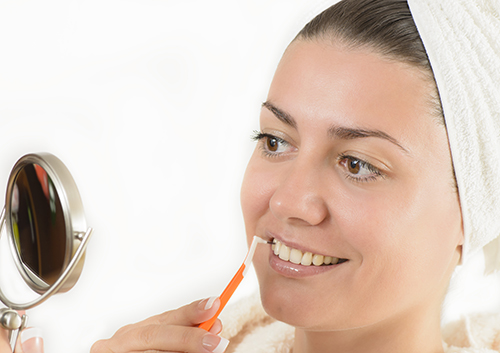
Before electric toothbrushes, before dental floss, before fluoride rinses, in fact, before recorded history, people who cared about their dental health had one primary tool—the toothpick. Ancient bronze toothpicks, bejeweled Renaissance picks, and the more humble modern wooden picks have been instrumental in promoting dental hygiene for centuries.
And, while that clean, simple design is still a good one, modern technology has found a way to build an even better toothpick. Today’s interdental picks not only dislodge food particles effectively, but now gum stimulation, cleaner orthodontic appliances, and fresher breath are available literally at our fingertips. Most important, these picks are just as effective as floss for removing plaque.
- Wood? Still Good!
Today’s softer wooden picks come in several shapes designed to fit comfortably and snugly between the teeth. Using a gentle in-and-out motion, you can clean between your teeth as you remove plaque from the tooth surface. But that’s not the only benefit! As you move the wide end of the pick up and down between teeth and gums, you are actually stimulating your gum tissue as well. They even come with mint flavoring to refresh your mouth as you clean. And, of course, wood and bamboo picks are biodegradable.
- Plastic? Fantastic!
If you’d like something a little more yielding than wooden dental picks, you have options. Soft dental picks are available that use rubber “bristles” on a plastic stem to gently ease their way between teeth. The heads are available in different diameters to accommodate tight or wide spacing between the teeth. Straight or curved stems provide the accessibility you need. If you have latex allergies, be sure to choose a rubber product that is latex-free.
- Interproximal Brushes? Here’s What the Buzz Is
You might have missed these miniature brushes in the dental care aisle, but they are worth looking for. Interproximal brushes have small cone-shaped heads with nylon bristles for cleaning food particles and plaque from between the teeth. They are good for more than one use, and some are available with angled or bendable handles for hard-to-reach spots. They come in different diameters, from wide to extremely fine, to suit the spacing of your teeth. Interdental brushes are especially useful for braces wearers, who can use these clever tools to clean tight, tricky areas under wires and around brackets.
Even though bronze, bejeweled, or golden toothpicks aren’t available in the dental aisle of the local drugstore, increased efficiency and function are well worth the trade-off. If for any reason you have trouble flossing, or if you like the idea of massaging your gums as you clean your teeth, or if you wear braces, or if you want a burst of mint flavor—for any number of reasons today’s dental picks are worth a try. Talk to Drs. Peter Vogel, Vijal Vadecha at your next visit to our Anthem office, and we’ll be happy to give you some recommendations.
Camping Oral Health Tips
July 22nd, 2021

If your idea of camping is a quiet walk through the woods before returning to your rustic hotel, your regular brushing habits will be perfect for your trip. But if you are hiking into the mountains with your tent, backpack, and camp food, Drs. Peter Vogel, Vijal Vadecha and our team have some suggestions to adapt your dental routine to the great outdoors.
Water
If you wouldn’t drink it, don’t brush with it! Use bottled water if you have brought it, or make sure the local water is safe by using a testing kit. Boiling, filters and purification tablets are all ways to make sure the water tests clean and safe.
Toothpaste
You aren’t the only one in the woods who finds your toothpaste tasty. Bears, raccoons, and other animals are attracted to the scent of your toothpaste, so keep it safe with the same kind of tightly sealed, odor-proof container that you keep your food in. And if you want to discourage unwanted visitors, don’t spit your toothpaste out at your campground! It’s better to go some distance from your site and bury any paste, and best of all to spit used toothpaste into a container that can be tightly closed and removed from the campsite when you head for home. This practice protects you and the environment as well, since toothpaste can be harmful to small animals and plants.
Toothbrush
While there are disposable and camping toothbrushes available, a regular toothbrush will work as well. Normally, air-drying is the healthiest option for drying your toothbrush, but camping is an exception. Just as animals are attracted to toothpaste, they are also attracted to your toothpaste-scented toothbrush. Keep it in a sealed container that is odor-proof.
Floss
There are websites devoted to the many ingenious ways to use dental floss while camping, but we recommend the original use. Don’t forget to floss regularly, keep it in a sealed container, and do be sure to take used floss out of the area with you.
Even though you are roughing it, stick with your home routine as much as possible. If you are unable to brush as usual, rinse your mouth well with clean water and brush when you can. Have a great trip, and just one more thought—maybe go easy on the s’mores. Let us know all about your trip during your next visit to our Anthem office!
What is hand-foot-and-mouth disease?
July 14th, 2021

Hand-foot-and-mouth disease, or HFMD, is a type of contagious viral illness that causes a rash in the mouth and on the hands and feet of infants and young children, and, while rare, adults. Characterized by sores in the mouth and a rash on the hands and feet, hand-foot-and-mouth disease is most commonly caused by a coxsackievirus, a bacterium that lives in the human digestive tract. HFMD can spread from person to person, typically via unwashed hands.
What are the symptoms of HFMD?
Symptoms of HFMD usually begin with a fever, sore throat, poor appetite, or general malaise. A couple of days after the fever starts, kids may develop painful sores in the mouth. A skin rash characterized by red spots may also develop, usually on the palms of your child’s hands and soles of their feet. It’s important to note some children may only experience a rash while others may only have mouth sores.
Is HFMD serious? Should we be concerned?
Usually not. Nearly all children infected recover anywhere between seven to ten days without medical treatment. Rarely, however, a child can develop viral meningitis and may need to be hospitalized. Other rare complications of HFMD can include encephalitis (brain inflammation), which can be fatal.
How can my child prevent HFMD?
There is no known vaccine to defend your child against HFMD. However, the risk of your child contracting the disease can be reduced by:
- Making sure your child washes his or her hands often
- Thoroughly cleaning objects and surfaces (these include doorknobs and toys)
- Making sure your child avoids close contact with those who are infected
To learn more about hand-foot-and-mouth disease or to schedule an appointment for your child, please give us a call at our Anthem office!
Summer Sports and Mouthguards
July 7th, 2021

School’s out and you’ve emptied your gym locker until next fall. But while you’re stowing away the football gear, the basketball warm-ups, the field hockey sticks, and all the other equipment you’ve collected over the school year (that’s where that other shoe went!), be sure to keep one item handy: your mouthguard.
Team and contact sports like football, basketball, and wrestling aren’t the only potential dental dangers. In fact, almost any sport or activity can be made safer when you use your mouthguard. While you’re keeping active and fit in the summer months, remember to look out for your smile.
- Sports on wheels
Biking, skate boarding, rollerblading—it only takes one fall to make you realize that roads, sidewalks, and concrete are not ideal landing pads. If you do take a spill, using a mouthguard, along with your helmet, will help protect your teeth and jaw.
- Court sports
Handball and tennis are not what we consider contact sports, but an unexpected bounce from a ball, or a completely unexpected backhand from your partner, can lead to dental injuries. Ace your workout and wear a mouthguard.
- Water sports
A fall in the water can lead to a collision with your surfboard or water skis, and water polo often seems to be a game of stamina, accuracy and elbows. Wear your mouthguard on land and sea, and help reduce your chance of dental injury.
- Team sports
Anyone who has played summer league baseball, softball or soccer knows that occasional contact with other players is pretty much a given. Cushioning your head, mouth, and teeth with a mouthguard will not only protect you, but keep you in the game—and your teammates will appreciate that!
If you already use a mouthguard, keep up the good work! If you don’t, talk to Drs. Peter Vogel, Vijal Vadecha about the importance of protecting your smile with a mouthguard. There are ready-made options available at drug stores and sporting goods shops. These will provide protection to your mouth and teeth, but can sometimes be bulky and uncomfortable and should never be used with braces. If you would like a mouth protector that provides the best fit and comfort, or if you wear braces, we can customize a mouthguard in our Anthem office that will be a perfect fit for your teeth and bite.
Whatever activity you choose, play it smart! Don’t gear up without your mouthguard, and you’ll greet next year’s classes energized, fit, and sporting a beautiful smile!
Fun Facts for the Fourth
July 1st, 2021

The Fourth of July is a great time to get together with friends and family members for BBQ, games, fireworks, and other celebrations in honor of our country’s independence. While your fellow revelers eat hot dogs and wave flags, you can impress them by sharing these fascinating facts and historical tidbits about some of our country’s traditions and symbols from the team at Daisy Mountain Dentistry.
The Statue of Liberty
With a torch in one hand and a tablet in the other, the Statue of Liberty is one of the most iconic and recognizable symbols of our country. However, as recognizable as certain parts of the statue are, not many people know that broken shackles, which represent oppression and tyranny, are lying at Lady Liberty’s feet. According to the Statue of Liberty-Ellis Island Foundation, the copper-plated lady weighs in at a whopping 450,000 tons and has been holding her torch up for more than 125 years, which must make for some impressive arm muscles.
Nathan’s Hot Dog Eating Contest
Since 1916, people have been flocking to Coney Island on the Fourth of July to witness what some people call the “superbowl of competitive eating.” Nathan’s Hot Dog Eating contest challenges competitors to devour as many hot dogs as they can in just ten minutes, with the current record holder swallowing a whopping 68 hot dogs! If you’d like to witness this bizarre and frenzied eating competition but you won’t be anywhere near Coney Island on the fourth, don’t worry. ESPN has been broadcasting this popular event for several years, so you can watch from the comfort of your couch while you eat a reasonably portioned meal.
The History Behind Fireworks
Viewing the nighttime fireworks display is exciting way to finish off the fourth. Many people know that these brilliant displays probably originated with the Chinese. However, many historians also believe that fireworks were stumbled upon when the Chinese roasted bamboo sticks over fires and watched them explode. After many years of roasting the sticks, a group of alchemists created an early form of gunpowder, which they stuffed into the bamboo sticks to create an even more powerful explosion, paving the way for the today’s modern fireworks.
Whether you’re planning on visiting the Statue of Liberty, watching fireworks in Anthem, or even participating in a hot dog eating contest, Drs. Peter Vogel, Vijal Vadecha and our team hope you have a safe and fun-filled holiday. Happy Fourth of July!
Top Five Things to Keep Your Dentist Smiling
June 23rd, 2021

Come say hello twice a year. The American Dental Association says two times is the charm. Multiple visits a year lets us keep an eye out for any developing issues. It’s important to remember that this goes for the whole family. Children over one year old should be seeing Drs. Peter Vogel, Vijal Vadecha!
Stay fresh. At Daisy Mountain Dentistry, we have a virtually unlimited stock of toothbrushes and floss, which means you have no excuse to be using a sad, ineffective toothbrush. As soon as bristles begin to fray, pick up a new one or stop by our Anthem office and we’ll replace yours. On average, you should be opening a new one every two to three months.
For goodness sake, floss! Flossing is an efficient way to keep your whole mouth healthy. It not only protects your teeth by removing aggregated plaque, it keeps your gums happy, too.
And brush. Practicing regular healthy habits is essential to keeping your mouth—and us—happy! When it comes to brushing that means two minutes, two times a day. If your kids need some encouragement, try making a calendar or playing a song like this.
Tell a friend. One way you can help us is by spreading the love. Tell your friends about what a good thing we’ve got going here. The more the merrier. And the healthier.
The Effects of Biting Your Nails
June 16th, 2021

Also known as onchophagia, the habit of nail biting is one of the so-called “nervous habits” that can be triggered by stress, excitement, or boredom. Approximately half of all kids between the ages of ten and 18 have been nail biters at one time or another. Experts say that about 30 percent of children and 15 percent of adults are nail biters, however most people stop chewing their nails by the time they turn 30.
Here are four dental and general reasons to stop biting your nails:
1. It’s unsanitary: Your nails harbor bacteria and germs, and are almost twice as dirty as fingers. What’s more, swallowing dirty nails can lead to stomach problems.
2. It wears down your teeth: Gnawing your nails can put added stress on your pearly whites, which can lead to crooked teeth.
3. It can delay your orthodontic treatment: For those of our patients wearing braces, nail biting puts additional pressure on teeth and weakens roots.
4. It can cost you, literally: It has been estimated that up to $4,000 in extra dental bills can build up over a lifetime.
Drs. Peter Vogel, Vijal Vadecha and our team recommend the following to kick your nail biting habit:
- Keep your nails trimmed short; you’ll have less of a nail to bite.
- Coat your nails with a bitter-tasting nail polish.
- Ask us about obtaining a mouthguard, which can help prevent nail biting.
- Put a rubber band around your wrist and snap it whenever you get the urge to gnaw on your nails.
- Think about when and why you chew your nails. Whether you are nervous or just bored, understanding the triggers can help you find a solution and stop the habit.
- If you can’t stop, behavioral therapy may be an effective option to stop nail biting. Ask Drs. Peter Vogel, Vijal Vadecha and our team for a recommendation.
How do I know if I’m at risk for oral cancer?
June 9th, 2021

Every year, over 50,000 North Americans are diagnosed with oral or throat cancer, which has a higher death rate than many other common cancers, including cervical cancer, testicular cancer, Hodgkin’s lymphoma, and thyroid or skin cancers. The high death rate results from the fact that most oral cancers go undiagnosed until the disease is well advanced and has spread to another part of the body, most often, the lymph nodes in the neck.
Because oral cancer is typically painless in its early stages and often goes undetected until it spreads, many patients aren’t diagnosed until they are already suffering from chronic pain or loss of function. However, if detected early, Drs. Peter Vogel, Vijal Vadecha and our team at Daisy Mountain Dentistry want you to know that early detection of oral cancer improves the survival rate to 80 percent or more.
If you visit our Anthem office regularly, you have probably received an oral cancer screening and didn’t even realize it. That’s because the exam is quick and painless; Drs. Peter Vogel, Vijal Vadecha and our team check your neck and mouth for signs of oral cancer such as discolorations, lumps, or any changes to your tissue. Oral cancer is typically found on the tongue, lips, gums, the floor of the mouth, or tissues in back of the tongue.
Factors that may influence your risk for developing oral cancer include:
- Use of tobacco products. Smoking cigarettes, cigars, a pipe, or chewing tobacco all elevate risk for developing oral cancer. Tobacco use especially is a serious risk factor because it contains substances called carcinogens, which are harmful to cells in your mouth.
- Excessive consumption of alcohol. Those who drink alcohol regularly have an elevated risk of getting oral cancer. Alcohol abuse (more than 21 drinks in one week) is the second largest risk factor for the development of oral cancer, according to the Oral Cancer Foundation.
- Excessive sun exposure. Those who spend lots of time outdoors and do not use proper amounts of sunscreen or lip balm have a greater risk for developing lip cancer. Exposure to ultraviolet (UV) radiation from sunlight may also cause melanoma, the most serious type of skin cancer.
- Your age. Oral cancer is typically a disease that affects older people, usually because of their longer exposure to other risk factors. Most patients diagnosed with oral cancer are over the age of 40.
- Your gender. Oral cancer strikes men twice as often as it does women.
- A history with viral infections, such as human papillomavirus (HPV).
- A diet low in fruits and vegetables.
In between your visits to our office, it is critical for you to be aware of the following signs and symptoms, and give us a call if these symptoms don’t go away after two weeks.
- A sore or irritation that doesn’t disappear
- Red or white patches
- Pain, tenderness, or numbness in mouth or lips
- Difficulty chewing, swallowing, speaking, or moving your jaw or tongue
- A change in the way your teeth fit together when you close your mouth
During your next visit, Drs. Peter Vogel, Vijal Vadecha will examine your mouth for signs of oral cancer. If you have been putting off a visit to our Anthem office for your regular checkup, now is an excellent time to schedule one. Regular visits can be the first line of defense against oral cancer because we can identify early warning signs of the disease. Give us a call today!
June is National Smile Month: Show off your smile!
June 2nd, 2021

The community health awareness group Oral Health America has reported that 82 percent of adults are unaware of the role that infectious bacteria can play in tooth decay or cavities, and almost three out of five children aged 12 to 19 have tooth decay. Since June is National Smile Month, Drs. Peter Vogel, Vijal Vadecha and our team at Daisy Mountain Dentistry thought we’d remind our patients about the importance of good oral hygiene visits between office visits.
To keep your family’s smiles healthy and beautiful for years to come, be sure to:
- Brush at least twice a day with fluoride toothpaste
- Floss every day to clean between your teeth
- Eat a healthy, well-balanced diet
- Reduce your intake of sugary foods and drinks
- Visit Drs. Peter Vogel, Vijal Vadecha for scheduled appointments
If you want to know more about healthy home care habits, feel free to ask our team at your next appointment, or ask us on Facebook!
Memorial Day: Parades, remembrance, and the unofficial start of summer!
May 26th, 2021

“The purpose of all war is peace.” - Saint Augustine
Fire truck sirens, baton twirlers, marching bands covering patriotic tunes, colorful floats, costumes, and millions of red, white, and blue American flags being waved in the air on a beautiful day in late May, that is what Memorial Day is all about. It is a federal holiday celebrated with town parades, remembrance, and a sense of unity and community togetherness.
Our team at Daisy Mountain Dentistry wants to take this time to wish you and your family a happy Memorial Day, as well as pause for a moment to reflect on what this holiday means and how it has changed over time. No, this is not a history lesson, but just a couple of thoughts and observances for you to take with you on your way to the next barbecue.
On the last Monday in May, America observes Memorial Day as a time to remember and celebrate the men and women who have lost their lives while serving our country in the Armed Forces. The holiday originated after the Civil War; at that time it was known as Decoration Day. While holidays like Thanksgiving, Christmas, and Easter remain the same from year to year, Memorial Day has changed over time, and in the 21st century we observe a far different holiday than what Americans did after the Civil War, or even the World Wars.
While many people place flags at cemeteries and visit national memorials in order to honor those who have passed away serving the country, Memorial Day is also a time for family barbecues, pool parties, trips to the beach, blockbuster movies, long weekend getaways, and fireworks. In America, Memorial Day has come to represent the unofficial start of the summer – a long, sunny, warm weekend devoted to family togetherness, outdoor events, and community.
It is time to load up the potato salad and the apple pie and head over to the neighbor’s house for their annual barbecue. And yes, contrary to popular belief, we do eat sweets, especially homemade apple pie! Everything in moderation, of course.
So whether you’re in the Anthem area or beyond, Happy Memorial Day to you and yours from Drs. Peter Vogel, Vijal Vadecha!
Is there a correlation between my dental and cardiovascular health?
May 19th, 2021
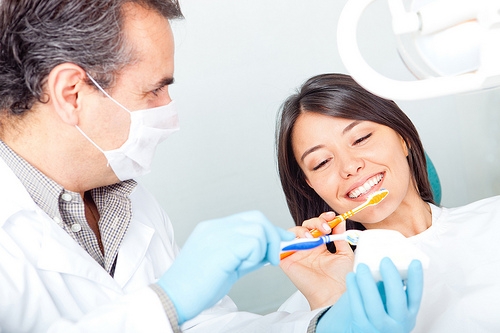
YES! Studies have shown a correlation between gum disease and heart disease, underscoring the importance of good oral health care. Cardiovascular disease remains American’s leading killer, claiming more lives than the rest of major causes of death, according to our friends at the American Heart Association. In fact, an estimated 80 percent of American adults currently have some form of gum disease, also known as periodontal disease.
Studies suggest that people with gum disease are believed to have an elevated risk of heart attack and stroke. Since most patients are not regularly visiting a heart specialist, their regular visits to our Anthem office can help detect early warning signs of heart issues, prevent gum disease, or at the very least catch it at its early stage. We’d also like you to know your numbers: blood pressure (less than 120/80), cholesterol (less than 200) and BMI (less than 25).
There are many benefits to visiting Daisy Mountain Dentistry in addition to maintaining your dental health. If it has been a while since your last visit, please give us a call!
Is periodontal disease contagious?
May 12th, 2021

According to the Centers for Disease Control and Prevention, half of adults age 30 and over suffer from some form of gum disease. Caused by plaque buildup, gum disease is an infection of the tissue that surrounds and supports the teeth. In its advanced stages, it is known as periodontal disease. If left untreated, it can result in the loss of tissue and bone that support the teeth, causing teeth loss. It’s a preventable condition seen far too often by Drs. Peter Vogel, Vijal Vadecha.
Research between periodontal disease and other diseases is ongoing. Some studies have indicated that gum disease is linked to other health conditions such as stroke or diabetes. Furthermore, while most factors that lead to periodontal disease are dependent on the individual (genetics, diet, poor oral hygiene) there is a possibility that periodontitis is capable of spreading from one person to another.
What the Research Says
Periodontitis is a gum infection, and the bacteria that cause the gums to become infected travels in saliva. Researches have used DNA coding techniques to track the path of infection from one person to another. In other words, kissing and close contact play a role in the transmission of the infection, so if you’re married to a spouse with periodontal disease, then your chances of having gum problems are slightly increased. Other studies have indicated that saliva contact is common in family settings through coughing, sneezing, and shared utensils and food. Children with parents who have periodontal disease are at a somewhat higher risk of developing it. At the same time, just because you exchange bacteria with your loved ones doesn’t mean you will get periodontal disease.
It is important to note that the scientific evidence supporting the spread of periodontal disease is limited and ongoing. The best way to prevent gum disease is through proper plaque control, which includes brushing, flossing, mouthwash, and twice a year trips for professional cleanings. Contact our Anthem office if you have any questions about periodontal disease.
Is there a connection between oral health and school performance?
May 5th, 2021

As a parent, you want the best for your children, and that includes doing their best in school. You can support them by taking an interest in their activities, being enthusiastic about attendance, and helping them with homework. There may also be one more way you can help your children succeed at school. Surprisingly, research suggests that children with better oral health are likely to do better in school.
What the Research Says
One study in North Carolina looked at risk factors for poor school performance among school-aged children. As expected, the study found poor school performance linked to low socioeconomic status, low levels of parental education, and poor overall health. However, it also found a strong link between poor oral health and poor school performance, with children classified as having poor oral health 40 percent more likely struggle in school.
These findings are generalizable to the rest of the country. For example, attendance is an important factor in academic achievement, but dental conditions are responsible for a loss 51 million school hours among schoolchildren each year. Dental pain and infection are linked to poorer performance.
School-Based Programs to Promote Oral Health
In light of the apparent benefits of good oral health for school performance, some schools are taking steps to promote better oral care and health. In Maine, for instance, schools in need can apply for grants through School Oral Health Program (SOHP). The SOHP consists of four components:
- Oral health education for all children to support healthy behaviors
- A weekly fluoride mouth rinse to strengthen teeth
- Dental screenings to identify children who may need dental care
- Dental sealants, or plastic coatings, on back teeth to guard against decay
The State of Maine also supports an “Annual Sugar Out Day” to raise awareness of the effects of sugar on dental health and to help students choose low-sugar alternatives.
Oral Health Habits to Adopt
You can help your child improve oral health and do better in school by encouraging good oral hygiene. This includes brushing at least twice a day with a fluoride-containing toothpaste, and reminding your child to drink water after eating. Also, regular trips to our Anthem office can help prevent serious tooth problems.
Top Five Best Foods for Oral Health
April 28th, 2021

Some foods are just terrible for your teeth — think cookies and candy bars — but there are certain foods that are beneficial to your oral health. Below, Drs. Peter Vogel, Vijal Vadecha and our team have covered five of the top foods to keep your teeth and gums healthy!
1. Crispy, low-acid fruits and vegetables: Fruits like apples and vegetables such as carrots and celery act like “natural toothbrushes,” helping to clear plaque from your teeth and freshen your breath.
2. Kiwis: These little green superstars are packed with vitamin C which is essential for gum health. The collagen in your gums is strengthened when you consume foods that are high in vitamin C, like kiwis, thus helping to prevent periodontal problems.
3. Raw onions: Onions have long been studied for their antimicrobial, antibacterial, and antioxidant properties. Proliferation of bacteria is what leads to tooth decay and cavities. By including raw onions in your diet, you'll be doing your part to wipe out those little microbes before they can multiply!
4. Shiitake Mushrooms: A specific compound in shiitake mushrooms, lentinan, has been shown to have antibacterial properties that target the microbes that cause cavities while leaving other beneficial bacteria alone. It may also help prevent gingivitis, or inflammation of the gums.
5. Green Tea: Often lauded for its high antioxidant content and many health benefits, it turns out green tea also benefits your oral health! A Japanese study found men who drank green tea on a regular basis had a lower occurrence of periodontal disease compared to men who drank green tea infrequently. It's believed this is due to the catechins in green tea, a type of flavonoid that may help protect you from free radical damage, but more research needs to be done. Either way, drink up for your overall health, as well as your teeth!
If you have any questions about your oral health, or are looking for even more oral health tips, contact our Anthem office!
Smile! It’s Time for Arts & Crafts!
April 14th, 2021

If you have a child who loves arts and crafts, try some of these creative projects with a dental twist. One of these activities is sure to give your child something to smile about!
Toothbrush Art
Why throw away that used toothbrush when you can help your young child make art with it? Give it one more cleaning and a second life. The easy-to-grip handle and the wide bristles make a toothbrush easy for young hands to hold and paint with. If you are in an adventurous mood, use the brush to make splatter art. Your child can splatter an entire sheet of paper for an abstract effect, make a sky full of stars with a flick of the brush, or add splatter leaves to a tree scene. Cut out a stencil with a favorite shape (an animal, a flower, a toy), place it on a sheet of paper, splatter around it, remove the cutout, and—instant silhouette!
Paper Crafts
If your child is an origami enthusiast, there are some challenging dental-themed examples available online. These might be too advanced for beginners, but more experienced origami fans can make molars with roots and even molars lined with pink paper to symbolize the interior pulp. Younger paper artists might enjoy making construction paper models of an actual tooth, with white enamel, yellow dentin, and pink pulp layered in their proper order.
Sculpting Fun
For the scientifically minded young artist, clay can be used to make a 3D model of a tooth, with different colored clays representing the different layers of the tooth. Younger children learning about their teeth might enjoy fitting little white clay teeth into a pink clay crescent to show how baby (or adult) teeth fit into the gums. And for non-dental inspiration, old, clean toothbrushes can once again help out if your child likes sculpting art work with modeling clay. Add interesting texture by using the brush bristles on damp clay to create grooves, lines, or indentations.
Welcome the Tooth Fairy
If the Tooth Fairy is a regular visitor, make her welcome with a box decorated with paint or fabric to hold that special baby tooth. Or craft a pouch or a bag with fabrics scraps, and add a fabric tooth so that the Tooth Fairy will know she has come to the right spot. If you use felt and fabric glue, no sewing necessary! If your Tooth Fairy is an under-the-pillow traditionalist, decorate an envelope with a letter to the Tooth Fairy inside.
If some of these projects sound just right for your child, check out online craft sites for even more ideas. And, please be sure to have your children show and tell the next time they visit our Anthem office. That will put a smile on our faces!
Oral Cancer Awareness Month
April 7th, 2021

Happy Oral Cancer Awareness Month! We know oral cancer can be kind of a scary topic, but it’s worth using this opportunity to learn about the disease and spread knowledge so everyone becomes more aware. The more we know, the better we can work to prevent it!
Oral cancer is exactly what it sounds like: cancer that occurs anywhere in the mouth. It could occur on the tongue, the lips, the gums, the tongue, inside the cheek, or in the roof or floor of the mouth. Every year, more than 8,000 people die from oral cancer. It’s a truly deadly disease.
The reason oral cancer scores a higher death rate than other common cancers such as testicular cancer, Hodgkin’s disease, thyroid cancer, cervical cancer, or even skin cancer, is because it often goes undetected until it's become too advanced and has spread to another part of the body.
So what causes this devastating disease? There is no clear answer, but some potential causes have been identified. By being aware of these, we can be alert and promote prevention of this illness:
- Age: Most patients who develop oral cancer are above the age of 40. If you’re over 40, make sure your doctor checks for signs of oral cancer and that you stay on your dental hygiene regimen.
- Tobacco: Excessive tobacco use, whether in the form of cigarette smoking or tobacco chewing, can be a substantial contributor and cause of oral cancer. So that’s another reason, among many, you should avoid tobacco.
- Alcohol: Excessive alcohol consumption can put you at risk because alcohol converts into a chemical called acetaldehyde, which damages the body’s DNA and blocks cells from repairing the damage. When paired with tobacco, the dehydrating effects of alcohol make it even easier for tobacco to infiltrate mouth tissue.
- Sun exposure: Your lips need SPF, too! Repeated sun exposure increases your risk of contracting cancer on your lips, especially the lower lip.
- Diet: Not getting all the nutrients you need, from vegetables and fruits for instance, can weaken your immune system and make you more vulnerable to the disease.
Obviously, many of these causes relate to lifestyle choices, which we have control over. It's all about balance, being aware, and making small tweaks to our habits if we need to.
If you’re concerned that you may be at risk for oral cancer, give us a call to talk about a screening. And if you’ve been putting off a visit to our Anthem office, now is an excellent time to schedule one. Regular visits to the dentist can be the first line of defense against oral cancer!
Fewer Adults are Visiting the Dentist
March 31st, 2021

Our team at Daisy Mountain Dentistry recently learned that in the decade between 2000 and 2010, the amount of adults who regularly visited their dentist declined, according to research released by the American Dental Association's Health Policy Resources Center (HPRC). In fact, the HPRC found that the percentage of adults who had regular checkups every six months declined from 41 percent in 2003 to 37 percent in 2010. The largest decline in dental care occurred in the 35- to 49-year-old age group. That’s down from 43 percent in 2003 to just 38 percent in 2010.
There is some good news, however. While adult visits may have decreased, children's visits were on the rise, particularly among low-income families. More low-income children are visiting the dentist now than they were ten years ago. And the HPRC notes that between 2000 and 2010, dental visits among low-income children increased in 47 states.
Have you ever wondered why the American Dental Association and Drs. Peter Vogel, Vijal Vadecha recommend that you come in for a dental checkup and cleaning every six months? While daily oral hygiene habits are essential to good oral health, professional dental cleanings at Daisy Mountain Dentistry ensure your and your child’s teeth are treated to a deeper level of cleaning. In addition to a thorough cleaning and teeth polishing, regular visits at our Anthem office help us detect and prevent the onset of tooth decay and periodontal (gum) disease. During your visit, we’ll check the health of your mouth, teeth, gums, cheeks, and tongue for symptoms of any oral disease. We will also check old fillings and restorations, as these can wear away over time from constant chewing, clenching, or grinding at night.
If you are predisposed to oral diseases due to age, pregnancy, tobacco use, or medical conditions such as diabetes or dry mouth, Drs. Peter Vogel, Vijal Vadecha may recommend you visit our office more often than every six months.
If you are overdue for your next checkup and cleaning, please give us a call to schedule an appointment!
How to Handle a Dental Emergency
March 24th, 2021

Whether it’s a broken tooth or injured gums, a dental emergency can interfere with eating, speaking, or other day-to-day activities. According to the American Dental Association , you can sometimes prevent dental emergencies like these by avoiding the use of your teeth as tools or by giving up hard foods and candies.
Even if you take excellent care of your mouth, however, unexpected dental problems can still arise. Our team at Daisy Mountain Dentistry is available 24 hours a day, seven days a week to assess and resolve your individual situation. When an emergency arises, you should immediately make an appointment with our office so we can put you at ease, give you the best possible care, and help you return quickly to your regular routine.
Damaged Teeth
For tooth damage in particular, don’t hesitate to call and schedule an emergency dental appointment. You should come in as soon as possible. However, if you have some time before your appointment there are a few things you can do to avoid further injury. If you break your tooth, clean the area well by rinsing it with warm water. To ease any discomfort, put a cold compress against your skin near the area with the affected tooth.
A dislodged tooth should be handled carefully in order to keep it in the best possible condition. Gently rinse off the tooth without scrubbing it and try to place it back into the socket of your gums. If it won’t stay in your mouth, put the tooth in a container of milk and bring it along to your dental appointment.
Injured Soft Tissues
For other problems, such as bleeding gums or an injured tongue, cheek, or lip, the Cleveland Clinic recommends gently rinsing your mouth with salt water and applying pressure to the site with a moist strip of gauze or a tea bag. If you’re also experiencing some discomfort, you can put a cold compress on your cheek near the area of the bleeding. If the bleeding continues, don’t hesitate to contact our office so you can receive further help.
A dental emergency may catch you off guard, but Drs. Peter Vogel, Vijal Vadecha can provide fast, pain-free treatment. Follow the advice above and set up an appointment with us as soon as possible so you can put your teeth and mouth on the road to recovery.
Go Green for St. Patrick’s Day
March 17th, 2021

Millions of people, around Anthem and beyond, wear green on St. Patrick’s Day so they can show their spirit for the holiday and avoid getting pinched. While it may be easy for you to throw on a green shirt, sport a St. Patrick’s Day button, or wear a pair of emerald-hued shoes, if you’re an avid St. Patty’s Day enthusiast you may want to try something different this year. Drs. Peter Vogel, Vijal Vadecha thought of a few ideas that will help you take your holiday spirit to the next level:
Visit Chicago’s Green River
If you happen to be near the Windy City during St. Patrick’s Day or you’re thinking of planning a trip, don’t miss out on going downtown to watch the large-scale celebration that kicks off when the city dyes the river bright green. According to the Chicago Sun-Times, Chicago has been celebrating the holiday with this tradition for more than 50 years, with tens of thousands of people gathering annually to witness the mysterious dying process and the stunning result.
Don Green Face Paint
Just like an avid sports fan on game day, you can use green face paints to showcase your enthusiasm for this holiday. Avoid breakouts or allergic reactions by only using paints that are specifically meant to be applied to the skin. A little bit of face paint can cover a large area, so feel free to get creative and decorate the whole family on St. Patrick’s Day.
Eat Green All Day
Not a fan of green eggs and ham? With the increasing popularity of green smoothies, there’s no better time to get in on this health craze. To create a green smoothie without the aid of food coloring, you can simply blend a generous amount of a leafy green vegetable, such as spinach or kale, with the ingredients that you would typically use to make a smoothie, like fruit, ice, milk, or juice. Keep the trend going throughout the day by using those same vegetables to create a green soup, egg salad, or a batch of bright green pastries. As an added bonus, you’ll get a healthy dose of vitamins without changing the taste of most of these foods.
If your old holiday routine has gotten stale, leave your green T-shirt in the drawer and try one or all of these tips. Don’t be surprised if you have so much fun that you decide to start a new, annual St. Patrick’s Day tradition! Have a happy St. Paddy’s day from Daisy Mountain Dentistry!
Why are my gums shrinking?
March 10th, 2021

If you’ve noticed that your teeth have appeared to be longer, you may be suffering from gum recession. This is a common problem among adults, and can result from several factors. If gum recession seems to be happening in your mouth, schedule an appointment at our Anthem office. We will take a look and figure out the cause, and help you decide on the best treatment.
The first thing Drs. Peter Vogel, Vijal Vadecha will do is take measurements of the recession to see if the cause could be periodontal disease. Based on how much attached gingiva is present on the gums, a varying amount of gum recession will be present.
The less bone support you have for your teeth, the higher the chance of tooth loss will be. If you have a high likelihood of tooth loss, it’s critical to address the problem right away.
Gum recession can also be caused by stress-related issues that lead to jaw clenching and teeth grinding in the night. This added, ongoing pressure puts extra stress on your teeth, which flexes them at the gum line.
If this happens over a long period, microscopic breaks in your enamel will cause your gum line to move away from your teeth. An occlusal guard may serve as a solution to gum recession caused by teeth grinding. Talk to Drs. Peter Vogel, Vijal Vadecha about this option if you consistently wake up with jaw pain, headaches, or uncomfortable pressure on the sides of your face.
The way you brush and floss your teeth may also cause gum recession. If you’re an aggressive brusher, make sure to purchase toothbrushes labeled “soft.” It’s best to brush your teeth in a circular motion in order to sweep over all your gum lines and remove the most plaque. Generally, brushing in a straight line can leave spots of plaque that lead to periodontal disease, which is a common cause of gum recession.
There are several options for treatment of gum recession. Depending on the cause, Drs. Peter Vogel, Vijal Vadecha will talk with you to decide the best treatment plan. Care may involve a deep cleaning or an antibiotic treatment. In serious cases, treatment might involve pocket-depth reduction, a soft tissue draft, or gum regeneration surgery.
These are just a few of the many potential causes of gum recession and how we can treat the problem. Unfortunately, gums do not grow back, and the consequences of ignoring this condition can be painful and time-consuming.
Please call our Anthem office to schedule an appointment if you’ve noticed any elongating of your teeth or recurring irritation of the gums. We will work as hard as possible to help rid you of your gum recession and prevent it from getting worse in the future.
Five Clues That It’s Time to Replace Your Toothbrush
February 24th, 2021
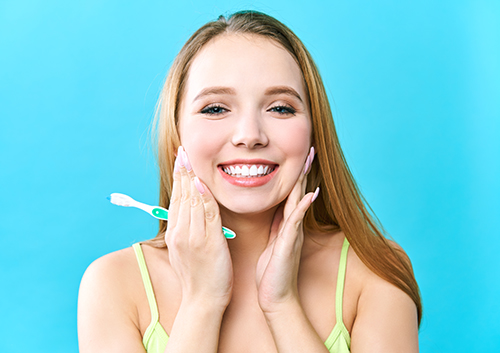
Your dashboard lights up when you need an oil change. Your smoke detector beeps when you need to switch out the batteries. But when it’s time to replace your toothbrush, you’re on your own. Luckily, there are several not-too-subtle clues that you should be shopping for a new model.
- Fraying
Is your toothbrush looking a bit scruffy? Do those once orderly bristles look like they have the toothbrush equivalent of bed head? Have some bristles vanished altogether? Time to retire that toothbrush. Once the bristles are frayed, you just can’t reach plaque as effectively, especially where it likes to hide between the teeth.
Are you prematurely fraying? You could be brushing too hard. Overbrushing can damage delicate gum tissue and cause wear and tear to tooth enamel. If you find your brush fraying after only a few weeks of use, you might be using too much force. Remember, plaque is a sticky film, but it’s a soft sticky film. Ask us for advice on just how hard you need—or don’t need—to brush.
- Odor
This one really goes without saying—no one wants an aromatic toothbrush! How to make sure your toothbrush is fresh and clean?
Always rinse carefully after you brush. This will get rid of any toothpaste, bits of food, or other particles left on your brush.
Let your toothbrush air dry. It might seem more hygienic to keep your brush covered in a bathroom setting, but a closed, moist container is a perfect breeding ground for germs. Don’t let them make a home in your bristles!
- Illness
A cold or a bacterial infection (like strep throat) is no fun. But now that you’re feeling better, it might be time to throw out your toothbrush. The chances of re-infection are very low, unless your immune system is compromised, but this is a perfect opportunity to replace your brush with a fresh, germ-free model.
And if you share your toothbrush, or if you store it right next to a loved one’s or family member’s (which you really shouldn’t do, for this very reason), germs get shared, too. Quarantine your brush while you’re ill, and replace it once you’re out and about.
- Discomfort
Bigger isn’t necessarily better. A brush with a head that’s too big won’t allow you to get into those small spaces in your mouth where plaque likes to collect.
And harder doesn’t mean more effective. A brush with hard bristles can cause damage to your gums and enamel. We almost always recommend soft-bristled brushes for this very reason.
There are so many styles of brush out there, you’re bound to find the perfect fit with a little trial and error. Or ask Drs. Peter Vogel, Vijal Vadecha for suggestions the next time you’re at our Anthem office for a cleaning!
- The “Best By” Date Has Passed
Because of its durable construction, your toothbrush can last a long, long time. But no matter how comfortable and effective your toothbrush is right now, it was never meant to go through life with you. Bristles break down over a period of months, and just don’t clean as effectively. Your brush should be changed every three months, and this includes changing the head on your electric toothbrush.
Unfortunately, you don’t have a flashing light or annoying beep to remind you when it’s time to change brushes, so you’ll have to devise your own reminders. Reminder apps, calendar notes, the first day of a new season—use whatever works best for you.
Don’t ignore the clues your toothbrush is leaving you. Replacing your brush whenever it’s necessary helps guarantee that the time you spend cleaning your teeth and gums will lead to confident, healthy smiles. Case closed!
Digital X-rays
February 17th, 2021

X-rays are a vital diagnostic tool for any dental professional. X-rays help your endodontist perform a root canal, your orthodontist check the position of a tooth’s root, your oral surgeon discover a fracture. X-rays reveal what we can’t see with the naked eye—and that’s why they are an especially important tool for Drs. Peter Vogel, Vijal Vadecha as well.
Why Are X-rays Necessary?
There’s a lot going on below the surface. An X-ray can reveal such conditions as cavities between teeth or underneath fillings, abscesses and other infections in the bone, impacted wisdom teeth, and cysts and tumors. They can also show the size, shape, and density of the bone beneath the teeth, which is essential information for dental implant procedures or dentures.
How Do X-rays Work?
Traditional X-rays, or radiographs, make use of film just like traditional cameras. When you have an intraoral X-ray, for example, the film is sealed in a moisture- and light-proof packet, and placed inside the mouth to capture images of specific teeth and the bone around them.
The X-ray machine is aligned precisely with the film and an exposure is taken. The image at this point is latent, and won’t show on the film, because, just like photo film, traditional radiographs need to be chemically processed before they produce a visible image.
Digital technology, on the other hand, uses an electronic sensor instead of film. For an intraoral digital X-ray, a small sensor is positioned in the mouth just like a film. When the X-ray is taken, a digital image capture device produces an image which is formed by a matrix of pixels instead of a photo-like film exposure. This format allows the image to be sent directly to a computer for immediate display without requiring processing.
Even though these methods seem very similar, digital X-rays offer some significant advantages over traditional films. Let’s look at how they compare, more or less.
- More Diagnostic Advantages
A traditional X-ray is a fixed image. It cannot be modified or enhanced. Here the digital X-ray offers a clear advantage in diagnosis.
Just as you can enlarge certain types of images on your computer without blurring or losing detail, a digital X-ray uses computer software to magnify images while keeping their details sharp. They can also be enhanced through brightness and contrast applications to make details stand out even more. Both of these benefits are extremely helpful for diagnosis, especially when looking for small cavities, problems in the roots and surrounding bone, or developing wisdom teeth.
There is even digital subtraction radiography software available that can be used to compare recent images to older ones, removing (“subtracting”) all the similarities in the two images to display only the changes in the two—even small changes—that have taken place over time.
- Less Exposure to Radiation
Dental X-rays expose patients to very low levels of radiation, and modern technology means traditional X-rays expose patients to less radiation than ever before. Even so, digital X-rays have significant advantages. Radiation exposure can be reduced by an additional 10%, 20%, or more with a digital radiograph.
- More Convenient for Sharing and Transmitting
If you need to share your X-rays with another dental specialist or physician, digital technology allows you to simply have them e-mailed to another office or multiple offices. You no longer need to worry about preserving physical copies, either.
- Less Waste
Unlike traditional X-rays, digital X-rays don’t need to be processed, so you save time in the office. And while the processing time is not significant (usually several minutes), if you need to repeat some X-rays for a clearer picture, or require different images for several teeth, this time can add up.
Digital X-rays are also more eco-friendly. The fact that they don’t need to be developed means that the chemicals used to process traditional films are no longer necessary—which also means that there is no need to dispose of chemical waste products afterward.
Our goal is to provide you with the safest, most efficient, and most effective dental treatment possible, and digital X-rays help us do that. If you have any questions about digital X-ray technology, contact our Anthem office. We’re happy to explain the science—and the benefits—of high-tech radiography.
Valentine's Day History
February 10th, 2021

Valentine’s Day is best known as a celebration of love in all its forms. Pink hearts, red roses, and cute greeting cards adorn every surface you see. What many people don’t realize is that the modern Valentine’s Day celebration arose from a religious holiday.
St. Valentine’s Day was originally celebrated as a religious feast day in honor of early Christian martyrs. Three martyrs named Valentine were honored: a priest in Rome, the persecuted bishop of Interamna (a town in central Italy), and a saint martyred in Africa. This saint’s day was celebrated throughout Christendom, although it was removed from the Roman Catholic Calendar of Saints in 1969.
The origin of Valentine’s Day as a holiday for lovers began with Geoffrey Chaucer in his 1382 poem “Parlement of Foules.” Chaucer wrote, “For this was on Saint Valentine’s Day, when every bird cometh there to choose his mate,” and the modern romantic holiday was born. William Shakespeare and other writers mentioned Valentine’s Day as a day of love.
Valentine’s Day as we know it came about in the early 19th century. In Victorian England, printers began manufacturing small numbers of cards with romantic verses, lace, ribbons, and other frills. Anonymous Valentine’s Day card were a popular way for young lovers to exchange romantic sentiments in an otherwise prudish time. As the 19th century progressed, printers began mass manufacturing Valentine’s Day cards. People in the United States give an estimated 190 million valentines every year, and up to one billion if you count children exchanging cards at school! With the rise of the Internet, Valentine’s Day e-cards have become a popular mode of communication, with millions of e-cards sent each year.
The other items associated with Valentine’s Day include chocolate and flowers. The tradition of giving chocolates has been around for decades, and Richard Cadbury created the first box of Valentine’s Day chocolates nearly 150 years ago. Today, purchases of chocolate total over $1 billion in the United States alone, with 35 million heart-shaped boxes sold each year. Loved ones also exchange flowers, with red roses being associated with Aphrodite, the Greek goddess of love. On Valentine’s Day itself, florists sell nearly 200 million stems of roses.
Although many people dismiss Valentine’s Day as a commercialized “Hallmark holiday,” it is beloved to couples and romantics across the United States and other countries. The team at Daisy Mountain Dentistry wants to remind all patients that no matter what your celebratory plans, February 14th can be a wonderful day to celebrate the loved ones in your life. Happy Valentine’s Day!
Is Charcoal Teeth Whitening Safe?
February 3rd, 2021

Health and beauty trends surface on the web every day, and it can be difficult to tell which ones are worth your time, or even safe, for that matter. Perhaps one of the biggest dental trends recently on Facebook, YouTube, and Instagram has been teeth whitening through brushing with activated charcoal.
Unfortunately, charcoal whitening isn’t everything the Internet makes it out to be. Activated charcoal isn’t what you use to grill at a summer barbecue; it’s an oxidized substance made from peat, coal, wood, coconut shell or petroleum heated with a gas.
Toxins and surface stains can cling to charcoal due to its adhesive qualities, which is why some people declare it’s perfect for removing discoloration on teeth. Although it may show quick results initially, charcoal is nothing more than a temporary solution.
The abrasive texture may roughen up enamel, which will make it easier for future stains to stick to the surface of your teeth. They may show stains shortly after you use charcoal on them, and may become even more discolored than before.
It’s crucial to emphasize the results of damaged tooth enamel because it cannot replenish itself, which means any damage is permanent. People with receding gums or sensitive teeth especially should steer clear of charcoal because it can make brushing too harsh and worsen sensitivity.
Long-time use can deplete enamel, which over time exposes dentin: the soft, yellowish layer in the tooth. This puts you at a higher risk for cavities, tooth discoloration, and complicated dental problems such as periodontal disease in the future.
The American Dental Association does not approve of charcoal as a safe means for whitening teeth. If you do choose to use it, do so with caution.
Charcoal should be used once every other week at the most, even if your teeth feel fine. The only proven ways to whiten teeth safely are with ADA-approved whitening products or in-office bleaching treatments overseen by a dental professional.
Before you begin any whitening treatment at home, consult with Drs. Peter Vogel, Vijal Vadecha to make sure your teeth won’t be harmed in the process. If you are already experiencing sensitivity, stop charcoal use immediately and make an appointment with our office right away.
If you have questions about whitening or want to schedule an in-office whitening treatment, feel free to give our Anthem office a call today!
Gum Disease in Children
January 27th, 2021

When it comes to gum disease and your child, it’s a good news/bad news situation. The very good news is that children rarely suffer from advanced gum disease, or periodontitis. The not-so-good news? Early gum disease, called gingivitis, is unfortunately an all-too-common childhood problem.
- What does gingivitis look like in children?
Childhood gingivitis has the same causes and symptoms as the adult version. Healthy gums are firm and pink. When bacteria and plaque accumulate on the teeth, your child’s gums become irritated and inflamed. Call our Anthem office right away if you notice any of these symptoms of gingivitis: bleeding gums, puffiness, redness, gum tissue receding from the teeth, or bad breath even after brushing.
- How to Prevent Gingivitis
The most common cause of gingivitis is poor dental care. Creating a regular dental routine is the best way to prevent gingivitis from ever developing! Brushing and flossing with your child for two minutes twice a day from the very beginning helps make healthy cleaning a lifelong habit. Care should be taken to gently brush teeth at the gum line to make sure plaque doesn’t get a chance to build up there and cause gum irritation. And when your child comes in for regular cleanings, Drs. Peter Vogel, Vijal Vadecha can be sure that any plaque that might remain on the teeth is removed.
Two additional notes: as your child approaches adolescence, hormone fluctuations can make gums more sensitive and easily irritated. This is a time to really emphasize careful and gentle brushing and flossing. Also, some medical conditions may make children more pre-disposed to gum problems, so be sure to make us aware of your child’s medical history.
- Uncommon Gum Diseases
While gingivitis is very preventable with proper dental hygiene, there are some rare gum conditions that can occur around the time of puberty that are quite different from gingivitis. Aggressive Periodontitis can cause severe bone loss around the first molars and incisors, even without any kind of plaque build-up, and Generalized Aggressive Periodontitis leads to inflammation of the gums, heavy plaque, and, eventually, loose teeth. Again, these conditions are rare, but if you have a family history of these diseases, let us know. Checkups and cleanings are a great way to catch any potential gum problems, so be sure to bring your child in for regular visits.
Almost all childhood gingivitis is preventable. With careful brushing and flossing at home, and visiting us regularly for checkups and cleanings, your child can enjoy healthy gums and teeth now and learn habits that will keep those gums and teeth healthy for a lifetime. And that is a good news/great news situation!
Losing a Baby Tooth Prematurely
January 20th, 2021

Losing a baby tooth is often an exciting event in a child’s life. It’s a sign your child is growing up, and might even bring a surprise from the Tooth Fairy (or other generous party). But sometimes, a baby tooth is lost due to injury or accident. Don’t panic, but do call our Anthem office as soon as possible.
If Your Child Loses a Tooth
It is important to see your child quickly when a baby tooth is lost through injury. The underlying adult tooth might be affected as well, so it’s always best to come in for an examination of the injured area. The American Dental Association recommends that you find the lost tooth, keep it moist, and bring it with you to the office. Call Drs. Peter Vogel, Vijal Vadecha immediately, and we will let you know the best way to treat your child and deal with the lost tooth.
Baby Teeth Are Important
There are several important reasons to look after your child’s first teeth. Baby teeth not only help with speech and jaw development, but they serve as space holders for permanent teeth. If a primary tooth is lost too early, a permanent tooth might “drift” into the empty space and cause crowding or crookedness.
Space Maintainer
A space maintainer is an appliance that does exactly that—keeps the lost baby tooth’s space free so that the correct permanent tooth will erupt in the proper position. The need for a space maintainer depends on several factors, including your child’s age when the baby tooth is lost and which tooth or teeth are involved. We will be happy to address any concerns you might have about whether or not a space maintainer is needed.
It is important to remember that there are solutions if the Tooth Fairy arrives at your house unexpectedly. Keep calm, call our office, and reassure your child that his or her smile is still beautiful!
Going Green for the New Year
January 6th, 2021

Does your list of New Year’s resolutions for the coming months include reducing your ecological footprint? If so, let’s ring in the year with some basic—and some innovative—dental ideas to help you meet your goal.
- Conserve Water
This is probably the easiest –and most cost effective!—item on our list. If you leave the water running while you brush, you are watching gallons of water go down the drain every day. Luckily, toothbrushes rely on wrist power rather than water power. Wet your brush before you begin, and use water only as needed to rinse. You’ll save hundreds of gallons of water every year.
And while we’re near your sink, if you like to rinse after brushing and flossing with disposable plastic cups, consider using compostable paper products or a regular drinking glass that you can clean after using.
- Biodegradable/sustainable /recyclable toothbrushes
Some brushes promise to be completely compostable, with handles manufactured from sustainable woods or bamboo, and heads fitted with biodegradable boar bristles. Investigate before you buy, because boar bristles aren’t for everyone. Some users complain about the taste, and boar bristles are harsher than the soft bristles we recommend to protect your enamel and gums. Organic bristles are also more prone to bacteria growth.
If you prefer the consistency and texture of regular synthetic bristles, or wish to avid animal products, you can still opt for a brush with a handle of sustainable wood or bamboo. These brushes also offer PBA-free bristles, bristles made largely from castor oil, or bristles that use natural ingredients in combination with synthetics.
And don’t forget recycling as a possibility to cut down on your plastic use. Toothbrushes are available with handles made from recycled plastic. And once you’re finished with them, these brushes can be recycled again.
- Biodegradable dental floss
This is another innovative take on dental supplies, and one that offers lots of new options. Regular dental floss is usually made from waxed nylon. Biodegradable floss, on the other hand, can be made of silk or plant materials, and coated with beeswax or plant-based wax. Some of these biodegradable flosses even come in refillable or compostable packaging.
- Organic toothpaste
If you’re incorporating organic foods into your diet, you know that organic options are more easily available than ever before. And now there are more organic toothpastes available, as well. Natural toothpastes can be found which are vegan, fair-trade sourced, and preservative- and artificial ingredient-free.
Before you buy, though, do discuss your choices with Drs. Peter Vogel, Vijal Vadecha. Why? Because many natural toothpastes are formulated without fluoride, a mineral shown to prevent cavities in study after study. Which leads us to . . .
- See Your Dentist Regularly for Checkups and Cleanings
Along with your daily dental hygiene routine, don’t forget to make regular appointments for examinations and professional cleanings at our Anthem office. Drs. Peter Vogel, Vijal Vadecha can help you discover the best ideas for products and practices which are good for you and good for the planet, for a lifetime of natural, sustainable smiles.
New Year's Day Around the World
December 30th, 2020

New Year’s Day marks the beginning of the calendar year in most parts of the world. The holiday is celebrated on January 1st of each year. Customs and celebrations vary by country, religion, and even individual desires. Whether celebrated quietly or with gusto, the day brings the start of new opportunities for those that observe it.
United States and Canada
In both the US and Canada, celebrations begin on New Year’s Eve. At midnight on January 1st the New Year is welcomed with bells, horns, whistles, and other noisemakers. Fireworks are often part of the celebrations. In New York City, Times Square comes alive with revelers. In Toronto, there are large celebrations which may feature concerts, late-night partying, sporting events, and fireworks, with free public transit service during peak party times. Many individuals in North America greet the year by making resolutions for improvements in their lives.
China
In China, many people celebrate two forms of a new year. They may observe January 1st, but the traditional Chinese New Year is based on a lunar calendar. Parades with paper lanterns and dragons made from silk are a significant part of the festivities. Legends say that the dragon spends most of its time in hibernation so fireworks are used to keep the dragon awake.
Jewish Celebration
Jewish New Year’s observances begin with Rosh Hashanah, the first day of the New Year, and end with Yom Kippur, the Day of Atonement. This ten-day celebration is held in September or October, based on the Hebrew calendar. The New Year is not marked as much with loud celebrations as with personal insight to mend wrongs and resolve to better oneself.
Other countries and cultures also have different dates for New Year’s Day observances:
- Vietnam observes the New Year in February
- In Iran, the day is celebrated on March 21st
- Islamic cultures often observe the tenth day of the month of Muharram
- Russian Orthodox observers use the Julian calendar and celebrate on January 14th
- Buddhist celebrations are held from April 13th through 15th
If you observe New Year’s Day by making healthy resolutions, include dental care in your plans with Drs. Peter Vogel, Vijal Vadecha. The health of your teeth and gums contributes to your overall health. Caring for your mouth now can prevent many dental problems later in life. Daisy Mountain Dentistry wishes you a healthy, prosperous, and happy New Year!
Quit Smoking to Save Your Smile
December 23rd, 2020

You’ve likely heard that smoking increases risk of lung cancer and emphysema. But did you realize that your cigarette habit also has an impact on your smile? Chronic smokers suffer from increased dental problems that make their smiles unsightly. Understanding how smoking affects your oral health may provide the momentum you need to kick the habit for good.
Cosmetic Changes Associated with Smoking
Cigarettes contain more than 600 ingredients that, when lit, create in excess of 4,000 chemicals. Of these chemicals, many are known carcinogens while others have been shown to have serious negative effects on health. The nicotine and tar in tobacco products are absorbed by the enamel of your teeth. The result is yellowed teeth that look unsightly; with heavy smoking, your teeth may eventually turn nearly brown in color.
The chemicals in cigarettes and cigars also cause your teeth to become less clean. Smoking is associated with a build-up of tartar and plaque on the surface of your teeth. Over time, this increases your risk of developing cavities and other oral health problems. Furthermore, pursing your lips while smoking leads to wrinkles around your mouth, which detracts from your smile.
More Serious Dental Conditions
In addition to having unsightly teeth, smoking can cause serious health conditions. Because of the carcinogens in cigarettes, smoking is associated with an increased risk of oral cancer, which can be deadly. Smokers are also more likely to develop gum disease, which can lead to tooth loss. You may experience an increased loss of bone within your jaw, which will cause significant problems later in life.
Treatment for Smoking-Related Oral Health Problems
Drs. Peter Vogel, Vijal Vadecha and our team at Daisy Mountain Dentistry will tell you that the best defense against smoking-related oral health problems is to ditch your nicotine habit. By decreasing the amount of nicotine and other chemicals you consume, you can decrease your risk of oral cancer and gum disease. Remember to mention your smoking habit when you’re at our Anthem office. We frequently treat smokers and can recommend smoking cessation programs to help you quit. Drs. Peter Vogel, Vijal Vadecha can also advise you about whitening treatments and gum disease prevention activities that ensure you’ll have a beautiful smile for years to come.
Dentistry around the World
December 16th, 2020

From the clinical perspective, dentistry is similar around the world. Dentists, like Drs. Peter Vogel, Vijal Vadecha, go to school, obtain a license, and work hard to prevent and treat tooth decay, gum disease, oral infections, throat or oral cancer, tooth loss, and other conditions that might limit a person’s ability to smile, bite, chew, or speak. The quality of dental care, however, and the payment method for dental services varies between nations.
Dentistry throughout the World
Developed countries have more dentists per capita than do developing nations, according to the World Health Organization. There is one dentist for every 150,000 people in Africa, for example, as compared to about one dentist for every 2,000 citizens of an industrialized nation. The lack of dentists in developing nations means that dental care is restricted to pain management and emergency care.
Dentistry often reflects the cultural views of a nation. Some cultures acknowledge only the functional aspect of teeth, so dentists focus on preventing tooth decay, gum disease, and tooth loss. Other cultures emphasize aesthetic appearances, so dentists there provide cosmetic procedures in addition to essential oral care.
Each nation imposes its own education and licensure requirements for dentists but most require some college before four years of dental school. The graduate must then pass local or national exams to practice in that region. European schools and standards are similar to the United States.
From the business perspective, dentistry varies between nations. In the United States, a dentist presents to the patient one bill that includes all of the treatment costs, such as the dentist, his assistant, tools, and labs. This allows the dentist to charge a single, easy-to-pay fee for individual procedures, and gives him an opportunity to mark up items and make a profit.
Across much of Europe, a dentist presents two bills to her patient – one for the dentist and another for the lab. This approach may stem from a cultural belief that profiting from healthcare is unethical and that healthcare should be available to consumers at actual cost; public dental clinics and subsidies ensures all citizens have access to dental care, regardless of ability to pay. In most cases, the government is both overseer and provider of dental care.
While the role of the dentist is nearly the same in every country – to ensure the oral health of the citizens – dental care is different in each nation. Regardless, you can rest assured that the care you receive at our Anthem office is held to the highest standard.
Three Must-Have Dental Treatments
December 9th, 2020

In dentistry, there are a wide variety of treatments, everything from elective procedures to those that are necessary and potentially lifesaving. So given the slew of treatment options, how do you choose what’s right for you? Our experts at Daisy Mountain Dentistry have handpicked the three must-have procedures that we believe can benefit nearly every patient.
The first: A complete periodontal exam. If you are going to the dentist for scheduled cleanings, this exam should happen at least once a year. A periodontal exam is quick and relatively painless. The dentist or hygienist will carefully probe around each tooth to take measurements that show the health of the bone and its supporting tissue, all while looking for signs of any active infection. It has been suggested that there is a link between periodontal (gum) disease and the increased risk of some potentially fatal diseases such as heart disease, stroke, and diabetes. Signs of some diseases show up in the mouth sometimes before the patient is aware of changes in the body. Diabetes is one of these silent diseases. Many Americans are unaware that they have the disease until sudden and severe changes in the periodontal health of the teeth lead to a trip to the patient’s physician. And did you know that more adults lose teeth to periodontal disease than to cavities? A simple screening once a year can lead to saving your teeth.
The second treatment our team at Daisy Mountain Dentistry recommends is a dental sealant; it’s not just for kids! Dental sealants provide a protective barrier from bacteria deep in the pits and grooves of the teeth where cavities often start. Sealants placed in childhood will often wear away in adulthood. Replacing a sealant as an adult can also help prevent decay in adulthood. This is a great cost-effective procedure for adults. Dental insurance will likely not cover sealants as an adult, but the cost of a sealant for prevention versus the cost of a filling is much less.
Our third must-have dental treatment is often the most fun: in-office whitening. Who doesn’t want an instantly dazzling smile? In-office whitening is one of the most dramatic and quick ways to brighten a smile. It will take a few years off your age in a two-hour period of time. Whitening is very safe and can give a patient newfound confidence to smile.
‘Tis the Season—for Healthy Dental Choices!
December 2nd, 2020

It might be the most wonderful time of the year, but if you’re dashing through the snow to an emergency dental appointment, you’re not feeling very jolly. And post-holiday, no one wants to start off their New Year’s Resolutions with “Get Cavities Filled.” How to survive the sweetest of seasons with enamel and fillings intact?
Candies and sweets would normally be on the naughty list, but we’re not Scrooges! Indulging in a treat or two is part of the holiday fun, and we have some advice for how to enjoy them guilt-free. But first, some treats are definitely more naughty than nice. Which are the ones that are better as decorations than desserts?
- Candy Canes
If you’ve ever suffered a chipped or cracked tooth after an innocently biting down on a much-harder-than-expected piece of candy, you know that caution is in order. That’s why we tend to take our time with candy canes, letting them dissolve slowly in the mouth. Of course, the drawback to this strategy is that now we’re slowly bathing our teeth in sugar, encouraging the growth of plaque and cavity-causing bacteria.
Candy canes, peppermints, and other hard candies are potentially bad for your teeth when you crunch away, and definitely bad for your teeth if you let them dissolve slowly.
- Gumdrops
Glistening, colorful gumdrops. Roofing your gingerbread house, trimming a gumdrop tree, or simply sitting in a bowl, they are one of the sweetest ways to decorate for the holidays. And when we say “sweet,” we mean that literally. Most gumdrops are basically made of corn syrup and sugar—and then rolled in more sugar.
But their sugar content isn’t the only problem. This is sugar in an extra-gummy form that sticks between our teeth and around our gums.
- Toffees, Caramels, Taffy
They might come in lovely ribboned boxes, but these extremely sticky foods are not a gift to your teeth.
Not only do chewy candies stick to enamel, they stick to fillings, crowns (especially temporary crowns), and orthodontic wires and brackets. No one wants an unexpected trip to the dentist or orthodontist because dental work has been damaged or dislodged!
- Gingerbread Houses
Nothing says the holidays like a gingerbread house—chewy, sticky gingerbread covered with hard sugar icing, gumdrops, and peppermints. Great for your décor; not so great for your dental health. Eat one gingerbread man if you’re in a spicy mood and leave your architectural masterpiece intact.
- Fruitcake
If you need an excuse to turn down fruitcake, here’s a perfect one: most fruitcake is not great for your teeth. Candied fruit is, well, candied, and dried fruit is sugary, sticky, and chewy. There are delicious exceptions, of course, but even a delicious fruitcake is very high in sugar.
Well, this list wasn’t very jolly. So as a little holiday gift for you, here are some suggestions to help you enjoy your desserts in the healthiest way possible.
- Be choosy.
Just like you search for the perfect presents for your family and friends, take the time to choose the perfect holiday treats for yourself. If you are worried about cavities, or have a temporary crown, or wear braces, or have cracked a tooth before, or are just generally concerned with your oral health, stay away from sticky, hard, and excessively sugary desserts.
What can you accept from your holiday hosts with a grateful (and relieved) smile? The occasional soft chocolate should be nothing to stress about—and if you make it dark chocolate, you’ll actually get nutritional bonuses like magnesium and antioxidants. Cakes, cupcakes, cookies, pies—yes, they are made with lots of sugar, but it is the holidays after all. Just be sure to follow our next suggestions to make that slice of cheesecake guilt-free.
- Eat sweets with a meal.
Saliva does more than keep our mouths from getting dry. It also helps prevent cavities by washing away food particles and neutralizing the acids from food and bacteria, which damage enamel.
Eat dessert with a meal, and you benefit from increased mealtime saliva production. When you snack throughout the day, this acid-neutralizing ability is greatly reduced.
- Rinse after eating.
Rinsing your mouth with water after a meal or a snack, especially a sugary one, also helps wash away the sticky sugars and carbs, which oral bacteria convert into acids.
- Brush immediately. (Maybe.)
It’s always a good idea to brush right after eating—well, almost always. If you’ve been eating acidic foods like citrus or colas, the acids in the food can weaken your enamel just enough to cause some potential enamel damage if you scour your teeth immediately after eating. We often recommend waiting about 30 minutes to brush to give your enamel a chance to recover.
But every mouth is different. If you wear braces, or tend to get food stuck in your teeth or dental work, or have any other concerns, ask Drs. Peter Vogel, Vijal Vadecha for the best times and methods for holiday brushing.
You don’t want to ho-ho-hope that we can fit you in at our Anthem office to treat a cavity or a cracked tooth. Make your holiday dessert list and check it twice, and make sure you’re brushing and flossing more often if you’re indulging in seasonal treats—give yourself these two gifts, and you’ll be ringing in the New Year with a beautiful, healthy smile. Sweet!
Thanksgiving
November 25th, 2020

At Daisy Mountain Dentistry, we love to celebrate the holidays with vigor! Drs. Peter Vogel, Vijal Vadecha would love to share some unique ways of celebrating Thanksgiving from beyond the Anthem area to the national level!
When Americans sit down to dinner on the last Thursday of November, the day that Abraham Lincoln designated as the day on which Thanksgiving would be celebrated, they do so thinking that the first Thanksgiving feast was held at Plymouth in 1621. According to National Geographic, the Spanish explorer Francisco Vásquez Coronado and his men celebrated a feast of Thanksgiving in Texas in 1541, giving Texas the distinction of being the first place where Thanksgiving was celebrated.
Different Types of Celebrations
Native Americans had rituals around which they celebrated in hopes of ensuring a bountiful harvest. The Cherokees had a Green Corn Dance that they did for this very purpose. The Pilgrims (not to be confused with the Puritans,) rejected any type of public religious display. They held a three-day long non-religious Thanksgiving feast. Although they said grace, the focus of their celebration was on feasting, drinking alcohol (they did have beer,) and playing games.
The Pilgrims at the Plymouth Plantation celebrated a different day of Thanksgiving in 1623. Plagued by a crop-destroying drought, the settlers prayed for relief. They even fasted. A few days later, they got the rain they so desperately needed. Soon thereafter, they received another blessing when Captain Miles Standish came with staples they couldn't otherwise get. He also told them that a Dutch supply ship was en route. In gratitude for the abundance of good fortune, the Plymouth settlers celebrated a day of prayer and Thanksgiving on June 30, 1623.
The Story of Squanto
No discussion of Thanksgiving is complete without a discussion of Squanto, or Tisquantum, as he was known among his people, the Patuxet Indians. It is believed that he was born sometime around 1580. As he returned to his village after a long journey, he and several other Native Americans were kidnapped by Jamestown colonist, Thomas Hunt. Hunt put them on a ship heading to Spain where they were to be sold into slavery.
As fate would have it, some local friars rescued him and many of the other kidnapped natives. Squanto was educated by the friars. Eventually, after asking for freedom so he could return to North America, he ended up in London where he spent time working as a ship builder. By 1619, he was finally able to get passage on a ship headed to New England with other Pilgrims.
Upon arriving at Plymouth Rock, he learned that his entire tribe was wiped out by diseases that accompanied earlier settlers from Europe. In gratitude for passage on their ship, he helped them set up a settlement on the very land where his people once lived. They called the settlement Plymouth. Since they knew nothing about how to survive, let alone how to find food, Squanto taught them everything, from how to plant corn and other crops, how to fertilize them, how and where to get fish and eels and much more.
After a devastating winter during which many settlers died, thanks to Squanto's teaching, they had an abundant harvest. After that harvest, they honored him with a feast. It is this feast of 1621 which was celebrated between the Pilgrims and Wampanoag Indians that is widely considered the first Thanksgiving celebration.
About the Meal of the Plymouth Settlers
Surviving journals of Edward Winslow that are housed at Plymouth Plantation indicate that the first Thanksgiving feast was nothing like what Americans eat today. The meal consisted of venison, various types of wild fowl (including wild turkey,) and Indian corn. There were no cranberries, stuffing, pumpkin pie, potatoes, or any of the other “traditional” foods that appear on modern menus.
Today, Thanksgiving is celebrated on the fourth Thursday of November, the day that Abraham Lincoln designated as the holiday. It is still a day of feasting, and for some, a day of prayer and thanksgiving. For others, it is a celebration of gathering, especially for families. Still others may celebrate in entirely different ways, including watching college football bowl games, or by playing family games.
If you ever wonder why you're so tired after the Thanksgiving meal, it's because turkey contains an amino acid, tryptophan, and it sets off chemicals whose chain reaction combine to make people sleepy.
Care for Your Dentures
November 18th, 2020

Just like natural teeth, Drs. Peter Vogel, Vijal Vadecha will tell you that dentures have a tendency to get coated with plaque, which is a sticky, transparent film that attracts food and bacteria. When you don’t take care of your dentures adequately and regularly, plaque can build up, harden, and become difficult to remove. More importantly, it can result in dental problems, including gum disease and infection. Proper care for your dentures also helps them maintain their shape, fit the way they are supposed to, and last longer.
Cleaning your dentures
Your dentures should be cleaned with the same diligence as you clean natural teeth.
- Take out dentures and rinse them after eating. To remove food particles, run water over your dentures.
- Clean your teeth after denture removal. Once dentures have been removed, use a soft-bristled toothbrush to brush existing teeth, gums, and tongue.
- Scrub your dentures on a daily basis. At least once per day, gently scrub your dentures with a soft-bristled toothbrush and denture cleanser.
- Soak dentures overnight. In order to keep their shape intact, many dentures must remain moist. Always use a mild denture solution recommended by our office. Never use hot water on your dentures, as they may warp their shape.
- Rinse dentures prior to placing them back in your mouth. This is especially important if you soak your dentures in a denture solution.
- Dentures are fragile and can break when dropped. It’s a good idea to hold them in a soft cloth or towel to keep them from falling and breaking.
Over time, even with diligent daily care, your dentures may form difficult-to-remove tartar. When this happens, our team at Daisy Mountain Dentistry uses a powerful ultrasonic cleaner to remove stubborn, denture build-up.
Proper care for your dentures can help retain their shape, prevent oral issues, and increase their longevity. Visit Drs. Peter Vogel, Vijal Vadecha regularly at our convenient Anthem office to maintain your oral health and keep your dentures in tip-top shape.
Broken Tooth: Is It an emergency or not?
November 11th, 2020
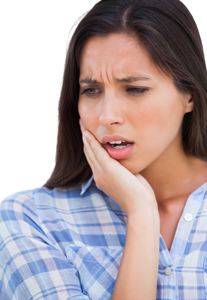
Have you ever had that sinking feeling after biting into something soft and chewy and feeling something hard and crunchy instead? You’ve chipped or broken a tooth, but what should you do next? First try to assess the damage by determining whether it’s a chip or a whole tooth.
As Drs. Peter Vogel, Vijal Vadecha will tell you, a broken or chipped tooth is usually not a dental emergency unless you are experiencing a great deal of pain or bleeding, but you should contact us for an appointment shortly afterward. Be sure to mention that you have a broken tooth so we can fit you into our schedule quickly. After a thorough evaluation, we’ll recommend a course of action. If it is a small chip, we may simply smooth it out. For a larger break, the dentist may fill in the space with a composite material that matches your other teeth.
Emergency Dental Care
If you are in severe pain, are bleeding excessively, have a major break, or have lost a tooth, that is a dental emergency and you should contact us. As emergency dental specialists, we’ll be able to schedule an appointment immediately and advise you on the next steps to take.
You can rinse your mouth with warm water and apply pressure to stop the bleeding. An ice pack will help reduce any swelling. Do not take any aspirin as that could increase the amount of bleeding. Should your tooth be knocked out completely, rinse it under running water but do not scrub it. Hold the tooth only by the crown, or the part you normally see above the gum line, not by the root. If you can, put the tooth back into the socket while you travel to our office, or put it in a mild salt solution or milk. Don’t let the tooth become dry, because this can lead to damage. Once you get to our office, our dentist will determine whether the tooth can be saved or if it will need to be replaced.
A broken tooth may not always be an emergency, but it’s best to have it treated with us at Daisy Mountain Dentistry. While it may only be a cosmetic problem at first, if left too long without treatment, you may experience further damage to your tooth and mouth.
How much calcium does my child need?
November 4th, 2020

When you were a kid, your parents may have told you to drink milk to build strong bones and grow tall and strong. Now that you have children of your own, you may hear yourself parroting those instructions you received years ago. Getting enough dairy is essential for young children whose teeth are growing. A child who consumes the recommended daily serving of dairy will develop healthy, strong teeth for the rest of his or her life.
So, which foods are the best in terms of acquiring the right amount of calcium? Milk and other dairy products are excellent sources of calcium. Milk also contains vitamin D, phosphorus, magnesium, and proteins. Magnesium promotes calcium deposits in your enamel, while phosphorus forms a small but important barrier against acidic foods that cause cavities. Vitamin D and protein are used by a child’s body to build bone tissue and maintain dental health.
According to a recent study, the majority of Americans, including children, do not receive enough calcium. In fact, according to the Academy of General Dentistry, only one in five children meets even the minimum standards for calcium consumption. The U.S. Department of Agriculture recommends that children under the age of eight should receive two and a half cups of dairy per day. Children older than eight need three full cups, the same as adult men and women. In addition to milk, eating yogurt is a great way your child can increase his or her dairy consumption. Drinking sugary beverages in place of milk causes cavities and tooth decay.
If your child does not get enough dairy consumption, they run the risk of improper tooth development and other dental health problems. Drs. Peter Vogel, Vijal Vadecha and our team at Daisy Mountain Dentistry encourage you to monitor your child’s dairy consumption to ensure he or she grows healthy teeth to last a lifetime.
Questions? Give us a call at our Anthem office!
How Sedation Dentistry Can Help You Overcome Dental Anxiety
October 28th, 2020

Sometimes people feel a tiny bit nervous when they sit in the dental chair. And sometimes it’s more than a tiny bit. If your anxiety over visiting the office leads you to skip regular checkups and cleanings, or, worse, if you would rather suffer tooth or gum pain than give us a call—give our Anthem office a call! Sedation dentistry might be just the procedure you need to make dental anxiety a thing of the past.
Drs. Peter Vogel, Vijal Vadecha and our team are trained to administer sedation and to monitor your responses throughout. And we want you to have all the information you need to decide on any dental treatment, including sedation. We will tell you of any risks, and describe the procedure in detail. If you have any health conditions or take any medications that might interfere with sedation, we can discuss your options with you and your doctor to make sure you are a good candidate. We will explain any preparations you should take, and let you know if there is a window of recovery time needed in our office while the sedation wears off.
Don’t let yourself suffer dental pain because you suffer from dental anxiety! Please call us to discuss sedation. We are trained to administer the treatment you choose gently and safely. Above all, we want to help you keep your smile the heathiest it can be, and that only happens when you have regular dental care. Let us work with you to make that care as comfortable and stress-free as possible.
HPV and Oral Cancer
October 21st, 2020

Human papillomavirus, or HPV, is best known as a sexually transmitted infection. In the United States, HPV is the most common sexually transmitted disease, with 79 million Americans currently infected, according to the Centers for Disease Control and Prevention. In addition to increasing risk for cervical cancer, HPV is a contributing factor in some cases of oral cancer. Each year an estimated 1,700 women and 6,700 men develop oropharyngeal cancer, which affects the tongue and throat.
Connection between HPV and oral cancer
There are more than 40 strains of HPV that live in the skin and mucosal areas. Some of these affect the genitalia, while others are found in the mouth and throat. Of the strains of oral HPV, only one, called HPV16, increases the risk of oral cancer, the Oral Cancer Foundation reports. A retrospective study conducted found that oral cancer developed an average of 15 years after exposure to HPV, making it a relatively slow-growing form of cancer.
In general, 80% of Americans will have an HPV infection at some point in their lifetimes, while 99% develop no ill effects. Getting oral HPV is associated with multiple sexual partners and engaging in oral sex; however, even some individuals who have been with only one partner may contract the infection. Although overall risk of oral cancer from HPV infection is low, it is essential to be proactive about oral health.
How to prevent HPV-related oral cancer
Scientists continue to study how HPV infections lead to oral cancer, so little is known about the progression of the disease. However, one recent study found that poor oral health, including gum disease and poor oral hygiene, is associated with oral cancer risk. Thus, being vigilant about brushing and flossing your teeth regularly may reduce HPV-related oral cancer. Getting the HPV vaccine also protects against the oral form of the virus.
Another key way to reduce mortality from oral cancer is to have regularly scheduled appointments with at Daisy Mountain Dentistry. Having Drs. Peter Vogel, Vijal Vadecha examine your mouth at least two times a year increases the likelihood that a sign of oral cancer, such as a sore or patch, will be detected. If you’re concerned about HPV-related oral cancer, please give us a call at our Anthem office for advice about oral hygiene and disease prevention.
Anatomy of a Smile Makeover
October 14th, 2020

A smile makeover is usually a combination of one or more cosmetic dental procedures. To achieve your desired result, Drs. Peter Vogel, Vijal Vadecha may perform or suggest a variety of options. The entire process is designed specifically for your unique cosmetic needs, and Drs. Peter Vogel, Vijal Vadecha will make sure all your concerns regarding your smile are addressed.
Here are some of the most common procedures in cosmetic dentistry and how they work:
- Tooth whitening – Whiter teeth are achieved through a bleaching process typically using hydrogen peroxide or carbamide peroxide. Yellower teeth usually respond well to this procedure, while brown-colored teeth stained by fluorosis or taking tetracycline do not respond as well to whitening. Tooth whitening is not for everyone; if you have sensitive teeth, gum disease, or poor enamel, Drs. Peter Vogel, Vijal Vadecha may recommend against tooth-whitening services.
- Orthodontics – Braces are one of the tried-and-true ways of achieving a healthier smile. Braces are typically worn between 12 and 24 months to reposition the teeth in a straighter and safer alignment. Since your bite is also corrected during this process, it helps ensure you won't have any trouble down the line. There are several different types of braces available these days including: traditional metal braces, clear ceramic braces, lingual braces, and clear aligners.
- Veneers – Veneers are thin, tooth-colored material (porcelain or resin) designed to be placed on the front surface of teeth to improve their overall appearance. They can be used in cases where the color, shape, size, or length is not as desired. Veneers are usually used in cases where teeth are discolored, chipped, worn down, misaligned, irregular, or have gaps.
- Implants/bridges – Dental implants and bridges are used to replace missing or broken teeth. Nowadays, both implants and bridges are commonly performed procedures. Implants integrate directly with the jawbone, while bridges are placed over the adjacent teeth to the missing tooth. Implant technology has advanced a great deal in recent years and highly biocompatible ceramic materials are becoming more commonplace.
Getting your perfect smile will take time and patience, but the end result will be well worth it! Please schedule an appointment at our Anthem office about the cosmetic dental services we offer, and achieve the smile you've always wanted!
Warning Signs of Impacted Wisdom Teeth
September 30th, 2020
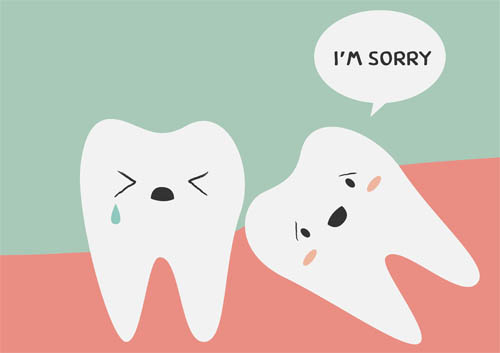
When your wisdom teeth start to emerge it can definitely be painful, but it can be even worse if your wisdom teeth become impacted. Impacted wisdom teeth are trying to erupt but are unable to do so because there is not sufficient room for them to emerge. This usually means that your wisdom teeth are painfully lodged in your jawbone.
While you may not see any real signs of the emerging wisdom teeth when they are impacted, what you can’t see can still definitely hurt you. Some of the indicators of impacted wisdom teeth are listed below.
- Jaw Pain: Pain in the back of your jaw is a common indicator of impacted wisdom teeth. The pain often concentrates in the area around your gums.
- Changes in the Mouth: You may notice some changes in your mouth when you have impacted wisdom teeth. Reddish gums, swelling in the jaw, bleeding gums, and bad breath can all be indicators that you are dealing with impacted wisdom teeth.
- Headaches: If you suddenly start having headaches, especially at the same time as some of the other issues mentioned above, they may indicate impacted wisdom teeth.
- Chewing Issues: Problems with chewing normally can indicate impacted wisdom teeth. If you are having trouble making the chewing motions because your mouth won’t quite open and close as easily as it used to, impacted wisdom teeth may be the culprit.
The Solution
If you are suffering from impacted wisdom teeth, the best solution is usually going to be removal. This is not a problem that will resolve naturally, and in fact, your pain and other symptoms may worsen as your wisdom teeth become increasingly impacted. At Daisy Mountain Dentistry, Drs. Peter Vogel, Vijal Vadecha can review the details of wisdom teeth removal surgery with you and help you determine if this is the best solution for your situation.
Should Children Use Whitening Products?
September 23rd, 2020

As adults, we often wish our teeth could be as white as they were when we were small children. Baby teeth have thinner and whiter enamel than adult teeth, and those brilliant smiles are a result! But occasionally, you may be surprised to discover some staining or discoloration on those lovely first teeth. You might be tempted to apply a whitening product to your child’s teeth, but, please—read on!
Causes of Staining
- Improper Brushing—Often, a loss of tooth whiteness means that plaque has built up on the tooth surface. Careful brushing is needed to remove bacteria and plaque, and if your child isn’t brushing at least twice a day for two minutes, discoloration can be the result.
- Medications—When given in liquid form, or when added to formula or food, iron supplements can cause dark grey staining on the teeth. Medications taken by a mother while pregnant or breast feeding, such as tetracycline, can also lead to discoloration.
- Injury—If a tooth suffers a serious injury, the tooth can darken because of changes inside the enamel.
- Health conditions—Certain health problems can cause tooth discoloration, or sometimes children are born with weaker enamel that is more likely to stain.
If you have noticed any staining on your child’s primary teeth, call our Anthem office. Simple stains can often be removed with better brushing techniques, and we can clean other surface stains in the office. Staining caused by an injury or a health condition is something we can discuss in detail with you. We can even use some professional whitening methods if those are indicated.
Why not just buy a home whitening kit for your child? There are several important reasons to leave these products on the shelf while your child is young.
- Whitening kits are designed for adults. They have been tested for adult teeth in adult trials. Check the box for age appropriate use. Most products are not recommended for pre-teen children.
- Remember that thinner enamel we mentioned earlier? Add to that the delicate skin of young children, and it’s sensible to be cautious about using a bleaching agent that can cause mouth and tooth sensitivity even in adults.
- There is no body of evidence available as to the short and long term effects of using these products on children.
If you are concerned about the brightness of your child’s smile, please talk to Drs. Peter Vogel, Vijal Vadecha. We can recommend better ways to brush at home, clean your child’s teeth in the office, or suggest professional methods of whitening if there are physical or psychological reasons that it would be valuable. But while your child is young, those off-the-shelf whitening products can wait a few more years.
HPV and Oral Cancer
September 16th, 2020

HPV, or human papillomavirus, is the most common sexually transmitted infection in the country. There are over 100 strains of HPV, and, while most of these infections leave our systems on their own with no long-term ill effects, some cancers have been linked to certain “high risk” strains of the virus. One of these strains, HPV16, increases the risk of oral cancer.
HPV-related oral cancer most often appears in the oropharynx. This area of the mouth includes:
- The base, or back, of the tongue
- The soft palate
- The tonsils
- The back and sides of the throat
While HPV-related oral cancers can appear in other parts of the oral cavity, they most typically occur at the back of the throat and tongue and near the folds of the tonsils. Because of this location, oropharyngeal cancer can be difficult to detect. This is one more important reason to maintain a regular schedule of dental exams. Our examination doesn’t focus only on your teeth and gums. We are trained to look for cancerous and pre-cancerous conditions in the mouth, head, and neck to make sure you have the earliest treatment options should they be needed.
If you discover any potential symptoms of oropharyngeal cancer, call us for a check-up. These symptoms can include:
- Trouble moving the tongue
- Trouble swallowing, speaking, or chewing
- Trouble opening the mouth completely
- A red or white patch on the tongue or the lining of the mouth
- A lump in the throat, neck, or tongue
- A persistent sore throat
- Ear pain
- Unexplained weight loss
- Coughing up blood
Not every symptom is caused by cancer, but it is always best to be proactive. HPV-related oral cancer is rare, but it is on the increase. While HPV-positive oral cancers generally have a better prognosis than HPV-negative oral cancers, early diagnosis and treatment are still essential for the best possible outcome.
Finally, if you are a young adult or have an adolescent child, talk to Drs. Peter Vogel, Vijal Vadecha and to your doctor about the HPV vaccine, which is effective before exposure to the virus occurs. Most HPV vaccines, while not designed specifically to prevent oral cancer, prevent the HPV16 strain from infecting the body—the very same strain that causes the majority of HPV-related oral cancers. Although no studies have shown definitive proof yet, there is strong feeling in the scientific community that these immunizations might protect against HPV-positive oral cancer as well as cervical, vaginal, and other cancers. It’s a discussion worth having at your next visit to our Anthem office.
When do children usually lose their baby teeth?
September 9th, 2020

Many parents worry that their children’s teeth are not falling out on time. A lot of concerned parents want to know: When will my child lose his or her first baby tooth? At what age should the last tooth fall out? Is there a specific order in which the teeth are lost?
Drs. Peter Vogel, Vijal Vadecha and our team explain that a child's 20 baby teeth (primary teeth) typically come in by age three and begin to loosen and fall out on their own to make room for permanent teeth, which usually appear by the time your child is six. It is important to know that timing may vary, and girls typically lose their baby teeth earlier than boys. The last baby teeth will likely fall out by the time your child is 13.
So, which teeth do children lose first? Baby teeth tend to fall out in the order in which they came, which means the lower center incisors are usually the first to go when your child is between six and seven years old. The next teeth your child will lose are his or her top center pair, also called the upper central incisors.
It’s important to note that if a child loses a baby tooth early as a result of decay or an unforeseen accident, his or her permanent tooth may erupt early and potentially come in crooked due to limited space. If your child suffers an injury or has tooth decay, we encourage you to give us a call to set up an appointment with Drs. Peter Vogel, Vijal Vadecha.
While we know some children couldn’t be more excited to lose their baby teeth, we know others are anxious about this childhood milestone. When your child starts to lose teeth, our team at Daisy Mountain Dentistry encourages you to stress the importance of proper dental care on a daily basis.
Remember to:
- Remind your child to brush his or her teeth at least twice a day. Supervise and offer assistance as needed.
- Help your child floss his or her teeth at bedtime.
- Limit eating and drinking between meals and at bedtime, especially sugary treats and drinks, such as candy and soda.
- Schedule regular dental visits for your child every six months.
- Ask about the use of fluoride treatments and dental sealants to help prevent tooth decay.
To learn more about baby teeth, or to schedule your child's next visit with Drs. Peter Vogel, Vijal Vadecha at our Anthem office, please give us a call today!
Diabetes and Dental Care
August 26th, 2020

When most people think of complications of diabetes, they think of an increased risk of blindness, limb amputation, heart disease, and neuropathy. However, Drs. Peter Vogel, Vijal Vadecha and our team want you to know that emerging research is revealing a possible connection between uncontrolled diabetes and dental problems. Whether you have type 2 diabetes or type 1, uncontrolled high blood glucose level increases the risk of certain oral health conditions, including:
- Cavities
- Tooth decay
- Gingivitis (early gum disease)
- Periodontal disease (advanced gum disease)
Diabetes and proper dental care
If you have diabetes, it is more important than ever to take your dental care seriously and practice excellent oral hygiene. These recommendations will help:
- Manage your diabetes. First and foremost, it is vital to control your high blood sugar in accordance with your physician’s instructions — not only for the sake of your oral health, but your overall health. With properly controlled blood sugar, you reduce your risk of developing gingivitis and other oral health issues.
- Practice good at-home oral hygiene. This means brushing at least twice a day AND flossing. At a minimum, brush your teeth in the morning and at night, but after meals and snacks if you can. Use a soft toothbrush to avoid injuring your gums. Don’t neglect flossing, because it helps to remove plaque below the gumline and between teeth.
- Visit the dentist regularly. While it is important to see the dentist every six months even if you don’t have diabetes, it is even more crucial to have a professional teeth cleaning and dental exam if you have the disease. As dental professionals, our team at Daisy Mountain Dentistry is able to detect early dental conditions before they develop into something more serious and costly.
- Tell your dentist that you have diabetes. If you were recently diagnosed with diabetes, be sure to let us know as soon as possible, and remind us at every appointment.
- Be conscientious about examining your own gums and teeth. By looking for early signs of gum disease, which can include bleeding gums, irritated gums, gums that are red (versus a healthy pink), or swelling, we can get started on treatment right away.
Managing diabetes takes effort, not only in watching your diet, exercising, monitoring your blood sugar levels, and taking your medication, but obtaining proper dental care.
To learn more about the link between diabetes and oral health, or to schedule an appointment with Drs. Peter Vogel, Vijal Vadecha, please give us a call at our convenient Anthem office!
I have fluoride toothpaste and fluoridated water; do I need a fluoride treatment?
August 19th, 2020

Fluoride is a naturally found ion with a history of greatly reducing the incidence of tooth decay in children. However, over the past decade, people have increasingly consumed bottled water, most of which does not contain fluoride, and children are no longer getting the recommended dosage of fluoride. In addition, many areas do not add the optimum amount of fluoride to the town drinking water.
Everyone’s dental needs are different. The amount of fluoride a person needs is determined by age (children), tooth sensitivity, risk for cavities, and medical conditions. When a patient needs additional fluoride it can be applied in a foam or varnish.
Children receive additional topical fluoride because teeth in the early development stages have a higher mineral uptake. The future strength of the enamel depends on this. When a tooth absorbs the fluoride ion, it creates hydroxyapatite, a harder mineral compound than enamel alone.
Those who have a dry mouth from medication also need extra fluoride. A daily fluoride rinse and a semi-annual fluoride varnish treatment are standard. If you are on medicine for high blood pressure, anxiety, diabetes, depression, or cholesterol, you may fit in this category.
Cancer treatments can also greatly impact your oral health. Fluoride varnish treatments prior to, during, and after radiation and chemotherapy can be beneficial. There are other mouth conditions which coincide with cancer treatments which make it difficult to brush and floss daily, and can contribute to an increased risk for decay. An infection during cancer treatment can be especially harmful, which is why preventive measures are important.
Fluoride treatments, administered topically, are highly beneficial in preventing decay. Feel free to call Daisy Mountain Dentistry to schedule an appointment or if you have any questions.
Oral Health during Pregnancy
August 12th, 2020

Pregnancy can be one of the most exciting times in a woman’s life, as you eagerly wait for the birth of the new addition. Needless to say, pregnancy comes with a lot of responsibilities. Everything you do to your own body can affect your baby’s health, so you eat right and try to avoid anything that could harm your baby.
You may not realize it, but even your oral health affects your baby. You have a lot to worry about during this time in your life, but it’s important not to let your oral health slide. Maintaining good routines before and during pregnancy can improve the health of your baby.
Gum Disease and Pregnancy
Gum disease includes gingivitis and the more severe condition called periodontitis. Pregnancy gingivitis is a condition that results from bacteria in your teeth. Symptoms include gum inflammation and bad breath. If it progresses to periodontitis, your baby is at higher risk for preterm delivery and low-birth weight. You can also develop pregnancy tumors, or pyogenic granulomas, which can interfere with speaking and eating. Throughout pregnancy, continue to visit Drs. Peter Vogel, Vijal Vadecha at your regularly scheduled appointments to look for signs of gum disease.
Pregnancy and the Role of Our Office
Make an appointment with Drs. Peter Vogel, Vijal Vadecha at our Anthem office when you first learn that you’re pregnant, especially if you have unresolved oral health issues. If possible, try not to schedule necessary treatment during the first trimester or second half of the third trimester.
Oral Health Care Habits to Follow
Maintain a normal good oral health care regimen, which includes brushing your teeth at least twice daily with a fluoride toothpaste and soft toothbrush, and flossing daily. If your regular regimen is not up to par, now is a good time to develop good habits. You can use an unflavored toothpaste if you have morning sickness and regular toothpaste makes you feel nauseous. Also, rinse your mouth with water or mouthwash if you experience morning sickness to prevent acid damage to your teeth.
Hypersensitive Teeth
August 5th, 2020

It is common to experience dentine hypersensitivity, with symptoms ranging from moderate to severe. Why does it happen and how do you know if this sensitivity is something to be concerned about? The first step is to determine the cause.
The most common cause of the sensitivity is exposure of the dentin. Dentin is the layer immediately surrounding the nerve of the tooth. It is alive and usually covered by the gum tissue. When gum recession is present hypersensitivity is common. Other contributors to temporary tooth hypersensitivity include teeth whitening and dental procedures such as fillings, periodontal treatment, and braces placement or adjustment. These are temporary and should be of no concern.
Permanent hypersensitivity, however, may require treatment. To understand the cause of sustained hypersensitivity, let us explain the structure of dentin and why it serves as a ‘hot spot’.
The dentin contains a large numbers of pores or tubes that run from the outside of the tooth to the nerve in the center. When dentin tubes are exposed, there is a direct connection between the mouth and dental pulp, which houses the nerve and blood supply of the tooth. External stimuli, such as mechanical pressure (tooth grinding or clenching - bruising the ligaments holding the teeth in place), temperature changes, as well as chemical stimuli (sweet–sour) are transmitted to the pain-sensitive dental pulp and activate nerve endings. A short and sharp pain is the result. These external stimuli cause fluid movement in the open tube that is transmitted as pain sensations. Something needs to be placed into the dentin tube to plug it and stop this fluid movement.
The first step in doing something about dental hypersensitivity is to determine the cause; our professional team at Daisy Mountain Dentistry can help you with this. Whether the sensitivity is due to exposed dentin or an underlying cause such as abscess or decay, corrective measures are needed. Contact us sooner rather than later so Drs. Peter Vogel, Vijal Vadecha can reduce the sensitivity, and provide you with some relief!
Women's Hormones and Oral Health
July 29th, 2020

At Daisy Mountain Dentistry, we know that hormones affect a woman's mood, but did you know they can also impact the health of a woman’s mouth? Women are susceptible to gum disease at different times in their lives, and research shows that hormonal highs and lows are part of the problem. According to studies, there are five situations in women’s lives during which hormone fluctuations make them more susceptible to oral health problems: puberty, their menstrual cycles, pregnancy, menopause, and birth control pill usage. So just what happens and how can you help protect your oral health? Drs. Peter Vogel, Vijal Vadecha and our team have outlined the five hormonal situations and provided a few tips and tricks to fending off potential issues.
Puberty - The surge of hormone production that occurs during puberty can increase the blood flow to the gums and change the way gum tissue reacts to irritants in plaque. As a result, a woman's gums may bleed during the act of brushing and flossing.
Monthly menstruation cycle - Hormonal changes (especially the increase in progesterone) occur during a woman’s menstrual cycle. These changes can lead to red swollen gums, swollen salivary glands, canker sores, or bleeding gums.
Pregnancy - Hormone levels tend to fluctuate during pregnancy. As a result, women are at greater risk to develop a condition called gingivitis, the early form of gum disease. Drs. Peter Vogel, Vijal Vadecha may recommend more frequent professional cleanings during your second or early third trimester to help reduce the chance of developing gingivitis. Please let us know if you are pregnant during your visit.
Menopause - Women are known to experience numerous oral changes as they age. These oral changes can include greater sensitivity to hot and cold foods and beverages, a burning sensation in your mouth, or dry mouth. Dry mouth, also known as xerostomia, can result in the development of tooth decay and gum disease because saliva is not available to moisten and cleanse the mouth. It is important to know that dry mouth can also result from many prescription and over-the-counter medications. The gradual loss in estrogen that occurs with menopause also puts older women at risk for loss of bone density, which can lead to tooth loss. Receding gums, which expose more of the tooth surface to potential tooth decay, can be a sign of bone loss in the jawbone.
Birth control pills - Some birth control pills contain progesterone, which increases the level of that hormone in the body. Women who take pills with progesterone may develop inflamed gum tissue due to the toxins produced from plaque. Be sure to tell us if you are taking an oral contraceptive during your visit.
To prevent gum disease, we recommend:
- Brushing your teeth at least twice a day with a toothpaste containing fluoride
- Flossing at least once a day
- Eating a well-balanced diet
- Avoiding sugary or starchy snacks
Drs. Peter Vogel, Vijal Vadecha and our team at Daisy Mountain Dentistry encourage you to visit our Anthem office and practice good oral health habits at home.
Find Out how Your Diet can Cause Cavities
July 22nd, 2020
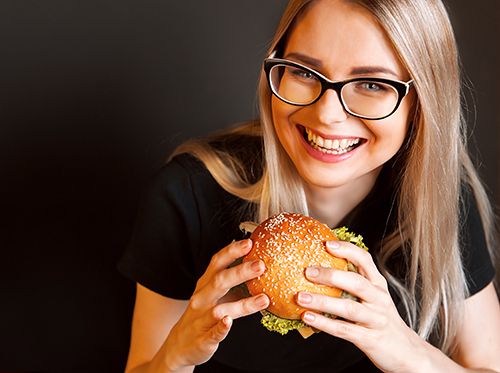
Sometimes food that’s good for your body isn’t necessarily the best for your teeth. Drs. Peter Vogel, Vijal Vadecha and our team want you to know which healthy foods can harm your teeth and gums, and what steps you can take to continue enjoying these foods, even when you’re dieting.
When you begin to substitute empty calories with whole foods, make sure you also remember to focus on your dental health. The majority of people tend to switch out sugary foods in favor of fruits and vegetables when they diet.
It’s worth knowing that most fruits are highly acidic and composed of natural sugars. Some of the highly acidic fruits to watch out for include apples, grapes, strawberries, pineapples, blueberries, oranges, and grapefruit. Moderation is key here, as with all other things. Fruits can be a great source of energy to help you through your day, but try not to overdo them.
Often, people also incorporate more leafy greens into their diets, which mean plenty of salads. Salad dressing is another item you’ll want to watch out for. Many dressings are filled with vinegars and sweeteners that include harmful acids, which change the pH of your mouth. When your mouth shifts from alkaline to acidic, your smile also turns to a higher risk for erosion and decay.
Rather than get rid of these foods altogether, simply change what you do after you eat them. Rinse your mouth out with water, brush your teeth, or eat alkalizing foods after consuming these acidic foods. Healthy alkalizing foods include dairy products such as eggs and yogurt, or any type of vegetable.
If you have questions regarding your current diet and its effect on your oral health, please contact our Anthem office and speak with a member of our staff. If you’ve begun to make changes in your diet toward a healthier lifestyle, we hope these tips can help your make positive changes to your oral health. Our team at Daisy Mountain Dentistry wants a healthy lifestyle to be a top priority in your life.
Oral Health Concerns Specific to Pregnant Women
July 15th, 2020

A lot of changes occur in a woman's body during pregnancy. Hormone fluctuations are responsible for many of those changes, including the need for additional attention to the teeth and gums. Women who are expecting are at an increased risk for oral health complications, including gingivitis and tooth decay, which can lead to irreversible damage. Fortunately, there are steps pregnant women can take to keep their teeth and gums in optimal health from the first trimester to delivery day. Today, Drs. Peter Vogel, Vijal Vadecha and our team at Daisy Mountain Dentistry thought we would share them.
At-home dental care
At-home dental care should not vary much from what you did prior to pregnancy. The American Dental Association recommends brushing at a minimum of twice per day using fluoridated toothpaste. Follow up with floss to keep bacteria from accumulating in hard-to-reach spaces.
Dental checkups
It is safe and recommended to continue visiting Drs. Peter Vogel, Vijal Vadecha for routine dental checkups and cleanings during pregnancy. However, it is very important to inform Drs. Peter Vogel, Vijal Vadecha about an existing pregnancy. Special steps must be taken to protect pregnant women from certain medications or X-ray radiation that could be harmful to a growing baby. On the other hand, avoiding teeth cleanings during pregnancy can lead to serious consequences, including advanced tooth decay and infection.
Food and cravings
It is no secret that pregnancy can cause a woman to crave specific foods. Sugary treats like candy, cookies, or sodas may satisfy a sweet tooth, but they can also cause serious dental problems when consumed frequently or without brushing afterward. Trade out these treats for naturally sweet fruits when possible, and never forget to brush and floss thoroughly after eating sugar-filled foods.
Signs of complications
It is important to know and recognize the signs of oral health problems during pregnancy; an early diagnosis usually translates to an easier, less-invasive treatment. Symptoms of potential problems include gums that easily bleed or are swollen, reddened, or painful. These are symptoms of gingivitis, which can lead to a receding gum line and tooth loss if left untreated.
Call our Anthem office if you experience any of these symptoms or pain in a tooth, loss of a tooth, a broken tooth, or bad breath that does not go away with brushing.
Crushing the Ice-Chewing Habit
July 8th, 2020

It's a habit many people have and not only can it be annoying to the people around you, it can be detrimental to your dental health. Chewing ice is so common that it even has its own name, pagophagia. We're not talking about a slushy or shaved ice (although those artificially sugary treats should be avoided too!) but more like the hunks of ice rattling around in the bottom of your glass.
Ice chewing can be a sign of emotional problems like stress or obsessive-compulsive disorder, but it can also be a marker for iron deficiency anemia and other physical problems. Then again, some people just like to have something to chew on. For whatever reason you find yourself chewing on it, it's a habit you need to break.
Chewing on ice can cause:
- Chipped and cracked teeth
- Damaged enamel
- Sore jaw muscles
- Damage to dental work such as crowns, fillings, or other appliances
If chewing on ice is becoming a problem in your life, don’t hesitate to speak with Drs. Peter Vogel, Vijal Vadecha about it. But if you find yourself still wanting to chew on something, here are a few alternatives to ice:
- Baby carrots
- Celery sticks
- Sugar-free (xylitol) gum
We know you need to chill sometimes, but chomping down your entire glass of ice is not the way to do it. If you have any other questions on the topic, feel free to talk with a member of our Anthem team. It may be beneficial in solving the issue and helping to remediate any damage to your teeth.
Happy Fourth of July
July 1st, 2020

Every year, Americans all over the world celebrate the birth of the country and its independence on the Fourth of July. There are countless ways that people celebrate and they range from community parades and large scale gatherings to concerts, fireworks displays, and smaller scale celebrations among family and friends. For some people, July 4th is synonymous with baseball, while for others it is all about the beach of barbecues. However you celebrate, you can be sure that red, white, and blue is visible everywhere throughout the area.
The Beginnings of Fourth of July Celebrations
Although it wasn't officially designated as a federal holiday until 1941, the actual tradition of celebrating Independence Day goes back to the time of the American Revolution (1775 – 1783). At the time of the American Revolution, representatives from the 13 colonies penned the resolution that ultimately declared their independence from Great Britain. The continental congress voted to adopt the Declaration of Independence on July 2nd of 1776. Two days later, Thomas Jefferson's famous document that is now known as the Declaration of Independence, was adopted by delegates representing the 13 colonies.
First States to Recognize the Fourth of July
In 1781, Massachusetts became the first state (or commonwealth) whose legislature resolved to designate July 4th as the date on which to celebrate the country's independence. Two years later, Boston became the first city to make an official designation to honor the country's birth with a holiday on July 4th. In that same year, North Carolina's governor, Alexander Martin, became the first governor to issue an official state order stipulating that July 4th was the day on which North Carolinians would celebrate the country's independence.
Fun Facts About the Fourth of July
- The reason the stars on the original flag were arranged in a circle is because it was believed that would indicate that all of the colonies were equal.
- Americans eat over 150 million hot dogs on July 4th.
- Imports of fireworks each year totals over $211 million.
- The first “official” Fourth of July party took place at the White House in 1801.
- Benjamin Franklin didn't want the national bird to be the bald eagle. He believed that the turkey was better suited to the coveted distinction. John Adams and Thomas Jefferson disagreed with him, and he was outvoted, so the bald eagle became the official bird of the United States.
For many, the tradition is something entirely different. Along the coastal areas of the United States, people may haul out huge pots to have lobster or other types of seafood boils. Others may spend the day in the bleachers at a baseball game, or at a park, cooking a great traditional meal over an open fire. No matter how or where you celebrate, one thing is certain: all Americans celebrate July 4th as the birth and independence of our country.
Drs. Peter Vogel, Vijal Vadecha and our team at Daisy Mountain Dentistry wish you a safe and happy Fourth of July!
The Importance of Oral Cancer Screenings
June 24th, 2020

In our continuing efforts to provide the most advanced technology and highest quality care available to our patients at Daisy Mountain Dentistry, we proudly screen our patients for oral cancer. The fact is, every hour of every day in North America, someone dies of oral cancer, which is the sixth most common diagnosed form of the disease. The five-year survival rate is only 50 percent, and oral cancer is one of the few cancers whose survival rate has not improved.
Oral cancer can occur on the lips, gums, tongue, inside lining of the cheeks, roof of the mouth, and the floor of the mouth. Symptoms of oral cancer may include a sore in the throat or mouth that bleeds easily and does not heal, a red or white patch that persists, a lump or thickening, ear pain, a neck mass, or coughing up blood. Difficulties in chewing, swallowing, or moving the tongue or jaws are often late symptoms. While there is no way to predict exactly which individuals will get oral cancer, there are some potential causes we want you to know about. In some cases, it is possible to minimize these risk factors.
- Age (most patients diagnosed with oral cancer are over the age of 40)
- Tobacco use, either from cigarettes or smokeless chewing tobacco
- Excessive alcohol consumption
- Persistent viral infections, such as HPV16
- A diet lacking or low in fruits and vegetables
Finding out you have oral cancer can be devastating news. If you are concerned that you might be at risk for developing oral cancer, talk to us about screenings and other things you can do to reduce your risk. Through a routine visual inspection, Drs. Peter Vogel, Vijal Vadecha and our team at Daisy Mountain Dentistry can often detect premalignant abnormalities and cancer at an early stage, when treatment is both less expensive and more successful, and can potentially save your life. Ask Drs. Peter Vogel, Vijal Vadecha and our team at Daisy Mountain Dentistry about a screening at your next appointment!
Fluorosis: What is it?
June 17th, 2020

Many people think dental fluorosis is a disease, but it’s not; it’s a condition that affects the appearance of your tooth’s enamel, not the function or health of the teeth. These changes may vary from tiny, white, barely noticeable spots to very noticeable staining, discoloration, and brown markings. The spots and stains left by fluorosis are permanent and may darken over time.
Dental fluorosis occurs in children who are excessively exposed to fluoride between 20 and 30 months of age. Only children ages eight years and younger can develop dental fluorosis. Why? That is the period when permanent teeth are still developing under the gums. For kids, fluorosis can cause significant embarrassment and anxiety about the appearance of their teeth. No matter how much they might brush and floss, the fluorosis stains do not go away.
Many well-known sources of fluoride may contribute to overexposure, including:
- Fluoridated mouth rinse, which young children may swallow
- Bottled water which is not tested for fluoride content
- Inappropriate use of fluoride supplements
- Exposure to water that is naturally or unnaturally fluoridated to levels well above the recommended levels
One way to reduce the risk for enamel fluorosis is to teach your children not to swallow topical fluoride products, such as toothpaste that contains fluoride. In fact, kids should use no more than a pea-sized amount of fluoride toothpaste when brushing, and children under the age of two shouldn’t use fluoride toothpaste at all.
Dental fluorosis can be treated with tooth bleaching, microabrasion, and conservative composite restorations or porcelain veneers. Please give us a call at our office to learn more or to schedule an appointment with Drs. Peter Vogel, Vijal Vadecha.
What is Remineralization?
June 10th, 2020

“What is the strongest substance in the body?” If this question comes up on trivia night, be prepared to impress your team when you confidently answer, “Tooth enamel!”
Tooth enamel? The reason for this surprising answer lies in the biology of our teeth. Minerals make up well over 90% of our enamel, a much higher percentage than is found anywhere else in the body, including our bones. But unlike bone tissue, which can heal and regenerate, tooth enamel cannot. Even though it is extremely strong, enamel can be damaged by a process called demineralization.
Demineralization
Demineralization is a result of acids at work in our mouths. Acids actually break down the minerals in our enamel, making the enamel softer. Over time, bacteria attack deeper into the tooth, eventually leading to decay. Acidic foods like sodas, citrus, pickles, and coffee are obvious culprits in providing an acidic environment, but there are other problem foods as well. We all have bacteria in our mouths, which can be helpful or harmful. The bacteria in plaque use the sugars and starches we eat to produce even more acids.
This process is something that takes place very quickly. In fact, even brushing too soon after eating something acidic can damage the demineralized surface of a tooth. Waiting at least 20 to 30 minutes to brush gives our bodies a chance to restore the enamel surface in a process called remineralization.
Remineralization
Our bodies are actually designed to help protect our enamel, and the most important part of this process is saliva production. Saliva cleanses our teeth and reduces levels of acidity. And our saliva constantly washes important minerals over our teeth. Calcium and phosphate ions rebuild and strengthen molecules where demineralization has taken place. This process is called remineralization.
We have other ways to help the remineralization process along. Fluoride toothpastes and fluoridated water speed up the movement of mineral building blocks back to the surface of the tooth. Fluoride also strengthens our teeth so that they resist acids and demineralization better than teeth without fluoride, making them less vulnerable to cavities.
New products are available for home and professional use that are designed to increase remineralization—talk to Drs. Peter Vogel, Vijal Vadecha at our Anthem office if you would like the latest recommendations. In fact, talk to us about tooth-friendly menus, the best toothpastes, brushing techniques, and all the ways to keep your enamel its healthiest. You’ll be answering all those trivia questions with a strong, confident smile!
Summer Break: An ideal time for wisdom teeth removal
June 3rd, 2020

After your son or daughter departs for college, the last thing you want to get is a call or text to learn he or she is in pain. Drs. Peter Vogel, Vijal Vadecha and our team at Daisy Mountain Dentistry will tell you there aren’t many emergency situations that can be avoided when it comes to dental health, but one crisis that can easily be prevented before your teen heads hundreds of miles away for college is wisdom tooth extraction.
What are wisdom teeth?
Wisdom teeth are the third set of molars that erupt in the late teen years to early 20s. Spacing and crowding problems often cause impaction and infections, which is why many people elect to have their wisdom teeth removed. Wisdom teeth can go from barely noticeable to extremely painful in a very short period of time.
When your teen’s wisdom teeth erupt, they may cause overcrowding of his or her teeth, which can have a negative effect on their alignment. Most people’s mouths do not have enough room for wisdom teeth to erupt fully and remain perfectly aligned. Thus, pain, swelling, infection, damage to adjacent teeth, and decay are often the most common problems associated with wisdom teeth. These problems can brew beneath the surface for weeks or months, offering no warning before painful symptoms hit.
If your child does elect to go through wisdom tooth extraction, we want to inform you that the first few days of recovery consist of careful measures to control bleeding and swelling, an adherence to a special soft diet, as well as a medication routine that must be followed as recommended by Drs. Peter Vogel, Vijal Vadecha after surgery.
Drs. Peter Vogel, Vijal Vadecha and our team are dedicated to providing exceptional service before, during, and after your wisdom tooth procedure, so you can have peace of mind knowing that your child’s oral health is in good hands. We will do everything we can to minimize discomfort and help your child heal safely and quickly.
Summer break is the perfect time to remove wisdom teeth so that your child can avoid the stressful scenario of experiencing this medical emergency far away from home. If you have any questions on wisdom teeth removal or to schedule an initial consultation with Drs. Peter Vogel, Vijal Vadecha, give us a call today!
Easing Your Allergies with Latex-Free Dentistry
May 27th, 2020

Imagine this scenario: you go to the dentist to have a cavity filled, and an hour after the procedure you have a runny nose, scratchy throat, and your arms are breaking out in blotchy, red hives. In other words, you’re in worse shape after the visit to the dentist than you were before you walked in to have the cavity fixed. If you experience any of these types of symptoms or side effects, chances are you have a latex allergy.
What is a latex allergy?
A latex allergy is a hypersensitivity to latex proteins. If you have this allergy, the Centers for Disease Control and Prevention recommend that you avoid direct contact with any materials that contain latex. While latex gloves are known to cause allergic reactions in people with a latex allergy, certain metals, plastics, and other materials used in dental care can also cause an adverse response.
A runny nose and itchy eyes are common allergic reactions to latex. However, Drs. Peter Vogel, Vijal Vadecha and our team at Daisy Mountain Dentistry want you to know it can also trigger more severe symptoms, including asthma, wheezing, and cardiovascular and gastrointestinal ailments.
A latex-safe dental environment
Many dental offices screen patients for a latex allergy. This is only beneficial, however, if you’re already aware you have a latex allergy. The best thing you can do to ease your allergies is to find a dentist who has a latex-safe environment. A latex-safe dental environment observes the following protocols:
- All patients are screened for a latex allergy.
- No personnel use latex gloves.
- All latex products are removed from the patient’s vicinity, including rubber dams and elastics.
- Work areas contaminated with latex powder are cleaned frequently.
- Signs are posted to communicate all latex allergy procedures in case of an emergency.
If a latex allergy is part of your medical history, then it’s in your best interest to find a latex-free dental environment. To learn more about latex-free dentistry, or to schedule an appointment with Drs. Peter Vogel, Vijal Vadecha, please give us a call at our convenient Anthem office!
Most Valuable Dental Treatments
May 13th, 2020

At Daisy Mountain Dentistry, we work to find a dental plan that will work best and most effectively for you. But we’ve found that three treatments tend to be the most common and useful. If you ever find yourself in any of the following situations, we suggest you look at these options.
If you’ve lost teeth due to trauma, fracture, or decay, dental implants are a great choice. With all the technology available to us now, dental implants look and function exactly the way a natural tooth would. They blend in perfectly and are custom made to fit you. They’re a great investment that will restore the balance to your smile.
If you struggle with stress and catch yourself clenching or grinding your jaw, you may want to consider a bite guard. Constant grinding of teeth is dangerous for fillings and crowns, as well as natural teeth. It can cause serious joint inflammation as well as headaches. Luckily, bite guards can be worn night or day (depending on what you need), and are a great way to prevent further grinding.
Finally, there’s teeth whitening. It’s not uncommon for patients to want to brighten their smile, and the best way to do it by far is with in-office tooth whitening. There are many DIY options out there, of course, but in-office whitening has greater benefits.
When the whitening gel is applied to your teeth, we make sure your gums are protected. The results are generally faster and last longer with this approach, as well. Other methods may work, but they typically don’t last as long; sometimes they may not fully whiten all areas of your teeth.
No treatment is as easy and free of challenges as it seems. You still have to care for implants like regular teeth, which means no skimping on brushing and flossing just because they’re fake. Bite guards must be worn regularly to be effective. They also must be customized for your teeth; otherwise, they can be uncomfortable.
Whitening may cause temporary sensitivity in some mouths. For others, genetics may prevent you from achieving the precise shade you want.
If you have additional questions, feel free to call our Anthem office. Our team is here to help you achieve your best possible smile!
Is dairy crucial to my child's oral health?
April 29th, 2020

Healthy eating, combined with regular physical activity, plays a vital role in your child’s health and well-being. Dairy foods are naturally nutritious, packed with ten essential nutrients that help your child feel good for life. But did you know that dairy is also great for your child’s dental health? Our team at Daisy Mountain Dentistry will tell you that, in addition to providing large amounts of much-needed calcium, dairy products also help fight cavities! Dairy products have a specific role to play in dental health as they contain a unique combination of special anti-decay nutrients such as calcium, phosphorus, and the protein, casein. Cheese is especially useful, as eating a small piece of cheese after consuming sugary foods or drinks can help protect teeth and reduce the risk of tooth decay.
If you’d like to know more about the importance of dairy products in your child’s diet, or about any aspect of your child’s dental health, feel free to ask Drs. Peter Vogel, Vijal Vadecha at your next appointment!
Every Day is Earth Day
April 22nd, 2020

During the early days of the environmental awareness movement, those who demonstrated against pollution, toxic chemicals, and the general public health were known as hippies. The early 1970s were a time of change, and assertions that we needed to pay more attention to the Earth's atmosphere were generally dismissed. But within a couple decades, it had become clear that the previous generation was right; the citizens of the world needed to become more environmentally conscious.
Many people feel that they can't make a difference if they don't do something big. But caring for the environment doesn't have to be an all-or-nothing concept. In fact, the little things you do can add up to make a great impact, especially in our community. Here are a few ways you can help the environment on Earth Day, April 22nd and all year around.
Four Small Ways to be Environmentally Friendly
- Recycle Your Textiles. Nearly 21 million tons of textiles are added to American landfills each year, according to the Environmental Protection Agency. Donating your unwanted clothing to a secondhand store or an organization that repurposes fabric helps cut down on solid waste and conserves natural resources.
- Reduce Usage of Disposables. Plastic bottles and bags, disposable diapers and other things we can use and toss out are convenient, but they're not necessary. Simply choosing to replace one of type of disposable with a reusable product can help you cut down on waste that has a large negative impact on our environment.
- Conserve Water. If everyone in the United States turned off the water while brushing their teeth, more than 1.5 million gallons of water could be conserved. Turn the water on long enough to wet your toothbrush for brushing and rinsing, and then immediately turn the water off again.
- Turn Off the Lights. Flip the light switch to "Off" if you're going to leave a particular room for 15 minutes or more. This will conserve energy on incandescent light bulbs and cut down on cooling costs.
It's not necessary to be an activist or install solar panels all over your home to help the environment. Although you can do these things, the little everyday measures make a big difference in helping to conserve energy and the environment, while reducing your carbon footprint. Our team at Daisy Mountain Dentistry wants to remind you to celebrate Earth Day and help the environment, knowing that it will benefit your and your children's generation.
Dental X-Ray Safety
April 15th, 2020

It's easy to be skeptical about X-rays whether we speak of a full-body X-ray or a dental X-ray. Radiation is radiation. It's vital to know all the facts before judging too harshly, though. Dental X-rays can be one of the best preventive tools for your dental health. We offer various treatments at Daisy Mountain Dentistry, but helping you become better informed is one of the best ways to decide what will be best for you.
According to the AmericanDental Association, healthy adults typically receive routine dental X-rays every two to three years. The timeline for children is every one or two years, and one and a half for teens. Children and teens require more X-rays than adults because their teeth are still developing, which makes them more susceptible to cavities.
In general, Drs. Peter Vogel, Vijal Vadecha will determine how often dental X-rays need to be taken for each individual patient, taking into consideration physical symptoms, clinical findings, and risk for infection. Most dental professionals use Caries Management by Risk Assessment (CAMBRA) to help them determine how often X-rays should be taken, so you can rest assured that we are making an informed decision.
In addition to that, it should be reassuring to know that these days, most dental X-rays are digital, which significantly reduces your exposure to radiation. In fact, you’re likely to pick up more radiation just from being in the sun! Lead aprons and thyroid collars are also tools that Drs. Peter Vogel, Vijal Vadecha and our team use to keep X-ray exposure to a minimum.
At our office, we believe that diagnosing cavities and other potentially harmful conditions by dental X-ray does you more good than harm. If you have any questions about our X-rays, feel free to give our Anthem office a call or bring up the subject during your next appointment!
The ABCs of Vitamin C
April 8th, 2020

A as in Ascorbic Acid
Ascorbic acid is just another name for vitamin C, which is one of the so-called “essential nutrients.” These are nutrients that are necessary for our bodies to function properly, and which must be supplied through our diets. Why is ascorbic acid essential?
First and foremost, because we have to have vitamin C for the formation of collagen.
We’ve probably all seen the ads promoting collagen as a fountain of youth for our skin. Whether or not a cream can turn back time is a matter for debate, but there’s no question as to the vital role collagen performs in our own bodies. That’s because collagen is the substance that provides both structure and support to our tissues, forming the basis of the connective tissue that holds us together. (The Greek root “kolla” means glue!) Organs, blood vessels, muscles, bones, skin, even the dentin in our teeth all rely on collagen to function.
And if that weren’t enough for one vitamin, vitamin C also helps the body repair tissue, absorb iron, form teeth and bones, produce neuro-transmitters, and acts as an antioxidant. Whew! So, how often should we be eating foods rich in vitamin C? Maybe more often that you would think.
B as in Biology
The human body is an amazing thing! We can store many of the essential nutrients we need to keep ourselves healthy in our livers and fat tissue, even if fresh food sources aren’t immediately available. Unfortunately, Vitamin C is one of those vitamins that we can’t store in the body. This means that unless we get the vitamin C we need in our diet on a regular basis, we’ll experience vitamin C deficiency. How serious is that?
The importance of vitamin C to our health can’t be overstated. Vitamin C deficiency over a period of months actually causes a serious disease called scurvy. Without vitamin C, collagen formation breaks down. And when collagen breaks down, it leads to the breakdown of all those parts of the body that rely on collagen. In the short term, scurvy causes gum pain, fatigue, weakness, and body aches. Over longer periods, scurvy can lead to bruising, skin hemorrhages, anemia, tooth loss, severe gum disease, organ failure, and even death.
Luckily for us, scurvy is largely a disease of the past, thanks to the easy availability of fresh fruits and vegetables which provide us with vitamin C. So, which items should we add to the shopping list?
C as in Citrus—and So Much More!
When we think vitamin C, we instantly picture citrus fruits. Oranges, lemons, limes, grapefruit, and all their cousins are a wonderful source of vitamin C. Looking for a little more variety? You’re in luck! Fruit fans can load up on strawberries, kiwi fruit, mangos, and papayas. Love your veggies? Red peppers, kale, cauliflower, Brussels sprouts, and broccoli contain more vitamin C per serving than a medium orange. You can also take vitamin C supplements, but be sure to follow the recommended dosage. You can have too much of a good thing.
While we’re here, let’s add one last letter to the list:
- D as in Dental Health
So, why are we talking about vitamin C on a dental blog? Because vitamin C is essential to our dental health. Healthy gum tissue, strong connective tissues that hold our gums to our teeth and our teeth in our jaws, faster healing, antioxidants—all have been linked to a diet rich in vitamin C.
Careful brushing and flossing, regular checkups and cleanings at our Anthem office, a balanced diet—these are all ways you can be proactive when it comes to your dental health. Talk to Drs. Peter Vogel, Vijal Vadecha about the best vitamins and minerals for healthy teeth and gums. Vitamin C is a great beginning, but there’s still an alphabet from vitamin A to Zinc left to go!
April is National Facial Protection Month
April 1st, 2020

The Importance of Facial Protection
Americans from all walks of life should mark April as National Facial Protection Month on their calendars. The American Association of Pediatric Dentistry, Academy for Sports Dentistry, American Academy of Pediatric Dentistry, and American Association of Oral and Maxillofacial Surgeons have combined forces to sponsor this annual campaign, which aims to educate and remind us of the importance of protecting our face and teeth against impacts and injuries.
Wearing a helmet can save your life and prevent devastating physical damage in a variety of situations, from playing football to riding a bicycle. According to the American Association of Oral and Maxillofacial Surgeons, helmets reduce the risk of various head injuries by as much as 85 percent. Whether helmet laws apply in your area or not, Drs. Peter Vogel, Vijal Vadecha and our team at Daisy Mountain Dentistry want you to make sure you and your loved ones wear helmets with the appropriate safety ratings for specific activities. (A sticker on or inside the helmet will usually indicate this rating.) Helmets can also help save your teeth if they come with an attached faceguard, an essential addition for football players and others involved in contact sports.
Preventing Dental Injuries
A mouthguard can protect you against a variety of dental injuries, such as cracked, broken, or knocked-out teeth. The American Dental Association states that mouthguards play an essential role in preventing up to 200,000 dental injuries each year, and many states mandate their use for sports activities such as football and hockey. The Academy for Sports Dentistry warns, however, that these mouthguards must be custom-fitted as precisely as possible to prove effective. Have a professional-quality mouthguard molded and fitted by our team at Daisy Mountain Dentistry for better protection than a generic store-bought or “boil-and-bite” variety can offer. These cheaper versions tend to wear out quickly, interfere with proper breathing, and provide uneven degrees of cushion against impacts. Always have a fresh mouthguard fitted for each new sports season.
Choose the right combination of helmet, faceguard, and mouthguard to protect your teeth and face this April, and tell your friends to do the same! To learn more about mouthguards, or to schedule an appointment with Drs. Peter Vogel, Vijal Vadecha, please give us a call at our convenient Anthem office!
Good Nutrition Leads to Healthy Mouths
March 4th, 2020

At Daisy Mountain Dentistry, we know the most common oral health diseases are tooth decay and periodontal disease (or gum disease), and both are among the easiest to prevent. One of the most common ways we recommend to boost your oral health is by improving your diet, because you (and your mouth) truly are what you eat. A healthy diet can lead to a healthy mouth and body, while an unhealthy diet can lead to the exact opposite.
The Role Nutrition Plays
While diet is not the only factor that leads to periodontal disease, studies suggest the disease may be more severe among patients whose diets lack essential nutrients. Poor diets will generally lead to a weaker immune system, leaving your body susceptible to all kinds of ailments, including periodontal disease.
A Well-Balanced Approach
There is no “magic” diet that we can recommend to improve your oral health, but the most important thing is to seek a well-balanced approach in your eating. While fad diets that emphasize one food group over another may help you lose weight in the short-term, they probably will not provide all the nutrients your body needs in the long run.
Meals should include a balance of lean meats or other healthy protein sources, colorful fruits and vegetables, whole grains, low-fat dairy, and healthy fats. Foods containing substantial amounts of sugar and salt should be consumed in moderation.
Soda and Sugar: A Dangerous Duo
Millions of gallons of soda are consumed every day in America, but sipping a cold soft drink can be very harmful to your teeth. Many of these beverages wear down the enamel that protects the teeth, which weakens and even destroys them over time. The American Beverage Association estimates that soft drinks account for almost 30 percent of all drink consumption in the U.S., averaging an annual total of about 50 gallons per person (up from only 20 gallons in the 1970s). For healthy teeth and a healthy body overall, try to limit your soda intake.
Sugar is another ubiquitous treat in our daily lives. When we eat sugar, naturally occurring bacteria in our mouths convert it to acids that attack tooth enamel. Consuming too much sugar can swiftly lead to tooth decay, cavities, and gum diseases like gingivitis. Most people do not even realize how much sugar they consume each day. It’s important to limit your daily sugar intake by reading the labels of all the food you eat, and sticking with natural food sources that are low in sugar, especially ones that minimize added sugar, such as fruits and vegetables.
If you have questions about your diet and how it may be affecting your oral health, talk to Drs. Peter Vogel, Vijal Vadecha about it. See you soon!
Improve your oral health with xylitol!
February 26th, 2020

Xylitol tastes sweet, but unlike sugar, it is not converted to acid that can cause your teeth to decay. It’s a naturally occurring sweetener found in plants, fruits, and vegetables; even the human body produces it in small amounts. Xylitol is widely used in sugar-free chewing gum, mints, candies, and even certain forms of medicine.
The World Health Organization has approved xylitol because only a small amount is needed for its health benefits. It’s even safe for diabetics, with a glycemic index of only seven. Xylitol has 40% fewer calories than other types of carbs: less than three calories per gram.
So how can this natural sweetener benefit your oral health? Take a look at the facts. Tooth decay starts when bacteria consumes the sugars left in your mouth. When you eat sugary foods, the bacteria on your teeth will multiply and make acid that can destroy your enamel.
Xylitol is derived from fibrous parts of plants, so it does not break down like a regular sugar. It actually helps maintain a neutral pH level in the mouth, which in turn prevents bacteria from sticking to the teeth. The bacteria are then unable to digest xylitol, which means your teeth won’t develop enamel damage and cavities.
Studies have shown the consumption of xylitol as a sugar substitute or a dietary addition had a dramatic reduction in new cavities and even reversed existing cavities. These effects are long lasting: low cavity rates remained years after the trials were done.
When there’s less bacteria and acid in your mouth due to xylitol, your teeth stay healthier. The more frequently it’s ingested, the more you will prevent enamel damage.
Aim to consume around five grams a day, or one gram every three hours if possible. You can do this by consuming gum, tablets, candy, or mints that have xylitol as one of the first ingredients after your meals. You can find these products in health food stores and specialty grocery stores.
Since xylitol replaces sugar on a one-to-one ratio, it’s used in several common items:
- Toothpaste
- Mouth rinse
- Baby oral wipes, gel, and pacifiers
- Nasal wash
- Dry mouth spray
- Granulated forms for cooking
- Granulated packets to add to drinks
- Commercially prepared foods
Make sure to pick up items that contain xylitol the next time you’re at the store! This is an easy way to maintain great oral health. If you have specific questions about xylitol, ask Drs. Peter Vogel, Vijal Vadecha during your next appointment at our Anthem office.
Osteoporosis and Dental Health
February 19th, 2020

What do we know about osteoporosis? We may know that this disease makes the bones more brittle and vulnerable. We may know that osteoporosis is the cause of many a broken hip or curved spine as we age. We may even know that, for a number of reasons, women are far more likely to develop this disease. What we may not be aware of is the impact osteoporosis can have on our dental health.
“Osteoporosis” means “porous bones.” It is a disease that makes the bones more likely to fracture or break, as the body’s careful balance of absorbing old bone tissue and replacing it with new healthy bone tissue is disrupted. We lose bone tissue faster than we can create new, dense bone tissue. Why is this important for our dental health? Because the fitness of our teeth depends on the fitness of the bones surrounding and securing them in our jaws.
How does osteoporosis affect dental health?
- Osteoporosis reduces density in the bones and bone tissue that hold our teeth in place. Studies have shown that women with osteoporosis have significantly more tooth loss than women without the disease.
- Periodontitis, or gum disease, can also cause deterioration in the bone surrounding the teeth. This is a time to be proactive with gum health to avoid infections and further bone loss.
- Denture wearers may find that their dentures no longer fit properly due to changes in bone structure. Bone loss needs to be addressed promptly to avoid having to replace dentures.
- Rarely, bone-strengthening medications for osteoporosis can lead to serious jaw problems after dental procedures that involve the jawbone (such as extractions). Always tell us any medications you are taking before we schedule any dental treatment.
Unfortunately, osteoporosis often has no symptoms at all—until the first bone fracture. Checking our bone density is important as we age, and one way of discovering changes in bone density is through your regular dental checkups at our Anthem office. We can pinpoint changes in your X-rays through the years and will recommend that you see your physician if there is any indication of bone loss. If you have already been diagnosed with the disease, we have ideas to help maintain the health of your teeth and bones.
Many factors can increase your chance of developing osteoporosis. Age, illness, personal habits, medications, diet, genetics—any number of conditions can affect our bone health. Talk to us about osteoporosis. Drs. Peter Vogel, Vijal Vadecha would like to work with you to provide prevention and treatment to keep your teeth and bones strong and healthy for a lifetime of beautiful smiles. And that’s certainly good to know!
The Origins of Valentine's Day
February 12th, 2020

When we think of Valentine’s Day, we think of cards, flowers, and chocolates. We think of girlfriends celebrating being single together and couples celebrating their relationship. We think of all things pink and red taking over every pharmacy and grocery store imaginable. But what Drs. Peter Vogel, Vijal Vadecha and our team would like to think of is when and how this joyous, love-filled day began.
Several martyrs’ stories are associated with the origins of Valentine’s Day. One of the most widely known suggests that Valentine was a Roman priest who went against the law at a time when marriage had been banned for young men. He continued to perform marriage ceremonies for young lovers in secret and when he was discovered, he was sentenced to death.
Another tale claims that Valentine was killed for helping Christians escape from Roman prisons. Yet another says that Valentine himself sent the first valentine when he fell in love with a girl and sent her a letter and signed it, “From your Valentine.”
Other claims suggest that it all began when Geoffrey Chaucer, an Englishman often referred to as the father of English literature, wrote a poem that was the first to connect St. Valentine to romance. From there, it evolved into a day when lovers would express their feelings for each other. Cue the flowers, sweets, and cards!
Regardless of where the holiday came from, these stories all have one thing in common: They celebrate the love we are capable of as human beings. And though that’s largely in a romantic spirit these days, it doesn’t have to be. You could celebrate love for a sister, a friend, a parent, even a pet.
We hope all our patients know how much we love them! Wishing you all a very happy Valentine’s Day from the team at Daisy Mountain Dentistry!
What is hyperdontia?
February 5th, 2020

When a child is born, he or she will have 20 primary teeth and 32 permanent teeth. But sometimes kids are born with additional teeth, and our team at Daisy Mountain Dentistry calls this oral condition "hyperdontia." Primary teeth are the first set of teeth that erupt in your child's mouth, typically by the time they are 36 months old, and are shed by the time your child reaches the age of 12. Permanent teeth then take the place of the primary teeth and are usually fully-erupted by the time your son or daughter reaches 21 years of age. Anyone who develops more than 20 primary teeth or more than 32 permanent teeth has hyperdontia, and the additional teeth are referred to as supernumerary teeth.
While the cause of hyperdontia is not entirely clear, it is believed that there may be a genetic factor. Oral professionals have found that patients with extra teeth often have syndromes like cleidocranial dysplasia, Ehler-Danlos syndrome, Gardner syndrome, or cleft lip and palate. The prevalence of hyperdontia affects between one and four percent of the population in the United States, and the majority of cases are limited to a single tooth.
So, what is the best way to deal with hyperdontia? It really depends on the case. The treatment plan your doctor suggests varies according to the potential problem posed by the supernumerary teeth, as well as their type. Orthodontic treatment may certainly may help, but extraction can also be a good option. We recommend that children receive an oral evaluation or checkup no later than the age of seven. In addition to hygiene evaluation, this helps ensure your child does not experience hyperdontia problems.
If you suspect you or your child may be suffering from hyperdontia, please give us a call to schedule an appointment at our convenient Anthem office to be evaluated.
Be Good to Your Gums
January 29th, 2020

You brush and floss thoroughly twice a day. You have regular checkups. Everything seems fine on the periodontal radar. Sometimes, however, even healthy gums can become sensitive and irritated. Is it something you did? Maybe! Here are some common causes of gum irritation and sensitivity that you might not be aware of.
- Brushing Bravado
One of the most important tools for gum health is one we use at least twice a day—the simple toothbrush. Two minutes at night and two in the morning reduce the bacteria and plaque that lead to serious gum disease, known as periodontitis. And while preventing tooth decay and gum disease are the primary goals of brushing, let’s also protect delicate gum tissue from injuries and irritation caused by too-forceful brushing.
Try using a brush with soft bristles and brushing with short strokes and gentle pressure, especially if you know you have a tendency to be a bit heavy-handed. Massaging rather than scrubbing will clean teeth and gums just fine.
- Fierce Flossing
Just because we can use dental floss to slice cakes or cookie dough logs doesn’t mean we should apply the same pressure to our gums! While a firm sawing motion seems like the obvious way to clean between teeth and gums, you can actually cause irritation and bleeding that way.
Insert the floss between your teeth carefully, bring it to the gumline, and move the floss with gentle pressure up and down and around the tooth surface. This technique will make sure that you remove food particles and plaque from beneath the gumline without causing your gums any trauma. Ask us about the best flossing techniques—we know them all.
- Appliance Aches
You know how helpful your braces/retainers/mouth guards/dentures are. You just wish that your helpful appliance was a little less irritating to sensitive gum tissue.
This is a problem that often disappears as you get used to your new appliance. But if pain or irritation persists or gets worse, give us a call. We want to make sure your appliance fits properly, and make any necessary adjustments to ensure your comfort.
- Peroxide Problems
Most home whitening kits use peroxide-based gels or treated strips to remove surface stains from the teeth. Those same bleaching agents that make enamel whiter can also cause gum sensitivity and irritation. If you use whitening strips or gel trays, be careful to keep the peroxide solution away from gum tissue. But because these systems are one-size-fits-all, that is often easier said than done.
If you have sensitive gums, one solution is a professional office whitening. We’ll check on your gum (and tooth) health first, and monitor and protect your gums throughout the procedure. If you still want to whiten at home, we can create custom trays for you that will provide more complete exposure to the whitening solution for your teeth, and less exposure for your gums, than over-the-counter products.
- Still Smoking?
Studies have shown a strong link between gum health and smoking and other forms of tobacco use. Smokers are much more likely to suffer from gum disease than non-smokers, and those who have smoked for a long time, or who smoke heavily, have an even higher risk of developing periodontal disease. Some studies suggest that smokers don’t respond as well to treatment as non-smokers. Unfortunately, it appears that smoking and tobacco use help mask the obvious symptoms of gum disease (redness and bleeding), which could lead smokers to delay getting treatment. If you smoke, talk to us about ways to quit.
We talk a lot about periodontal health because it is so important. Periodontitis can lead to infection, loss of bone around the tooth, and even eventual tooth loss. If you are suffering from any of the signs of gum disease—swelling, redness, bleeding, pain—give our Anthem office a call. Whether it’s as simple as making a few lifestyle changes, or a problem requiring professional dental treatment, being proactive with your dental care is more than good for your gums—it’s good for your health!
Antibiotic Prophylaxis or Premedication
January 22nd, 2020
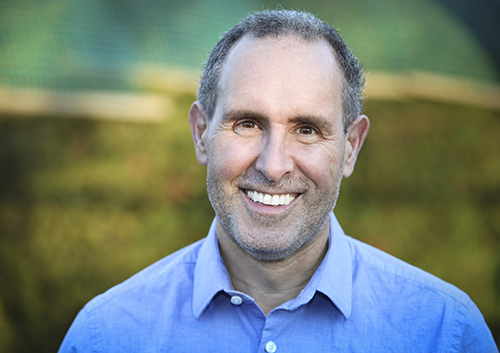
In years past, it was often recommended that dental patients who had a history of heart problems or other conditions, such as joint implants, be given antibiotics before any dental work. This pre-treatment is called prophylaxis, based on the Greek words for “protecting beforehand.” Why would Drs. Peter Vogel, Vijal Vadecha suggest this protection? It has to do with possible effects of oral bacteria on the rest of the body.
Our bodies are home to bacteria which are common in our mouths, but which can be dangerous elsewhere. If these oral bacteria get into the bloodstream, they can collect around the heart valve, the heart lining, or blood vessels. A rare, but often extremely serious, infection called infective endocarditis can result.
It is no longer recommended that every patient with a heart condition take antibiotics before dental procedures. Doctors worry about adverse effects from antibiotics or, more generally, that an overuse of antibiotics in the general population will lead to more strains of antibiotic-resistant bacteria.
There are some patients, however, who are at a higher risk of developing infective endocarditis, and who should always use preventative antibiotics. Generally, premedication is advised if you have one of these risk factors:
- A history of infective endocarditis
- Certain congenital heart conditions (heart conditions present since birth)
- An artificial heart valve
- A heart transplant
Your cardiologist will know if prophylaxis is advisable, and if you are taking any drugs which could interact with antibiotics. Always talk to your doctor about any dental procedures you are planning, particularly if they are invasive procedures such as gum surgery or extractions.
If you believe you would benefit from antibiotics before dental treatment at our Anthem office, the most important first step is to talk with your doctors. We are trained to know which pre-existing health conditions call for prophylaxis, which dental procedures require them, which antibiotics to use, and when to take them. Tell us about any health conditions you have, especially cardiac or vascular issues, and any medication allergies. Working with you and your doctor to protect your health is our first priority, and having a complete picture of your medical health will let us know if antibiotic prophylaxis is right for you.
Sleep Apnea: How we can help
January 15th, 2020

At Daisy Mountain Dentistry, we understand that getting high-quality sleep is vital to maintaining your overall health. Insufficient sleep can lead to an inability to concentrate, motor vehicle accidents, and difficulty performing at work. Since approximately 18 million Americans suffer from sleep apnea, this poses a significant public health problem. If you think you may have sleep apnea, talk to Drs. Peter Vogel, Vijal Vadecha and our team about devices that can help you get a good night’s rest.
What is sleep apnea?
Sleep apnea is a relatively common disorder in which breathing stops or becomes very shallow during the night. These bouts of paused breathing may last a few seconds or as long as several minutes. When 30 or more breathing interruptions occur per hour, sleep apnea leads to dramatic reductions in sleep quality. In many cases, this condition is caused by your airway becoming blocked or collapsed during sleep.
Anyone can get sleep apnea, but there are certain factors that increase your risk. Having small airways, being overweight, being male, or having a family history of sleep apnea increases the likelihood that you will develop the disorder. If you think you have sleep apnea, visit highly encourage you to visit our Anthem office for a thorough physical exam, comprehensive medical history, and a sleep study.
Treatment Options
Several treatment avenues are available for people with sleep apnea. One popular option is to wear an oral appliance. For example, a mandibular advancement device (MAD) looks like a sports mouthguard and slightly repositions your jaw, to keep your airway unobstructed. Another option is a tongue-retraining device (TRD), which holds your tongue in place to ensure that your airway stays open during the night.
For individuals with mild-to-moderate sleep apnea, dental devices are a smart option. Many patients enjoy improved sleep, reductions in snoring, and less fatigue during daytime hours. If you’re curious about getting an oral appliance to help with your sleep apnea, please consult our team at Daisy Mountain Dentistry. After a consultation and examination, we can fit the type of device that works best for your condition.
Been a While? Come See Us!
January 8th, 2020

Guilt is a powerful feeling. It can keep you from doing many things, including going to the dentist. The good news is that Daisy Mountain Dentistry is a judgement-free zone, and coming back (even after an extended period of being MIA) can be easier than you think. Our goal is to make you as comfortable as possible during your first appointment back with us — so here’s a little overview of what you can expect.
We’ll start with a series of dental X-rays, which are usually taken every three to five years. The set of X-rays will depend on your individual needs and it will help us get a more thorough look at what’s going on with your dental structure and keep an eye out for any prominent dental issues.
Next up will be your hygiene appointment. That appointment will consist of a review of your medical history and be followed by a thorough cleaning of your teeth. This is the perfect time to share concerns you may have about your oral health and ask us questions.
You’ll finish up with a comprehensive exam, which will review everything you covered with the hygienist. Drs. Peter Vogel, Vijal Vadecha will go over your medical history with you and address any dental concerns that might remain. If any special treatment is needed for such issues as cavities or broken fillings, we will discuss that with you as well.
Once all that is done, you’ll head over to the front desk to talk about payment and scheduling your next appointment. And that’s it! Your first visit back is an important step toward continuing to look out for your dental health.
Just because you slacked for a little while or life got in the way, this doesn’t mean things have to stay that way! We’re happy to help you get you back on track, so schedule an appointment at our Anthem office today!
Smile, the New Year is Almost Here!
January 1st, 2020

We’ve been celebrating the new year for a really, really long time. It goes way back, but it started formally in 1582, when Pope George XIII made January 1st the official holiday for ushering in the new year. The idea was to yell, cheer, and blow horns to scare away all the evil spirits of the previous year with the hope that the new one would be filled with happiness and opportunity.
While scaring away evil spirits isn’t what’s on our mind these days, we still ring in the New Year by cheering and hollering with friends and family. It’s a time to set new goals, refocus on old ones, and look forward to all the surprises the coming year will bring.
Whether you’re saying hello to the New Year snuggled up at home on your couch in the Anthem area or by gathering your friends for a social celebration, here are some tips to help ensure you welcome this new chapter with a smile.
Tips for a great New Year’s Eve celebration from Daisy Mountain Dentistry
- Stay safe. This one’s vital, because nothing puts a damper on your party like an emergency trip to the hospital. Stay responsible and try to plan ahead, whether that means taking a taxi, staying with a friend, or recruiting a designated driver. Do what you have to do to keep yourself and everyone around you safe.
- Spend time with the people you love most. The way we see it, the whole point of the holiday season is to cherish your family and friends. Regardless of what you’re doing, make sure there’s something for everyone. It’s essential to do something the whole group will enjoy!
- Smile! Whether you get all dressed to go out or have a quiet gathering with family and friends, make sure you accessorize with a smile. There’s always something to smile about!
We can all agree that change can be scary sometimes, but ringing in the New Year is an observance we all welcome with open arms. We hope you’ll enjoy this transitional holiday in a fun, healthy, and safe way. You have endless possibilities ahead of you!
From Drs. Peter Vogel, Vijal Vadecha, have a fantastic New Year!
How Tooth-Colored Fillings Improve Your Smile
December 25th, 2019

Today’s crowns, veneers, and tooth colored fillings are very natural looking compared to early counterparts. There was a time when dentists placed silver fillings exclusively. This material is still used, however the most common material used today in fillings is composite, tooth-colored fillings. Composite fillings can be made to match any shade of tooth and even let light travel through them like natural enamel.
Composite fillings are great in many different scenarios. The most obvious reason is when a cavity is present. This is an excellent way to seemingly erase the imperfection that once was. It is almost as if the cavity was never there.
Placing composite fillings to reshape teeth can also minimize excessive spacing. In the case of a diastema, (a large space between the two front teeth) composite material is a non-invasive and cost-effective choice that provides instant results. It can be an alternative to braces.
Mottled enamel is a symptom of fluorosis, which causes discoloration and imperfections in the enamel. Composites are the material of choice for masking this condition.
Composite fillings are easy to place, easy on the eyes, and easily repaired. With skill and good composite material, a filling can be easily disguised. This look is desired most in our society today, where dental perfection is now standard.
In conclusion, your smile is in good hands with composite fillings. There are some great materials that give a near perfect match to the appearance of natural tooth enamel. Smile with confidence knowing no one ever has to know. Your secret is safe with us at Daisy Mountain Dentistry!
Heart Disease and Oral Health
December 18th, 2019

According to the National Institute of Dental and Craniofacial Research, more than 200 million Americans suffer from some degree of inflammation of the gums. Over the past decade, researchers have published studies that link the bacteria involved in periodontal disease to cardiovascular disease. The Centers for Disease Control and Prevention have connected oral infections to heart disease, diabetes, stroke, and low birth weights.
Studies suggest bacteria that cause periodontal disease are also responsible for causing a thickening of the carotid arteries, which increases the chance of a heart attack or stroke. Further research is being conducted to understand the link between oral health and heart disease better.
What is periodontal (gum) disease?
Drs. Peter Vogel, Vijal Vadecha and our team at Daisy Mountain Dentistry hear this question all the time. Periodontal disease is an infection. Our mouths are filled with bacteria, and this bacteria forms plaque. If the plaque is not removed through brushing, flossing, and regular cleanings at the dentist, it hardens into tartar. If gingivitis (gum inflammation) is not treated early, it can advance to periodontitis. Bacteria get under the gum tissue and erode it as well as the bone that supports the teeth. The gums eventually pull away from the teeth, and infected pockets form.
Proving that periodontal gum disease is connected to heart disease has been difficult for researchers. However, there are two theories about to what might connect the processes.
- Bacteria are released in the bloodstream through chewing and tooth brushing. The same species of bacteria that causes gum disease has been discovered in the plaque in arteries in the heart.
- Inflammation in the mouth is a catalyst for inflammation throughout the rest of the body.
Practice good oral health habits
While the link between periodontitis and heart disease is not yet fully understood, you can prevent the possibility of health complications by practicing good oral health. It’s recommended that you brush and floss twice a day, as well as visit your dentist twice a year for a cleaning and exam. Oral health should not be taken for granted. By preventing oral diseases, you’re also minimizing the risk of having a heart attack or stroke.
To learn more about the connection between heart disease and oral health, or to schedule an appointment with Drs. Peter Vogel, Vijal Vadecha, please give us a call at our convenient Anthem office! A clean mouth leads to a happy heart!
Safety of Dental X-Ray Radiation
December 11th, 2019

We all want to live our healthiest lives. We know that part of keeping ourselves healthy is regular visits to our Anthem office for checkups and necessary dental work. And that dental work might require an X-ray. Should the amount of radiation in an X-ray concern us?
First, it is helpful to know that the radiation you are exposed to from a dental X-ray is very small. A set of most bitewing X-rays, for example, produces an amount of exposure about equal to the amount of background radiation we get from our normal surroundings in a typical day. We also take care to minimize your exposure even further by using specially designed equipment and protective shielding, and taking only necessary X-rays. If your child is very young, if you are pregnant, or if you have other health concerns, talk to us about the advisability of X-rays and whether they are essential to treatment.
Second, much of our careful general examination will be done visually. Drs. Peter Vogel, Vijal Vadecha can check for cavities and other problems and assess tooth and gum health. But sometimes, there are conditions which can’t be detected without an X-ray.
- Decay that isn’t visible in an oral exam—if a small cavity develops between teeth, or is hidden underneath a filling, an X-ray will catch it before more damage can take place.
- Infection—An X-ray will reveal infections such as abscesses that can damage both bone and tooth, and gum disease that has harmed bone and connective tissue.
- Orthodontic and periodontal issues—We might need an X-ray to determine the spacing and development of your child’s incoming teeth and maturing jaw structure, to properly create braces for adults or children, or to place an implant within the jawbone.
- If you are a new patient, it is helpful to have complete X-rays taken as a baseline of your current dental health and previous dental work. This baseline allows us to track tooth and jaw development, if necessary, and to evaluate any future changes that might be a concern. (If you have had X-rays taken in another office, we can help you have them transferred so we have a background of your dental history.)
Even though the radiation from a dental X-ray is minimal, be assured that we will never request any unnecessary procedure. When we recommend an X-ray, we do so to make sure there is no decay or infection threatening the health of your gums and teeth, and that we have the essential knowledge we need to treat any dental, periodontal, or orthodontic condition. Because we all want to live our healthiest lives—and part of that healthy life is both active and proactive dental care.
Carbs and Cavities
December 4th, 2019

The Good News
Carbohydrates are one of the body’s essential macronutrients (along with protein and fat). We use carbs to convert the food we eat into energy. How does this work? It’s a sophisticated process:
- Carbs break down into sugars as we digest them
- Sugars are absorbed into our bloodstream
- The pancreas releases insulin when blood sugar levels rise
- Insulin enables sugars to move from our blood to our cells
- Cells throughout the body use this sugar for energy.
Without the necessary amount of carbohydrates, our bodies lose a vital source of energy. So, why are carbs a dental concern?
The Bad News
Some foods immediately begin breaking down into sugars in the mouth. Sugars are a favorite food source for the oral bacteria that form plaque. They use this sugar to produce the acids that weaken our enamel and lead to cavities. And the more often we eat these foods, and the longer they remain in the mouth, the more damage our enamel suffers.
But there’s a silver lining! We can be healthier physically and get a jump on preventing damage from sugary treats by becoming more discriminating in our choice of carbs and timing our indulgences wisely.
Good Carb/Bad Carb
Unprocessed, complex carbohydrates are found in foods like whole-grain breads and cereals, legumes, and vegetables. They contain the vitamins, minerals, and fibers which are lost when foods are refined. They are composed of larger, more complex molecules, and so they break down gradually for sustained energy.
Some simple carbohydrates break down into sugars more quickly, but also offer important vitamins, minerals, and fiber. Fruits and dairy products, for example, are an important part of a balanced diet.
But some carbs are not pulling their nutritional weight. Refined sugars (think candies, desserts, and sodas) and refined starches (white bread and rice, potato chips, pastries) break down quickly into sugar in the mouth. Worse, many of these foods tend to stick around. Sticky sugars and sticky starches cling to our enamel and hide between the teeth and in the crevices of our molars. Not only do these treats provide a sugary feast for acid-producing bacteria, they take their time doing it!
So, What to Do?
If you have a diet filled with healthy carbs (whole grains, fruit and vegetables, legumes, dairy products), you’re already on the right track. Kudos! But does this mean no desserts? Ever?
No! We all need a cookie sometimes. But you can decrease the chance of enamel damage by interrupting the carbs to cavities cycle.
First, if you are indulging in a rich dessert or some salty chips, better to do it as part of a meal. When you eat a full meal, your body produces more saliva. Saliva not only helps wash away food particles, it also helps neutralize the acids that damage enamel.
Secondly, if you eat simple carbs and sugars all day, your mouth and teeth are being treated to acids all day. If you are going for a snack, there are many great options that don’t use refined sugars and starches. Think fruit smoothies (with a big dollop of vegetables) or whole-grain crackers with hard cheese instead of a can of soda and a bag of pretzels.
Carbs aren’t really bad, they’re just misunderstood. Talk to Drs. Peter Vogel, Vijal Vadecha at your next checkup at our Anthem office for ideas for the best carbohydrate choices for healthy metabolisms and healthy smiles!
Thanksgiving Trivia
November 27th, 2019

At Daisy Mountain Dentistry we love learning trivia and interesting facts about Thanksgiving! This year, Drs. Peter Vogel, Vijal Vadecha wanted to share some trivia that might help you feel a bit smarter at the holiday dinner table and help create some great conversation with friends and family.
The Turkey
There is no historical evidence that turkey was eaten at the first Thanksgiving dinner. It was a three-day party shared by the Wamponoag Indians and the pilgrims in 1621. Historians say they likely ate venison and seafood.
According to National Geographic, the dinner at the Plymouth colony was in October and included about 50 English colonists and 90 American Indian men. The first Thanksgiving dinner could have included corn, geese, and pumpkin.
Today, turkey is the meat of choice. According to the National Turkey Association, about 690 million pounds of turkey are consumed during Thanksgiving, or about 46 million turkeys.
The Side Dishes
The green bean casserole became popular about 50 years ago. Created by the Campbell Soup Company, it remains a popular side dish. According to Campbell’s, it was developed when the company was creating an annual holiday cookbook. The company now sells about $20 million worth of cream of mushroom soup each year, which is a major part of the recipe.
While there were likely plenty of cranberries for the pilgrims and Indians to enjoy, sugar was a luxury. What we know today as cranberry sauce was not around in those early Thanksgiving days. About 750 million pounds of cranberries are produced each year in the US, with about 30 percent consumed on Thanksgiving.
The Parade
Since Thanksgiving did not become a national holiday until Lincoln declared it in 1863, the annual parades were not yearly events until much later. The biggest parade that continues to draw crowds is the Macy's Thanksgiving Day Parade. Beginning in 1924 with about 400 employees, they marched from Convent Avenue to 145th Street in New York City. Famous for the huge hot-air balloons today, it was actually live animals borrowed from the Central Park Zoo that were the stars of the show then.
However you choose to spend your Thanksgiving holiday, we wish you a safe, happy and healthy holiday with those you love.
Three Must-Have Dental Treatments
November 20th, 2019

There are numerous options for dental treatments out there, so how do you choose which are right for you? Our experts at Daisy Mountain Dentistry have handpicked the three must-have procedures that we believe can benefit nearly every patient.
- Periodontal Exam: This should happen at least once a year and is quick and painless. Drs. Peter Vogel, Vijal Vadecha or your hygienist will carefully probe around each tooth and take measurements that indicate the health of the bone and its supporting tissue. This appointment is worthwhile because of the known fact that gum disease can increase the risk of potentially fatal conditions such as heart disease and stroke. Silent killers like diabetes can show signs in the mouth before the person becomes aware of other symptoms. Did you know adults lose more teeth to periodontal disease than to cavities? A simple screening once a year could save your smile and boost your overall health!
- Dental Sealant: For both adults and children, sealants provide a protective barrier from bacteria deep in the pits and grooves of the teeth where cavities often start. Sealants placed in childhood will often wear away in adulthood, so replacing them is useful because it can help prevent tooth decay later on. Dental insurance will likely not cover sealants for adults, but the cost of a sealant for prevention versus the cost of a filling is much lower, and definitely worth it.
- In-office Whitening: Most people develop tooth stains. in-office whitening at our Anthem office is the perfect way to correct discoloration. It’s safe and produces dramatic results in a short amount of time. In two hours, you could take years off your age. Who wouldn’t want that?
Is soda really bad for your teeth?
October 9th, 2019

You take a sip of soda – and someone remarks, “That’s going to ruin your teeth!”
Is that true? Is sweet soda the enemy of a healthy smile? The answer, unfortunately, is that one glass might not hurt your teeth, but drinking soda regularly can do some real damage.
Sodas are one of America’s favorite drinks. The American Academy of Cosmetic Dentistry says about half of us drink soda regularly, averaging 2.6 glasses each day.
That’s a lot of soda considering the drinks are acidic, full of sugar, and have little or no nutritional value. It may surprise you to learn that it’s actually the acidity of cola, not the sugar, which poses the biggest threat to teeth. Over time, repeated exposure to soda wears down tooth enamel, leaving teeth stained and less able to prevent cavities.
As enamel wears away, teeth can become discolored, take on a rough texture, and become highly sensitive to hot or cold. Your teeth may start to tingle, and brushing or flossing can cause pain. If not checked by dental care, teeth may start to erode, becoming thinner and more likely to crack. It’s a pretty high price to pay for a glass of soda.
Of course, sodas are not the only culprits in tooth erosion. Coffee, wine, and some fruit juices are also acidic, though these drinks tend to have less acidity that a typical soda.
So what can you do to protect your teeth?
1. Cut back – way back – on acidic drinks.
2. Add more water to your daily diet in place of sodas.
3. Use a straw when you drink.
4. Don’t confuse diet soda with a healthy alternative. Diet drinks are just as acidic as regular sodas.
5. Rinse your mouth with water after drinking soda. The rinse may remove some acid from your teeth, although abstaining from the soda would do more good.
6. Hold off on brushing your teeth after drinking soda. Brushing too hard can weaken enamel that is already covered in acid.
7. Pay attention to your teeth, both how they look and how they feel. Let Dr. Peter Vogel know if you see signs of discoloration or erosion, or feel tingling. Make an appointment at our Anthem office if you feel tooth or gum pain when eating or drinking.
What's on your fall reading list?
October 2nd, 2019

How better to spend the fall months than inside by the fireplace with a warm cup of cider and a book in hand? Dr. Peter Vogel and our team at Daisy Mountain Dentistry encourage you to warm up your mind this fall season with a few great books. Sure it may be easy to put off reading when balancing a hectic schedule, but reading is vital to brain development. Besides, reading is always a blast!
This week, we thought we’d ask what you or your child are reading this fall. Do you have any suggestions for must-read books this year? Out of ideas for great fall reads? Ask us for suggestions, and we would be happy to provide a few. You may also ask a local librarian here in Anthem for some ideas.
Happy reading! Be sure to share with us your fall picks or your all-time favorites below or on our Facebook page!
Are you at risk for tooth erosion?
September 25th, 2019

Many people consume carbonated or sugary drinks and acidic foods every day but have no idea those beverages may be harming their teeth, making them vulnerable to tooth erosion. The acid in the foods we eat and drink can cause tooth enamel to wear away, making your teeth sensitive and discolored. Dr. Peter Vogel will tell you that in many cases, what’s important is not what you eat and drink, but rather how you consume it.
What is tooth erosion?
Tooth erosion is the loss of tooth structure caused by the weakening of dental enamel, which is the strongest substance in the human body. Enamel is the thin, outer layer of hard tissue that helps maintain the tooth’s structure and shape. When the enamel is weakened, it exposes the underlying dentin, causing your teeth to appear yellow.
What causes tooth erosion?
Tooth erosion may occur when the acids in the foods and beverages you eat and drink, as well as other factors we will discuss later, weaken the enamel on your teeth. Typically the calcium contained in saliva will help remineralize (strengthen) your teeth after you consume foods or drinks that contain some acid. However, the presence of a lot of acid in your mouth does not allow for remineralization to happen.
Acid can come from many sources, including the following:
- Drinking carbonated or fruit drinks. All soft drinks (even diet varieties) contain a lot of acid and are capable of dissolving enamel on your teeth. Bacteria thrive on sugar and produce high acid levels that can eat away at enamel.
- Eating sour foods or candies. All those sour candies may taste great, but these treats can be acidic to your teeth. Sour and fruity candy, such as Starburst and Skittles, are the worst for your teeth since these candies have a low pH value, which is known to ruin enamel.
- Low saliva volume. Saliva helps prevent decay by neutralizing acids and washing away leftover food in your mouth.
- Acid reflux disease. Acid reflux, or GERD, brings stomach acids up to the mouth, where the acids can erode enamel.
- Bulimia or binge drinking. These conditions can cause tooth damage because they frequently expose teeth to stomach acids.
- Wear and tear. Brushing your teeth too vigorously or grinding your teeth at night can erode enamel.
What are the symptoms of tooth erosion?
Acid wear may lead to serious dental problems. When your tooth enamel erodes, your teeth become more vulnerable to cavities and decay, and you may begin noticing the following symptoms:
- Severe sensitivity or tooth pain when consuming hot, cold, or sugary foods or drinks
- Tooth discoloration
- Rounded teeth
- Transparent teeth
- Visible cracks in teeth
- Cupping, or dents, that show up on the biting or chewing surfaces of the teeth
What you can do to prevent tooth erosion
- Reduce or eliminate altogether your consumption of carbonated drinks. Instead, sip water, milk, or tea.
- If you must consume acidic drinks, drink them quickly and be sure to use a straw so that the liquid is pushed to the back of the mouth. Don’t swish them around or hold them in your mouth for a long period of time.
- Instead of snacking on acidic foods throughout the day, we suggest eating these foods just during meal times in order to minimize the amount of time the acid makes contact with your teeth.
- After consuming highly acidic food or drinks, rinse with water to neutralize the acids.
- Chew sugar-free gum to produce more saliva, as this helps your teeth remineralize.
- Brush with a soft toothbrush and be sure your toothpaste contains fluoride.
- Drs. Peter Vogel, Paul Owens may also recommend daily use of a toothpaste to reduce sensitivity (over-the-counter or prescription strength) or other products to counter the effects of erosion.
It’s important to know that the majority of dental problems, such as tooth erosion, do not become visible or painful until they are advanced. And, unfortunately, serious oral issues are painful and expensive to treat. A deep cleaning twice a year by our team at Daisy Mountain Dentistry is the best way to hit all the spots you may have missed with brushing and flossing and prevent any issues that may have gone unseen.
Make sure your teeth get the professional attention they deserve! If you are overdue for your next checkup or cleaning, please give us a call to schedule an appointment at our conv
I don't brush while I'm at work. Should I?
September 18th, 2019

Yes, absolutely. A recent survey by Oral-B® reveals that despite knowing that a healthy, good-looking smile affects not only their personal wellness but their professional image as well, very few people (only 14 percent) brush and floss at the office regularly. What’s more, three quarters of people who responded to the survey said they ate twice or more a day at work.
Today, Dr. Peter Vogel and our team thought we would provide some tips for brushing at work.
- Leave a toothbrush at work to increase your likelihood of brushing
- Brush your teeth twice a day with fluoride toothpaste. Replace your toothbrush every three or four months, or sooner if the bristles are frayed. A worn toothbrush won’t do a good job of cleaning your teeth.
- Clean between teeth daily with floss or an interdental cleaner; this helps remove plaque and food particles from between the teeth and under the gum line. Tooth decay-causing bacteria still linger between teeth where your toothbrush bristles can’t reach.
And remember to brush for 30 to 45 seconds across visible parts of the teeth. Brushing after breakfast or lunch will eliminate any remaining food particles and odors. We recommend people brush their teeth twice and floss once a day to remove plaque and other harmful bacteria.
To schedule your next appointment with Dr. Peter Vogel at our Anthem office, please give us a call!
The Most Common Causes of Gum Disease
September 11th, 2019

Unless you're aware of the signs and symptoms of gum disease and how it's caused, it's possible that you may have unknowingly developed it. Often painless, gum disease -- or periodontal disease -- becomes progressively more serious when left untreated. As you learn more about the common causes of gum disease, you'll be better-equipped to maintain the best oral health possible.
Gingivitis & Periodontitis: Common Causes of Gum Disease
- Bacteria & Plaque. Bacteria in the mouth creates a sticky film over the teeth. Good hygiene practices help remove the bacteria and the plaque they cause. When plaque is not removed, it develops into a rock-like substance called tartar. This can only be removed by a dental professional.
- Smoking & Tobacco. If you're a smoker or use tobacco, you face a higher risk of developing gum disease. Additionally, tobacco use can lead to stained teeth, bad breath, and an increased risk of oral cancers.
- Certain Medications. Some medications that are taken for other health conditions can increase a person's risk of developing gum disease. If you take steroids, anti-epilepsy drugs, certain cancer therapy medications, or oral contraceptives, speak to Drs. Peter Vogel, Paul Owens about how to maintain healthy gums.
- Medical Conditions. Certain medical conditions can impact the health of your gums. For instance, diabetics face an increased risk of gum disease due to the inflammatory chemicals present in their bodies. Always talk to our team about other health conditions to ensure we take that into account when treating you.
Take a Proactive Stance
Good oral hygiene practices and regular visits to our Anthem office can help you eliminate or reduce the risks of developing gum disease. A thorough cleaning with your toothbrush and dental floss should take about three to five minutes. Brush your teeth a minimum of twice per day and floss at least once each day. Keep these tips in mind and you’ll be ready to prevent gum disease.
Some Benefits to Giving Your Smile an Extra Boost
September 4th, 2019
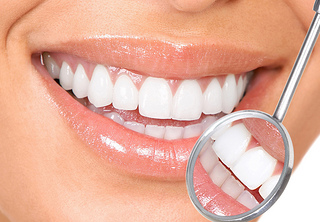
For many individuals, autumn brings with it a number of new beginnings. Fall is the time that many people return to school, get back to the daily grind after an enjoyable summer, and even get married. As the weather cools down, it’s easier to enjoy the outdoors. And regardless of what fall-related events are on your calendar, Drs. Peter Vogel, Paul Owens and our team at Daisy Mountain Dentistry know you’ll want to look your best.
One of the very first things that people will notice about you is your smile. And if yours has become less dazzling over the years — as teeth tend to do — you know how disappointing it is not to have the beautiful, pearly white look you’re used to.
Benefits to Teeth Whitening
For school-bound students and autumn brides, fall calendars are certainly filled. School and weddings call for large financial investments, loads of social interaction, and a large amount of personal dedication. So the last thing any bride or student wants to think about is a less-than radiant smile.
For many, there is a lack of confidence associated with their smile and investing in teeth-whitening techniques can be an effective solution. Studies suggest that not only can you experience a boost in your level of confidence, but also you may find that other advantages quickly fall into place.
A confident smile can affect:
- Personal and work-related relationships
- Job interviews and meetings
- Success when dealing with customers and potential clients
- Your personality and general happiness with your age
- Overall outlook on daily interactions
A Real Effect on Daily Living
All of these benefits can relate directly to how you see yourself. When you are insecure with something as prominent as your smile, it can affect the way that you handle your life, everything from social gatherings to professional situations.
Now is the perfect opportunity to rejuvenate your smile. With the right teeth-whitening product and regular hygienic practices, walking down the aisle or starting the new semester with the utmost confidence has never been easier.
Labor Day: Our favorite holiday to rest!
August 28th, 2019

Labor Day, celebrated on the first Monday each September here in the United States, is a holiday devoted to the American working community. The purpose of the holiday is honoring the country's workers and their contributions to the strength of our country as a whole.
How Labor Day Started
There is actually some debate as to the origins of Labor Day. It is uncertain whether Peter McGuire, a cofounder for the American Federation of Labor, or Matthew Maguire, who was the secretary of Central Labor Union of New York, had the great idea. However, the Central Labor Union's plans were what launched the first Labor Day in America.
The First Labor Day
The very first Labor Day was celebrated on September 5th, 1882. The Central Labor Union then held annual celebrations on September 5th for what they called a working man's holiday. By the year 1885, the Labor Day celebration had spread to many different industrial areas, and after that it began spreading to all industries in the United States.
Labor Day Today
Labor Day today is a huge United States holiday during which we honor the country's workers with a day of rest and relaxation or a day of picnics and parades. This holiday is truly one to honor the many people who work hard to contribute to the economic well-being of our great country!
Our team at Daisy Mountain Dentistry hopes all of our patients celebrate Labor Day, and every holiday, safely and happily. Whether you stay in the Anthem area, or travel out of town, have fun, and don't forget to brush!
What to do about Sensitive Teeth
August 21st, 2019

If you suffer from sensitive teeth, you already know the frustration of having a type of pain that is hard to deal with. Because tooth sensitivity is sometimes unpredictable, you can't necessarily take medication to ward off the pain like you could if you just felt a headache coming on.
However, there is still something you can do about sensitive teeth. Use the following tips to help put your sensitivity and pain problems with your teeth behind you!
Use the Right Toothbrush: Select a toothbrush made just for sensitive teeth, or the softest bristles possible. This helps you avoid putting any extra pressure on your teeth or gums.
Choose a Special Toothpaste: There are several good options for toothpastes made just for sensitive teeth today. Usually, toothpaste formulated for sensitive teeth will be fluoridated and use a non-abrasive formula. The toothpaste will help with the pain usually associated with brushing and flossing if you use it regularly.
Avoid Trigger Foods: You may have noticed certain trigger foods that cause tooth sensitivity and pain for you. Avoid these foods whenever possible, and if you absolutely must eat them, try to consume them in very small quantities. Trigger foods may include:
- Foods with high acid content for example citrus fruits
- Very hot or very cold foods
- Hard or crunchy foods
Visit Our Office
If your sensitive teeth problem is too serious to manage on your own, a visit to our Anthem office may be in order. There are a couple of ways Drs. Peter Vogel, Paul Owens can help:
- Fluoride Treatments: We can put a special fluoride formula on the most sensitive areas to help make your enamel stronger and to help lower pain levels.
- Sealing Exposed Roots:In some cases, your roots become exposed due to a receding gumline, which in turn causes teeth sensitivity and pain. We can apply a dental sealant that protects the exposed roots and reduces your pain dramatically.
Can my child really avoid tooth decay?
August 14th, 2019

Great question! Yes, in fact, tooth decay is preventable! Decay, which is caused by sugars left in your child’s mouth, can turn into an acid, which in turn can break down his or her teeth. Children are at high risk for tooth decay for a simple reason: many children and adolescents tend to be lax in their oral hygiene habits.
So, how can your child prevent tooth decay?
- Start early. After the age of two, brush your child’s teeth with fluoride toothpaste twice a day. And, if possible, clean between the teeth with dental floss at least once a day, preferably before they go to bed.
- Don’t allow your little ones to eat after cleaning teeth at bedtime, as salivary flow decreases while they sleep and their teeth become vulnerable to cavities.
- Do not allow your little ones to nibble food or sip drinks continuously, and keep in mind that a low-sugar diet also helps keep tooth decay at bay. Allow time between meals for saliva to neutralize acids and repair the teeth.
- Drinking water frequently throughout the day can also reduce the possibility of new cavities forming.
- Dental sealants can also protect your children’s teeth from cavities. Sealants, which are applied to the chewing surfaces of molars, act as a shield between the tooth and harmful bacteria.
Finally, make sure your child visits Daisy Mountain Dentistry approximately every six months for a checkup and routine cleaning! Please give us a call at our Anthem office.
What’s an intraoral camera?
August 7th, 2019

One of the greatest features our team at Daisy Mountain Dentistry offers is the ability to see first-hand how we can help our patients. While X-rays help us detect any problems in your mouth and give us valuable information on what is bothering you, they often don’t give Drs. Peter Vogel, Paul Owens a complete view of everything that is going on inside your mouth. With the use of an intraoral camera, we can see every aspect of your teeth and mouth with incredible detail, uncovering cracked or fractured teeth, excessive wear, carious lesions, cavities, or other issues that may be hidden. When we can discover oral problems early on, your treatment is much less invasive and often saves you money down the road.
An intraoral camera allows Drs. Peter Vogel, Paul Owens to view clear, precise images of your mouth, teeth, and gums and allows us to make an accurate diagnosis. With clear, defined, enlarged images, Drs. Peter Vogel, Paul Owens and our team see details that standard mirror examinations may miss. It’s much easier to understand what is happening in your mouth if you can see the problem on a computer monitor, and it means faster diagnosis and less chair-time for our patients!
Intraoral cameras are small, about the size of a dental mirror, and emit a light onto the tooth. The tooth will emit a color that lets Drs. Peter Vogel, Paul Owens determine if the tooth is healthy or diseased. Intraoral cameras also allow us to save your images on our office computer to provide a permanent record of treatments. These treatments can be printed for you, other specialists, and your lab or insurance companies.
For any questions about the intraoral camera, we encourage you to ask Drs. Peter Vogel, Paul Owens or our team during your or your child’s next visit or by giving us a call at our convenient Anthem office.
Happy Gums, Happy Heart!
July 17th, 2019

Medical doctors and dental health professionals, like Drs. Peter Vogel, Paul Owens, have debated over the connection (or lack thereof) between gum disease and heart disease. While there still is no unanimous consensus on whether there is a link – or the extent to any link there may be – several studies offer some interesting insight into possible correlations that may prove that there are some common factors that point to a likely correlation between the two.
Could there be a link between gum disease and heart disease?
Dr. Simone Ricketts reported on the findings of an Australian study of 80 patients in Profile Magazine. That study showed that 70% of the patients who participated in the study and needed heart transplants also had gum disease. She noted that other studies show a similar pattern, indicating that patients who needed heart transplants or other cardiac surgery procedures, were more likely to have dental problems.
Not Just Heart Disease Linked to Gum Disease
It isn’t just heart disease that experts are linking to periodontal disease, however. More and more evidence is showing that many chronic inflammatory diseases such as diabetes can be linked to periodontal disease. Poor oral hygiene resulting in gum disease was evident in blood tests that showed positive markers for inflammation.
Experts looked at a combination of over 120 medical studies focusing on a link between dental health and heart health. The findings of that research were published in the Journal of Periodontology and the American Journal of Cardiology. While there was no agreement on a definitive link, the research showed some promising results, and offer information that may be helpful to both dental health professionals and their patients.
On its own, gum disease increases the risk of developing coronary artery disease. Data from the National Health and Nutrition Examination Survey (NHANES) showed that gum disease increases the risk factor for blood vessel and artery diseases when those arteries supply blood to the brain.
This is especially important for strokes because they are a common cause of inadequate blood flow to the brain. Data from another study of 50,000+ people found a higher risk of stroke among people with gum disease and tooth loss.
The study did, however, show two very important connections between gum and heart disease:
- Both the gums of people with gum disease and the blood vessels of people who had atherosclerosis tested positive for similar types of bacteria.
- Both patients with atherosclerosis and those with gum disease showed the presence of inflammation in their bodies.
Patients need to understand the importance of taking care of their mouths and doing whatever is necessary to ensure or support heart health – even if there is no guarantee that doing so will prevent either disease.
Pregnancy and Oral Care
July 10th, 2019

Pregnancy involves a lot of alterations in your health. Daisy Mountain Dentistry is here to help you understand the oral health aspects of your pregnancy.
As you may already know, your body becomes more susceptible to bacterial complications. In terms of oral health, you may be at a higher risk for gingivitis and periodontal disease during the course of your pregnancy.
The hormonal changes in your body can create a more welcoming environment for gum infections, including gingivitis. Although you may continue to brush and floss on a regular basis, and maintain your schedule of cleaning appointments, you are still prone to an increased risk of gingivitis. Your gums may feel more sensitive and become more prone to bleeding because of the increased amount of blood flowing through your body. This can also be a side effect of periodontal disease, which nearly 40% of pregnant women have.
In order to avoid painful dental visits, you should attempt to brush more than twice a day and always floss regularly. We recommend investing in a good mouthwash for extra protection against plaque buildup. Other oral conditions to watch out for during pregnancy include oral gingival lesions, tooth mobility, tooth erosion, and dental caries.
Keeping your oral health in top shape will prevent bacteria from circulating to other places in your body during pregnancy. Your immune system is more likely to be compromised, which means you generally face an increased risk for illnesses.
Don’t forget that you share nutrients and pathogens with your baby, so it’s crucial to reduce your risks in every possible way. If you think you may be experiencing an oral health issue during your pregnancy, please call our Anthem office to schedule an appointment, and we will be happy to help you.
Why You Should Avoid Energy and Sports Drinks
June 26th, 2019

In a world where everything moves so quickly and teens and young adults find themselves pulling “all-nighters” or working long hours, energy drinks have grabbed the spotlight. You’ll have one (or three) and suddenly you have the drive you need to keep going.
The same can be said for sports drinks. It’s common for people to have one even when they’re not engaged in any strenuous physical activity, which is what they were designed for. People will drink them simply because they’ve grown to love the taste.
Although they might taste great and boost your energy, there’s a serious down side to consuming energy and sports drinks on a steady basis. Studies have shown that these drinks contain so much acid that they start to destroy your teeth after just five days of consistent use.
The acid in these drinks destroys your tooth enamel, which makes your teeth more vulnerable to bacteria. This can progress to staining, tooth decay, and hypersensitivity.
That’s why Drs. Peter Vogel, Paul Owens and our team want to encourage you to try to limit the amount of sports and energy drinks you consume. If you do enjoy either or both of these drinks, you should make it a habit to rinse your mouth with water immediately after consumption, and brush your teeth about an hour later, after the period when acid has a softening effect on your enamel has passed.
If you feel like you’re already experiencing the side effects of heavy energy and sports drink consumption, visit our Anthem office, and our team can provide solutions for how to prevent further damage from occurring. It’s never too late to change a bad habit!
Why You Should Avoid Energy and Sports Drinks
June 26th, 2019

In a world where everything moves so quickly and teens and young adults find themselves pulling “all-nighters” or working long hours, energy drinks have grabbed the spotlight. You’ll have one (or three) and suddenly you have the drive you need to keep going.
The same can be said for sports drinks. It’s common for people to have one even when they’re not engaged in any strenuous physical activity, which is what they were designed for. People will drink them simply because they’ve grown to love the taste.
Although they might taste great and boost your energy, there’s a serious down side to consuming energy and sports drinks on a steady basis. Studies have shown that these drinks contain so much acid that they start to destroy your teeth after just five days of consistent use.
The acid in these drinks destroys your tooth enamel, which makes your teeth more vulnerable to bacteria. This can progress to staining, tooth decay, and hypersensitivity.
That’s why Drs. Peter Vogel, Paul Owens and our team want to encourage you to try to limit the amount of sports and energy drinks you consume. If you do enjoy either or both of these drinks, you should make it a habit to rinse your mouth with water immediately after consumption, and brush your teeth about an hour later, after the period when acid has a softening effect on your enamel has passed.
If you feel like you’re already experiencing the side effects of heavy energy and sports drink consumption, visit our Anthem office, and our team can provide solutions for how to prevent further damage from occurring. It’s never too late to change a bad habit!
What is a crown?
June 19th, 2019

Drs. Peter Vogel, Paul Owens and our team at Daisy Mountain Dentistry hear this question all the time. Millions of people have dental crowns that artificially restore the chewing surface of a tooth. Also known as caps, these restorations surround the entire portion of the tooth that is above the gum line. Crowns are custom fabricated to match the color, shape, and size of other teeth and are visually undetectable to others. Several types of materials can be used to create crowns, including stainless steel, resin, metal alloys, porcelain fused to metal, or ceramic. When properly cared for and accurately fit, crowns can stay in place for a decade or more.
There are many reasons to get a dental crown, including:
- To restore a broken or cracked tooth
- To protect a tooth after a root canal
- To restore a severely decayed tooth
- To help anchor a dental bridge
- To complete a dental implant
- To protect a tooth that is at high risk for developing decay
- For cosmetic purposes
Getting a dental crown
The process of getting a dental crown begins at our Anthem office. X-rays are used to ensure the teeth are healthy enough to receive a crown. If the roots and surrounding bone are in satisfactory condition, the tooth will be numbed, filed, and reshaped in preparation for the crown. If the tooth root is not healthy, a root canal may be necessary first.
After the tooth is prepared, a special paste is placed over the upper and lower teeth to make impressions. These impressions serve as blueprints for the dental laboratory responsible for making the crown. They also help ensure the position of the new crown will not negatively affect a patient’s bite. The prepared tooth is protected by a temporary crown while the permanent one is made. When ready, the permanent crown replaces the temporary crown and is cemented in place.
To learn more about crowns, or to schedule an appointment with Drs. Peter Vogel, Paul Owens, please give us a call at our convenient Anthem office!
Things You Should Know Before Getting an Oral Piercing
June 12th, 2019

Have you been thinking about getting an oral piercing lately? It could seem enticing because they look trendy or cool, but it’s worth know the health risks associated with oral piercing. Even if you already have one, you may learn a few things you didn’t know.
The human mouth contains millions of bacteria. Even without piercings, it’s not uncommon for people to develop an infection every once in a while. By adding an oral piercing, you increase your likelihood of getting an infection.
Many people who have piercings tend to develop the habit of touching them regularly, which is the like opening a door and yelling, “Welcome home, infections!” And because these piercings are in your mouth, particles of all the food that comes through can accumulate and eventually cause a pretty serious health situation.
It’s hard to ignore the presence of an oral piercing, so biting or playing with the site is fairly common. Doing so can lead to teeth fractures, however. While a fracture might be on the enamel of a tooth and require a simple filling, it can also go deeper, which could entail a root canal or even tooth extraction.
Other risks include hindering your ability to talk and eat, nerve damage, gum damage, and even loss of taste.
If you’re still determined to get an oral piercing, at least be aware of the time it will take to heal. It can take anywhere from four to six weeks, and can cause great discomfort during that time. Be willing to give it that time in order to lower your chances of infection.
Make sure you understand that getting an oral piercing will involve adding further responsibility to your daily dental health duties. It’s essential that you commit to regular upkeep on your end, and not just while it’s healing.
Healthy Summer Foods
June 5th, 2019

It’s summer—that wonderful time of year when fresh and delicious produce abounds. Drs. Peter Vogel, Paul Owens will tell you that your teeth, gums, and tissues all rely on an appropriate mix of vitamins and minerals to maintain good oral health no matter what time of year. In previous studies, nutrients in fruits and vegetables such as dietary fiber, potassium, and antioxidants have all been associated with a reduced risk for cardiovascular disease and cancers, including oral cancer.
Here are four foods we want you to enjoy this summer to ensure a healthy mouth:
Watermelons and Strawberries
Watermelons have high water content, which dilutes the affects of the sugars they contain and stimulates the flow of saliva. In addition, research shows that eating foods full of water (watermelon is 92 percent water) helps keep you satiated on fewer calories. Finally, in addition to containing skin-protecting lycopene, eating watermelon can help you stay hydrated during the summer months, which not only keeps your memory sharp and your mood stable, but also helps keep your body cool.
Strawberries are juicy and delicious, and they’re also considered a superfood. Nutrient-rich and packed with antioxidants (such as vitamin C, which can help with cancer prevention), strawberries also promote eye health, help fight bad cholesterol, and regulate blood pressure.
Apples
Did you know consuming apples can help you attain whiter, healthier teeth? It’s true. Biting and chewing an apple stimulates the production of saliva in your mouth, and in the process, lowers the levels of bacteria and other harmful acids, leading to a lower likelihood of tooth decay. Apple consumption can also boost your immune system, reducing cholesterol and helping you avoid Alzheimer’s and Parkinson's diseases. Finally, eating an apple a day has been linked to heart health, including a lower risk of death from both coronary heart disease and cardiovascular disease.
Tomatoes
Tomatoes are a delicious and healthy snack and can help you ward off cancer. The yummy red fruit contains lycopene, which helps protect your skin from sunburn. Tomatoes can also help you fight heart disease due to the niacin, folate, and vitamin B6 nutrients they contain. They’re high in crucial antioxidants, such as vitamin C and vitamin A, which work to prevent DNA damage.
Sealants: What are they and how do they help?
May 30th, 2019

Molars are made up of canyons, caves, pits, and seemingly endless caverns that are a breeding ground for decay. The protective solution is a sealant. When done correctly, a sealant from Drs. Peter Vogel, Paul Owens of Daisy Mountain Dentistry can be most effective in preventing cavities.
A sealant is made up of composite (a plastic-like) material that contains bonding agents to seal to the edge of the tooth. Sealants placed on the chewing surfaces of back teeth block food from being trapped. The process in which a sealant is placed is quite precise and painless.
First the tooth is cleaned with a sodium bicarbonate (baking soda) spray. Then an acid etch is applied to “roughen up” the surface. No saliva is to touch the tooth. This will re-mineralize the area, then a repeat etching is needed. An alcohol-based liquid then dries out the area and it must remain completely dry. The sealant is placed and guided through all the caverns, pits, fissures, and grooves. It is then cured with a special light, which makes it a hard, plastic-like material.
Sealants can last for several years. It is wise to have them examined on a semi-annual basis. If there is a break in the sealant, a high risk for decay is common. If a sealant is damaged, repair is simple, painless, and quick to complete.
Who can benefit from sealants? Anyone! Children often receive sealants as routine preventive care. Adults with deep canyons with stained grooves on their teeth can also benefit from a sealant. The process is quick, painless, and does not require any anesthesia. It is an effective way to lower dental restorative costs.
An investment in dental sealants can reap great benefits as properly cared for teeth will remain cavity free. Our Anthem location is available to answer your questions so give us a call today!
Memorial Day
May 22nd, 2019

Memorial Day is not only a federal holiday in the United States, but it is a day of observance and remembrance of those who died in service. Originally known as Decoration Day, this solemn day has been marked on calendars since the end of the American Civil War as a day to commemorate both the Confederate and Union soldiers who fought and died in the war.
Marking the graves of fallen soldiers with flowers, wreaths, or other tokens has been practiced throughout history, but it wasn't until the mark of the end of the Civil War that a special day was decided upon as the one to spend in remembrance. By 1890, every state in the country was observing Decoration Day. It wasn't until 1967 when the name formally changed from Decoration Day to Memorial Day, in order to encompass all fallen American soldiers in all wars and conflicts. In June of 1968, Congress moved the official date of Memorial Day to the last Monday in May in order to create a three day weekend.
Today, while there is certainly an air of remembrance on Memorial Day, it has become more a day of spending time with family, friends, and other loved ones. This day is also heralded as the start of summer, with many schools finishing for the year around this time. Our team at Daisy Mountain Dentistry remembers it as a day to take solace and remembered those lost.
Traditional observances of Memorial Day are still held, and they often involve raising the American Flag then lowering it to a half-staff position until noon, and then raising it once again to its full height afterwards. The flag is lowered to remember those who've lost their lives while in service to their country, and then it is raised to signify our willingness to not let their sacrifice be in vain.
From community parades in the Anthem area, backyard cook-outs, and fireworks to formal ceremonies, Memorial Day is commemorated in many different ways. No matter how you choose to spend this day, take a moment to remember those who've lost their lives in an effort to preserve our freedom.
Fluoride Use in Adolescents
May 15th, 2019

Fluoride is a mineral that plays an essential role in oral health. In fact, the significant reduction in American tooth decay in recent decades can be attributed to a greater availability of fluoride in public water supplies, toothpaste, and other resources. When it comes in contact with the teeth, fluoride helps protect the enamel from acid and plaque bacteria. In some cases, it can even reverse tooth decay in its earliest stages.
Despite the benefits of fluoride, tooth decay is still common, especially among teenagers. The Centers for Disease Control reports that cavities can be found in more than half of young teens and two-thirds of older teens over age 16. Many of those teens are deficient in fluoride, either due to a lack of public water fluoridation or the use of bottled water. So how can parents ensure their teens are getting the fluoride they need to facilitate strong, healthy teeth?
Monitor Fluoride Exposure
Drs. Peter Vogel, Paul Owens and our team at Daisy Mountain Dentistry recommend you start by measuring your teen’s fluoride exposure. Make sure you purchase fluoridated toothpaste for your household, and find out if your tap water is fluoridated. If your teen primarily consumes bottled water, examine the bottle to determine whether fluoride has been added. The majority of bottled waters are not supplemented with fluoride, but those that are will be clearly labeled.
Fluoride Supplementation
Drs. Peter Vogel, Paul Owens may recommend topical fluoride treatments at routine dental exams. These treatments are painless for your teen and may help establish stronger enamel that is more resistant to plaque and tooth decay. If you have a public water supply that is non-fluoridated, we may recommend fluoride supplementation between visits. These can be administered as drops, tablets, or vitamins.
Keep in mind that fluoride is most important for children and teens under the age of 16. Be proactive about your teen’s oral health by speaking with us about your family’s fluoride needs at your next dental visit.
For more information about fluoride, or to schedule an appointment with Drs. Peter Vogel, Paul Owens, please give us a call at our convenient Anthem office!
Wishing all our moms a happy Mother’s Day!
May 8th, 2019

"Motherhood: All love begins and ends there." - Robert Browning
We would like to take this moment to thank all the great moms out there for being so great during their child’s visits to Daisy Mountain Dentistry. Whether it’s driving their kids to regularly scheduled appointments or for “being there” while their child is treatment, the moms who come to our office are all stellar individuals, so Drs. Peter Vogel, Paul Owens and our entire staff would like you to know that we appreciate you all!
Happy Mother’s Day and enjoy your special day!
May Marks National Physical Fitness and Sports Month!
May 1st, 2019

The merry month of May also happens to be National Fitness and Sports Month, so take advantage of the warmer days to get outside and exercise! Bringing a friend, family member, or coworker with you when you go for a brisk walk during a lunch break can provide an opportunity to socialize as well as health benefits. If you need a little more motivation, here are some good reasons to stay active and fit.
Exercise provides:
- Improved stamina and energy as well as toned muscles and bone strength and density
- Improved circulation and breathing for a healthier heart and lungs
- Reduced risk for Type 2 diabetes and certain forms of cancer
- For older adults, regular exercise may help improve balance and reduce the risk of falls as well as improved cognitive abilities
Children and Teens
Children and teenagers spend long hours at their desks in school, on the computer, watching television, and involved in other sedentary activities that result in obesity and poor health later in life. Getting them engaged in school or community sports teams can help them form good life-long exercise habits. One important note: If they are participating in contact sports, Drs. Peter Vogel, Paul Owens and our team at Daisy Mountain Dentistry recommend your kids wear an approved mouthguard to protect those valuable teeth from injury! Ask us for a proper fitting of your safety appliance during your next visit!
A gym membership is nice but not necessary to stay fit; try these easy ways to work some exercise into your daily routine.
At Home
- Take a friend along for company on a walk through your neighborhood.
- Pursue gardening or other yard work, including mowing or raking.
- Take your kids on a bike ride or have them push a baby stroller around the block.
Couch potatoes take note: simply moving from the sofa to the floor for some sit-ups, leg-lifts, or push-ups while you’re watching television can help you get in better shape in no time.
At Work
- Take the stairs instead of the elevator.
- Take exercise breaks for walks around the building or parking lot.
- Walk or ride a bike to work.
So what are you waiting for? Get moving!
For more information on exercise techniques, or to schedule an appointment with Drs. Peter Vogel, Paul Owens, please give us a call at our convenient Anthem office!
Tips for Lifelong Teeth Whitening
April 24th, 2019

Over time, everyone’s teeth can naturally become dull, due to aging and consumption of staining foods such as chocolate and coffee. The good news is that teeth-whitening treatments can help you maintain white teeth that last a lifetime.
Get Regular Treatments
Regular treatments at Daisy Mountain Dentistry are necessary to keep your teeth white for life, since whitening treatments are only temporary. Bleaching too frequently, however, can wear away your tooth enamel.
The effects of in-office bleaching are safe and can last for several months to a year. You may need to repeat your use of at-home bleaching kits every few months to maintain your white teeth. As far as day to day, whitening toothpastes are safe to use on a daily basis. The American Dental Association suggests you ask your dentist for advice on which treatment is best for you.
Have Realistic Expectations
Everyone’s teeth are different and, according to the American Dental Association, not all smiles can be turned bright white. Teeth can naturally be a light yellowish color that responds well to teeth-whitening procedures, but bleach is not likely to be effective for grayish teeth. Results for brownish teeth fall somewhere in between.
Practice Good Oral Hygiene
Good hygiene is imperative for teeth-whitening efforts. Visible fillings, implants, or bridges that are metallic can be visible against the white color you desire. These treatments can be prevented by maintaining a good oral hygiene routine.
In addition to brushing your teeth twice a day to remove dirt and potential staining agents, keep the following tips in mind:
- Floss every day
- Visit our Anthem office every six months
- Rinse your mouth with water after each meal and snack
- Limit sugary and starchy foods and beverages, especially between meals
Earth Day
April 17th, 2019

The idea for Earth Day was the brainchild of Gaylord Nelson, a senator from Wisconsin. He envisioned an Earth Day that would be a kind of environmental teach-in. The first Earth Day celebration took place on April 22, 1970, and a surprising 20 million people participated on that day. Ultimately, it became the largest organized celebration in US history.
Earth Day Over the Years
Over the years, the recognition of the day, and the number of people celebrating it all over the world, turned Earth Day into an international celebration. Because it is celebrated throughout the world, it is not only the largest international environmental observation, but it is also more widely celebrated than any other environmental event in the world. Today, Earth Day is celebrated in 175 countries where over 500 million people participate in celebrations.
The Earth Day Movement
The Earth Day movement is credited with developing the idea that people should “think green”. It encouraged congress to enact laws, including one that resulted in the creation of the Environmental Protection Agency. It also inspired the passage of the Endangered Species Act.
The Five R's and Their Importance
- Reduce – Reduce by avoiding unnecessary purchases. Reduce your use of materials that wind up in landfills. Reduce the use of chemicals around your house. Reduce your use of disposable bags, plates, cups, eating utensils, and batteries.
- Reuse – Instead of using plastic bags for your groceries or purchases, bring your own reusable bags. When you go to buy coffee at Starbucks, take a travel mug so you don't have to get your coffee in a disposable paper cup. Instead of storing food in disposable refrigerator containers, buy containers that can be washed and reused. Don't use regular batteries. Whenever possible, opt for rechargeable batteries that you can reuse.
- Recycle – Most cities offer a recycling program to collect used bottles, cans, and newspapers. Recycling includes collecting recyclable materials that would otherwise be considered waste, sorting and processing recyclables into raw materials such as fibers and manufacturing raw materials into new products.
- Re-buy – Make an effort to purchase things that are made through recycling. When purchasing furniture, look for items that are made from reclaimed wood. When buying paper for kids school work, computer printer paper, holiday cards, or anything else, make a point of purchasing recycled paper products. Instead of buying clothing at full retail price, shop for second hand clothing. You will save a lot of money by doing so!
- Rethink – Rethink the way you do things so that you do them in an eco-conscious way at all times. Instead of driving to work alone, consider taking the bus or going in a carpool. Walk or ride your bike when you're only going a short distance. Plan your shopping trips and errand runs so that you can do everything on one day, and do it in a way where you can save time and gas.
Other ways to "think green" include growing your own food, composting yard waste and food scraps, or by participating in local recycling programs. Join a group like Freecycle so you can share your unneeded and unwanted possessions with people who can use them. Likewise, you'll be able to get things you need or want for free.
Earth Day teaches people that the planet belongs to everyone, so everyone is equally responsible for protecting it. Although Earth Day is an environmental celebration, our team at Daisy Mountain Dentistry wants to remind you that you don't have to wait until then to make changes that will allow you and your family to live a greener life.
Happy Earth Day from the team at Daisy Mountain Dentistry.
Top Five Reasons to Choose Veneers
April 10th, 2019

If you notice every imperfection in your smile and you are aiming for a more ideal-looking smile, veneers might be for you. Veneers are common tools in cosmetic dentistry for improving the look of your teeth. They are thin layers, either made of resin composite or dental porcelain, that go over your teeth. If you are considering dental veneers, these five reasons to choose them may help persuade you.
1. They hide imperfections.
The basis of cosmetic dentistry is providing an attractive smile, and veneers are designed to hide imperfections such as chipped, uneven, or badly aligned teeth. With veneers, teeth are even and uniformly colored.
2. They are durable.
Dental veneers can last for a decade to up to 30 years, so you do not need to continually go back to our Anthem office to replace them. On average, veneers last longer than standard fillings.
3. You can get the process done quickly.
Often, you can get a full set of dental veneers in a three visits and within a few weeks. The first appointment is a consultation to evaluate your teeth and plan your treatment. At the next visit, Drs. Peter Vogel, Paul Owens and our team prepare your teeth for veneers and take an impression of your teeth so the laboratory can custom-make your veneers. During the final visit, we bond the new veneers to the surfaces of your teeth.
4. They can whiten the appearance of your teeth.
Coffee, smoking, excessive fluoride, and certain drugs can yellow your teeth over time. Dental veneers can be colored to have a bright white appearance so your teeth appear noticeably whiter. This can be especially beneficial for individuals whose teeth are naturally off-white and do not respond well to bleach-based whitening treatments.
5. They can fix minor dental problems.
Dental veneers are not solely cosmetic. They can improve a variety of dental concerns, such as teeth with uneven spaces. They can hide the appearance of chipped and broken teeth, and make more even teeth that are worn down, spaced unevenly, or shaped irregularly. Since Drs. Peter Vogel, Paul Owens can manufacture the veneers to match your natural tooth color, these thin layers are more attractive than unsightly fixes such as metal fillings.
April is Oral Cancer Awareness Month
April 3rd, 2019

What is oral cancer?
April is Oral Cancer Awareness Month. If you have been putting off a visit to our Anthem office, now is an excellent time to schedule one. Regular visits to Daisy Mountain Dentistry can be the first line of defense against oral cancer, by identifying early warning signs of the disease, or helping you with preventive care tips to lower your chances of developing it.
Oral Cancer Rates in America
Nearly 40,000 people in the U.S. will be diagnosed with oral cancer this year, and more than 8,000 die every year from this disease. It is a devastating illness: most people who are diagnosed with it do not live more than five years beyond their diagnosis. Oral cancer has a higher death rate than many other common cancers, including cervical cancer, testicular cancer, Hodgkin’s lymphoma, and thyroid or skin cancers. The high death rate results from the fact that most oral cancers go undiagnosed until the disease is well advanced and has spread to another part of the body—most often, the lymph nodes in the neck.
What causes oral cancer?
While there is no way to predict exactly which individuals will get oral cancer, there are some potential causes you should know about—because in some cases, you can minimize these risk factors.
- Age (most patients diagnosed with oral cancer are over the age of 40)
- Tobacco use, either from cigarettes or smokeless chewing tobacco
- Excessive alcohol consumption (especially in combination with tobacco use)
- Persistent viral infections, such as HPV16
- A diet low in fruits and vegetables
In addition, oral cancer tends to occur at a rate six times greater in men than in women, and more often for African Americans than other ethnic groups. No genetic links have been identified to explain the higher incidence in these populations, so lifestyle choices remain the likeliest cause.
Oral Cancer Treatments
Once a diagnosis has been made, treatment of oral cancer usually involves a multi-disciplinary team that includes surgeons, oncologists, dentists, nutritionists, and rehabilitation and restorative specialists. Our team will decide on the best approach for each patient, depending on the risk factors and how far the cancer has progressed. The strategy will be different in every case. Some of the most common methods include chemotherapy, radiation, and potential surgery.
Finding out you have cancer can be devastating news. If you are concerned that you might be at risk for developing oral cancer, talk to us about screenings and other things you can do to reduce your risk.
Does chronic stress impact periodontal health?
March 27th, 2019

Many studies over the past several years have focused on this question. Since we will all face stressful situations during our life, it is a good question to ask. This question also delves into the mind-body connection—the psychological having an effect on the physical and vice versa.
Studies were performed as far back as the 1940s and continue today. Many of them have shown that stress "downregulates" or hinders cellular immune response. The most common periodontal diseases related to this stress-induced downregulation are gingivitis and periodontitis.
It is believed that stress and depression contribute to a state of chronic inflammation within the body. Stress also raises levels of cortisol in your body, which has been linked in studies to higher levels of tooth loss and deeper pockets between the gums and teeth.
Perhaps the biological side of this equation makes sense, but an important factor is that people who are stressed and/or depressed tend to neglect oral hygiene and other health-promoting activities. The studies seem to support both the behavioral and biological effects as risk factors for periodontal disease.
Here are some things you can do to help prevent stress-related periodontal problems:
- Daily relaxation –You may consider meditation or yoga. Both have been proven effective at easing stress.
- Practice good oral hygiene – Don't let your oral hygiene fall by the wayside. Doing so will obviously have a detrimental effect on your oral health. You should also aim to quit smoking if you do smoke.
- Get regular dental checkups – Getting regular checkups will help you to spot anything that's amiss before it gets out of hand. You can speak with your dentist if you have any pain or concerns and have them take a look.
Stress is something that affects all of us but it can be managed. Each one of us may manage it in a different way. Find what works for you and always make sure to keep up with your oral hygiene routine. For more information about stress-related periodontal issues, schedule an appointment with Drs. Peter Vogel, Paul Owens at our Anthem office.
Common Emergency Care Visits: Toothaches or abscesses
March 20th, 2019

Dental problems do not always wait for normal office hours. Broken fillings or damaged teeth are common reasons for emergency treatment. Toothaches and abscesses can also require prompt attention. Drs. Peter Vogel, Paul Owens can provide you with the information and treatment you need to prevent the problem from becoming worse. Emergency dental care is only a phone call away, 24 hours a day, seven days a week.
Abscess
An abscess is a bacterial infection, and will normally cause pain and swelling around the affected tooth and gum area. Antibiotics are not always necessary, but you should seek treatment quickly. Left untreated, an infection can spread and cause serious complications.
Toothache
There are many reasons that you may develop a sudden toothache. The cause of the pain may be a particle of food lodged between your tooth and gum line. One of the first steps you can take is to rinse your mouth with warm water. You may also try gently flossing the area to dislodge the particle. Do not continue flossing if bleeding occurs.
Toothaches can occur from a carie — a cavity in the tooth — or from a fracture. Sensitivity to heat or cold may also cause tooth pain. You should make an appointment to ensure that a minor problem does not become serious. We may recommend acetaminophen or another pain reliever to reduce the pain before your visit.
Additional tips and treatments:
- If you have fractured a tooth, rinse the area with warm water to keep the surfaces clean. Apply a cold compress to the outside of your facial area to reduce swelling.
- A tooth that has been knocked out should be kept moist, in a clean container, until you can receive treatment.
- Do not apply aspirin directly on a damaged tooth or gum area as it can cause tissue irritation.
- If you suspect that your jaw has been broken, go to an emergency room immediately.
- If you have bitten or damaged your lips or tongue, rinse your mouth well with warm water. If bleeding continues, call us or seek other medical attention immediately.
Our team at Daisy Mountain Dentistry is ready to assist you when you have an emergency dental need. When you call, please provide us with as much information as possible so we can offer recommendations that will assist you until your appointment. Do not delay; emergency treatment is available and immediate treatment is the best course of action.
St. Patrick's Day
March 13th, 2019

On March 17, everyone has a little Irish in them. St. Patrick’s Day is a joyous celebration of Irish heritage. The holiday originated as a commemoration of Saint Patrick, who brought Christianity to Ireland. The saint arrived in Ireland in 432 and earned the reputation of a champion of Irish Christianity. March 17th, the day of St. Patrick’s death, has been commemorated by the Irish for over 1,000 years. St. Patrick’s Day is still observed as a religious feast day by several Christian denominations, but it is better known in the public imagination as a rich celebration of Irish culture.
St. Patrick’s Day has been an official public holiday in Ireland since 1903. Each year, the Irish celebrate with a several-day festival that includes theater performances, music, fireworks, and festive parades. The celebration is also a public holiday in Northern Ireland, Montserrat, and Newfoundland and Labrador. In other parts of the world with heavy Irish populations, it is an unofficial celebration of Irish heritage. Parts of Great Britain, Canada, Argentina, South Korea, Switzerland, New Zealand, the United States, and Australia commemorate the holiday each year. Typical celebrations in these countries include drinking green beer, wearing green, eating traditional Irish foods, parades, and shamrock decorations.
Many people, Irish and non-Irish alike, take part in the “wearing of the green” on St. Patrick’s Day. In fact, the color originally associated with Saint Patrick was blue. His use of shamrocks to explain the Holy Trinity to the Irish made the green clover emblematic of the holiday, leading to the traditional green attire worn by thousands on St. Patrick’s Day. Other little-known facts about St. Patrick’s Day include the following:
- Each year, the United States and Ireland face off in a rugby competition called the “St. Patrick’s Day Test.”
- Montreal celebrates the holiday with an annual parade, which has been held each year since 1824. The Montreal city flag even features a shamrock in its corner, as a nod to its Irish heritage.
- The Guinness World Records named St. Patrick’s Day the “Friendliest Day of the Year.”
- Along with Valentine’s Day, St. Patrick’s Day is one of the most widely celebrated saint’s day in the world.
No matter your cultural heritage, St. Patrick’s Day is a great time to let loose and celebrate your inner Irish-ness! Don your greenest attire and exclaim “Erin go Bragh!” (Ireland forever!) to everyone you meet. From Drs. Peter Vogel, Paul Owens - have a great St. Paddy’s day!
March is National Nutrition Month!
March 6th, 2019

While you don’t have to wait to start eating right, March is the month the Academy of Nutrition and Dietetics asks everyone to pay special attention to what goes into our bodies. The Academy has designated the month of March for focusing the public’s awareness on what they eat.
What Not to Eat
The academy points out that the foods you eat have a direct effect on the health of your teeth and specifically on tooth decay. Bacteria rely on carbohydrates to thrive. That is why Drs. Peter Vogel, Paul Owens and our team at Daisy Mountain Dentistry tell our patients to cut back on both candy and sweets. They consist of simple sugars that feed the bacteria in your mouth and enhance tooth decay.
It’s the hidden sugars that will cost you, though. Get in the habit of reading labels on food and looking for products with added sugar. This includes ingredients that end with the suffix “ose.” When it comes to nutrition, these foods offer little value beyond satisfying that sweet tooth.
What You Should Eat
Turn to foods that not only taste good but are good for your teeth too. Dairy products, for example, provide the body with nutritional items that support tooth enamel. Foods high in protein feature phosphorus, a nutrient critical to oral health.
You can’t really go wrong by adding color to your diet, either. Fruits and vegetables make for a colorful plate and a healthy meal. Use some caution with acidic fruits like oranges or even tomatoes, because the acid can erode tooth enamel. It is better to include these foods in a meal instead of eating them by themselves.
Remember, good nutrition is something you should worry about all year long, not just when celebrating National Nutrition Month. March just serves as a fun reminder that eating right is a proactive step in managing your dental health.
We encourage you to give us a call at our Anthem office to learn more!
Headaches: The Dental Connection
February 27th, 2019

Many people suffer through headaches for years without getting to the root cause of their problem. If you find yourself constantly popping painkillers to get through the day, it might be worth a trip to see a medical professional – but it may not be the person you think.
Talking to Drs. Peter Vogel, Paul Owens can be a great start when dealing with chronic headaches, because dental issues frequently contribute to head pain. In fact, the American Academy of Craniofacial Pain estimates that 80% of headaches are caused by muscle tension, which often originates in the jaws.
What Do Tension Headaches Feel Like?
A tension headache can originate on one side of your head or can pervade your entire skull. Typically, tension headaches feel like a dull, throbbing ache inside your head. Some patients at our Anthem office report that they feel as though a metal band has been wrapped around their head and is causing significant pressure. Several common symptoms suggest that tension headaches may be caused by dental issues:
- Feeling as though your head or scalp is painful to the merest touch
- Experiencing a dull or throbbing pain behind the eyes
- Clicking or popping sounds in your jaw joints
- Grinding teeth or clenching the jaws, particularly in times of anxiety or during the night
- Feeling as though your jaw muscles are sore when you wake up from sleep
Dental Origins of Headaches
Several dozen muscles control your facial expressions, jaw movements, and motions such as swallowing. When these muscles are contracted for long periods of time, tension builds up within the muscle and can lead to headaches. This may happen if you clench or grind your teeth at night, your bite is misaligned, or you have muscle imbalances in the jaw or neck.
Dental Treatments for Tension Headaches
Fortunately, a trip to Daisy Mountain Dentistry can be a fruitful way to alleviate your headaches, including the following treatments:
- Bite. In many cases, correcting your bite through orthodontics releases the stress on your jaw and muscles, and reduces the frequency of headaches.
- Nightguard. A nightguard, which resembles a sports mouthguard, may also be helpful if you frequently grind your teeth or clench your jaws during sleep. Nightguards distribute the tension from your clenched jaws and reduce the possibility of dental damage.
- Physical therapy and relaxation. Correcting the posture of your shoulders, neck, and head may alleviate muscle tension associated with headaches.
Is there really a link between my mouth and heart?
February 20th, 2019

Yes, indeed! While brushing, flossing, and regular visits to Daisy Mountain Dentistry are all key to maintaining a healthy smile and mouth, Drs. Peter Vogel, Paul Owens and our team want you to know the state of your oral health has a significant effect on your overall health.
Our mouths are full of bacteria—some good, and some harmful. Some types of bad bacteria can cause cavities, gingivitis and even periodontal (gum) disease. Without proper oral care and hygiene, these harmful types of bacteria are capable of entering your blood stream through inflamed gums, when inhaled through the mouth or through saliva.
Gum disease, in turn, has been linked to a number of health problems, researchers have found. These include:
- Heart disease: Gum disease may increase the risk of heart disease. Gum disease also is believed to worsen existing heart disease.
- Stroke: Gum disease may increase the risk of the type of stroke caused by blocked arteries.
- Diabetes: People with diabetes and periodontal disease may be more likely to have trouble controlling their blood sugar than diabetics with healthy gums.
- Premature birth: Women who suffer from gum disease during pregnancy may be more likely deliver their baby early, and it is likely her infant may be of low birth weight.
Drs. Peter Vogel, Paul Owens and our team at Daisy Mountain Dentistry are experts in identifying and treating periodontal disease. Give us a call today at our convenient Anthem office to schedule an appointment to improve your oral health and your overall health, too!
Team Dark Chocolate
February 13th, 2019
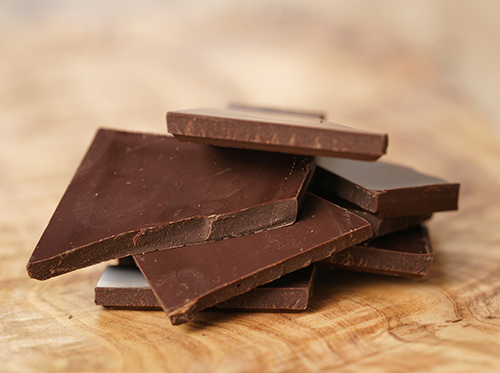
Valentine’s Day is the holiday to celebrate all the treasured relationships in your life. It’s a time to honor love in all shapes and forms with cards, social gatherings, and sometimes even binge eating of sweets.
It's hard to look the other way when grocery stores and pharmacies are invaded with goodies connected to the Valentine’s Day theme, and especially if you’re on the receiving end of some of these sweets. We get it. In fact, we’re all for it!
However, we also support a cavity-free smile. So in the interest of your dental and general health, and because we think it’s genuinely tasty, Drs. Peter Vogel, Paul Owens recommends an alternative to the Valentine treats you may be accustomed to: dark chocolate.
Yes, Healthy Chocolate Exists
Studies have shown that dark chocolate is high in flavonoids, an ingredient found in the cocoa beans used to make chocolate. Flavonoids can help protect the body against toxins, reduce blood pressure, and improve blood flow to the heart and brain.
By opting for dark chocolate rather than milk chocolate, you get to reap these benefits! Pretty sweet, right? Just make sure to stick to high-quality dark chocolates that have undergone minimal processing.
Dark Chocolate, AKA Protector of Teeth
Not only does dark chocolate provide some nice benefits for your overall health, it also helps protect your teeth against cavities! According to the Texas A&M Health Science Center, dark chocolate contains high amounts of tannins, another ingredient present in cocoa beans.
Tannins can actually help prevent cavities by interfering with the bacteria that causes them. Think of them as scarecrows for bacteria. They don’t always prevail, but isn’t it nice to have them there?
Smooth Never Sticky
Unlike many popular candies, dark chocolate is less likely to stick in the crevices of your teeth. Chewy, gooey sweets are more likely to hang around in your mouth for longer periods of time, which means they raise the odds of your harboring cavity-creating bacteria.
While some dark chocolates have additives like caramel or marshmallow, it’s best to opt for the plain varieties, which are just as delicious. If you’re feeling festive, though, a dark chocolate with caramel is still better than a milk chocolate with caramel, so that’s the way to go!
While dark chocolate has some pretty sweet benefits, the most important thing to remember (whether you go the dark chocolate route or not), is that moderation is key. That being said, we hope you have fun satisfying your sweet tooth and shopping for treats for your friends and loved ones. Happy Valentine’s Day from all of us at Daisy Mountain Dentistry!
February is Heart Month
February 6th, 2019

The American Academy of Periodontology stresses the importance of good oral health since gum disease may be linked to heart disease and stroke. Thus far, no cause-and-effect relationship has been established, but there are multiple theories to explain the link between heart disease and periodontal disease. One theory suggests that oral bacteria may affect heart health when it enters the blood and attaches to the fatty plaque in the heart's blood vessels. This can cause the formation of blood clots. Another theory suggests the possibility that inflammation could be a contributing link between periodontal disease and heart disease. Gum disease increases plaque buildup, and inflamed gums may also contribute to the development of swollen or inflamed coronary arteries.
What is coronary artery disease?
Coronary artery disease is caused in part by the buildup of fatty proteins on the walls of the coronary arteries. Blood clots cut off blood flow, preventing oxygen and nutrients from getting to the heart. Both blood clots and the buildup of fatty proteins (also called plaque) on the walls of the coronary arteries may lead to a heart attack. Moreover, periodontal disease nearly doubles the likelihood that someone will suffer from coronary artery disease. Periodontal disease can also worsen existing heart conditions, so many patients who suffer from heart disease need to take antibiotics before any dental procedures. This is especially true of patients who are at greatest risk for contracting infective endocarditis (inflammation of the inner layer of the heart). The fact that more than 2,400 people die from heart disease each day makes it a major public health issue. It is also the leading killer of both men and women in the United States today.
What is periodontal disease?
Periodontal disease is a chronic inflammatory disease that destroys the bone and gum tissues around the teeth, reducing or potentially eradicating the system that supports your teeth. It affects roughly 75 percent of Americans, and is the leading cause of adult tooth loss. People who suffer from periodontal disease may notice that their gums swell and/or bleed when they brush their teeth.
Although there is no definitive proof to support the theory that oral bacteria affects the heart, it is widely acknowledged better oral health contributes to overall better health. When people take good care of their teeth, get thorough exams, and a professional cleaning twice a year, the buildup of plaque on the teeth is lessened. A healthy, well-balanced diet will also contribute to better oral and heart health. There is a lot of truth to the saying "you are what you eat." If you have any questions about you periodontal disease and your overall health, give our Anthem office a call!
Is sedation dentistry right for me?
January 30th, 2019

At Daisy Mountain Dentistry, we are well-aware of the 25 million Americans who fear having to visit the dentist. Dental phobias are known to range anywhere from feeling mildly nervous to experiencing sweaty palms and even a racing heartbeat upon entering a dentist’s office. This anxiety can sometimes be so severe that it prevents people from visiting a dentist for years, postponing dental procedures that often result in costly problems down the road.
For those of our patients who have dental anxiety or dental phobia, it may be time to look into sedation dentistry, a safe and effective option for patients who are anxious or afraid, have a bad gag reflex, limited jaw opening, or for those who have a difficult time getting numb.
Sedation dentistry, a term that we use to refer to the use of anesthesia during treatment to put patients into a relaxed state, comes in many forms of sedation, from simply easing anxiety, to “conscious sedation,” which places patients in what we call a “twilight sleep.” Sedation dentistry at our Anthem office allows our patients to drift through their appointments—including complex dental work—as well as feel completely relaxed throughout their visits, without any discomfort or pain. Sedation dentistry can turn a nerve-wracking visit into a comfortable and enjoyable one.
Drs. Peter Vogel, Paul Owens and our team will be more than happy to discuss any concerns, issues, or fears you may have before or during your visit, and will be able to tell you if you are a candidate for sedation dentistry.
By talking with Drs. Peter Vogel, Paul Owens about sedation dentistry, you can feel more comfortable and relaxed during your next visit to Daisy Mountain Dentistry. Give us a call today!
My mouth is dry. What can I do?
January 23rd, 2019

Nobody likes a dry mouth. It is an uncomfortable and sometimes oddly unexplainable sensation that most people like to avoid. It is not a condition that automatically sends you into a panic about your health, however, a dry mouth can be a bother and something you certainly want to change if possible. So, if you find yourself in the unpleasant position of having a dry mouth, here is what you can do.
Chew Sugar-free Gum: Chewing sugar-free gum will stimulate saliva in your mouth. The chewing motion of your jaw and teeth should take care of at least some of your dry mouth problem.
Suck on Sugar-free Candy: Similarly to chewing sugar free gum, if you suck on sugar free candy it should create more saliva in your mouth and moisturize it in the process.
Cut out the Caffeine:Caffeine can contribute to a dry mouth so by limiting, or eliminating your intake all together, you may find that your dry mouth is no more.
Stop Using Tobacco Products: Tobacco is another cause of dry mouth. Whether it is smokeless tobacco products or cigarettes, if you stop using them your dry mouth will likely improve. And not to forget, these products are exceedingly bad for your oral health to begin with, so you will be doing your mouth a favor even more so.
Drink Lots of Water: It may seem obvious, but drinking lots of water will likely improve your dry mouth. This is because dry mouth is usually a sign of dehydration, so plenty of fluids will surely help.
Dry mouth can be unpleasant, but it is often easily solved by either drinking more water, or trying one of the previously mentioned techniques. If the problem still persists you can always visit our Anthem office to see Drs. Peter Vogel, Paul Owens. More often than not, doing one of the above will leave your mouth more moisturized than it was previously, and hopefully it will be long-lasting as well.
How do I avoid bad breath?
January 16th, 2019

At Daisy Mountain Dentistry, we see a lot of patients who are concerned about their bad breath, also known as halitosis. So today we thought we would educate our patients about what you can do to keep your pearly whites clean and your breath minty fresh!
Naturally, good oral hygiene on your part is the first step. With proper brushing and flossing you can keep halitosis in check. Even though you may have done an excellent job of brushing and flossing your teeth, if you fail to brush your tongue, you may still have bad breath. Bad breath is caused by odor-producing bacteria that grow in your mouth. Certain foods, medications, smoking, sinus issues, or even gum disease can cause bad breath.
Besides proper brushing and flossing, bad breath can be prevented if you:
Stop smoking/chewing tobacco-based products: Ask Drs. Peter Vogel, Paul Owens and our team for tips on kicking the habit.
Keep your mouth hydrated: Because a dry mouth typically leads to bad breath, drinking water or eating oranges or celery may help.
Visit our Anthem office for regular dental checkups: By visiting Daisy Mountain Dentistry at least twice a year, you will keep bad breath at bay. Drs. Peter Vogel, Paul Owens will conduct an oral exam and will be able detect and treat periodontal disease, dry mouth, or other problems that may be the cause of bad mouth odor.
Eco-Friendly Toothbrushes
January 9th, 2019

When it comes to dental hygiene, “going green” is not the first phrase that comes to mind. But if you are brushing properly, you are also replacing your toothbrush every three to four months as the bristles become frayed and wear down. Sure, that’s a tiny amount of plastic from each of us going to our landfills, yet it adds up to millions of brushes a year nationally. If you are concerned about reducing your carbon footprint while reducing your risk of cavities, there are several new toothbrushes designed to make brushing more eco-friendly.
Biodegradable Toothbrushes
Some brushes claim to be completely compostable. These models generally have heads fitted with boar bristles and handles manufactured from sustainable woods or bamboo. Boar bristles aren’t for everyone. Some users complain of the taste of the bristles, and boar bristles might be harsher than the soft bristles we recommend to protect both enamel and gums. There is also some concern about bacteria growth on organic bristles.
Earth-friendly Handles and Bristles
If you prefer the consistency and texture of regular synthetic bristles, you can still opt for a brush with a handle of sustainable wood or bamboo. You can also select PBA-free bristles, bristles made primarily of castor oil, or bristles that use natural ingredients in combination with synthetics.
Reduce, Reuse, Recycle
If these exotic brushes aren’t for you, there are more conventional choices that will save energy and cut down on waste.
- Reduce the amount of electricity you use for your electric toothbrush with a model that requires less charging time.
- Reuse your toothbrush by buying one with a handle made of metal, natural materials or plastic and replace the detachable head every three months.
- Recycled plastics can be found in the handles of some toothbrushes, and many brushes come in recyclable packaging. Every bit helps!
If you decide to use one of these green products, remember that your dental health is still the primary goal. Be sure the bristles of your brush are soft enough to protect your gums and enamel and can reach all the places you need to brush. The handle should be easy to grip and the head should be a comfortable fit for your mouth. It’s always best to choose products with a seal of acceptance from your local dental association, or talk to us about greener alternatives during your next visit to our Anthem office. Luckily, there are several workable options to protect the health of your family's teeth while still being mindful of the health of our planet.
Tooth Protection and Winter Sports
January 2nd, 2019

Just because it’s cold out there doesn’t mean you’ll give up keeping fit and active! Winter is the season for some of our favorite team sporting activities, and when you’re donning your protective gear, don’t forget to protect your teeth as well.
- Basketball
This sport actually tallies one of the highest counts of dental injuries. Running, jumping, and diving for the ball on an unforgiving court can lead to tooth and jaw injuries. And for every ten men on the floor, it seems like there at least 50 flailing elbows in the paint.
- Hockey
Notorious for the toll it takes on teeth, hockey is a game of sticks, ice, and whizzing pucks. And when your sport’s penalties include the terms hooking, slashing, and tripping, the more protection, the better.
- Skiing
When you are flying down the slopes, combining powdery snow and speed, mouth protection is a good idea. This also applies to snowboarding and other snow sports.
- Wrestling
Grappling and pinning in close quarters can lead to unintended injuries after accidental contact with the mat or your opponent.
Different uniforms, different equipment, and different playing fields, but all these sports have one thing in common—the easiest way to protect your teeth while playing them is with a mouth guard.
Mouthguards generally come in three forms:
- Over the counter, ready-made appliances. These are available in drugstores and sporting goods stores, but might not be a comfortable fit as they are pre-formed sizes.
- The “boil-and-bite” option is a mouthguard form placed in hot water. You then bite down to shape it to your mouth and teeth.
- Custom mouthguards can be fabricated just for you through our Anthem office. These appliances are designed to fit your individual mouth and teeth, so provide a better fit and better protection. They are also usually more durable and more comfortable. If you wear braces, you definitely need a custom mouthguard to prevent an injury to your mouth or braces caused by an ill-fitting appliance.
Whether you play on a team or pursue individual athletic activities, keeping safe as you keep fit is your first priority. We would be happy to discuss your mouthguard options for any sport, any time of year.
Things You Probably Didn’t Know About New Year's Eve
December 26th, 2018

It’s no secret that New Year’s Eve is one of the most widely celebrated holidays in the world. Drs. Peter Vogel, Paul Owens and our team love it too. It’s a fresh start, another year of surviving the crazy world we live in, a time to refocus on the things we want for ourselves, a celebration with those we love … the list goes on.
Dozens of countries welcome the New Year with over-the-top parties and celebrations. Because it’s a public holiday, many offices, businesses, and schools close for the day. As you think about your plans for this holiday, here are some fun facts about New Year’s that might surprise you!
Can you guess what the most common New Year’s resolutions are? You may already have one or two of these on your own personal list. The top five New Year’s resolutions are: to quit smoking, get a new job, lose weight, increase personal savings, and return to school. Just remember that coming up with a concrete plan to reach your goals is the surest way to achieve your resolutions!
About one million people brave the cold to watch the New Year’s Eve ball drop in New York City’s Times Square in person. Yes, that’s one million! This event is one of the most iconic celebrations in the world. People travel from all over just to experience it, but you can watch from the warmth and comfort of your living room.
If you’re not a fan of cabbage, collard greens, black-eyed peas, or ham hocks, you might want to revise your tastes. All these foods are all regarded as lucky fare on New Year’s Day. Unless you’re allergic, of course!
For many people in Mexico and Latin America, eating 12 grapes at midnight is a tradition that brings good luck in the 12 coming months. Most people even make a wish per grape!
Whether you’re celebrating in Anthem or traveling elsewhere to observe the holiday, New Year’s Eve is a time to enjoy the company of your friends and family. Don’t forget to send warm wishes to your loved ones, and snag a midnight kiss with that special someone if you can!
How does whitening toothpaste work and how effective it is at whitening teeth?
December 19th, 2018

Brushing your teeth twice a day with fluoride toothpaste that has the American Dental Association seal of approval can help prevent tooth decay and relieve other conditions, such as bad breath, sensitive teeth, and gingivitis.
Beyond these health effects, another motivation for frequently brushing your teeth with high-quality toothpaste is to keep your teeth white. If you want whiter teeth but do not want to undergo in-office or at-home bleaching treatments, you might consider choosing whitening toothpaste for your daily brushing.
Why Consider Whitening Toothpaste
Whiter teeth are more attractive, which can help you feel more confident in your smile. Your smile is also one of the main components of the first impression you make on people in your professional and personal life. Having a whiter smile and greater self-assurance can send the message that you take care of yourself and are confident in your abilities.
How Whitening Toothpaste Works
The American Dental Association explains that all toothpaste has whitening properties because they help remove food particles from your teeth. To carry the American Dental Association seal for whitening, however, toothpaste must contain certain chemicals that help remove stains.
Unlike bleaching products, which contain carbamide peroxide or hydrogen peroxide, whitening toothpaste only cleans the enamel rather than changing the color of your teeth. To obtain the benefits of whitening toothpaste, you need to use it regularly.
The Effectiveness of Whitening Toothpaste Varies
Due to individual variations in the color of your teeth, some people are more likely than others to achieve the desired results with whitening. Teeth that are tinted grayish are unlikely to respond well to bleaching, while brown teeth can sometimes respond, and yellowish teeth are most likely to become pearly white with bleaching.
If Drs. Peter Vogel, Paul Owens and our staff believe that bleaching is not a viable option for you, proper oral hygiene and the use of a whitening toothpaste are your best bets for keeping your teeth as white as possible. In addition, avoid using tobacco products, and rinse your mouth after drinking coffee.
Dental Fear in Children: Brought on by parents?
December 12th, 2018

Two studies – one conducted in Washington State, and whose findings were published in the Journal of Pediatric Dentistry in 2004, and another conducted in Madrid, Spain, and whose findings were reported in 2012 in Science Daily, reinforce earlier findings that show a direct relationship between parental dental fear and that of their children.
The Washington study looked at dental fear among 421 children whose ages ranged from 0.8 to 12.8 years. The children were all patients at 21 different private pediatric dental practices in Western Washington State. The Spanish study looked at 183 children between the ages of seven and 12, and their parents in Madrid.
The Washington study used the Dental Sub-scale of the Child Fear Survey Schedule. The survey responses came from either parents, or other parties charged with taking care of the children. The people responsible for each child filled out the survey, which consisted of 15 questions to which answers were given based on the child’s level of fear. The scale used was one to five, with one meaning the child wasn’t afraid at all, and five indicating the child was terrified. The maximum possible points (based on the greatest fear) was 75.
Spanish researchers found that like past studies, there is a direct connection between parental dental fear levels and those of their kids. The most important new discovery from the study conducted in Madrid, was that the more anxiety and fear a father has of going to the dentist, the higher the fear levels among the other family members.
Parents, but especially fathers, who suffer from fear of going to the dentist and fear of dental procedures in general pass those fears on to every member of the family. While parents may not feel like they have control over those fears, the best way to help your child understand the importance of going to the dentist is by not expressing your fears in front of them – or around the rest of the family.
Drs. Peter Vogel, Paul Owens and our team understand that some patients are more fearful than others when it comes to visitingour Anthem office. We work hard to make our practice as comfortable for our patients, both children and adults.
Early Detection is Key to Treating Oral Cancer
December 5th, 2018

Every hour of every day, someone in North America dies of oral cancer, the sixth most common diagnosed form of the disease. The five-year survival rate is only 50 percent, and oral cancer is one of the few cancers whose survival rate has not improved.
This grim statistic may make you think that oral cancer is a particularly deadly form, when in fact the high death rate has more to do with how late in its development oral cancer is detected. Routine screening is the key to early detection and survival, and in our continuing efforts to provide the most advanced technology and highest quality care available to our patients at Daisy Mountain Dentistry, we proudly screen our patients for oral cancer.
So, who’s at risk for oral cancer?
Anyone can develop oral cancer, but some people are at a higher risk. These high-risk groups include those over the age of 50 and men, who are twice as likely as women to develop the disease. Smoking or chewing smokeless tobacco products, consuming alcohol excessively, and constant exposure to the sun at a young age are also risk factors.
How is oral cancer detected?
Drs. Peter Vogel, Paul Owens and our team at Daisy Mountain Dentistry suggest our patients perform a monthly self-examination to check for unusual red or white patches, sores, lumps, or thickenings anywhere inside the mouth, on the lips, or in the throat and neck area.
We encourage you to give us a call at our convenient Anthem office if you find any of these symptoms or if you have trouble swallowing or experience a chronic sore throat and hoarseness. During your visit, Drs. Peter Vogel, Paul Owens will inspect the oral tissues and neck to determine if abnormalities are present.
What happens if oral cancer is detected?
If we discover abnormal tissues during your visit, a biopsy will be required. The results from the biopsy will be sent to a laboratory to determine if the cells are cancerous or precancerous. If a diagnosis of cancer is made, surgery, as well as treatment such as chemotherapy or radiation may be necessary. Drs. Peter Vogel, Paul Owens and our team will work closely with your oncologist and other members of your medical team to ensure that you achieve the best possible oral health care both during and after treatment.
Finding out you have oral cancer can be devastating news. If you are concerned that you might be at risk for developing oral cancer, talk to us about screenings and other things you can do to reduce your risk. Through a routine visual inspection, Drs. Peter Vogel, Paul Owens and our team at Daisy Mountain Dentistry can often detect premalignant abnormalities and cancer at an early stage when treatment is both less expensive and more successful, and can potentially save your life. Ask us about a screening during your next visit!
Which whitening is right for you?
November 28th, 2018
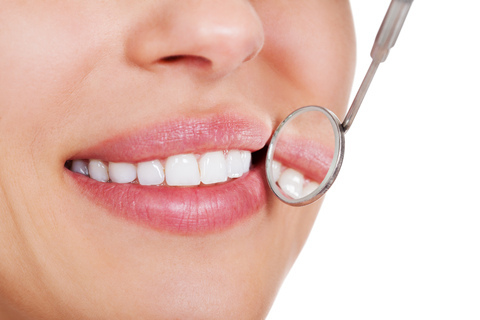
Many of our patients at Daisy Mountain Dentistry have been asking us about brightening their teeth lately, and today we thought we would discuss the options available to you to put the sparkle back in your smile!
Over-the-counter products – You’ve probably seen over-the-counter whiteners such as whitening strips on store shelves. While whitening strips may work for some, they do have certain restrictions. For example, they are not nearly as effective when crowns or fillings are involved. Teeth that are stained gray instead of brown or yellow typically don’t respond as well to these types of whiteners. Whitening strips typically save you money but take longer to work and also require discipline on your part to keep them in place for the right amount of time each day.
Whitening at our office – This type of whitening can be done right at Daisy Mountain Dentistry. A whitening agent is applied directly to teeth and a special light helps accelerate the whitening process. This may be accomplished in one session or take several appointments. You should expect to spend anywhere from 30 to 60 minutes at each session. If you have a mix of natural teeth and fillings or crowns, Drs. Peter Vogel, Paul Owens may recommend bonding or veneers on your natural teeth instead of regular bleaching. Teeth whitening at our office can be used to correct many tooth discolorations which may have been caused by staining, aging, or chemical damage to teeth. Using the latest in whitening technology, we can offer a safe method for creating the beautiful smile you've always wanted.
At-home whitening – If you choose this option, Drs. Peter Vogel, Paul Owens will take a mold of your teeth and create a custom-fit whitening tray. Gel whitening solution is poured in the mouthguard-like tray, and the tray is worn for a pre-determined amount of time, generally from a couple of hours a day to every day during the night, until you’re back in our office for an evaluation.
Give us a call at our convenient Anthem office to schedule an appointment! Whiter teeth are one just one visit away at Daisy Mountain Dentistry!
Thanksgiving in North America
November 21st, 2018

Thanksgiving marks the start to the holidays; a season filled with feasting, indulging, and spending time with family and friends are always special. Thanksgiving is a holiday meant for giving thanks, and while this may seem like such a natural celebration, the United States is only one of a handful of countries to officially celebrate with a holiday.
Unlike many holidays, Thanksgiving is a secular holiday, and it is celebrated on the fourth Thursday in November in the United States. In Canada, it is celebrated on the second Monday of October, which is, oddly enough, much closer to a time when harvests were likely gathered. In addition to the different dates, the origins of the celebration also share different roots.
Thanksgiving in the United States
Giving thanks for a bountiful harvest are not new, but the modern day holiday in the US can be traced to a celebration at Plymouth in Massachusetts in 1621. This feast of thanksgiving was inspired by a good harvest, and the tradition was simply continued on. At first, the colony at Plymouth didn't have enough food to feed everyone present, but the Native Americans helped by providing seeds and teaching them how to fish, and they soon began to be able to hold a feast worthy of the name. The tradition spread, and by the 1660s, most of New England was hosting a Thanksgiving feast in honor of the harvest.
Canadian Thanksgiving
An explorer of early Canada named Martin Frobisher is accredited for the first Canadian Thanksgiving. He survived the arduous journey from England through harsh weather conditions and rough terrain, and after his last voyage from Europe to present-day Nunavut, he held a formal ceremony to give thanks for his survival and good fortune. As time passed and more settlers arrived, a feast was added to what quickly became a yearly tradition. Another explorer, Samuel de Champlain, is linked to the first actual Thanksgiving celebration in honor of a successful harvest; settlers who arrived with him in New France celebrated the harvest with a bountiful feast.
A Modern Thanksgiving
Today, Thanksgiving is traditionally celebrated with the best of Americana. From feasts and football games to getting ready for the start of the Christmas shopping season, Thanksgiving means roasted turkey, pumpkin pie, and green bean casserole. No matter how you celebrate this momentous day, pause for a moment to give thanks for your friends, family, and all the bounties you’ve received. Happy Thanksgiving from Daisy Mountain Dentistry!
When was your last dental checkup?
November 14th, 2018

While Drs. Peter Vogel, Paul Owens and our team tell you daily oral hygiene habits, such as brushing and flossing, are essential to optimal oral health, regular dental checkups at Daisy Mountain Dentistry ensure your teeth are treated to a deeper level of cleaning.
We recommend for most of our patients to have a cleaning at our Anthem office at least every six months. In addition to a thorough cleaning and polishing of your teeth, visits with Drs. Peter Vogel, Paul Owens help us detect and prevent the onset of tooth decay and gum disease, also known as periodontal disease. During your visit, we will check the health of your mouth, teeth, gums, cheeks, and tongue for signs of any decay or disease. We will also check old fillings and restorations as these can wear away over time due to chewing, clenching, or grinding.
If you are predisposed to any oral diseases, Drs. Peter Vogel, Paul Owens may recommend checking in with us more often than every six months. We want your teeth to get the professional attention they deserve! If you are overdue for your next cleaning, give us a call at our Anthem office to schedule a checkup! See you soon!
November Marks National Diabetes Awareness Month
November 7th, 2018

Diabetes is a chronic disease that increases the risk for many serious health problems, including severe gum disease. November is Diabetes Awareness Month, and it’s a great time for us at Daisy Mountain Dentistry to remind our patients that the way you care for your teeth at home doesn’t just affect your oral health; keeping your mouth healthy is vital to your overall health, too.
Diabetes is the result of a deficiency, or lack of the hormone insulin to properly transport glucose (blood sugar) to the cells throughout the body. According to the American Diabetes Association, the most common types of diabetes are Type One (90-95 percent of cases), Type Two (five percent), and gestational or pregnancy diabetes. Women who have had gestational diabetes have a 35 to 60 percent chance of developing diabetes, mostly Type Two, in the ten to 20 years following their pregnancy.
In the past decade, researchers have found links between periodontal (gum) disease and diabetes. Not only are people with diabetes more vulnerable to gum disease, but diabetes may also have the potential to affect blood glucose control, as well as contribute to the advancement of diabetes.
Nearly 26 million Americans currently live with the disease, with an additional 79 million in the pre-diabetes stage. There is some good news we want you to know, however; you can protect your gums and teeth from the effects of diabetes by visiting our Anthem office for an exam. Patients who are living with diabetes may require more often visits to ensure their dental health remains in tip-top shape. Many insurance plans provide expanded benefits for diabetic patients, and Drs. Peter Vogel, Paul Owens can tell you how often you need to come in for an appointment.
For more information on how we can help, please do not hesitate to give us a call at our Anthem office.
The Intriguing History of Halloween
October 31st, 2018

Halloween is fast approaching, and Drs. Peter Vogel, Paul Owens wanted to be sure to wish our patients a happy day, no matter how you might celebrate this holiday. The Halloween that is familiar to most people today bears little resemblance to the original Halloween; back in the "old days" it wasn't even called Halloween!
Festival of the Dead
Halloween started out as a Celtic festival of the dead that honored departed loved ones and signified a change in the cycle of the seasons. The Celtic people viewed Halloween, then called "Samhain," as a very special day – almost like our New Years day in fact, as their new calendar year began on November 1st. Samhain was the last day of autumn, so it was the time to harvest the last of the season's crops, store food away for winter, and situate livestock comfortably for the upcoming cold weather. The Celts believed that during this day, the last day of winter, the veil between this world and the spirit world is the thinnest, and that the living could communicate with departed loved ones most effectively on Samhain due to this.
Modern Halloween
Halloween as we know it today started because Christian missionaries were working to convert the Celtic people to Christianity. The Celts believed in religious concepts that were not supported by the Christian church, and these practices, which stemmed from Druidism, were perceived by the Christian church as being "devil worship" and dangerous.
When Pope Gregory the First instructed his missionaries to work at converting the Pagan people, he told them to try to incorporate some of the Pagan practices into Christian practices in a limited way. This meant that November 1st became "All Saints Day," which allowed Pagan people to still celebrate a beloved holiday without violating Christian beliefs.
Today, Halloween has evolved into a day devoted purely to fun, candy, and kids. What a change from its origins! We encourage all of our patients to have fun during the holiday, but be safe with the treats. Consider giving apples or fruit roll-ups to the kids instead of candy that is potentially damaging to the teeth and gums.
Remind kids to limit their candy and brush after eating it! Sweets can cause major tooth decay and aggrivate gum disease, so to avoid extra visits to our Anthem office, make your Halloween a safe one!
Four Oral Health Issues Seniors Face
October 24th, 2018

Oral health is an important and often overlooked component of an older person’s general health and well-being. Drs. Peter Vogel, Paul Owens and our team know that for many of our older patients, oral health can become an issue when arthritis or other neurological problems render them unable to brush or floss their teeth as effectively as they once did. Today, we thought we would discuss four common oral health issues our older patients face and how they can avoid them:
Cavities: It’s not just children who get tooth decay—oral decay is a common disease in people 65 and older. Ninety-two percent of seniors 65 and older have had dental caries in their permanent teeth, according to the National Institute of Dental and Craniofacial Research. The risk for tooth decay increases because many older adults don’t go to the dentist as often as they used to, thus cavities go undetected and untreated for longer than they should. Keeping regular appointments with Drs. Peter Vogel, Paul Owens is the key to getting cavities treated in a timely manner.
Difficulty eating: Oral health problems, whether from missing teeth, cavities, dentures that don’t fit, gum disease, or infection, can cause difficulty eating and can force people to adjust the quality, consistency, and balance of their diet.
Dry mouth: Also called xerostomia, dry mouth is a common issue for a lot of seniors. Our friends at the Oral Cancer Foundation estimate that 20 percent of elderly people suffer from dry mouth, which means the reduced flow of saliva (saliva plays a crucial role in preventing tooth decay). Many seniors are on multiple medications for a variety of chronic illnesses or conditions. Common medications taken that may cause dry mouth are decongestants, antihistamines, blood pressure medications, pain pills, incontinence medications, antidepressants, diuretics, muscle relaxers, and Parkinson’s disease medications. To help counter this, we suggest drinking lots of fluids and limiting your intake of caffeine and alcohol. We also encourage you to check with Drs. Peter Vogel, Paul Owens during your next visit if you think your medications are causing your mouth to feel dry.
Gum Disease: Gum (periodontal) disease is an infection of the gums and surrounding tissues that hold teeth in place. While gum disease affects people of all ages, it typically becomes worse as people age. In its early stages, gum disease is painless, and most people have no idea that they have it. In more advanced cases, however, gum disease can cause sore gums and pain when chewing.
Gum disease, which can range from simple gum inflammation to serious disease, is usually caused by poor brushing and flossing habits that allow dental plaque to build up on the teeth. Plaque that is not removed can harden and form tartar that brushing simply does not clean. Only a professional cleaning at our office can remove tartar. The two forms of gum disease are gingivitis and periodontitis. In gingivitis, the gums become red, swollen, and can bleed easily; in periodontitis, gums pull away from the teeth and form spaces that become infected.
Proper brushing, flossing, and visiting our office regularly can prevent gum disease. Seniors with limited dexterity who have trouble gripping a toothbrush should ask Drs. Peter Vogel, Paul Owens about modifying a handle for easier use or switching to a battery-powered toothbrush.
Timing Matters!
October 17th, 2018

Many patients at Daisy Mountain Dentistry are under the impression that harder brushing leads to cleaner teeth, but that is not true. Gentle brushing is just as effective, and less likely to cause damage. Other good brushing habits include brushing your teeth at least twice a day, replacing your toothbrush after a few months, and brushing for at least two minutes each time. It can be tough to keep track of the time when you are aiming for two minutes, but these tips can help.
Set a Timer
Setting a timer is a sure-fire way to hit your two-minute goal on the dot. Leave a kitchen timer in your bathroom so that it is easy to set each time you start brushing your teeth. Hit each surface of all of your top and bottom teeth, and keep brushing until the timer rings. Many electric toothbrushes have a built-in timer that you can use instead of a kitchen timer.
Entertain Yourself for Two Minutes
Time flies when you are having fun, and you can stay entertained as you brush your teeth for two minutes. These are some ideas.
- Time your favorite song and sing it in your head as you brush your teeth.
- Find a two-minute video on the Internet that you want to watch, and start it when you begin to brush your teeth.
- Do squats in the bathroom as you brush. Go down for three slow counts, and up for three slow counts. By the time you get to 20 squats, your two minutes will be over.
Let Your Children Use Technology
Toothsavers is an app designed to inspire children to brush. The app was developed and released by the Ad Council and the Partnership for Healthy Mouths, Healthy Lives. It includes:
- A game to fight an evil sorceress who causes cavities
- A two-player version that lets children interact with friends and parents
- Real-life reminders to brush twice a day
- A built-in timer that helps kids brush for two minutes
Welcome to Our Blog
September 5th, 2018
Thank you for taking the time to visit our blog. Please check back often for weekly updates on fun and exciting events happening at our office, important and interesting information about the dental industry, and the latest news about our practice.
Feel free to leave a comment or question for our doctors and staff - we hope this will be a valuable resource for our patients, their families, and friends!


